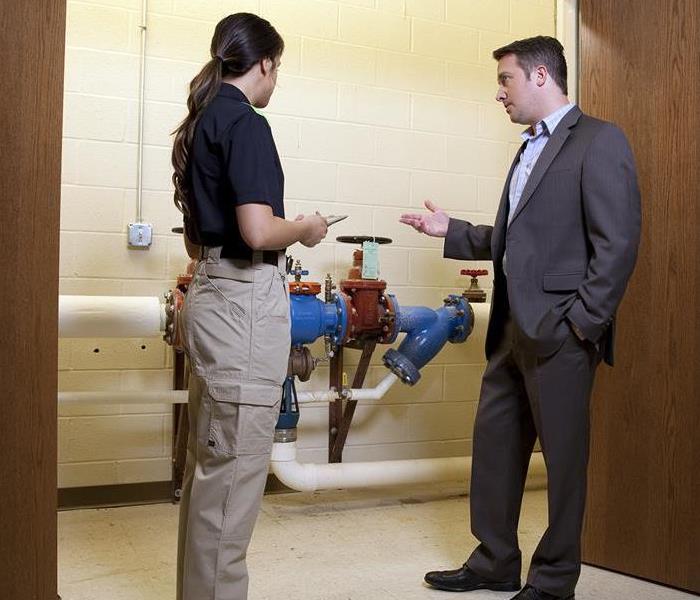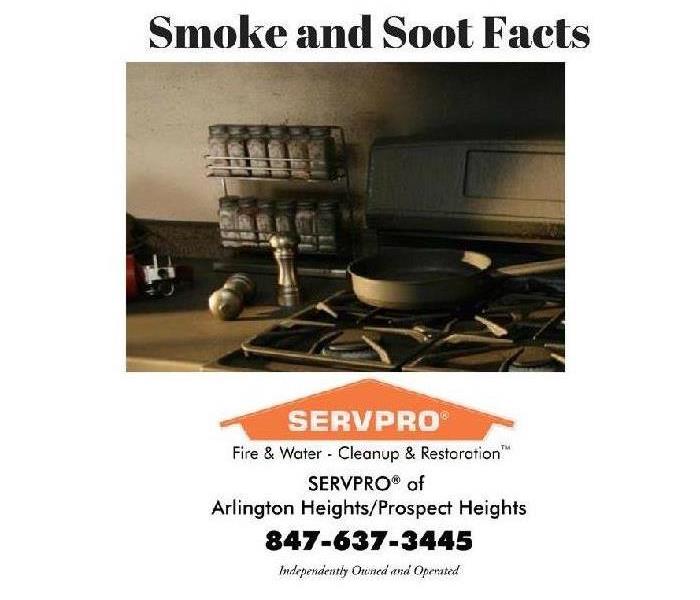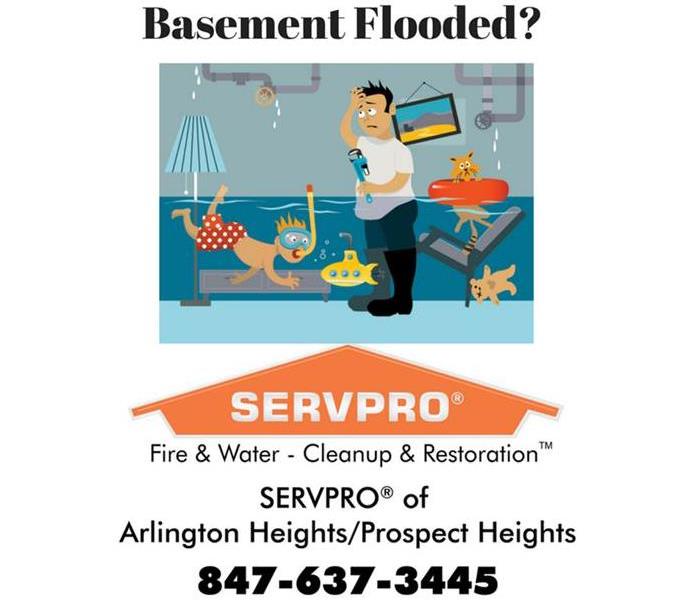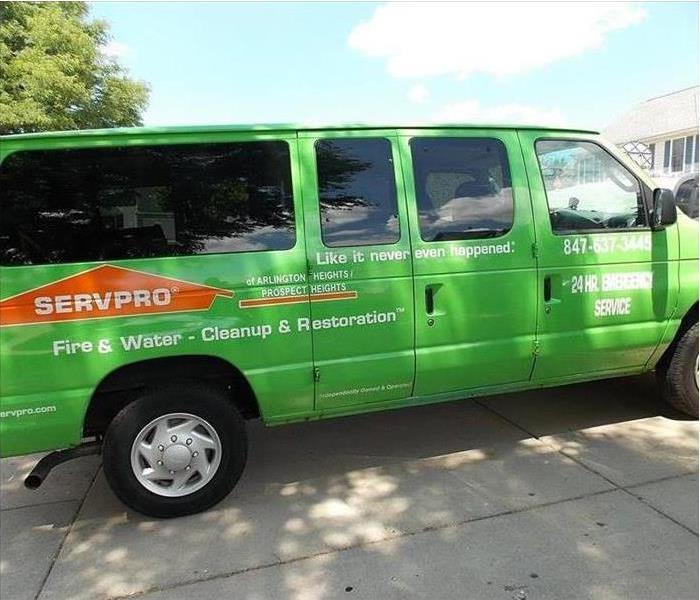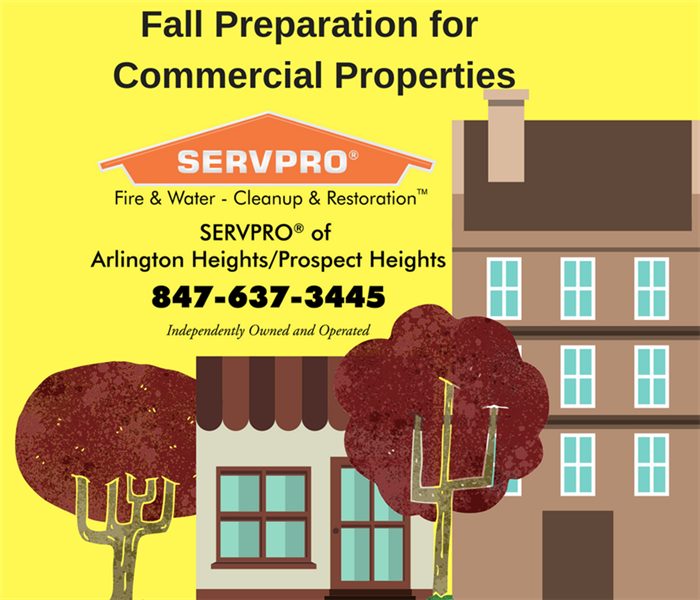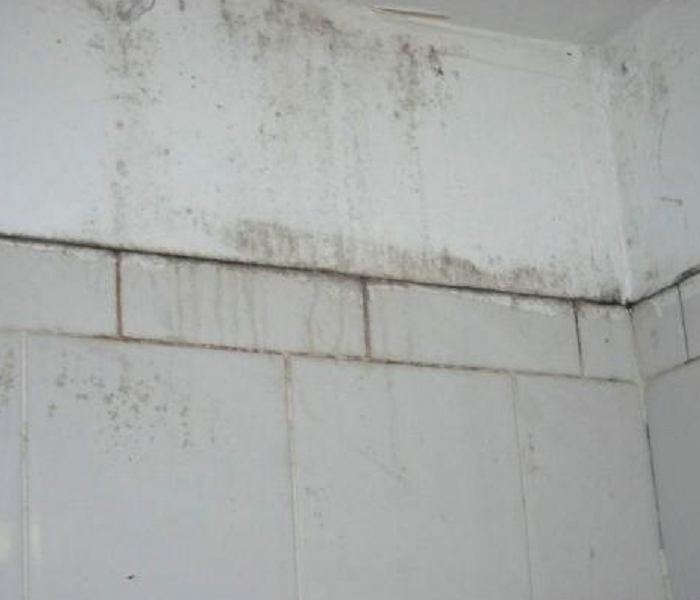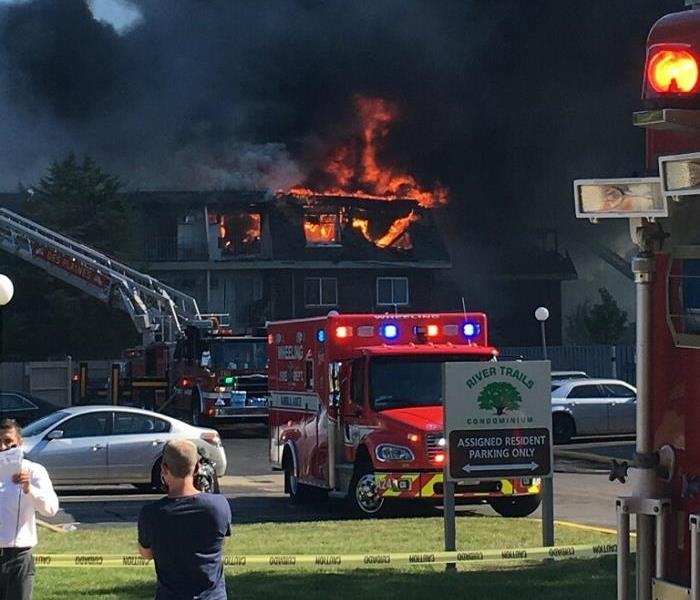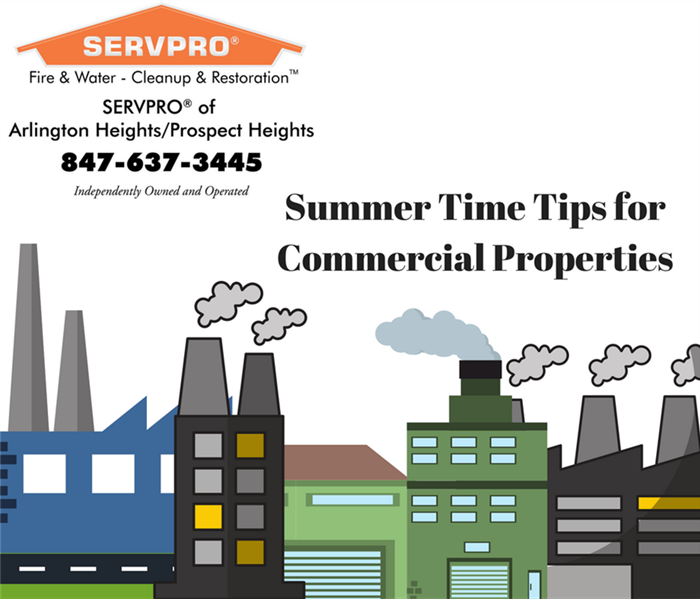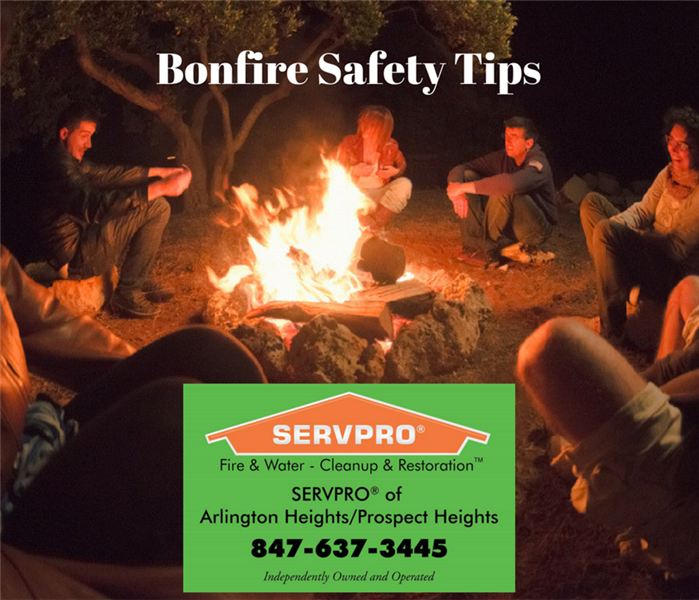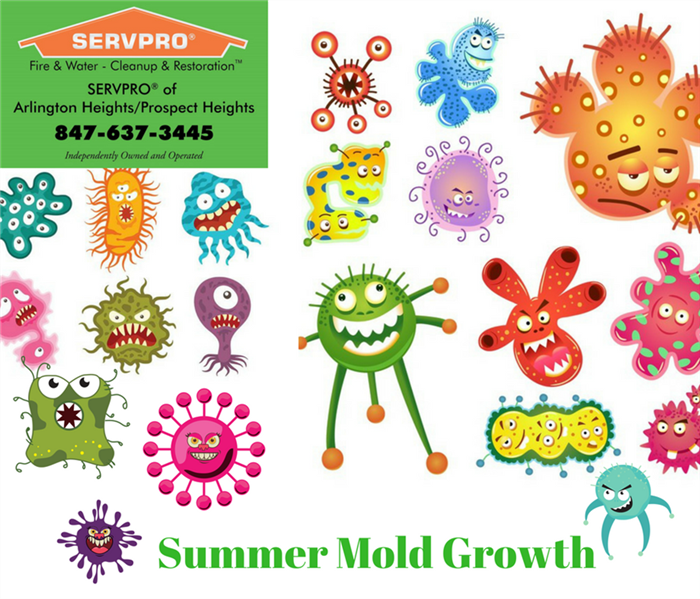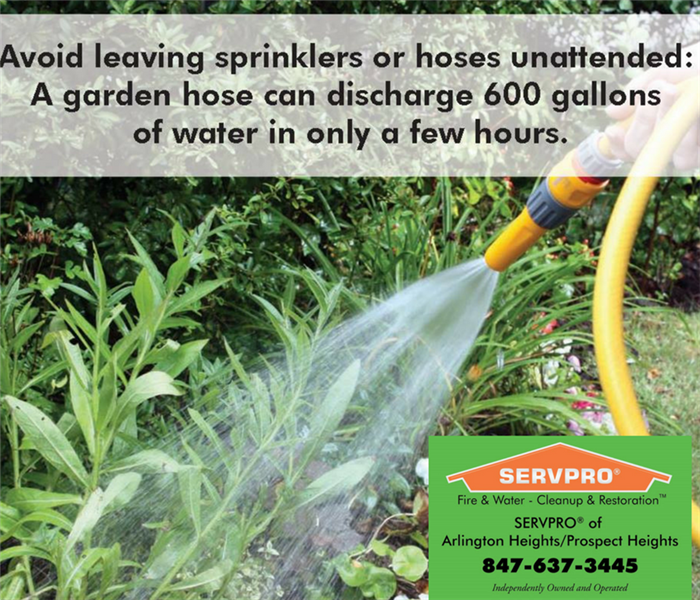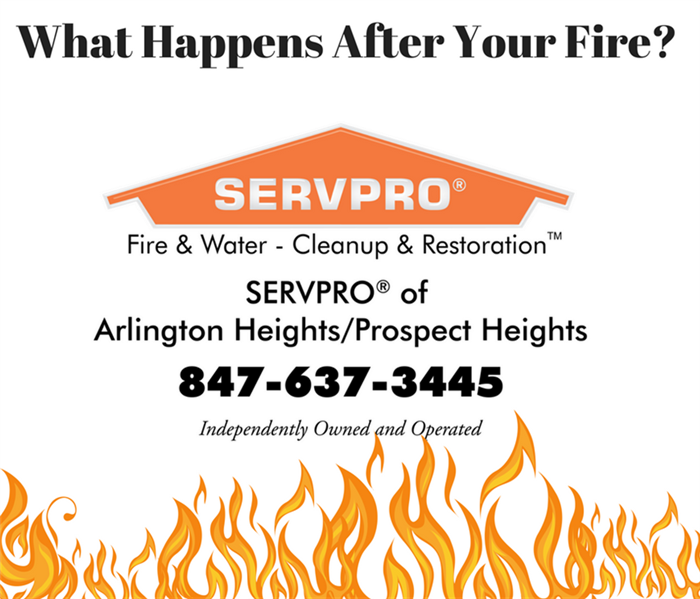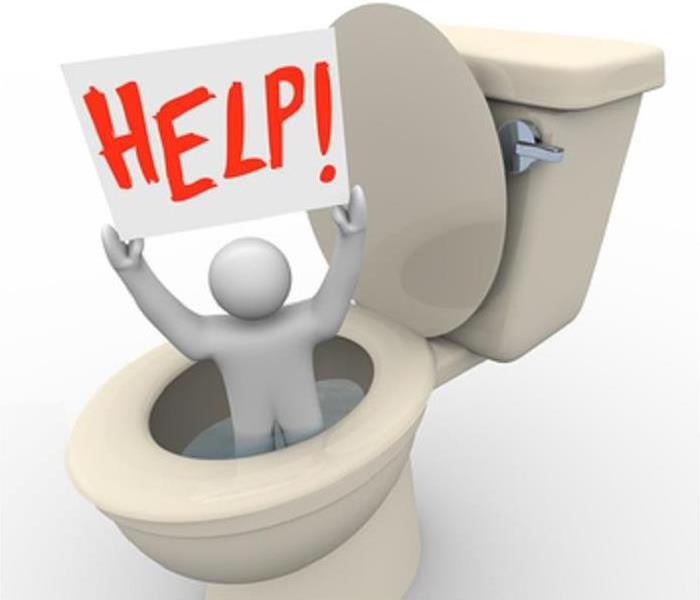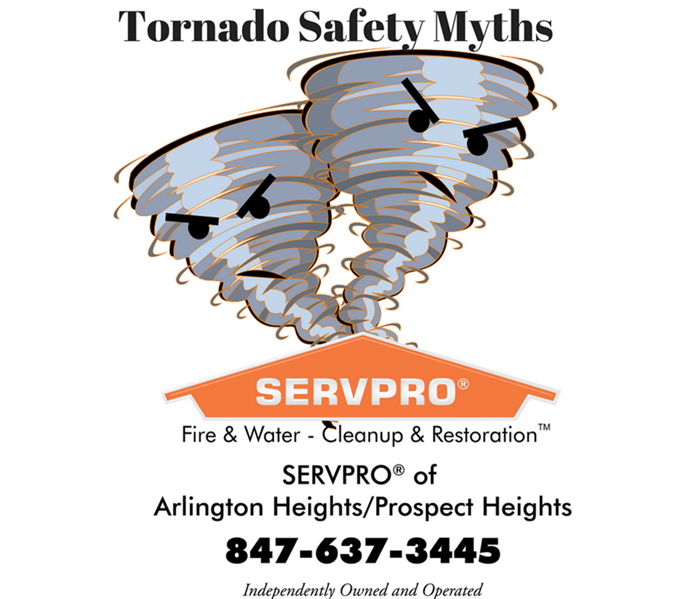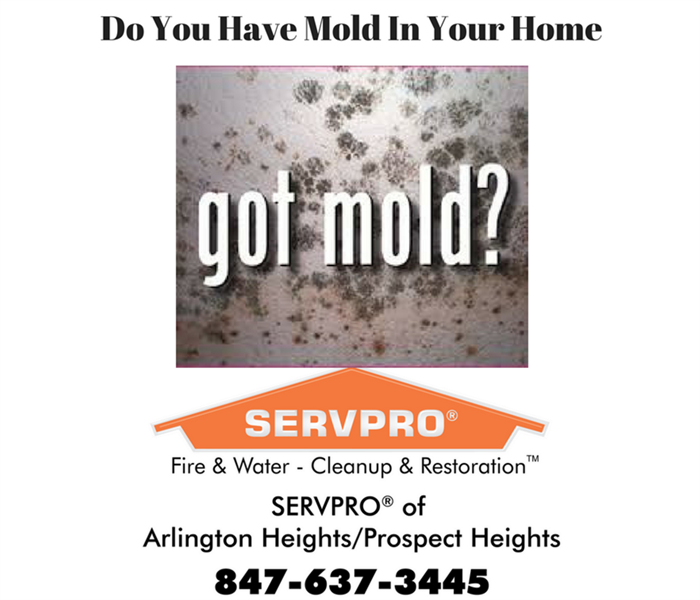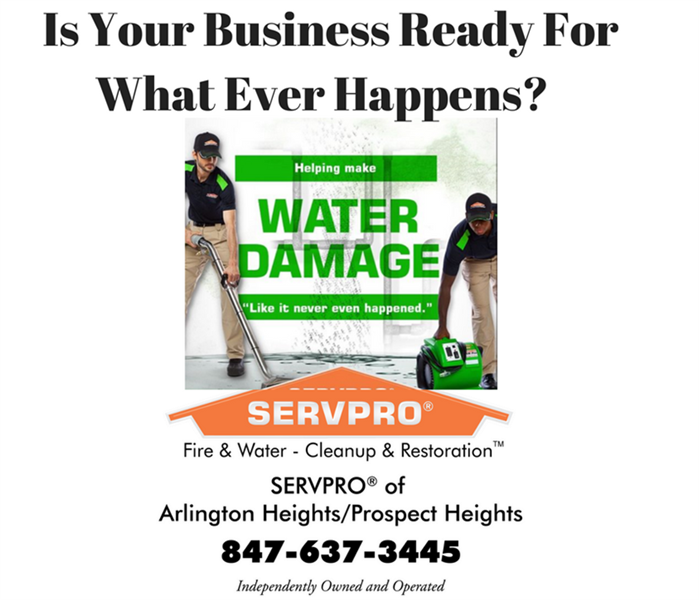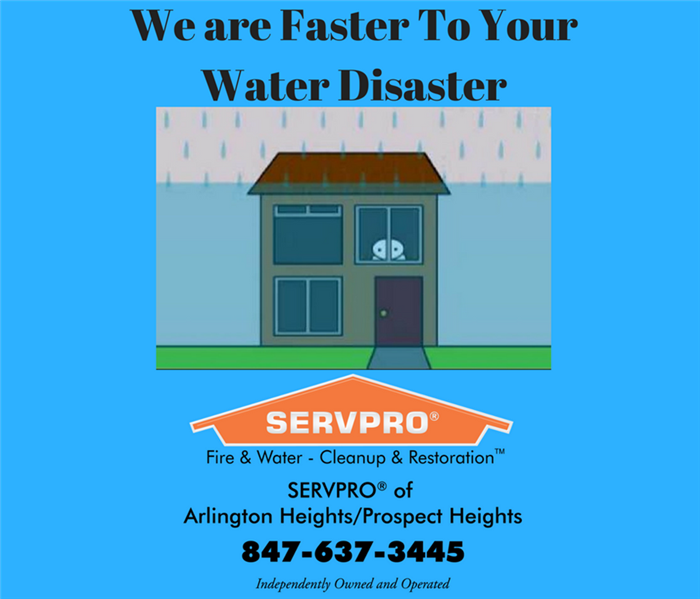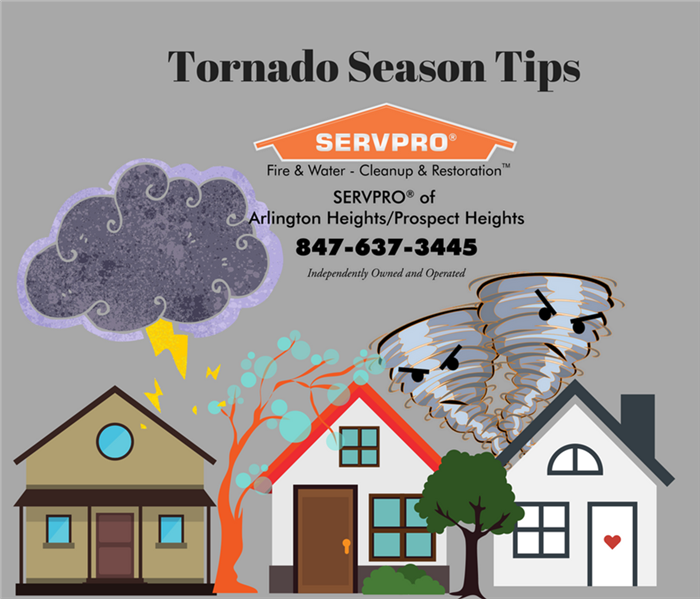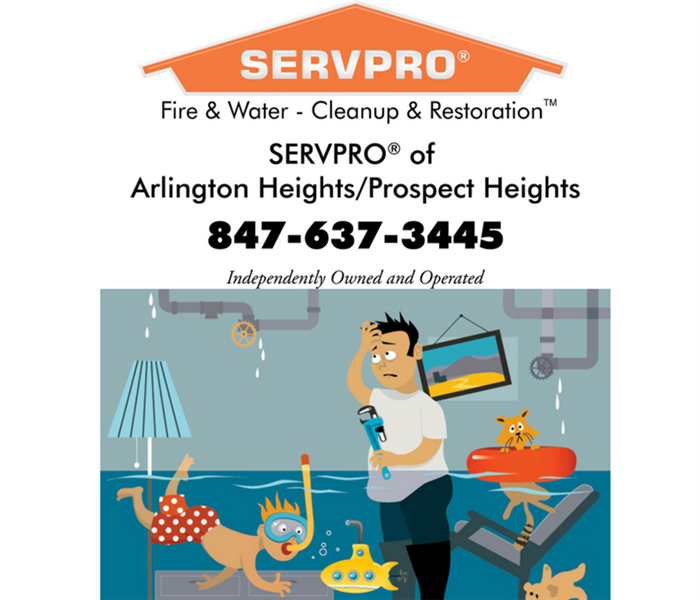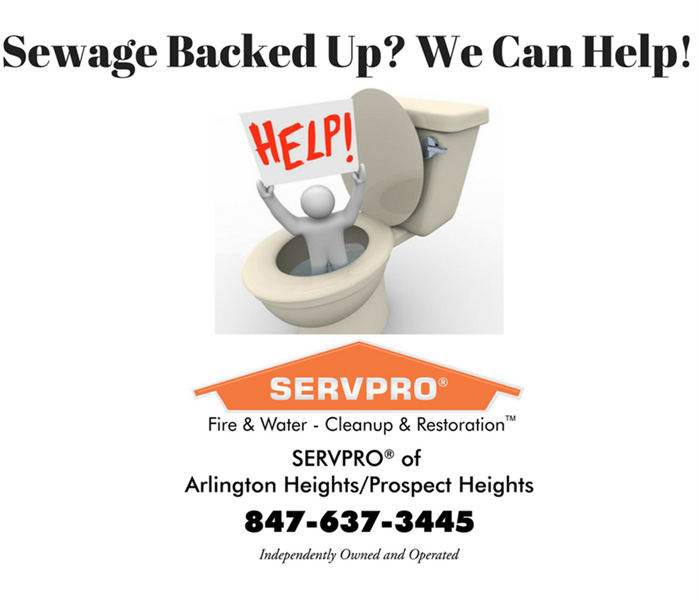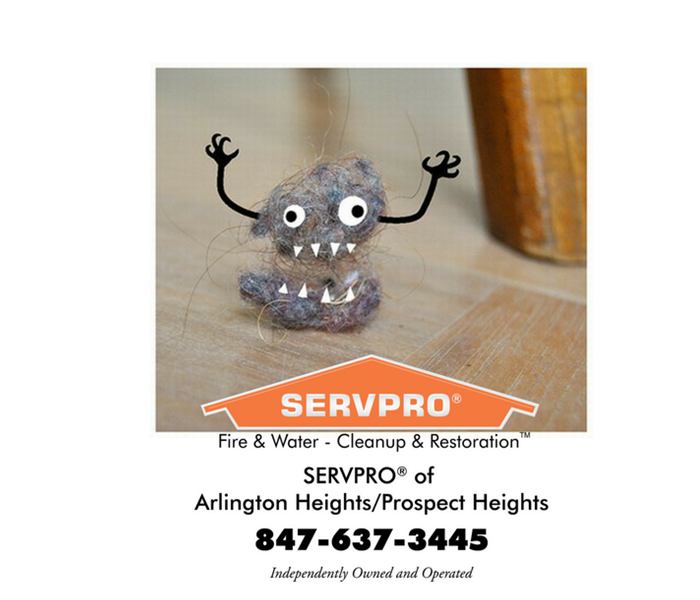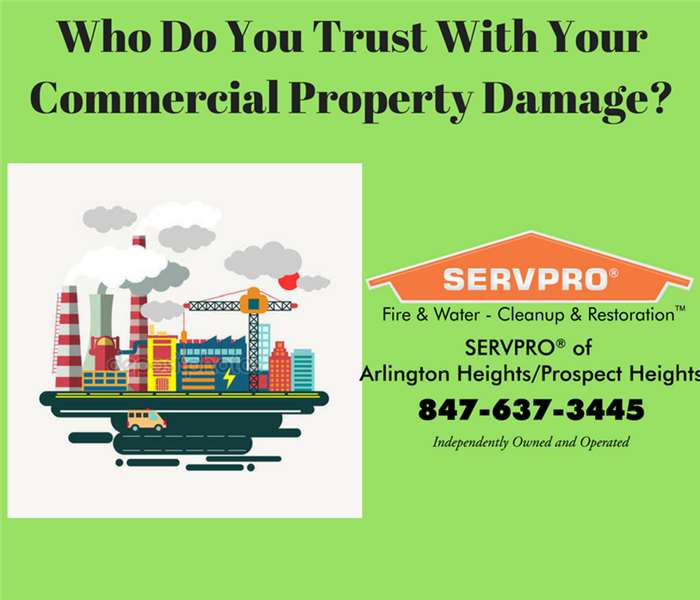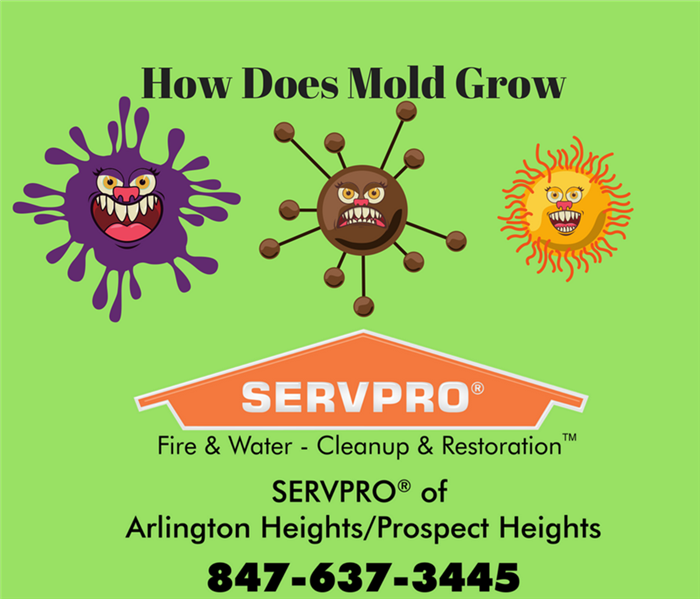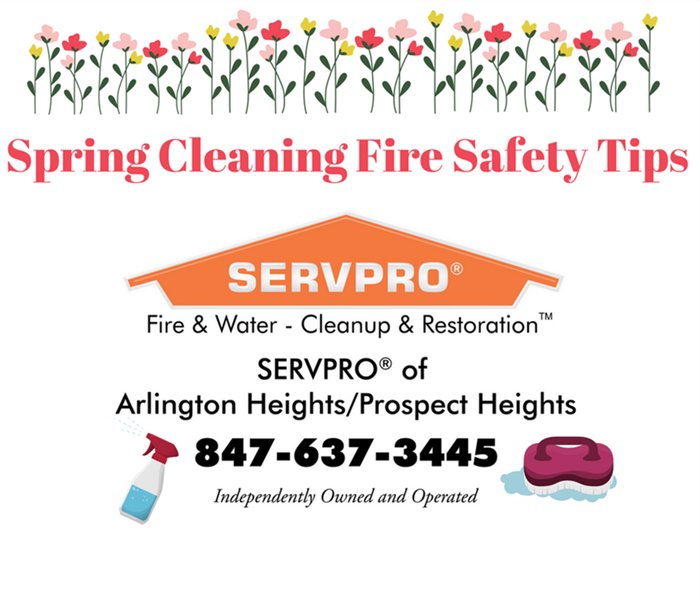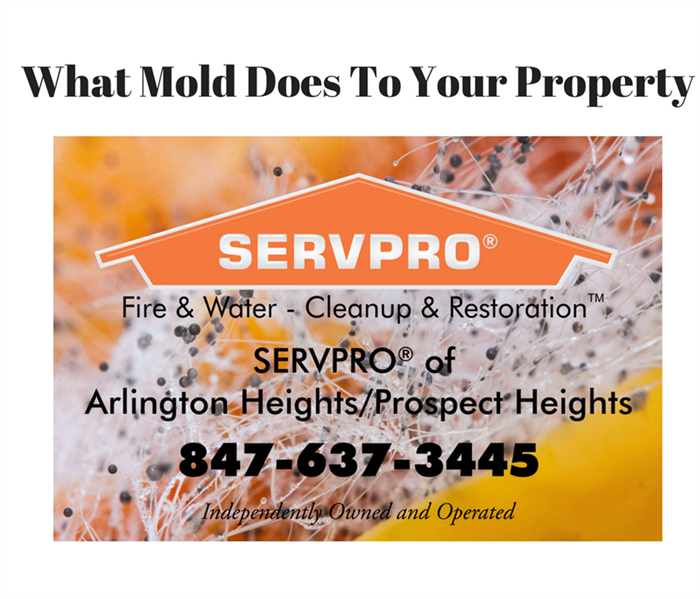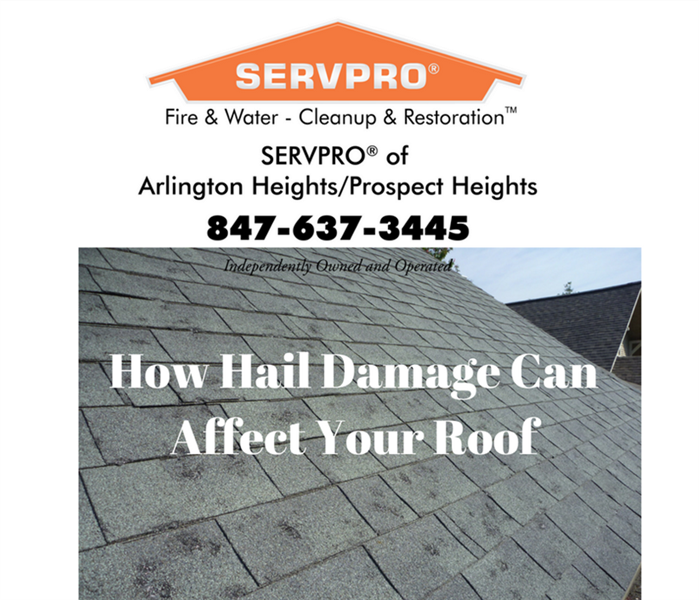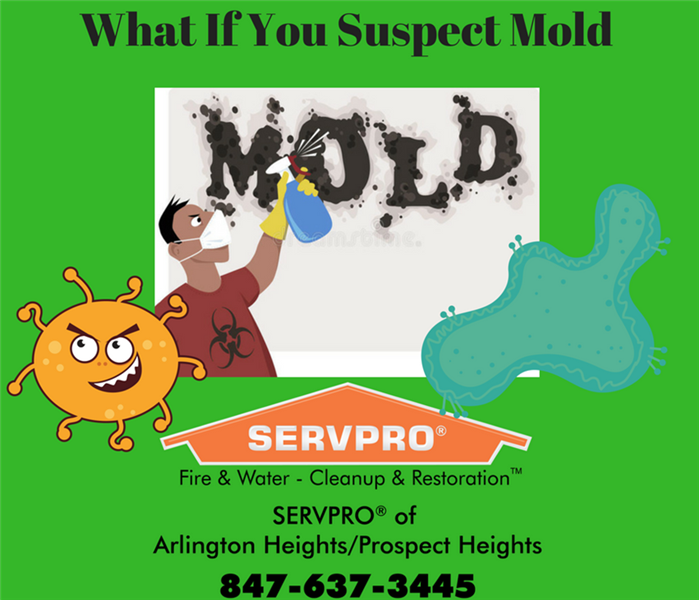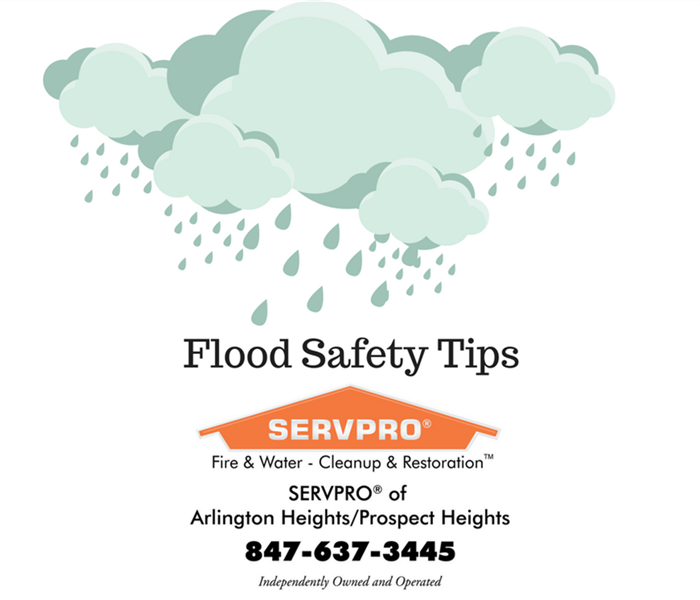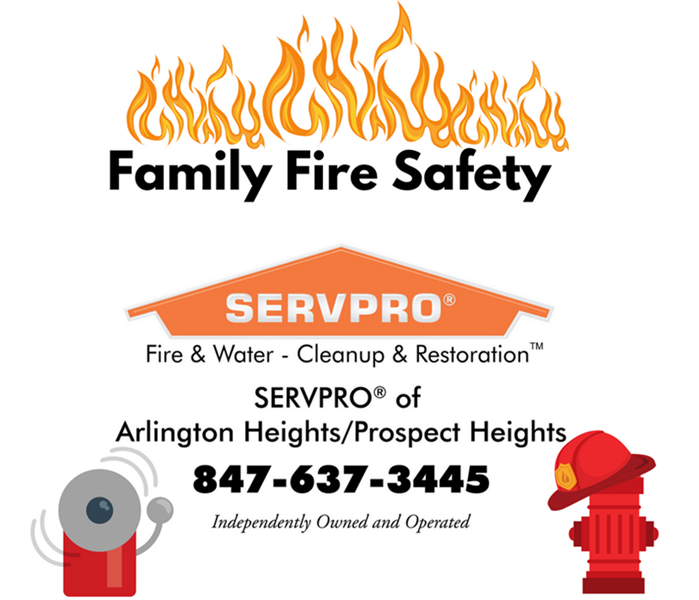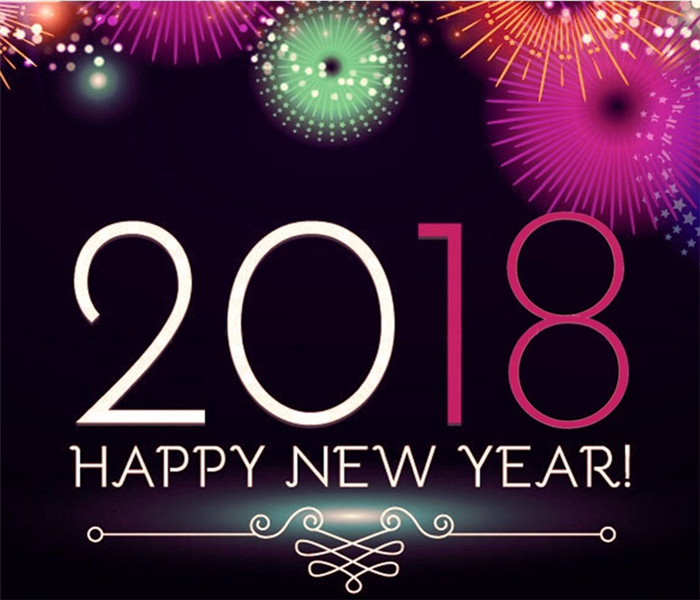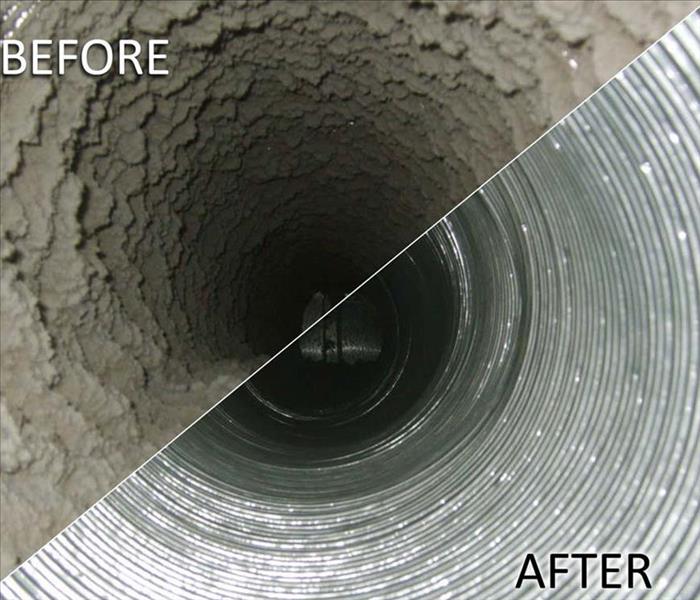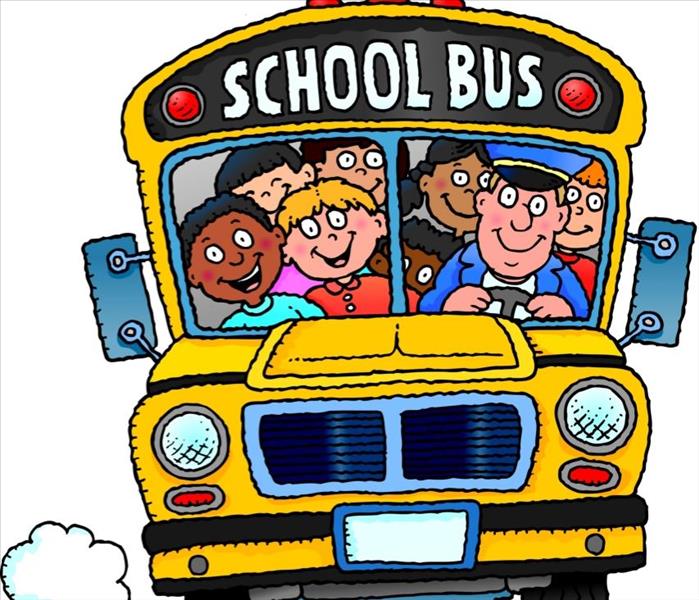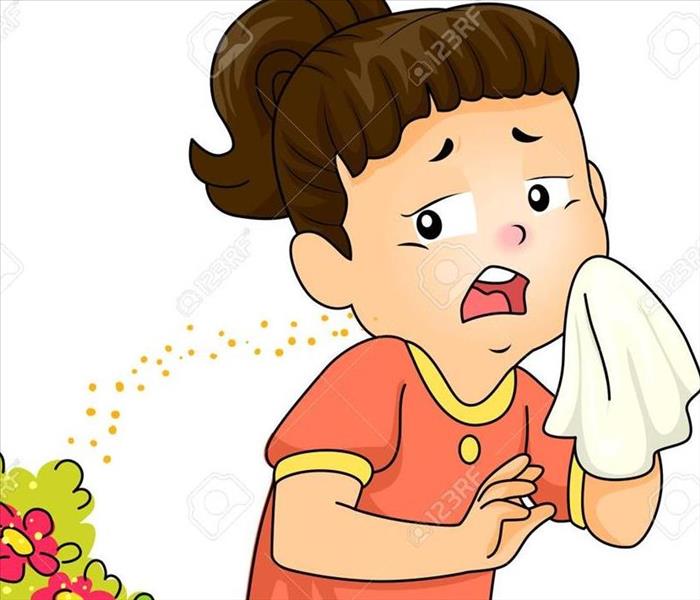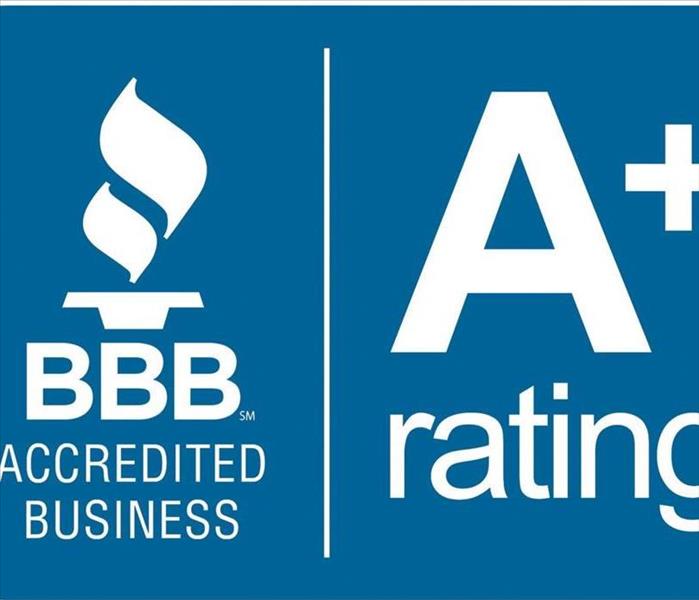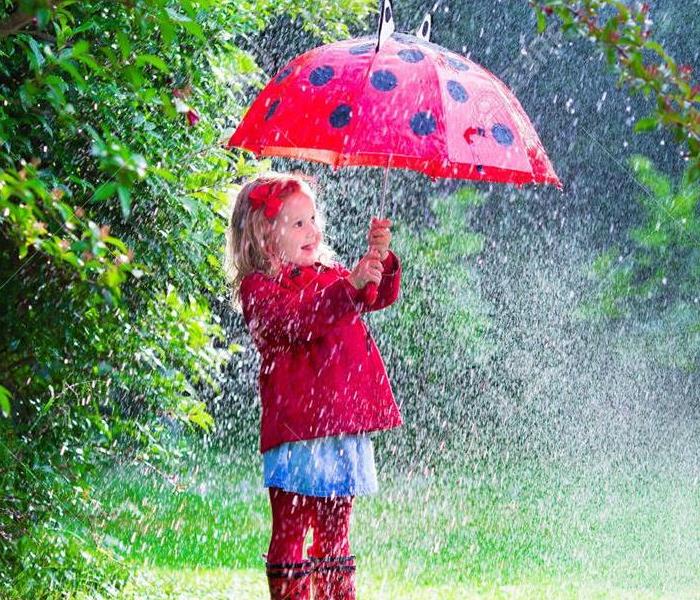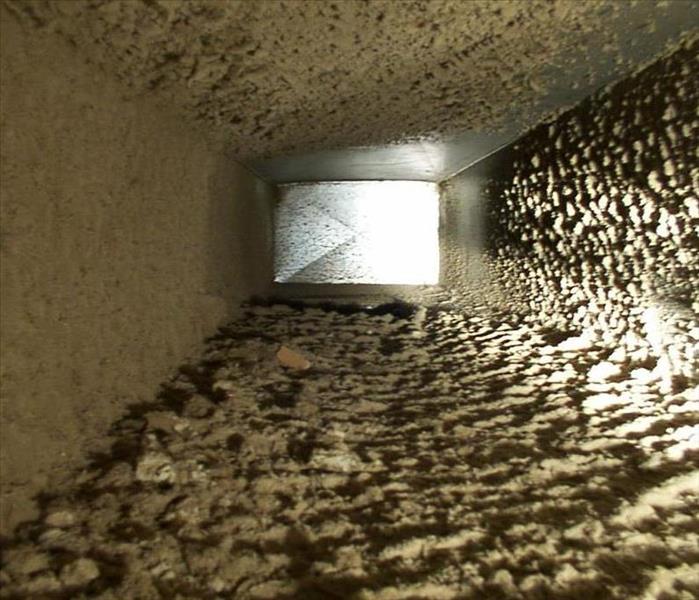Archived Blog Posts
Rid Your Home of Mold
9/21/2023 (Permalink)
rewrite this "House Mold Can Be Addressed Using Four Cleaning Hacks The sight of mold in your home in Prospect Heights, IL, might make you want to pack up your bags and leave for good, but a small amount of mold growth is no cause for alarm. A widespread, severe mold issue can cause extensive damage to your home and needs to be remediated with the help of a mold cleaning company. However, a minor house mold issue detected early can be addressed using the following four cleaning hacks. 1. Scrub Hard Surfaces With White Vinegar and Baking Soda Vinegar is a very effective natural mold removal solution due to its acidic properties that break down and kill most species of mold. Baking soda, another non-toxic ingredient, absorbs moisture, removes odors, and kills mold. Spray vinegar and baking soda solution and scrub any surfaces that has mold. 2. Soak Fabrics in Hot Water and Oxygen Bleach Fabrics such as clothes, linens or upholstered furniture that remain damp for an extended period time can house moisture-seeking mold. If you can visibly see mold on the fabric, first scrub it off when a brush. Next, soak the fabric in very hot water and oxygen bleach. 3. Lightly Wipe Paper with Hydrogen Peroxide House mold on books and paper can be tricky to clean. First, ensure the paper is completely dry. Next, use a soft paintbrush to brush away any mold you see. Wet a cloth towel with a small amount of hydrogen peroxide, lightly wipe the paper, and allow the page to dry. 4. Clean Tile With Chlorine Bleach and Water If mold has made its way into the grout of your tile floors, you’ll need some chlorine bleach and water. Mix one cup of bleach with a gallon of water and mop it onto your floors. Let it sit for 15 minutes and then scrub. Rid your home of house mold with these four cleaning hacks! If the problem is bigger than you suspected, don’t hesitate to call in a professional mold remediation company. " Addressing House Mold: Four Cleaning Techniques
Dealing with mold in your Prospect Heights, IL home can be distressing, but a small amount of mold growth shouldn't cause immediate panic. However, if you come across a widespread and severe mold issue, it's best to seek assistance from a professional mold cleaning company. For minor mold problems discovered early on, you can try utilizing these four cleaning techniques:
1. Scrub Hard Surfaces Using White Vinegar and Baking Soda
Utilize the acidic properties of white vinegar, which is an effective natural mold removal solution. It breaks down and eliminates most types of mold. Baking soda, on the other hand, absorbs moisture, eliminates odors, and kills mold. Create a solution by combining vinegar and baking soda, then spray it onto surfaces with mold and scrub thoroughly.
2. Soak Fabrics in Hot Water and Oxygen Bleach
Moist fabrics like clothes, linens, or upholstered furniture can become a breeding ground for mold. If you notice visible mold on fabric, start by scrubbing it off with a brush. Then, soak the fabric in hot water mixed with oxygen bleach to eliminate any remaining mold.
3. Gently Wipe Paper Using Hydrogen Peroxide
Cleaning mold from books and paper can be challenging. Begin by ensuring that the paper is completely dry. Next, use a soft paintbrush to brush away any visible mold. Take a cloth towel dampened with a small amount of hydrogen peroxide and lightly wipe the paper, allowing it to dry afterward.
4. Clean Tiles With Chlorine Bleach and Water
If mold has infiltrated the grout of your tile floors, a mixture of chlorine bleach and water will prove effective. Combine one cup of bleach with a gallon of water, mop it onto the floors, and let it sit for 15 minutes. Afterward, scrub the area clean.
Rid Your Home of Mold
Implement these four cleaning hacks to address house mold. However, if the problem exceeds your expectations, don't hesitate to contact a professional mold remediation company for assistance.
Restoring Your Property After A Fire Damage Event
9/5/2023 (Permalink)
Early on Monday, August 28th, a house suffered significant damage when a fire broke out and rapidly spread from a second-floor balcony, as confirmed by officials. Consequently, the home was deemed uninhabitable and required extensive mitigation and restoration work.
Upon receiving the distress call about the fire, our franchise promptly responded to ensure the safety of everyone involved and to assess the structural integrity of the house. Our team made concerted efforts to salvage any valuable or sentimental belongings that were still recoverable. The homeowner expressed great satisfaction with SERVPRO's diligent efforts in retrieving important items from the affected property. This exemplifies our commitment to providing comprehensive assistance in times of need.
Fire and water damage incidents at residential properties often present complex challenges, encompassing various issues that demand a knowledgeable and adaptable response. Regardless of the scale of the damage, whether it be a minor water cleanup or a large-scale event, we act swiftly to evaluate each unique situation and isolate the affected area. In many cases, we can facilitate the continuation of normal operations by setting up temporary spaces while restoring your facility.
Restoring residential properties poses distinct challenges, and our professionals are well-equipped to navigate the legal and environmental considerations while working within your budgetary constraints. We understand that time is of the essence, as every hour spent on cleanup equates to lost revenue and productivity. Therefore, when faced with an emergency situation in your business, do not hesitate to reach out to us. We will respond promptly, providing the assistance you require.
About SERVPRO of Arlington Height/Prospect Heights Specializing in the cleanup and restoration of commercial and residential properties following water damage events, SERVPRO of Arlington Height/Prospect Heights boasts a highly trained staff in property damage restoration. Our team undergoes comprehensive training at SERVPRO's corporate training facility and holds regular IICRC-industry certifications, ensuring that they possess the necessary expertise to restore your property efficiently.
National Tune-Up Day
9/23/2022 (Permalink)
September 25th is National Tune-up Day. National Tune-up Day was created to remind homeowners to prepare their house for winter. In preparation for the changing seasons heating and cooling specialists recommend tuning up heating systems before the temperature drops.
During the spring and summer months the ability to open your windows and allow your home to breathe. Spring and summer are prime for the growth of flowers, summer nights at the beach taking in the fresh air and playing with your pets in the backyard or grilling up a steak. Spring and summer are also primal months for the spread of mold growth, pollen and other air traveling particles such as pet fur and dust via your home's air flow system. This can congest your home's ventilation system.
If your homes ventilation system seems a bit slower this may be the cause. Are you pondering what mechanics actually tune-up? Well according to “National Today” almost all your home's systems require regular maintenance. For instance, combustion gases should be examined and contrasted with the furnace's requirements. To ensure that the furnace's blower access door has a tight seal, it must be examined. Checking the fresh air intake grills for obstruction and the burners for good ignition and flame are two further inspections that are required. The repairman examines the furnace and checks for leaks and blockages in the drainage system. Traps, taps, and drains must all be tested as well. Additionally, some mechanics might advise checking the blower wheel, motor, wiring, and all filters. Additionally, the elements should be examined for deterioration and damage. A tune-up for your heating system helps you save energy and cut heating costs. Additionally, these tune-ups guarantee that the system will function optimally for the specified number of years.
SERVPRO Arlington Height/Prospect Heights has been specializing in the cleanup and restoration of residential and commercial property after fire, smoke, and water damage disasters for a very long time. Our staff is highly trained in property damage restoration, and we are an IICRC Certified Firm. We believe in continuous training: from initial and ongoing training at SERVPRO’s corporate training facility to regular IICRC-industry certification. Rest assured our staff is equipped with the knowledge to restore your property. Our continuing education programs also give us the ability to connect with insurance agents, adjusters, and more. This lessens the gap in the work processes for SERVPRO and insurance.
Hurricane Fiona Lands in P.R
9/19/2022 (Permalink)
A hurricane is a type of tropical cyclone, which forms over tropical or subtropical waters. Earlier this year in May the Forecasters at NOAA’s Climate Prediction Center, a division of the National Weather Service, predicted above-average hurricane activity this year, making it the seventh consecutive above-average hurricane season. September 10th marks the official peak of hurricane season and just as peak season begins hurricane “Fiona” recks throughout Puerto Rico on September 18th. Destructive winds and life-threatening flash floods and mudslides. The catastrophic storm left the entire island of Puerto Rican without power. Hurricane Fiona continues to reck Havok on the Atlantic islands at it travels to the Dominican Republic. Updates are still continuing, however, Additional strengthening is expected on today, September 19th, and Tuesday, as Fiona moves over the southwestern Atlantic, according to the NHC.
Here are some suggestions on how to be ready for a hurricane in your location now that we are officially just at peak of hurricane season.
- Create a plan: If evacuation is required, shut off all utilities and abide by local preparedness policies for disasters. Make sure to choose a location where the entire family can congregate. Make sure your pets have a plan for evacuation as well.
- To make the exterior secure, trim any sizable trees and bushes. Bring inside all of the outdoor patio furniture, plants in pots, bikes, and toys.
- Install storm shutters: These will provide adequate shutters or impact-resistant glass to protect your windows, doors, and skylights.
- Examine your art and wall hangings: Ensure that all of your wall hangings are stable and make notes on your artwork.
- Reposition your vehicles: Park them in your garage against the garage doors or keep them on higher ground.
- Electricity up: Fill up the gas tank in your car, check that all of your cell phones are charged, test your generator, and keep plenty of fuel on hand in case the power goes out.
- Keep critical documents in a safe deposit box in your home's closet. Examples of such documents are legal paperwork, birth certificates, marriage licenses, insurance policy information, and any valuables.
Prepare an emergency kit by gathering all flashlights, portable radios, batteries, non-perishable food, bottled water, money, blankets, toiletries, and clothing.
- Locate a shelter room. This space should be on the first floor, in the interior of the house's center, away from any windows.
At SERVPRO, we recognize that when a disaster happens, you never know what the aftermath will leave behind. Anytime you require services for rebuilding or damage control, we are always here to help!
Safety Advice For Homeowners To Safeguard Their Buildings
9/14/2022 (Permalink)
Safety Advice For Homeowners To Safeguard Their Buildings
Protecting your property from natural disasters is crucial as a homeowner, and flood protection should be top of mind. The most frequent and one of the most expensive weather-related disasters in the United States is flooding. Between 1980 and 2013, it is estimated that flooding damage cost about $260 billion. These safety advice for house protection will be very helpful to homeowners in Elmhurst, Illinois.
1. Rethink remodeling. Consider installing porous paving, for instance, if your driveway needs to be repaved to assist slow down water runoff. When installing a new grass, be sure to grade it away from the house so that water drains into the street gutter.
2. Keep up maintenance. By doing basic maintenance tasks like checking pipe valves and making sure the gutters are free to avoid ice dams, you can flood-proof your property. In the event of a flood or even heavy rain, making sure downspouts and drains are not clogged will help with water drainage.
3. Make cleanliness a priority. Following up after a flood is almost as vital as protecting your house from flooding. Consult water damage repair professionals right away to prevent water damage and mold. After such a natural calamity, you won't be the only one looking for assistance, so take action right once.
4. Sort out the mess. If at all feasible, move any gadgets, pricey rugs, and furniture to higher levels. Simply lift them off the ground if it's not. Elevating large appliances onto solid objects like concrete blocks can also be useful. Ensure that electrical components like switches, plugs, and circuit breakers are at least a foot above the area's predicted flood level.
Prioritize flood safety when you buy or renovate a house. It is frequently more useful to be better prepared for such natural disasters in advance than than attempting to handle the consequences after the fact.
Preparation for tornadoes
9/14/2022 (Permalink)
Knowing what kinds of catastrophes might occur in your area is crucial when creating a strategy for when they do. Know how you will get in touch with one another and re-connect if you become separated. Establish a comfortable and convenient location for family gatherings. Ensure that you have the following.
1. A method of receiving alerts and cautions in case of emergency
2. Shelter strategy
3. The evacuation path
4. Plan for household and family communications
5. Update your emergency supply kit
Next, you should think about the unique needs of your home. Be careful to establish your requirements and obligations as well as how the network's members can help one another with communication, kid, business, or pet care, or with more specialized needs like operating medical equipment.Be careful to establish your requirements and obligations as well as how the network's members can help one another with communication, kid, business, or pet care, or with more specialized needs like operating medical equipment. When creating your plan, bear some of the following things in mind:
- Your family's members are of varying ages.
The duties entailed in helping others
- visited areas
diet requirements
- medical requirements, such as medication and supplies
- Access and functional needs, such as those for devices and equipment, or disabilities
spoken languages
- Considerations of culture and religion
service animals or pets
- families with children in school.
September is National Preparedness Month
9/1/2022 (Permalink)
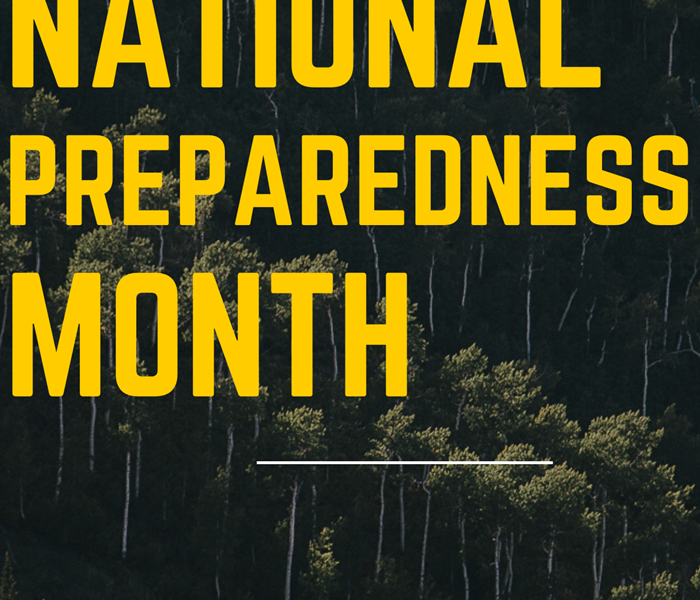
September is National Preparedness Month (NPM). NPM is FEMA's national annual preparedness outreach. It is managed and sponsored by FEMA's Ready Campaign. The Ready Campaign, in conjunction with the Ad Council, aims to educate and empower Americans during NPM and through the year to prepare for and respond to all types of emergencies, including natural disasters and potential terrorist attacks. National Preparedness Month culminates on September 30th with National Preparedness Day, the National Day of Action. The theme for 2022 is: A Lasting Legacy. The life you've built is worth protecting. Prepare for disasters to create a lasting legacy for you and your family. SERVPRO® is proud to spotlight National Preparedness Month this year. By doing so, we want to make sure you are prepared in case of a disaster? whether natural or man-made. If you haven't taken the time to think about how different disasters could affect you, then we challenge you to take the necessary steps to become informed and develop an emergency plan for before, during, and after an event for yourself and your family. IN THIS ISSUE of the Restoration Newsline: • Why is NPM observed in September? • What 2 states experience the most tornadoes? • Preparedness steps that could save your life • What to include in an emergency supply kit We must work together to ensure that our families, businesses, places of worship, and neighborhoods are ready for the unthinkable. Begin preparing vital information now so you can address the unique needs of your business during an emergency situation. Contact your local SERVPRO® team of professionals to find out more preparedness planning tips and how you can minimize business interruption with SERVPRO's Emergency READY Profile®.
How SERVPRO works directly with your insurance
8/31/2022 (Permalink)
When a disaster strikes your property, it is important to know who to call! SERVPRO of La Grange Park / North Riverside, Arlington Heights/Prospect Height, and Elmhurst is highly trained and experienced in disaster restoration and cleanup. Our team is the trusted leader in the restoration and cleaning industry, and we offer a wide variety of services for your residential and commercial properties. Water damage, fire damage, and mold damage don't stand a chance against our team! Locally owned and operated, we are dedicated to being "Faster to any size disaster!" Available 24 hours a day, days a week for your emergency.
When you experience an unexpected disaster in your home, you may not know how to handle it. After the shock is over, your first thoughts are “what am I going to do?” and “How am I going to pay for this?”. These are two very common questions homeowners ask themselves given the high cost of repairing water, fire, mold or trauma damage. Good news for you, our team of professionals is here to help eliminate that concern.
Here at SERVPRO of La Grange Park / North Riverside, Arlington Heights/Prospect Height, and Elmhurst set ourselves apart from other restoration companies with our seamless design to work directly with most insurance companies while keeping property owners in the loop. Our dedicated team of professionals understands the insurance industry. From knowing how the claims process works, to getting your claim submitted and your repairs documented correctly. One major advantage we use is our advanced technology that allows us to perform very accurate estimates with detailed reports on replacements. Many of our team members have worked directly with insurance agents and adjusters.
As one of the largest restoration and damage remediation companies in the country, we work with hundreds of insurance companies to help our customers get their claims processed quickly and fairly. Many insurance companies know that SERVPRO handles losses professionally and often recommend us to their policyholders.
If you have any questions or are in need of emergency services, don't hesitate and give our SERVPRO of La Grange Park / North Riverside, Arlington Heights/Prospect Height, and Elmhurst team a call!
Rain, storms and flooding are seemingly becoming more frequent across the world.
8/9/2022 (Permalink)
Rain, storms and flooding are seemingly becoming more frequent across the world. Many areas in the United States are experience record breaking rainfall and flooding. Many Americans are becoming open minded to the idea of climate change as a result of global warming. Nasa has produced articles on the evidence, causes, effects and solutions of climate change.
According to Nasa, “It is undeniable that human activities have produced the atmospheric gases that have trapped more of the Sun’s energy in the Earth system” This allows us to make the educated thought that these gases are warming our planet at a rapid rate. Scientists have predicted that many of the changes that are happening would eventually happen. However, these changes are happening much sooner than they had expected. In NASA’s article Earth Will Continue to Warm and the Effects Will Be Profound the author states “Changes to Earth’s climate driven by increased human emissions of heat-trapping greenhouse gases are already having widespread effects on the environment: glaciers and ice sheets are shrinking, river and lake ice is breaking up earlier, plant and animal geographic ranges are shifting, and plants and trees are blooming sooner” These are some of the effects of climate in happening rapidly in the recent years many of which may seem to be attached to the recent growth in natural disasters.
In the article Flooding and Climate Change: Everything You Need to Know the author states “Floods are the most common (and among the most deadly) natural disasters in the United States. They have brought destruction to every state and nearly every county, and in many areas they are getting worse.” We can see examples of this in parts of central Illinois and St. Louis, Missouri where severe storms have been recking havoc on residents and leaving hundreds homeless or displaced with flood damage.
Many Americans are preparing for a new Federal climate bill that could have a direct impact on a variety of climate measures. The bill offers a variety of tax credits focusing heavily on the push towards the use of low-carbon technologies. According to the article How The Federal Climate Bill Could Impact Proviso Suburbs, The new initiative — which was spearheaded by Broadview Mayor Katrina Thompson, Oak Park Village President Vicki Scaman and River Forest President Cathy Adduci — puts participating suburbs on the hook for achieving a 100% reduction in greenhouse gas emissions by 2050. This should be viewed as a great accomplishment as the village of Broadview is recently recovering from major storms that left the village in a state of emergency a few weeks ago. Read more about that here. https://www.SERVPROlagrangeparknorthriverside.com/blog
References:
Jackson, R. (2022). The Effects of Climate Change. Climate Change: Vital Signs of the Planet. Retrieved August 9, 2022, from https://climate.nasa.gov/effects/
Denchak, M. (2019, April 10). Flooding and Climate Change: Everything You Need to Know. NRDC. Retrieved August 9, 2022, from https://www.nrdc.org/stories/flooding-and-climate-change-everything-you-need-know
thevillagefreepress@gmail.com. (2022, August 8). How The Federal Climate Bill Could Impact Proviso Suburbs. Village Free Press -. Retrieved August 9, 2022, from https://www.vfpress.news/articles/energy/how-the-federal-climate-bill-could-impact-proviso-suburbs/?fbclid=IwAR1bmCcfdVK9VzDYxX9n_DlHWuoDIMYgqzsIBOuim2HGeDKVRGWDcCLOQfQ
Storms in The Area August 8th
8/8/2022 (Permalink)
This morning August 8th 2022, the Chicagoland area including Arlington heights were met with early morning storms. Heavy rainfall is moving across Illinois pouring at the rain tides at more than 2 inches per hour states weatherman and meteorologist, Mike Caplan of FOX 32 Chicago. However, we are looking forward to a wind shift to blow the storms away and bring in some much less humid air for tomorrow. In any case our highly trained Disaster Recovery Team specializes in property damage restoration, water damage restoration and fire damage restoration. Our team utilizes advanced technologies alongside The Institute of Inspection’s cleaning and restoration industry standards to provide exceptional service. We believe in continuous training from initial and on-going training at SERVPRO’s corporate training facility to regular IICRC industry certifications. Rest assured our staff is equipped for any of your clean-up, restoration, and construction needs.
References:
Caplan, M. (2022, August 8). Storms dominate Chicago area Monday with small flooding risk. FOX 32 Chicago. Retrieved August 8, 2022, from https://www.fox32chicago.com/weather/storms-chicago-monday-flooding
Workaholics Day
8/5/2022 (Permalink)
It's National Workaholics Day today, July 5. A "workaholic" is someone who obsessively works hard and for a lengthy period of time. If you're a workaholic, your love for what you do generally runs deep. Everyone knows they can depend on you to get the job done since you are the boss's go-to person. On the other hand, it's possible to overwork yourself and have detrimental health impacts. You could work so hard that you forget some of the most important aspects of life, such as interacting with friends and missing crucial family occasions. Workaholism has advantages and disadvantages, but today is dedicated to you and all that makes you unique.
Although working too hard has numerous drawbacks, workaholics may experience negative effects from working too hard. Stress, anxiety, and impaired brain and cognitive performance can all be caused by overworking and lack of sleep. You may be a workaholic if you exhibit any of these symptoms. The following list of warning indicators that you might be a workaholic is followed by advice on how to control these characteristics.
- You prioritize work over hobbies, leisure activities, and exercise.
- You become stressed if you are prohibited from working.
- You have been told by others to cut down on work without listening to them.
- You work in order to reduce feelings of guilt, anxiety, helplessness, and depression.
Managing your Workaholic-ism
- Foster a culture of appropriate boundaries, work/life balance and engagement as this will help everyone be productive, energized, and creative.
- Find your intrinsic motivation for working that’s healthy. Ask yourself, What makes the work meaningful? What enjoyment do you derive from work? What’s your purpose? Leaders need to know why you get out of bed, and it usually isn’t to hit a target or make money.
According to nationaldaycalendar.com the way to observe NATIONAL WORKAHOLICS DAY is
“A healthy work-life means more to our well-being than just a paycheck! Today, take some time off to relax, slow down a little bit and maybe schedule a vacation for you and your family. Be sure to use #NationalWorkaholicsDay on social media to shout out to those you know who are workaholics.” Meaning take a break, get some fresh air, and concentrate on your favorite activities outside of work, such as spending time with friends and family. Make sure you have fun; you deserve it!
References:
Barron, K. (2013, July 9). Being a workaholic has advantages and disadvantages. The American Genius. Retrieved August 5, 2022, from https://theamericangenius.com/entrepreneur/being-a-workaholic-has-advantages-and-disadvantages/
National Day Calendar. (2022, July 1). NATIONAL WORKAHOLICS DAY - July 5. Retrieved August 5, 2022, from https://nationaldaycalendar.com/national-workaholics-day-july-5/
Kramer, J. (2016, May 31). There’s a Serious Downside to Being a Workaholic. Glamour. Retrieved August 5, 2022, from https://www.glamour.com/story/theres-a-hiddenand-seriousdownside-to-being-a-workaholic
Team, W. A. (2020, August 5). Six signs you’re a workaholic – and how to deal with it. WeAreTheCity. Retrieved August 5, 2022, from https://wearethecity.com/six-signs-youre-a-workaholic-and-how-to-deal-with-it/
Malik, H. (2022, July 10). NATIONAL WORKAHOLICS DAY. National Today. Retrieved August 5, 2022, from https://nationaltoday.com/national-workaholics-day/
The Basement Flood Experts
7/26/2022 (Permalink)
Although flooding most often occurs during heavy rainfall, a basement can flood at any time. Basements are inherently prone to flooding simply because they are the lowest level of a building and are normally built partly or entirely below ground level. There are a number of reasons why your basement could flood, including:
- A blocked or failed sewer lateral pipe
- Heavy rain causes surface water to pool around your home
- Storm sewer backup
- Sanitary sewer backup
- A failing Sump pump
- Foundation drainage failure
- Water supply-line break or hot-water tank failure
- And many more
Do You Have Questions about Basement Flooding?
Call SERVPRO of Arlington Heights Today
If flood water is not handled quickly and properly, it can jeopardize your health and safety, or even cause severe damage to your home’s structure. Remember, the longer you wait, more likely the more damaging effects are happening.
The bottom line: a flooded basement can jeopardize your safety, and your home’s integrity. It’s worth making a call to SERVPRO of Elmhurst and letting our trained, professional crews handle the situation safely and correctly. We have earned the trust of hundreds of homeowners, business owners, and property professionals.
We are Flooded Basement Specialists:
- We are Available 24 hours/7 days per week
- We’re a Preferred Vendor to many National Insurance Companies
- We Bill The Insurance Directly – One Less Thing For You To Worry About
- Our Technicians are Highly-Trained in Water Restoration Techniques
- We use s500 IICRC Restoration Standards
- Advanced Inspection and Extraction Equipment
Basement Flooded? Call Us Today 847-637-3445 – SERVPRO of Arlington Heights is Ready To Help!
Understand Your Terms In The Restoration Process
7/22/2022 (Permalink)
After experiencing a Fire damage or water damage disaster your mind can be clouded with many thoughts and confusion. Stepping over to unfamiliar territory, navigating through a loss while still processing trauma can leave you feeling a mixture of anxiety and frustration. We here at SERVPRO understand what you’re going through, and this is why we are here to help you understand some terminology to better help you navigate your mitigation and restoration process.
Let start off with some of the basics
Water Damage: describes various possible losses caused by water intruding where it will enable attack of a material or system by destructive processes such as rotting of wood, mold growth, bacteria growth, rusting of steel, swelling of composite woods, de-laminating of materials such as plywood, etc.
Fire Damage: Fire damage refers to the physical damage to a property as a result of burning. This damage may either be directly caused by the flames or could occur due to smoke and other corrosive substances emitted by the fire.
Mitigation VS Restoration: The terms mitigation and restoration are standard terms used by property contracting specialist. The difference between mitigation and restoration is that mitigation is the process used before the restoration process.
Mitigation is the process of the stabilization and prevention of damage. Examples are water extraction and drying, the removal of rotting wood and rusting steel to lessen further damage.
Restoration is the step performed after the property is properly stabilized and further damage is prevented from the current structure and add materials. These steps include rebuilding damaged structures and cleaning smoke damage.
Remediation: the action of remedying something, in particular of reversing or stopping environmental damage. Example: the removal of mold in your walls behind the drywall.
Dehumidifier: a device that removes excess moisture from the air. Usually use to prevent the growth and spread of air borne mold.
Air mover: These tools are essential in the water damage restoration process. They are designed to blow lower to the ground at high speeds. This helps force water to quickly evaporate from floors and carpets.
Air Scrubber: air scrubber is a device that attaches directly to the ductwork of your HVAC system. It removes air pollution, VOCs, surface contaminants, pet dander, odors and dust and improves air quality.
Work Authorization: An authorization form that permits individuals or a company to work on-premises. These are most likely under the terms of the owner’s insurance policy.
National Pet Safety Day
7/13/2022 (Permalink)
Established in 2009 by The American Kennel Club in association with ADT security Services. National Pet Safety Day was invented to educate pet owners on how to prevent fires and prepare for unexpected emergencies. An emergency can happen at any moment, and you may never be able to fully prevent such events. However, you can prepare yourself and pets for when emergencies do take place. Here is a list of tips that will help your furry friends when a fire takes place.
- Fire alert window clings help firefighters identify the room your pets are located and identify the number of pets in the home. Add one to the window of the room you keep your pets when you are away. Keep it updated with the number of pets residing with you and your current phone number. Last year SERVPRO teamed up with local fire departments animal hospitals to provide sticker for our local communities.
- Make sure to pet-proof your home. Ensure there are no areas where pets can start fires accidentally. This includes removing stove knobs, loose wires, replacing open flame candles with flameless candles, and extinguishing open flames such as fireplaces and other potential hazards in your home. Never leave a pet unattended with a lit candle or fireplace.
- Establish an emergency evacuation plan. Store leashes and collars near the entrance of your home. When away, have your pets in the main living area for easy rescue. Instead of leaving you pets at home unattended contact your veterinarian for a list of preferred boarding kennels and facilities. Also, ask your local animal shelter if they provide emergency shelter or foster care for pets. Identify hotels and motels that accept pets and ask friends and relatives in your area if they would be willing to take your pet in case of an emergency.
4th of July Weekend
7/1/2022 (Permalink)
As the 2022 Independence day weekend begins many Americans are setting up plans for barbeques / Cook outs, festivals and Fireworks.
Did you know that different states have different laws on the sales, operation and even possession f fireworks? Illinois has one of the more strict laws on fireworks as opposed to our neighboring states.
Your local SERVPRO franchise professionals want you to have an enjoyable and safe summer. So here's what you need to know before planning your 4th of July firework show. Consider the following tips to help ensure your summer celebrations are disaster-free.
- Enjoy a Professional display. The safest way to enjoy fireworks is to attend a public display conducted by trained professionals
- Wear protective equipment. Anyone using fireworks or standing nearby should wear protective eyewear.
- Only use LEGAL Fireworks. Only buy, own and operate fireworks that are approved by you state. In Illinois Consumer fireworks may be purchased and displayed only by adults who have obtained permits from their local jurisdiction
- Keep fire extinguishers handy. Keep one in potentially risky areas and make sure everyone knows how to use one. Don't forget to place a bucket of water or sand nearby incase of an emergency.
- Never leave cooking food unattended. cooking is one of the leading causes of home fires. Stay in the kitchen or near the grill when cooking.
- When using a charcoal grill, let the coals completely cool before disposing in a metal container.
- Do not try to re-light or handle malfunctioning fireworks. Keep a bucket of water nearby to fully extinguish fireworks that don't go off or in case of fire. Children should never pick-up fireworks that may be left over as they may still be active.
The safest way to enjoy fireworks is to attend a public display conducted by trained professionals. If your residential or commercial property suffers from structural fire damage, call your local SERVPRO franchise professionals to help make it "Like it never even happened."
Exceptional Customer Service
4/11/2022 (Permalink)
We here at SERVPRO Understand that you are going through a difficult time and in need of worry-free professional help. Whether it be water damage in your basement, or you need emergency assistance for fire restoration, SERVPRO is Here-To-Help. Our team believes that there’s no better feeling than the joy we bring to a customer after a job well done. From the first contact, we want to solve your problem and help you feel secure ad enhance your customer service experience.
Our Customer Care team responds quickly to all incoming calls in order to answer questions, set appointments, and deploy our highly trained emergency response team. In our industry, people’s lives are changed every day because of your help in their time of need. From the beginning of a customer’s journey to the end and thereafter, there are many touchpoints that we address to satisfy our customers to further deliver on our promise to “Delight the Customer”. This approach ensures SERVPRO provides the best customer service experience the fire and water restoration industry has to offer, which is one of the many reasons we are the #1 Brand.
Commercial Mold and Mildew
4/7/2022 (Permalink)
Does your commercial building or business deserve a deep cleaning, fresh-smelling, comfortable bathroom? If you suspect mildew in your commercial bathroom, a professional mold removal company can give you a mildew clean room and provide the preventative services you need. Your SERVPRO professionals are here to help you identify and remove mildew.
Identifying Bathroom Mildew
Mold is a type of fungus that grows from tiny spores that can glide and float in the air. These spores travel through the flow of air and can grow rapidly in comfortable temperatures ranging between 40 and 100 degrees. Warm, damp areas with dim lighting are perfect for the growth of mold and mildew. Mold and mildew are very adaptive and can grow in a range, especially in areas that hold moisture such as carpet, wallpaper and insulation, and upholstery.
Bathroom mold and mildew can typically be seen and identified easily. However, mildew surfaces can be difficult to distinguish from dirty surfaces. Here are some other signs to determine whether your bathroom needs professional cleaning:
- Musty odor
- Mold in the corners
- Mildew along with grout or caulk
- Standing water on the floor or another surface
These signs typically point to mold or mildew growth. Whether it’s already happened or not, it’s important to thoroughly clean the areas where moisture is very prevalent. Mildew can quickly damage water barriers throughout your commercial bathroom, including mold and grout.
Replacing Grout and Caulk due to Mold and Mildew
While mold cleaning solutions and mildewcide are effective molds and mildew cleaning techniques, sometimes the problem is deeper than a surface solution can handle. In that case, it may be time to completely remove and replace your grout or caulk.
Grout in between bathroom tiles and caulk along the edges of fixtures are common areas for mildew to grow in a commercial bathroom. Because of the porous nature of grout, it’s essential to completely remove it and replace it to ensure a thorough cleaning.
However, improper removal and installation of these materials can compromise the waterproof barrier and allow water to collect behind sinks, under toilets, and in corners of your commercial bathroom. Choose your local SERVPRO professional remediation service to maintain the high cleanliness of your business bathroom.
Completing Commercial Cleaning
Cleaning your commercial bathroom and keeping it dry to prevent further mold growth can be a tough job. So, working with a company that is Here to Help and is capable of inspecting and removing mildew from your property. When you choose a mildew clean and prevention service, you’ll keep your location protected and comfortable for your customers and coworkers.
Continuing education & Ethics class
4/6/2022 (Permalink)
SERVPRO® currently offers more than 10 Continuing Education (CE) Courses to our Insurance and Real Estate Centers of Influence. To ensure that our instructors understand CE Course requirements, aresubject-matter expertsandhave the presentation skills needed to effectively represent the SERVPRO Brand in front of an audience of customers and potential customers, the Facilitator Training Program (FTP) has been developed.
Every year, SERVPRO of Arlington Heights/ Prospective Heights provides continuing education in the areas of water, fire, and mold mitigation. Education increases the opportunity for the community of professionals responsible for helping you when disaster strikes: The more you informed the community of first responders, the better able to help limit damage, save important personal belongings, and control costs during a time of crisis.
At SERVPRO of Arlington Heights/ Prospective Heights, we work with adjusters, insurance agents, real estate agents, brokers, home inspectors, and office professionals by providing state-sanctioned Ethics Classes. Raising the bar when it comes to how people are treated, especially in a time of need. Ensuring the protection of their homes and personal belongings is essential to the insurance claim process.
Our goal is to make it "Like it never even happened." As a recent client said, "the whole clean-up and insurance process was as painless as it could have been."
Check-in with us on our upcoming classes. We are now offering classes as soon as May 11th
10 Safety Tips to Prevent a Dryer Fire
3/13/2022 (Permalink)
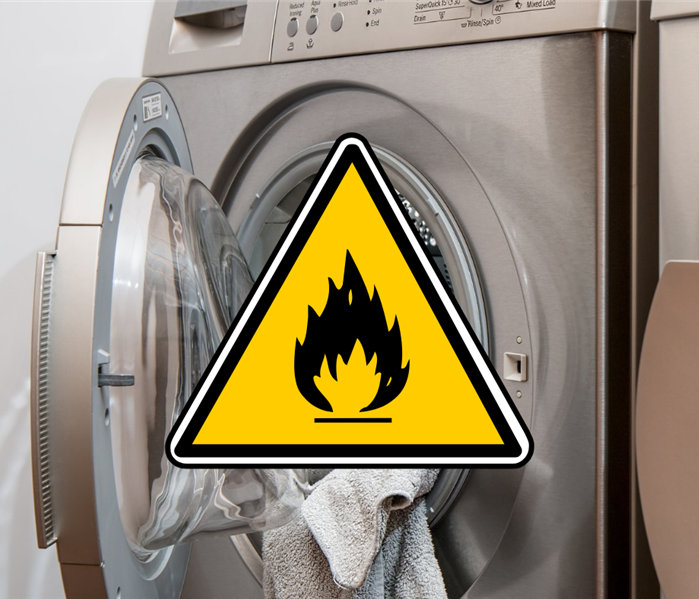 Consider running the dryer only when you are home and awake for your own safety.
Consider running the dryer only when you are home and awake for your own safety.
We usually wash and dry our clothes on a daily or weekly basis. However, it is critical to keep your clothes dryer in good working order in order to keep your home and family safe. Avoiding these specific bad habits can help you avoid a potentially disastrous house fire.
- Installation by a Professional
Professional technicians can ensure that your dryer is installed correctly and carefully. These professionals should be knowledgeable about a wide range of units, including gas and electric dryers, as well as washer/dryer combos. Most manufacturer recommendations, such as proper vent pipe installation, are familiar to these technicians.
A technician would explain how minimizing bends in the pipe is important because it creates fewer opportunities for lint to accumulate. They can install a dryer vent fan for you if the distance between the vent and your dryer is significant. This is an automatic electric device that increases airflow through the duct whenever the dryer is turned on. Having a professional install and service your dryer unit can help ensure that any potential hazards are handled correctly.
- Ongoing Maintenance
According to experts, the primary cause of clothes dryer fires is a failure to clean and maintain them. Check behind the dryer, where lint tends to accumulate. You should clean your dryer once a year and inspect the hose and vent for blockages twice a year.
It is a good idea to have a qualified service person clean the interior of the dryer chassis once a year. This will reduce the amount of lint that accumulates while also providing you with a professional opinion on the safety of your unit. In addition, a professional can inspect the venting and exhaust system. Employ only certified dryer exhaust technicians to ensure that this procedure is carried out correctly.
- Keep Flammables to a Minimum in the Surrounding Area
Dryer lint is not the only flammable that should be considered and kept away from the dryer unit's heat. Anything flammable should be swept up and disposed of before it accumulates and creates a fire hazard. Cleaning up dust and lint is time-consuming, but it is far less difficult than dealing with the aftermath of a fire.
On the same note, do not store cleaning products, boxes, or clothing baskets near the dryer because they may start a fire that spreads quickly. While this is an extreme case, keeping the area clutter-free is an important step toward fire prevention.
- Remove and clean the lint filter before and after each load of laundry.
Household dust and lint are the most common sources of ignition in dryer fires. They congregate within the dryer cavity, which is located near the heating elements. Temperatures can reach 550° here, which is hot enough to start a fire. It is never a good idea to forget to clean out your lint filter.
Cleaning the lint screen before and after each drying cycle is a good habit to get into during your laundry routine. This is an obvious first line of defense in the prevention of dryer fires. Wiping down the interior of the dryer will also remove excess lint buildup that the screen does not catch. This is a less obvious step that many people overlook, but it is nonetheless critical.
It is also critical that you never use a dryer without a lint filter, as this removes the dryer's built-in defense against hazardous lint buildup. This may seem obvious, but you'd be surprised how frequently it occurs.
- Only use metal venting material that is rigid or flexible
Most clothes dryer manufacturers recommend using flexible or rigid metal venting material to maintain proper drying time and airflow. Lint can accumulate in accordion-style ductwork, causing clogs and increasing blockages. Any dryer venting made of plastic or coiled wire foil should be replaced immediately with rigid non-ribbed metal ducts. Purchasing from a reputable vendor is critical to ensuring that your unit meets the necessary safety standards.
It is always a good idea to do your research on any major appliance before purchasing it. Looking at the unit's website to ensure it is from a reliable source, as well as researching customer reviews, can help you make an informed decision.
- Ensure that the air exhaust vent pipe is not obstructed
One of the leading causes of dryer fires is clogged dryer vents. When the vents are clogged, it is difficult to tell. Some people are completely unaware that the vents must be cleaned on a regular basis. However, it is critical to understand that lint accumulates on a large scale within the hoses and, when combined, can cause a serious problem. The accumulation restricts airflow, which can lead to overheating and fire.
In between professional inspections, clean the outside exhaust vent regularly. It is best to check this when your dryer is running by making sure that the exhaust air is escaping properly. If you cannot feel any air, it is likely that there is a lint accumulation clogging the vent outlet. This might require you to disconnect the exhaust vent from the dryer to remove the clog. Remember to reconnect the ducting to the outside vent and dryer before you use the dryer again. If you are unsure of how to do this, it is always recommended that you contact the manufacturer for help or hire a professional.
- Avoid Overloading
Laundry is easy to put off, especially if you have a busy schedule. However, this can lead to you saving all of your dirty laundry to be cleaned on the same day, and it's easy to use this as an excuse to overload your dryer, which can be dangerous.
A heavy load is too much for the dryer and is the most common reason for it to break down. Aside from downtime and repair costs, an overloaded dryer can cause the drum belt, spindle bearings, and pulleys to work overtime, resulting in higher-than-normal temperatures. When this occurs, the friction can ignite a spark, resulting in a fire.
This may be the most straightforward cause of dryer fires and malfunctions to avoid. Maintain organization by limiting your laundry loads to a few times per week. If your schedule makes this difficult or unreasonable, it may be better to simply split your laundry load into two or three loads instead, and take a slightly longer (albeit safer) time to complete this necessary chore.
- Examine Gas Lines
Qualified professionals should inspect the gas line and connection to ensure that they are leak-free and in good working order. Aside from a dryer fire, gas leaks are extremely dangerous and can cause a variety of problems. If you notice a burning odor when using your dryer, stop using it immediately and contact the manufacturer as soon as possible. At all times, stay away from the suspected gas leak area.
- Use the Proper Plug and Outlet
Dryer grounding is critical to their proper operation. Check that you are using the correct electrical plug and outlet as specified by the manufacturer. A licensed professional installing your dryer unit is a good way to ensure that you are doing this.
Check all connections on a regular basis and keep an eye out for any changes. If anything appears to be wrong, loose, or discolored, stop using it right away. Overloaded electrical sockets frequently cause tripped circuit breakers or blown fuses, which can result in a house fire.
- Never use the dryer when you are leaving the house or sleeping.
We've all succumbed to convenience and thrown a load of laundry in the dryer before heading to work or running errands. However, if a fire starts while you are away, you will be unable to put it out. Furthermore, if you are sleeping, it may be too late for you to realize that your house has caught fire.
Consider running the dryer only when you are home and awake for your own safety. It's also a good idea to keep a fire extinguisher in your laundry room in case anything goes wrong.
9 Ways to Keep Your Home Safe From Water Damage
3/13/2022 (Permalink)
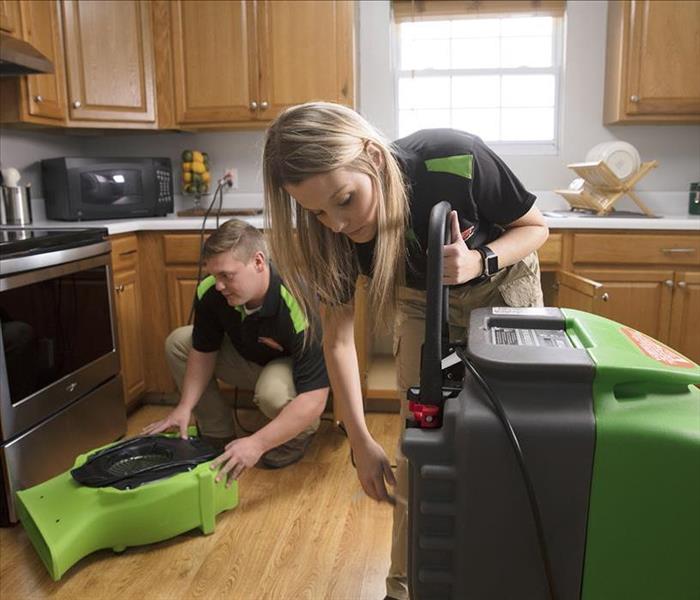 Minor leaks can go undetected for a long time and cause significant damage if left unchecked.
Minor leaks can go undetected for a long time and cause significant damage if left unchecked.
- You should be aware of the location of the stopcock. Ensure that not only you but also your family members are aware of its location. A severe leak or rupture can cause significant damage in minutes. It is critical to understand where and how to turn off the water supply.
- Check for leaks ahead of time. Minor leaks can go undetected for a long time and cause significant damage if left unchecked. Consider that a dripping faucet can waste up to 57 gallons of water per week. Look for signs of stray water beneath sinks and around appliances such as dishwashers and washing machines.
- Check that your sump pump is operational. The sump pump, which is common in basement homes, plays an important role in ensuring that your basement does not flood after prolonged periods of rain. If you have one, make sure it's well-maintained and serviced at least once a year.
- Keep debris out of your gutters. While leaves are the most common cause of blocked gutters, this isn't just an autumnal problem. Moss and weeds are frequently discovered to be a major cause. Blocked gutters play a significant role in damp problems. If you see water running down the side of your house or if your gutters appear to be sagging, they're probably blocked and need to be cleaned.
- Inspect your roof from the inside out. Examine the inside of your attic for signs of water leaking through the roof. Examine the joists for damp spots and the plaster for tea-colored stains. Outside, look for visible damage to the roof and make sure the flashing around any chimneys is in good condition.
- Keep your pipes from freezing. Even if you plan to be away, use a smart thermostat to keep your home at a minimum temperature of at least 10 degrees Celsius. Warm water must be able to circulate through pipes to avoid freezing damage. If a property will be unoccupied for an extended period of time, turn off the water supply at the stopcock and consider draining the system so that no water remains in the system.
- Pipes that are exposed should be properly insulated. Snap-on pipe insulation is inexpensive and effective, and it can also be used outside.
- Install a device to detect water leaks. Detection devices, which are relatively inexpensive, cut off the water supply in the event of a leak, which is critical if you leave your property vacant for extended periods of time.
- Look for any signs of moisture or mold. Damp can be detected by flaking paint or wallpaper, as well as black, speckled marks on skirting and sills. Consider adding more insulation if your walls feel cold to the touch or if you notice a musty odor. In the mornings, check windows and skylights for condensation. Its presence can indicate that your home has higher-than-average moisture levels.
How to Protect Your Property from Floods Caused by Snowmelt, Ice Jams, and Winter Storms
1/28/2022 (Permalink)
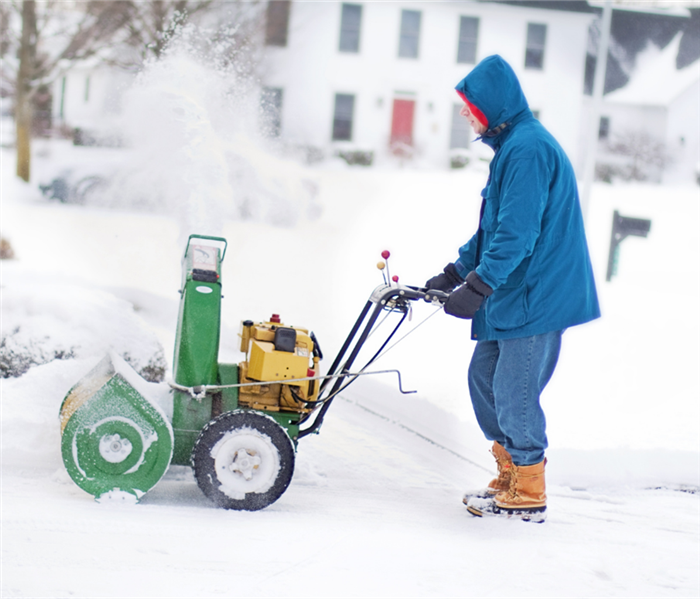 The risk of flooding doesn't go away in the winter.
The risk of flooding doesn't go away in the winter.
When we hear about flooding in the news, we usually hear about spring floods and summer storms, giving the impression that flooding occurs just half of the year. We're not out of the woods yet.
The risk of flooding doesn't go away in the winter, and flooding isn't the only thing to be concerned about when the weather turns cold. Snowmelt, ice jams, and winter storms threaten major floods from the Pacific Northwest to the Great Lakes to the Northeast throughout the winter months.
Winter Flood Risk #1: Snowmelt
Snowmelt is an element of the natural water cycle. However, if snow thaws too quickly to be absorbed back into the soil, neighboring water bodies, and drainage systems, it can flood adjoining land, potentially flooding your basement.
Snowmelt floods can occur anywhere in the snowy north of the US, and they usually occur in small, isolated episodes. But that doesn't rule out the possibility of serious consequences. Let's pretend it snows ten inches, which isn't unheard of in freezing areas. One inch of water equals ten inches of snow, and an inch of floodwater can cost you up to $25k in repairs, according to FEMA.
While snowmelt risk is higher in the spring, climate change has introduced more and more unseasonably warm temperatures every winter. Take the 2019 Midwestern floods, for example. Record amounts of snowfall from January through March were followed by a three-day stretch of 60-degree weather. Rain fell and caused historic levels of flooding along the Missouri River and its tributaries.
Winter Flood Risk #2: Ice Jams
Long cold episodes that cause the surface of rivers to freeze are followed by warm spells, resulting in ice jam floods. Large pieces of ice break off unevenly as temperatures rise, blocking streams and flooding adjacent settlements.
Winter Flood Risk #3: Winter Storms
People who live in lakeside places like the Windy City are probably familiar with flooding in the winter. Strong winds from winter storms can create massive waves that crash over shorelines and barriers into city streets, as they did in Chicago last winter.
These winter storms and subsequent floods are common in the Midwest along the Great Lakes, but they also happen along the East Coast. Nor’easters can trigger storm surges that push heavy ocean tides into coastal communities, on top of heavy rain or snow.
Regular downpours and flash floods can happen throughout the winter, too, as long as temperatures are high enough.
Steps You Can Take This Winter to Prevent Flooding on Your Property
The easiest method to protect your property from a flood is to put measures in place before one occurs. The two most important actions to take care of to ensure that you have both financial and structural flood mitigation on your property.
Step 1: Secure Flood Insurance
Purchase flood insurance as soon as possible once the fear of floods has passed. That way, if you experience flood damage this winter, you'll be able to file a claim swiftly and easily.
The good news is that a flood insurance policy covers all sorts of flood damage equally, so your policy will provide coverage all year. The cost of coverage is decided by factors such as the age of your structure, the type of foundation it has, and your flood zone and risk level.
Step 2: Shovel Proactively and Test Drainage Systems
Shovel snow away from your foundation by at least five feet.
Shovel snow away from a runoff path if your property is on a slope or hill.
Remove any snow that has accumulated on your roof.
Keep snow and ice from accumulating around your property's drainage systems, such as gutters and groundwater pumps.
A bucket of water can be used to test sump pumps.
Floods caused by snowmelt, ice jams, or winter storms can be helped with the same wet and dry floodproofing measures you take to safeguard your property against spring and summer floods, such as constructing drainage systems.
We Are Here to Help!!
1/22/2022 (Permalink)
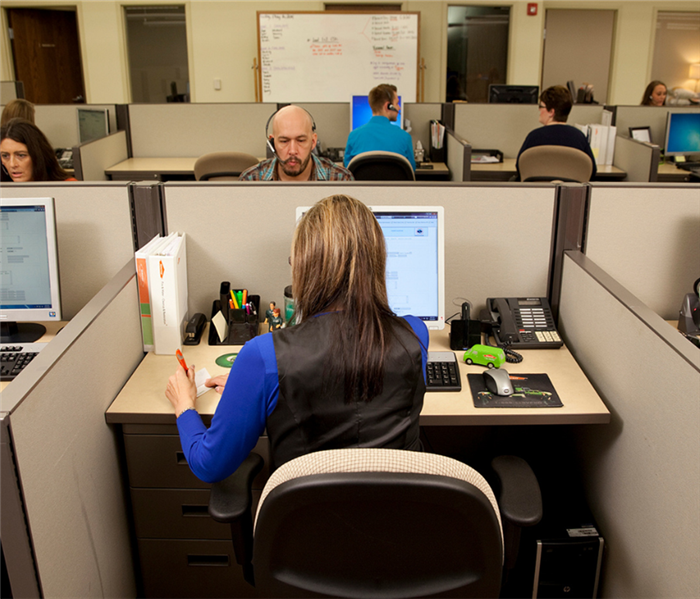 We Answer the Phone Ready to Help
We Answer the Phone Ready to Help
SERVPRO of LaGrange Park/North Riverside is available 24 hours a day for water emergencies, large or small. When you are dealing with water damage, immediate action is crucial. A delay of just a few hours can greatly increase the severity of the water damage.
We Answer the Phone Ready to Help
We understand that when you call us, you may be feeling confused, stressed, and vulnerable. You need an expert to guide you through this crisis. SERVPRO of Arlington Heights / Prospect Heights has the specific water damage training and experience to help you through this tough time. We specialize in water damage restoration—in fact, it's the cornerstone of our business.
What to Expect
When you call, we will ask several questions regarding your water damage emergency. These questions will help us determine what equipment and resources to bring, including how many trained SERVPRO Professionals may be needed.
Our SERVPRO Representative will ask several questions:
- Your name and contact information
- Your insurance information (if applicable)
- The street address of the water-damaged home or business
- When did the flooding or water damage occur?
- What caused the water damage (if known)?
- Is there electricity available (on-site)?
Call us today: (847) 637-3445
Will Insurance Pay For Mold Remediation
1/14/2022 (Permalink)
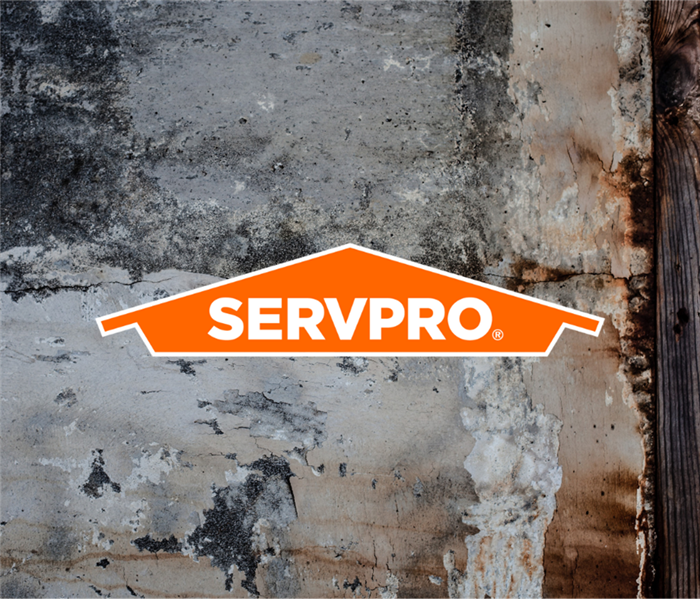 If you notice mold growth, it's best to eliminate it quickly. SERVPRO has the equipment and knowledge to assist in the cleanup process.
If you notice mold growth, it's best to eliminate it quickly. SERVPRO has the equipment and knowledge to assist in the cleanup process.
If you notice mold growth, it's best to eliminate it quickly. SERVPRO has the equipment and knowledge to assist in the cleanup process. Restoration costs can add up quickly, though, and you're probably wondering whether your homeowner's insurance can help pay the bill. Sometimes it does, and sometimes it won't. You'll want to review your policy and speak with your insurance adjuster. Here are three things to know before having that conversation.
1. Was It Accidental?
Is mold coverage not in your policy? Owners usually have to add it separately. That doesn't mean that you can't get aid. Did your roof cave in from snow or ice? Did a pipe suddenly freeze and burst? Insurance companies may payout if the spores spread as a result of something out of the homeowner's control. If the initiating incident is included then the subsequent events get bundled with it.
2. Was the Issue Remedied Quickly?
Before a check is cut, the company could ask for evidence proving your home was under proper care. Take the broken pipe for example. Can you prove that you called for help as soon as possible? Did you let it sit and fester for a while? If the latter is the case, you may have encouraged the fungus growth, giving grounds for denial. It's best to care for water damage as quickly as possible. Prove your efforts by saving receipts. Show efforts to have repairs made and dry up the premises.
3. Is a Different Policy Available?
Speak openly about concerns. As you meet about policy updates including mold insurance limits. For instance, some companies only pay up to a certain amount, capping the remediation and leaving the rest of the cost to the residents. Consider supplementing coverage. While you may have to pay a bit more each year, that annual amount could offset large numbers.
Eliminate mold growth as soon as possible. When you notice an issue, call SERVPRO and we will contact your insurance company if needed.
The Fire Hazards of Winter!
1/5/2022 (Permalink)
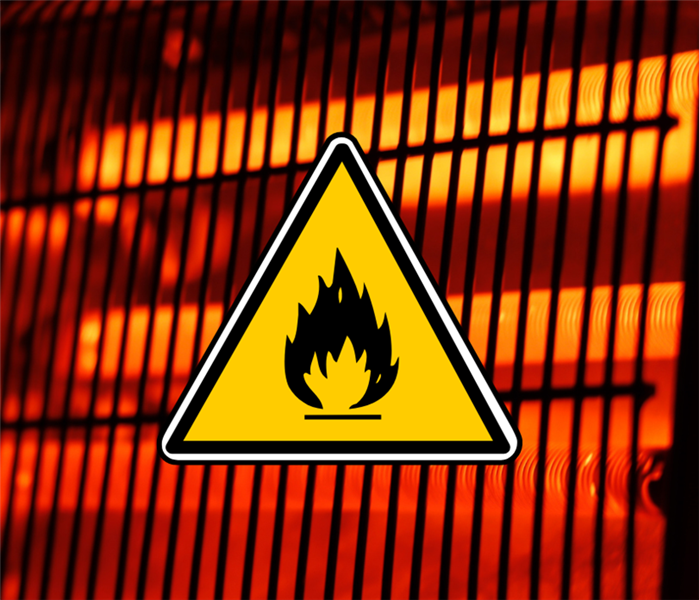 Anything that can burn should be kept at least three feet away from heating equipment!!
Anything that can burn should be kept at least three feet away from heating equipment!!
Keeping ourselves and our houses warm during winter can rapidly turn into a fire hazard, whether it's with a space heater, candles, or an electric blanket. There are various things you can do to make your home more fire-safe, as well as activities you can personally adopt to assist you to stay safe this winter.
Candles
- Candles should be kept at least 3 feet away from anything that can catch fire.
- Place candles in robust holders and in places where they won't be easily knocked over.
- Make sure that candles are out of reach of youngsters and dogs.
- If you leave the room, fall asleep, or go to bed, extinguish all candles.
Electrical equipment/appliances
- Only use one wall outlet at a time to plug in a heat-producing gadget (coffee maker, space heater, microwave, etc.).
- When using a heat-producing appliance, never utilize an extension cord.
- Extension cords should only be used for a short period of time.
- Furniture, beds, curtains, clothing, and flammable or combustible gases and liquids should all be kept away from lamps, light fixtures, and light bulbs.
Heaters
- Make room for space heaters! Anything that can burn should be kept at least three feet away from heating equipment (furnace, fireplace, wood stove, portable heater, etc.).
- When you leave the room or go to bed, turn off the space heater.
- A competent specialist should clean and inspect your heating equipment and chimneys once a year.
- Never heat your home using an oven.
Always make sure you have a working smoke and carbon monoxide alarm at all times in case of a fire.
Be Prepared for the Next Winter Storm With These Tips!
1/5/2022 (Permalink)
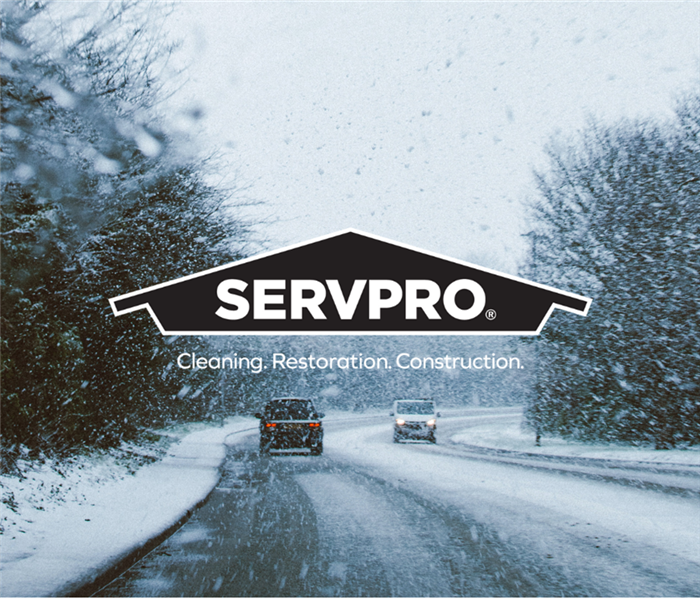 Before the next winter storm arrives, get your car's antifreeze levels, battery, ignition system, exhaust system, heater, lights, and oil checked.
Before the next winter storm arrives, get your car's antifreeze levels, battery, ignition system, exhaust system, heater, lights, and oil checked.
Winter storms can bring not only a lot of snow, but also bitterly cold temperatures, strong gusts, freezing rain, and ice. They can bring down trees, make roads and pathways extremely unsafe, and produce power outages that linger for days. Schools and daycare facilities may be closed as a result of the disruption to public transit. Winter storms also increase the likelihood of car accidents, hypothermia, frostbite, carbon monoxide poisoning, and heart attacks.
That's why, with winter storm season in full swing, knowing how to protect yourself, your family, and your house safe is essential.
Here are some things you can do now to prepare for the impending storm.
1. Make sure you have enough food in your pantry.
Because it's critical to stay indoors and avoid traveling during a winter storm, making sure you're well-stocked on food is critical. Many non-perishable things should be in your pantry so that you don't have to worry about anything deteriorating if you lose electricity. Ideally, you should have enough food to last at least three days.
2. Buy Bottled Water
Make sure you have plenty of bottled water on hand in case your pipes freeze and you can't get water from the tap. You may also require water for brushing your teeth, cleaning dishes, flushing toilets, or bathing if your pipes freeze. You can also prepare ahead of time by filling the bathtub, jugs, bottles, and other containers with water.
3. Get your prescriptions filled and hygiene items picked up
Make sure all of your prescription drug prescriptions are filled so that you have enough on hand to last at least three days, if not a week. This eliminates the need to rush to the pharmacy when the roads are poor.
You should also stock up on any hygiene products you may require, like as diapers, toilet paper, tampons, and toothpaste. Picking up moist toilet paper can also be beneficial if water is scarce.
4. Check your tools and stock up on ice melt.
Ice melt salt sells out quickly in local stores just before a storm, so start buying up early to ensure you have enough for after the storm. You'll need enough to shovel and salt all of your outside stairs, stoops, and walkways immediately following the storm, before the snow melts and turns to ice as the temperature drops.
Before the storm hits, make sure you have a good snow shovel (or two). Make sure they aren't too worn or cracked, as this will only complicate your life. You'll also want to make sure your tool kit is up to date and simple to locate, since you may need a wrench or pliers to quickly turn off utilities.
5. Be Prepared For A Power Outage
Charge your cell phones in advance of the storm, and have some portable battery backups available in case the power goes out. It's also a good idea to keep flashlights or battery-powered lights around the house so you don't have to waste time looking for them.
If you live in a region where power outages are common, you should consider purchasing a generator, either a portable or a standby one for your home. If you have a portable generator, make sure you have enough gasoline or propane before the storm to operate it whenever and for as long as you need it. Always use portable models outside, away from windows, and never use them indoors or in confined locations like garages, crawl spaces, or basements.
6. Take Care of Your Water Pipes
Allow cold water to flow from faucets supplied by exposed pipes to help prevent frozen pipes. Running water, even at a trickle, is less likely to freeze. Allow warm air to circulate near plumbing by opening cabinet doors in the kitchen and bathroom. Pipe insulation should be added to any pipes that are prone to freezing. Maintain a temperature of no less than 55 degrees Fahrenheit inside your home.
7. Make sure your windows and doors are well-sealed.
Drafty windows and doors let chilly air in while letting warm air out. That's why it's a good idea to use an insulation kit from any hardware shop to seal any windows. Weatherstripping can also be purchased at the store to improve the seal on your front door.
Insulated blinds are also available to help keep the warm air inside the house.
8. Inspect and replace smoke and carbon monoxide detectors if necessary.
Make that your smoke and carbon monoxide alarms are still operational. It's advisable to replace them with detectors that work during a power outage if they aren't already battery-powered or battery-backed to keep your family safe.
9. Get Your Backyard Ready
Take a trip around your yard before the storm to check for any tree limbs that could fall on your house. If you have the ability, you should prune those back to prevent them from causing damage to your property during the storm – or hire someone to do it for you.
If any tree branches are near power lines, you should get them trimmed or chopped back by a professional or the utility to assist reduce the danger of a power outage.
Mulch your gardens, if you haven't already, to protect plants that you don't want to freeze.
10. Get Your Car Ready
Before the next winter storm arrives, get your car's antifreeze levels, battery, ignition system, exhaust system, heater, lights, and oil checked.
Then, in case you're trapped in your automobile due to the blizzard, prepare your car with items you might require. Blankets, water, chains, jumper cables, ice scrapers, maps, bottle water, warm clothing, non-perishable snacks, and a first-aid kit should all be in your car. It's also a good idea to have some sand or kitty litter on hand in case you get stranded in the snow or ice.
11. Keep yourself up to date
Listen to your NOAA weather radio for hazardous weather alerts and warnings. Always keep an eye on the weather forecast, whether it's on the internet or on your phone. Sign up for emergency alerts and updates in your area.
In the event of an emergency, know how to cut off your utilities, such as gas lines.
Before the storm strikes, do some research on nearby shelters and warming centers, and establish a plan for where to go and how to get there if you need to leave your house in an emergency.
Also, be aware of the symptoms of hypothermia and frostbite, and be prepared to check on your neighbors, particularly if they are elderly or have young children who are more vulnerable to the cold.
Who Do You Trust With Your Commercial Property Damage?
12/31/2021 (Permalink)
There are over seven million small businesses in the U.S., ranging from construction firms to grocery stores to home-based businesses. According to the U.S. Small Business Administration, as many as one in four businesses that suffer some kind of major disaster do not reopen afterward.
According to the National Fire Prevention Association, U.S. fire departments responded to about 3,300 office property fires per year between 2007 and 2011. Those fires resulted in about $112 million in property damage each year, and most were in business offices and happened during business hours. 90% of fires were large enough to activate sprinklers, which were effective 88% of the time.
The NFPA also has statistics specific to manufacturing facilities. According to their research, there are about 37,000 fires at industrial or manufacturing facilities each year, resulting in 18 deaths, 279 injuries, and $1 billion in property damage. Heating equipment and stop tools were the leading cause, sparking 28 percent of the fires. Mechanical failure or malfunction caused 24 percent of the fires.
If your commercial property has experienced a fire, and or water damage, every minute you are offline is money down the drain. Call SERVPRO Arlington Heights/Prospect Heights at (847) 637-3445 to get your business back up and running.
Four Ways To Prevent Mold Growth In Your Home
12/31/2021 (Permalink)
If you have mold growing in your Arlington Heights, IL home, and you don’t know how to deal with it, you might feel stressed and frustrated. However, there are several things that you can do, such as preventing water damage, to keep growth from forming. Keep these things in mind if you have a fungus problem in your house.
1. Fix Leaks Immediately
Because mold growth happens more quickly in moist environments, you should be sure to repair any leaks in your home as soon as possible. Whether the water is coming from a window, the plumbing, or the roof, this is a prime breeding space for mold. Even if the leak is small, it can cause enough water damage over time to become a large problem.
2. Keep Humidity Levels Low
If your home has high humidity, then you are more likely to find mold growth. You can use a dehumidifier or an air conditioner to help keep humidity at an appropriate level.
3. Ventilate Areas That Are Prone to Mold
Active mold prevention is more often required in rooms where you use a lot of water, such as the bathroom, kitchen, and laundry room. Keeping these areas ventilated can help. You should also make sure to dry any spaces where water tends to build up.
4. Clean Regularly
Regular maintenance and cleaning of your home is perhaps the best way to prevent mold. If you are cleaning on a regular basis, especially with products that kill mold spores, then the fungus will not have a chance to grow and spread.
While there are many ways that you can prevent mold, it can also be helpful to hire a professional mold remediation service if the problem is too large for you to handle on your own. Particularly if you have extensive water damage, it is a good idea to get outside help. A professional service can remove the mold, as well as repair the damage, and prevent it from returning.
Tips on Saving Your Electronics After a Fire
12/31/2021 (Permalink)
Tips On Saving Your Electronics
When it comes to your business, an electrical fire can be devastating. The flames, heat, and smoke can damage nearly everything. Smoke damage can affect the computers that hold sensitive data and the appliances that help your business run. Firefighting attempts may douse electronics with extinguishing agents. If you have experienced a fire at your Prospect Heights, IL, business, here are some tips for saving your electronics.
1. Disconnect
Due to the possibility of water exposure, ensure that all electronics are unplugged after an emergency. Several variables can come into play regarding the damage to electrical systems during a fire. The extent of the destruction can vary depending on where the device was located at the time as well as if any of its circuitry was exposed and how high the heat levels rose. Many devices use a small amount of power to maintain internal memory, even when they are switched off, so be sure to fully and safely disconnect them.
2. Inspect
If handled properly, many electronics have a high recovery rate after an electrical fire. You should contact professionals with specialized fire and water damage restoration training to complete this. Experts in emergency restoration services will be able to remove your electronic devices from your damaged property to a clean, safe environment. This will allow for an assessment of fire, water, and smoke damage. After the inspection, the team can develop a restoration project for your items, such as a specialized computer cleanup plan.
3. Restore or Replace
After inspection, the professionals will determine whether restoration is possible or if you need to replace your electronics. Items that can be salvaged require expert drying and cleaning to remove soot, magnetic charge, and black film. Items that cannot be saved may be replaceable under your warranty, so be sure to check your records.
An electrical fire can happen suddenly and take you by surprise. Be sure to know how to handle this situation, and learn about saving electronics for your business.
Is Your Commercial Building Prepared for Winter?
12/1/2021 (Permalink)
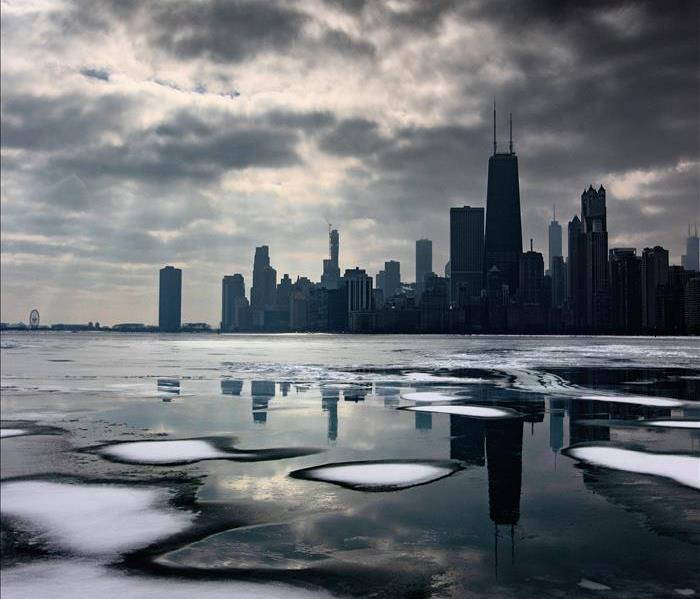 Tips to prepare your commercial building for rigid weather conditions
Tips to prepare your commercial building for rigid weather conditions
Winter is near! Is your commercial building ready for the weather?
In Chicago, we experience harsh winters that can cause significant damage to our property. Damage can include frozen pipes, roof damage, ice damming, and flooding. Here are some tips to prepare your commercial building for rigid weather conditions.
Check your HVAC system.
Your HVAC system works hard all year, but in the winter it has to work even harder. Because the HVAC system has an impact on the air quality throughout the building, it's vital to get it serviced and inspected before winter arrives. Here's what I suggest:
- Air filters should be checked and replaced on a regular basis
- Examine and fix any broken components.
- Check for leaks or holes in the vent work that could reduce efficiency.
- Cover any outdoor air-conditioning units that will be left unattended during the winter.
- Check the ventilation system to see if exhaust gases are being vented out of the structure.
Inspect the insulation.
Inspect your building's insulation for holes or compromised places that could cause heat loss to maintain efficiency. Roofs, weather stripping, and unheated regions such as attics should all be given extra care. It is commonly stated that a poorly insulated attic might lose up to 25% of heat in the fall and winter.
Prepare your plumbing.
The average claim for frozen pipe water damage is currently at $10,800. Fixing frozen pipes is not only inconvenient and costly, but it also causes unwanted downtime for a business. Keep the building's internal thermostat set to at least 55 degrees Fahrenheit at all times to prevent freezing.
Check your roofing.
Inspect the roof for holes or damage that could cause leaks during snowmelt to avoid leaks and other costly issues. To ensure the roof is physically strong and capable of withstanding another winter, check for loose shingles and repair damage to existing seals and flashing.
Have a plan in place in case of a disaster.
What will your company do if the worst happens? Prepare for a wide range of disasters, such as fire, flooding, and gas leaks. Keep all new and existing employees and tenants informed about the protocols, and make sure they have a copy of the various evacuation plans.
7 Ways to Prevent Frozen Pipes
12/1/2021 (Permalink)
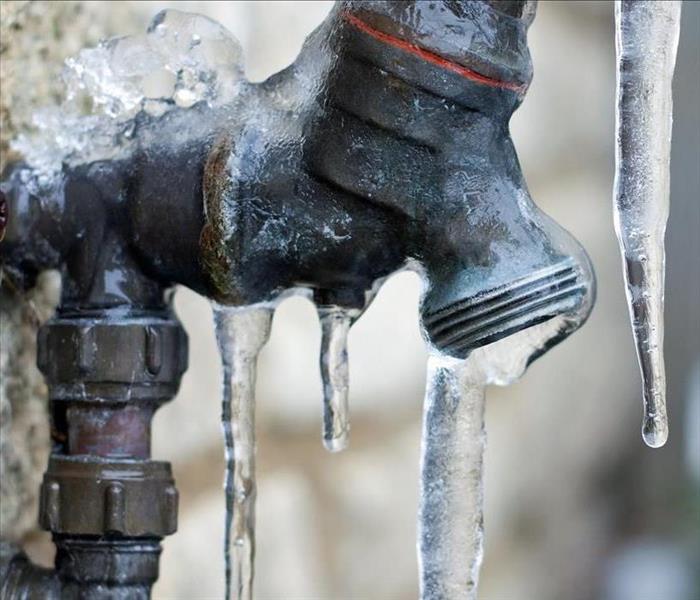 Tips to help prevent pipes from freezing
Tips to help prevent pipes from freezing
Frozen pipes are caused by three factors: rapid temperature dips, insufficient insulation, and thermostats set too low.
- Insulate. Even if you live in a climate where freezing is unusual, pipe insulation in your home's crawl areas and attic can help. The pipes that are exposed are the most vulnerable to freezing. Remember that the more insulation you use, the better your pipes will be protected.
- Use heat tape or wire. Wrapping pipes with heat tape or thermostatically controlled heat wires is one option. Use only goods that have been approved by a third-party testing organization, such as Underwriters Laboratories Inc., and only for the purpose indicated (exterior or interior). Follow the manufacturer's installation and operation directions to the letter.
- Seal leaks. Locate and completely plug any leaks that enable chilly air to enter the house. To keep the cold out, look for air leaks around electrical cables, dryer vents, and pipes and seal them with caulk or insulation.
- Hoses, valves, and faucets should all be secured outside. Disconnect garden hoses and, if possible, use an interior valve to turn off and drain water from pipes running to outside faucets before winter arrives. This decreases the risk of freezing in the short distance between the home and the pipe.
- Allow the water to drip. It may only require a trickle of hot and cold water to keep your pipes from freezing. When the weather is cold, let warm water trickle from a faucet on an outside wall overnight.
- Make the necessary adjustments to the thermostat. Frozen pipes can also be avoided by keeping your thermostat at the same temperature throughout the day and night. This also helps to lessen the strain on the furnace during periods of extreme cold.
- Open Cabinet doors. This permits heat to reach pipes under sinks and appliances near outside walls that aren't insulated.
Water not coming out of the faucet is one of the first indicators of a frozen pipe. If you notice this, go to the basement and double-check that the water is still on and that there isn't a leak. Continue your check after you've confirmed these two points to ensure that none of your pipes have burst. If you discover that your pipes are frozen but none have burst during your search, you have two options:
- Call a plumber to thaw your frozen. This is usually a better option. You don't know where the frozen pipes are or you can't get to the frozen region if you don't think you can safely thaw the pipes yourself.
- Make an effort to thaw the frozen pipes on your own. Be advised that if this option is not done correctly, it can cause more complications.
Safety Tips for Deep Frying a Thanksgiving Turkey
11/3/2021 (Permalink)
 Safety tips to protect yourself, your loved ones, and your home.
Safety tips to protect yourself, your loved ones, and your home.
It’s November, so it’s time for turkey!!!
Deep frying is the newest trend in Thanksgiving turkey preparation. The outcomes can be wonderful, but the process can be risky. I will explain why deep-frying is dangerous and share safety tips to protect yourself, your loved ones, and your home.
Why deep fryers can be dangerous
- The fryer has the potential to tip over and spill gallons of heated oil.
- When the turkey is placed into the cooking pot, overfilling the pot with oil produces leakage. If the oil spills onto the burner, the entire fryer will burst into flames.
- When frozen or partially frozen turkeys are placed in the fryer, steam quickly expands, causing the oil to boil over.
- If there are no thermostat controls, the fryer units have the potential to overheat to the point of combustion.
- The sides of the cooking pot, the lid, and the pot handles can become extremely hot, resulting in severe burns.
Deep-Fried Turkey Safety Tips
- Place the turkey fryer at least 10 feet away from your home and away from children and pets. It should never be left unattended.
- Place the fryer on a leveled, flat surface and carefully measure out the amount of oil required.
- Make sure your turkey is totally thawed and dry before cooking.
- Keep an eye on the temperature of the oil and use the fryer with caution. Severe burns from the lid and handle are possible.
- Always keep a fire extinguisher or multipurpose dry powder on hand in case oil catches fire.
Thanksgiving Safety Tips and Fire Facts
11/2/2021 (Permalink)
 Thanksgiving Safety Tips and Fire Facts
Thanksgiving Safety Tips and Fire Facts
The kitchen is the heart of the home for most people, especially around the holidays. Everyone appreciates being a part of the preparations, from testing family recipes to creating cakes and pastries.
When there's a lot of activity and people at home, it's crucial to keep fire safety top of mind in the kitchen during this festive but chaotic time. As you begin to plan your holiday schedule and prepare a large family meal, keep in mind that by following a few easy safety tips, you can spend time with your loved ones while also keeping yourself and your family safe from fire.
Safety Tips
- While you're cooking, stay in the kitchen to keep an eye on the food.
- The stove will be very hot, so children should keep at least three feet away.
- Keep children away from hot foods and beverages. Vegetables, gravy, or coffee steam or splashes can cause significant burns.
- Make sure that no electric wires from a coffee maker, plate warmer, or mixer are dangling off the counter or within easy reach of a child.
- Matches and utility lighters should be kept out of reach of children, preferably in a locked cabinet.
- Never leave a lit candle alone in a room unattended.
- Check to see if your smoke detectors are working. By using the test button, you can put them to the test.
Thanksgiving Fire Facts
- Thanksgiving Day, the day before Thanksgiving, Easter, and Christmas Eve are the most common days for home cooking fires.
- On Thanksgiving Day in 2018, U.S. fire agencies responded to an estimated 1,630 home cooking fires, the busiest day for such disasters.
- Cooking that was left unattended was by far the most common cause of cooking fires and fire deaths.
How to Stay Safe During a Wind Storm!!
11/1/2021 (Permalink)
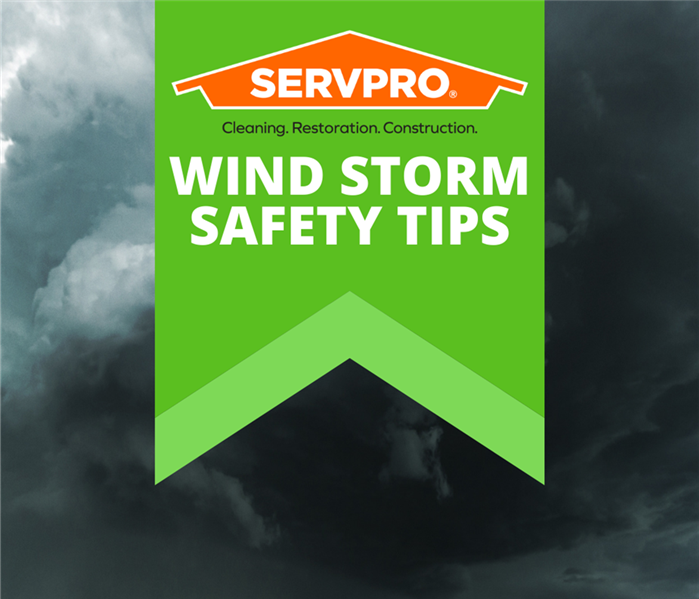 Wind Storm Safety Tips
Wind Storm Safety Tips
Winds can reach speeds of more than 100 miles per hour during extreme weather events such as tornadoes!
High winds of any speed can cause damage to homes and property, as well as flying debris and shattered glass, which can cause injuries. A disaster preparedness plan for your family, including a disaster survival kit and an emergency evacuation plan, can save your family from injury and inconveniences.
Keep yourself updated!
Weather updates and advisories will be broadcast on the radio and television. Having the most up-to-date information is critical to keeping safe during a weather event. For updates, utilize an NOAA Weather Radio or battery-powered radio, and keep an eye out for mobile alerts.
A high wind alert indicates that persistent winds of more than 25 mph are expected.
Warnings for thunderstorms and tornadoes should be taken seriously since they indicate that severe weather has been detected and is on its way.
During bad weather, seek cover!
- Remove yourself from windows and glass doors and into the center of your house or basement. Take refuge under a stairwell or a large piece of furniture.
- During heavy winds, do not stay in a mobile home. High winds can easily topple them, and flying debris can penetrate their light frames and exteriors.
- Make a safe room for yourself. If you live in a location where violent winds are common, you should consider constructing a safe room in your home.
Protect your home against extreme weather and wind events with these helpful tips!
- Vehicles that you want to leave behind should be parked or stored in a garage. If you don't have a garage, relocate your belongings to higher ground in the event of flooding.
- Garbage cans, patio furniture, barbecues, and other potentially wind-borne items should all be kept inside your house or garage.
- Close the doors and windows to your home. In the event of severe winds, board up windows and glass doors with shutters or plywood to prevent harm from broken glass.
- Secure your outdoor pool and turn it off. To avoid damage, turn off the circuit breaker for your outdoor pool and remove the engine.
- Tree branches that pose a danger should be removed. Pruning branches that may break off during a storm and injure someone or cause damage to your home or vehicles is a good idea.
- A generator can be rented or purchased. A generator can assist keep refrigerators, freezers, and lights running if you can rent or buy one. A severe storm can knock out power for days, if not weeks, at your home.
- Keep an ear out for weather updates on the radio. If you are told to evacuate, follow local officials' instructions and head to a shelter.
- Let your friends and family know where you'll be.
If you don't have time to get to a shelter, go to your safe room if you have one. Otherwise, stay in the center of your house or basement, away from windows, and hide under a stairwell or a large piece of furniture.
Why SERVPRO is a Top Choice for Post-Disaster Cleanup and Restoration
11/1/2021 (Permalink)
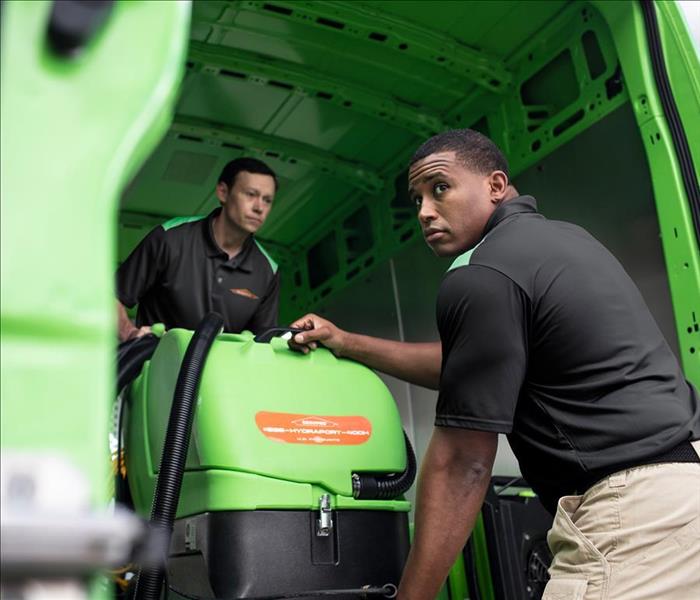 Why SERVPRO is Top Choice
Why SERVPRO is Top Choice
#1 Excellent Disaster Preparedness Resources
SERVPRO's network is one of the reasons for its success in crisis response. Because of the state-wide franchise network, there are enough resources to take on any job in any location. The experts of SERVPRO are prepared to repair commercial or residential damage.
Regardless of the size of the incident, all SERVPRO teams have access to additional resources for a quick and reliable response.
#2 Highly Skilled Groups
Each SERVPRO crew is made up of experts that have vast experience in catastrophe recovery.
SERVPRO is at the forefront of catastrophe recovery on a regular basis, allowing it to develop its processes and respond quickly. These teams are in charge of all areas of catastrophe recovery, including:
2017 Hurricane Harvey
2014 Polar Vortex
2010 Nashville Floods
2005 Hurricane Katrina
#3 Quick Responses for Lowering Total Costs
Storms cause damage on a property, enabling plenty of water to enter regions that should be dry. To save the building's structural integrity, the water must be removed quickly.
SERVPRO conducts a thorough cleaning process to prioritize areas that will be costly to replace or restore if not addressed right away. The response team knows which surfaces should be saved and which may be replaced at a reasonable price. As a result, the restoration time is reduced and the outcomes are more consistent.
#4 Experience with Insurance Companies
After a disaster, dealing with an insurance company is a necessary part of the process. That's why SERVPRO has established a network of contacts in the industry to ensure a seamless and effective relationship. SERVPRO works nicely with any insurance provider and has a good reputation for quality work on-site.
Emergency Ready Program for your business
9/29/2021 (Permalink)
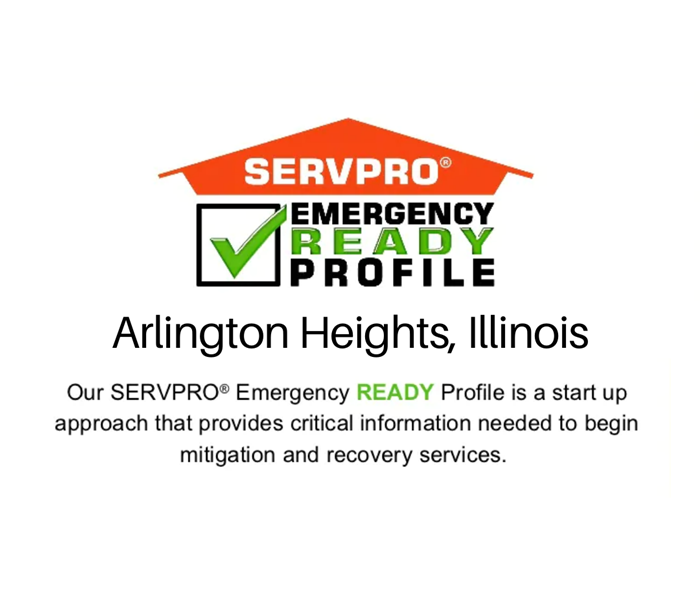 Join our Join our Emergency Ready Program!
Join our Join our Emergency Ready Program!
Are you and your clients “Ready for whatever happens?”
If an emergency situation arises in your workplace, give us a call and we'll be there as soon as possible to help.
We're here for you 24 hours a day, 7 days a week to get your business back on track! Our experience includes fire and water damage restoration, while also electronics restoration and document drying.
Our professionals are trained to be aware of legal and environmental issues while working within your budgetary constraints to repair the affected area. We understand that every hour spent cleaning is an hour of lost revenue and productivity.
Preparation is essential for surviving any major disaster, whether it's a minor water leak, a large fire, or a widespread flood. The greatest time to prepare for such tragedies is before they occur.
By becoming a member of our SERVPRO of LaGrange Park / North Riverside Emergency READY Program (ERP), you will get access to over 40 years of experience in lessening the impact of natural and man-made disasters.
Give us a call today to schedule your Emergency Ready Program (847) 637-3445!
When storms or floods hit Arlington Heights, SERVPRO is ready!
9/27/2021 (Permalink)
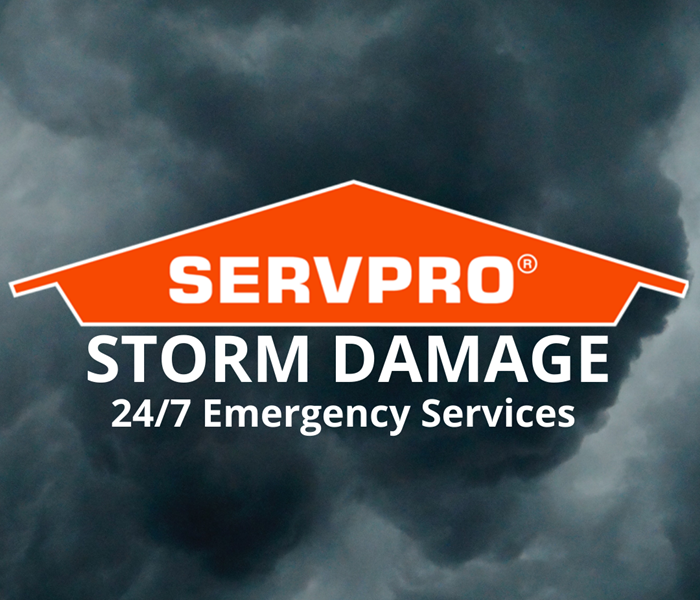 24/7 Storm Damage Emergency Service
24/7 Storm Damage Emergency Service
The effects of a storm or a flood can be catastrophic! You need to act quickly, and you need a professional that has experience with storm damage. SERVPRO Arlington Heights Professionals have the training, equipment, and resources to manage any major disaster and can respond quickly to storm and flooding situations.
What do we provide?
- 24 hour Emergency Service
- Highly Trained Water Damage Specialists
- Resources to Handle Storms and Disasters
Regardless of the Storm Damage, We Can Help!
SERVPRO of Arlington Heights can handle any size disaster, regardless of the type of storm. Our Disaster Recovery Team can respond rapidly with additional resources during major storms and disasters.
- Flooding caused by heavy rains
- Tornadoes and wind damage
- Ice and snowstorms
Have storm or flood damage? Call us at (847) 637-3445!
Hurricane Season 2021
9/13/2021 (Permalink)
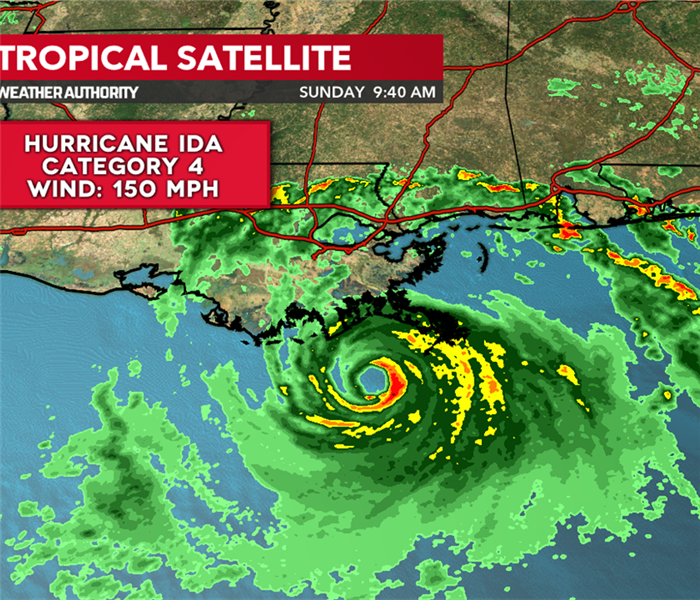 Have a plan and be prepared!
Have a plan and be prepared!
Hurricane season is upon us! Experts say that the hurricane season starts in May and lasts all the way until November on average. Each year is different. However, as on Friday September 10th, it has officially marked its peak of hurricane season for the Atlantic Basin. We have seen during this year there has been 13 named storms, and 5 of those reached a hurricane status and 3 of which became major hurricanes. Here is a list of the 13 hurricanes so far..
1. Ana: Formed near Bermuda on May 22nd
2. Bill: Formed off the East Coast on June 14th
3. Claudette: Formed in the northern Gulf of Mexico June 19th
4. Danny: Formed along the East Coast near Charleston, South Carolina on June 28th
5. Elsa: Formed in the central tropical Atlantic on July 1st
6. Fred: Formed in the eastern Caribbean on August 10th
7. Grace: Formed in the central tropical Atlantic on August 14th
8. Henri: Formed near Bermuda on August 16th
9. Ida: Formed south of Jamaica in the Caribbean on August 26th
10. Julian: Formed far out in the Atlantic on August 29th
11. Kate: Formed in the central, open Atlantic on August 30th
12. Larry: Formed in the far eastern Atlantic on September 1st
13. Mindy: Formed in the northeaster Gulf of Mexico on September 8th
With the knowledge of knowing we have officially hit the peak of hurricane season, here are some tips on how to be prepared for a hurricane in your area.
- Make a plan: If evacuation is necessary, turn off all utilities and follow community disaster preparedness plans. Make sure you select a common meeting place for all family members. Also make sure you have an evacuation plan for your pets.
- Secure the exterior: Trim any large trees and shrubs. Bring in all outside patio furniture, potted plants, bikes and toys inside.
- Install storm shutters: These will protect your windows, doors and skylights with appropriate shutters or impact-resistant glass.
- Check wall hangings and art: Make sure all wall hangings are secure and take notes about your art collection and any existing damage.
- Move your cars: Keep your cars to higher ground or park them in your garage against the garage doors.
- Power up: Fill up your car's gas tank, make sure all cell phones are fully charged, test your generator and always have plenty of fuel ready in case the power goes out.
- Store important documents: Make sure to keep important documents, such as legal papers, birth certificates, marriage license, insurance policy information, and any valuables in a safety deposit box in the closet of your home.
- Prep an emergency kit: You will need to gather any flashlights, portable radio, batteries, non-perishable food, bottled water, cash, blankets, toiletries and clothing.
- Identify a shelter room: This area should be on the first floor in the central part of the house that has no windows.
We here at SERVPRO understand that when disaster strikes, you don't know what will be left from the aftermath. We are always here to help with any mitigation or reconstruction services you may need!
National Preparedness Month
9/13/2021 (Permalink)
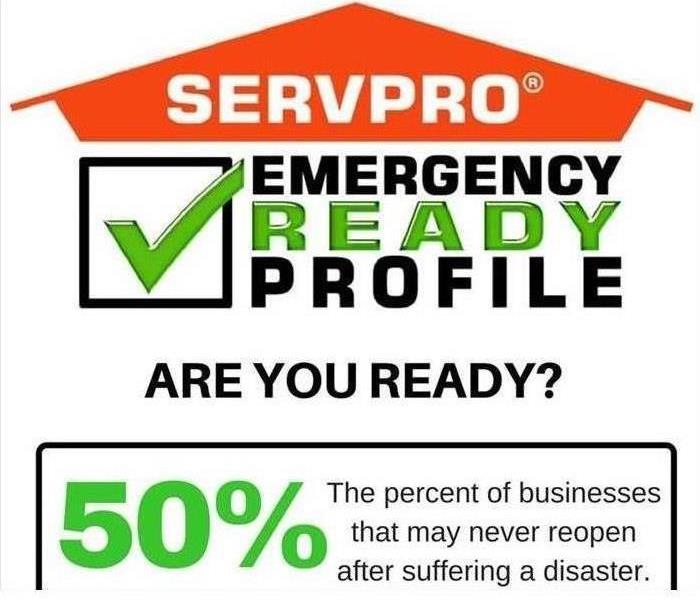 Be prepared!
Be prepared!
As a business owner, insurer or property manager, you are a leader in your community! Therefore, you have the opportunity to set an example to others around you. September is National Preparedness Month (NPM), and this year we are encouraging you all to join your community in preparing for emergencies and disasters. You can do so by leading the efforts to encourage your community to become more prepared as a whole. Disasters WILL HAPPEN, and not only do they devastate neighborhoods, but entire communities including local businesses of all sizes.
As an employer in your community, having a business continuity plan can help protect your company. It can also maximize your chances of recovery after a disaster takes place. There are 3 simple steps to take.
1. Plan to stay in business
2. Encourage your employees to become ready
3. Protect your investment
There are many supporting resources available that can begin to prepare your business for a disaster. We here at SERVPRO can help your business with our Emergency READY Profile (ERP). Here are some of the advantages of our ERP program.
- A no-cost assessment of your facility.
- A concise profile document that contains only the critical information needed in the event of an emergency.
- A guide to help you get back into your building following a disaster.
- Establishes your local SERVPRO franchise professional as your disaster mitigation and restoration provider.
- Identification of the line of command for authorizing work to begin.
- Provides facility details such as shut-off valve locations, priority areas, and priority contact information.
Preparation is KEY to making it through any size disaster, whether it is a small water leak or a large fire. The best time to plan is not when the event happens, but well before it takes places. No one ever plans on a disaster, but you now can plan for it and be prepared. Call us today to set up your very on Emergency READY Profile!
Sewer back up!
9/13/2021 (Permalink)
Sewage back ups are very unfortunate events that can happen in any home or commercial property. What causes this type of water damage anyway? Well, typically there are three main categories that a sewer back up happens: damaged sewer pipes, clogs, and tree roots in the sewer system. Let's look at these three areas a bit closer.
- Clogging: Typically if you only have one area of your home that experiences a backup, like a tub or a sink, then there is typically a clog and can be fixed with cleaning the drain. However, if you have the backup in several areas of your home, then there is a blockage at the main or the private that is causing the issue. Unless the blockage is removed, the overflow will continue and will damage your entire home or business area.
- Tree Roots: The roots of large trees in the proximity of a sewer line can often cause severe problems. They can literally grow into the pipes and cause holes and blockages or they may wrap around the sewer line and crush it.
- Damaged Sewer Lines: Older properties with older sewer lines that have not been upgraded can have broken or collapsed lines. All the pipes and sewers in older homes were built using cast iron and clay which can wear off with time, get rusty, and easily break down. Present day plastic sewer lines cannot cause such problems simply because they don’t rust.
Sewage backups are not only hazardous to your health, but they can cause a great amount of structural damage to your home. If you experience a sewage back up do not attempt to flush the toilet. Do not use harsh chemicals to attempt to clean out the drain. This can actually cause more damage and make things worse. Open your windows to let fresh air in. It is also very important to keep pets and children away from the affected area. However, the most important thing to do, is to call for professional help. We here at SERVPRO are always here to help!
Village Hall!
8/9/2021 (Permalink)
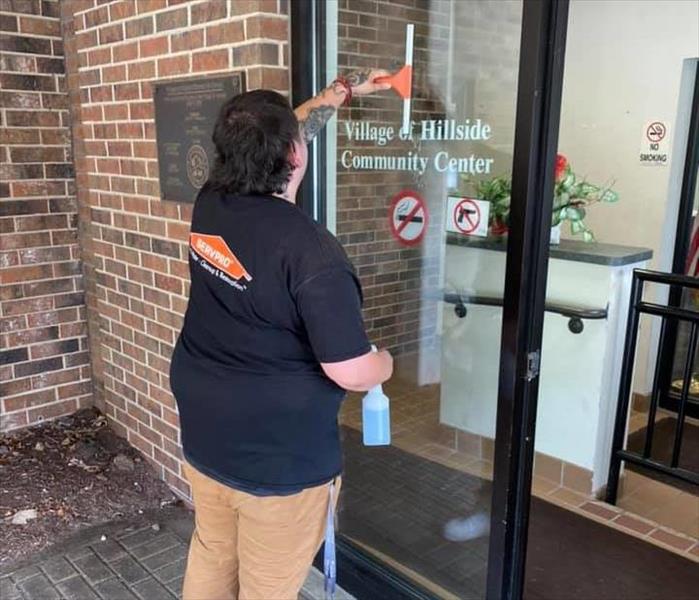 Cleaning and sanitizing the Village of Hillside's community center!
Cleaning and sanitizing the Village of Hillside's community center!
With the summer upon us, we are starting to see communities begin to open back up after the devastating of COVID. For example, the Village of Hillside has started to allow their Summer Nights of Hillside to take part again after being shut down for almost 2 years! These summer nights consists of a Car Show, Marketplace, food tents and concert area. The Village of Hillside wanted to make sure they take the appropriate steps when it came to sanitizing and cleaning the areas for the community's safety. We where instructed to clean the Village Community Center which allowed vendors to go and promote their small businesses to the community of Hillside. The police trailer was set out for the band that would be performing that night, and we made sure they also had a case of SERVPRO water. We also sanitized the main lobby of the Village Hall that allowed anyone to come in and take flyers, or any questions they may have throughout the event! It was such a pleasure to not only be able to help out the community of Hillside, but to also get out and enjoy some good music, drinks and food with some pretty awesome people we met throughout the night. We are always here to help, and love to do our part when it comes to commercial buildings in the community.
Tornado Watch: BE PREPARED!
8/9/2021 (Permalink)
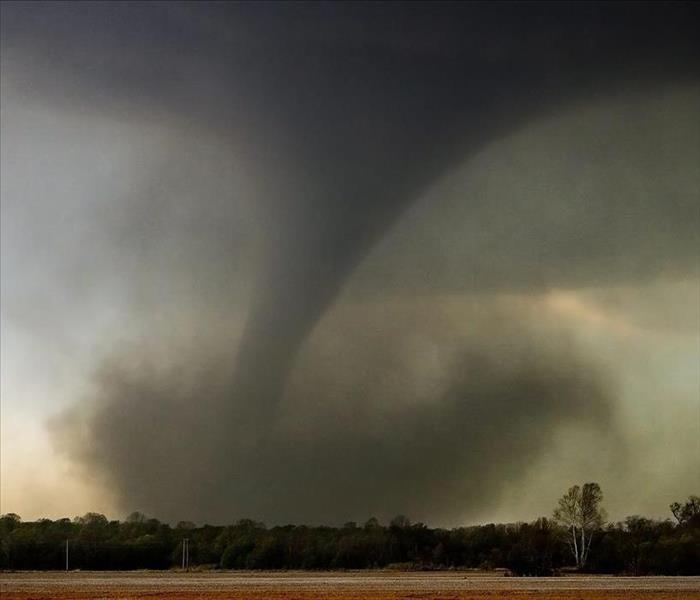 Have a plan!
Have a plan!
There has been ANOTHER tornado watch that has been issued for northern Illinois throughout the afternoon and evening. The watch has been issued until 10PM tonight for over 17 counties in Illinois. Severe storms are possible across northern Illinois and northwest Indiana. There is an area-wide threat for damaging winds, large hail and a couple tornadoes. There will also be heavy rainfall and flooding that can go into overnight. The weather service advises having multiple ways to receive weather warnings. They are also suggesting to have a plan set in place with your family and friends.
When it comes to making a plan for when disaster strikes, it is important to know which types of disasters could affect your area. Make sure to know how you will contact one another and reconnect if separated. Establish a family meeting place that's familiar and easy to find. Make sure to have the following..
1. A way to receive emergency alerts and warnings
2. Shelter plan
3. Evacuation route
4. Family/household communication plan
5. Update emergency preparedness kit
You will next want to consider specific needs in your household. Make sure to discuss your needs and responsibilities and how people in the network can assist each other with communication, care of children, business, pets or specific needs like operating medical equipment. Keep in mind some of these factors when developing your plan:
- different ages of members within your household
- responsibilities for assisting others
- locations frequented
- dietary needs
- medical needs including prescriptions and equipment
- disabilities or access and functional needs including devices and equipment
- languages spoken
- cultural and religious considerations
- pets or service animals
- households with school-aged children
You can never be to prepared when it comes to natural disasters, so please make sure you have a plan in place for when one strikes! Remember that SERVPRO is always here to help to make it look "Like it never even happened." Stay safe!
Flood Warning!
8/9/2021 (Permalink)
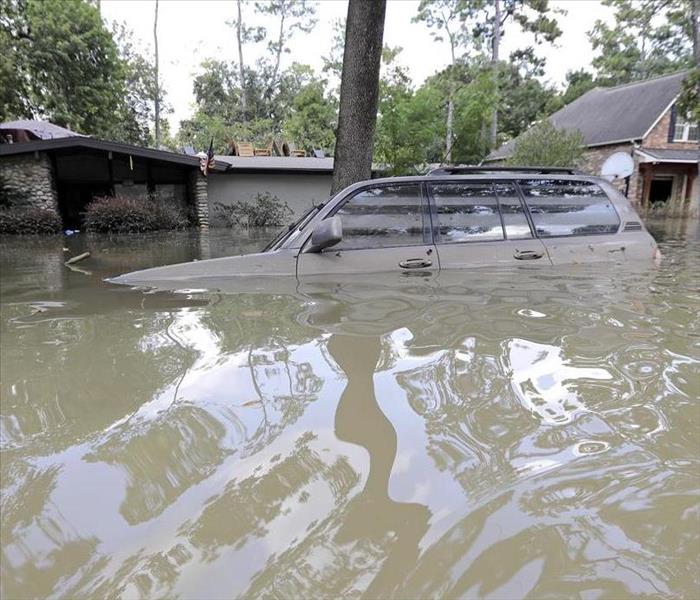 Be prepared!
Be prepared!
With the tornado watch in effective, we also see that there is a flood warning in effective as well. Here are some details on floods and how we can prepare for them, and what to do after they take place.
Flood can happen anywhere, and without much of a notice. According to ready.gov “Just 6 inches of moving water can knock you down, and 1 foot of water can sweep your vehicle away.” Flood Watches and Flood Warnings are available to let you know what the weather is doing in your area. On average, more deaths occur due to flooding each year than from any other severe weather related hazard.
First of all flood watches and flood warnings are two separate alerts to warn about the weather in your area. A flood watch is to make you aware that conditions are possible for flooding. A flood warning means you need to take action to keep yourself and your family safe.
Ready.gov has some safety tips in case you are in an area where there is a flood warning.
- Move immediately to higher ground or stay on high ground.
- Avoid walking or driving through flood waters. Turn Around, Don’t Drown! Just 6 inches of moving water can knock you down and 1 foot of water can sweep your vehicle away.
The water from a flood is only one of the risks. Water and electricity do not mix. In the event of a flood, downed power lines are also possible. Stay away from all power lines. Calling your local utility company is the only thing you should do in the event you see downed lines. Your appliances, if they get wet, should also not be used until they have been inspected by a licenses electrician. The fuse box in the house should be avoided as well as long as there is water in the home.
We may not be able to control weather conditions, but we can take all possible precautions to ensure our personal safety and protect our homes from severe damage. According to ready.gov the following tips can help prepare you for a flood:
- Find out how vulnerable your home is to flooding by determining the elevation of your property.
- Evaluate your insurance coverage once a year to make sure your home is fully covered. As new construction grows in certain areas, more flood-plains are sometimes created.
- If your home is in a flood-prone area, contact the National Flood Insurance program to learn what mitigation measures you can take in advance.
- Contact your local emergency management agency to learn how to construct proper protective measures around your home.
- If you live in a flood-prone area, keep these materials on hand: sandbags, plywood, lumber, plastic sheeting, trash bags, shovels, work boots and gloves.
- Purchase a weather radio. These special, battery-operated radios cost as little as $20 and are available at many hardware and appliance stores and other retail outlets.
- Put together a disaster survival kit. Keep the following supplies near at hand and put them in a water-tight container: flashlight with extra batteries, battery-powered radio and weather radio, first aid kit, medicines, eyeglasses, drinking water, non-perishable foods, change of clothes, cash and credit cards, and copies of all important papers.
- Plan two evacuation routes in advance. Don’t wait until threatening weather conditions occur before trying to determine your route to safety. Be aware of streams, drainage channels and low areas in your region that are prone to flooding, so that your evacuation routes are not cut off.
- Do not park your vehicle near streams or rivers, especially during threatening weather conditions.
SERVPRO of Arlington Heights/N. Prospect Heights wants you to stay safe first and foremost. However, flooding happens, and we are here to help. If you have flood damage in your home, call us at 847-637-3445 for all your water damage needs.
Fire Safety Tips for Your Pets
7/12/2021 (Permalink)
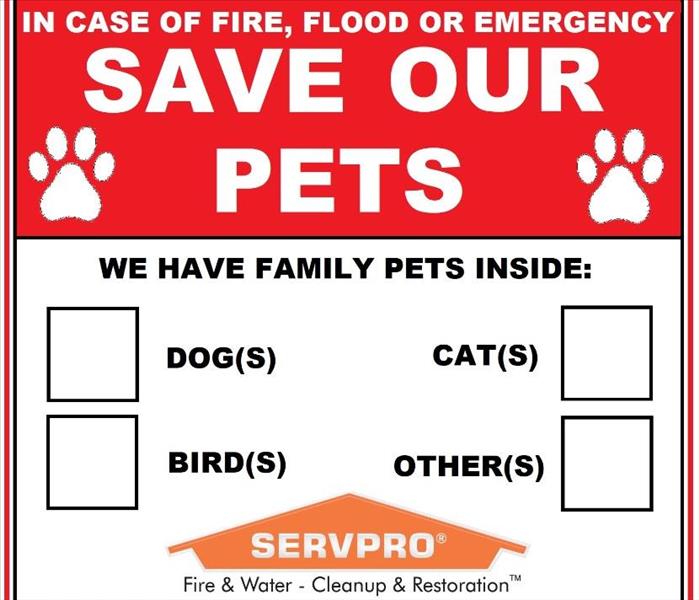 Take action before an emergency takes place!
Take action before an emergency takes place!
An emergency can happen at any moment, and you may never be able to fully prevent such events. However, you can prepare yourself and pets for when emergencies do take place. Here is a list of tips that will help your furry friends when a fire takes place.
- Consider installing monitored smoke detectors! If you live in a fire-prone area, monitored smoke detectors are always a smart choice. This will help the firefighters get a notification, and can respond as quickly as possible. Even if you are not home.
- Make sure to take note where your pets like to nap or hide. This is very important in event that needs evacuation in your home quickly. Remember that pets can be exponentially more difficult to round up if they sense stress. (Especially cats!) Practice crating your pets in advance to make it a positive experience. This will then help prevent them from running when you pull out their crate during any type of emergency.
- You need to have an emergency plan, and practice escape routes with your pet. Make sure to include all members of the family in this plan. Also make sure they know what to do and where to go.
- Have the phone number and address your local animal hospital handy. If your pet is injured, you will need to know where to take them for help ass quickly as possible.
- Make sure to pet-proof your home. Ensure there are no areas where pets can start fires accidentally. This includes stove knobs, loose wires, candles, fireplaces and other potential hazards in your home. Never leave a pet unattended with a lit candle or fireplace.
- If you have to evacuate, make sure to take your pets with you whenever possible. If you leave them behind, they may become trapped or escape and then be exposed to numerous life threatening hazards. In advance, make sure to contact your veterinarian for a list of preferred boarding kennels and facilities. Also, ask your local animal shelter if they provide emergency shelter or foster care for pets. Identify hotels and motels that accept pets, and also ask friends and relatives in your area if they would be willing to take your pet in case of an emergency.
- Get a rescue alert sticker! This easy to use sticker will let firefighters know that there are pets inside your home. Make sure it is visible, and we recommend placing it on or near your front door. This sign will include the types and number of pets in your home.
We here at SERVPRO have teamed up with local fire departments and animal hospitals to provide people with these stickers!
Disaster Plan for Your Business
7/8/2021 (Permalink)
 Have a plan!
Have a plan!
When it comes to owning a commercial business, you need to make sure you have a disaster plan in place. Natural disasters don't give you a warning to get out in time, and sometimes you only have minutes to act fast. One natural disaster that most people are not prepared for are earthquakes. Here are 6 steps to prepare you if an earthquake where to take place.
1. Assess the Earthquake Risk of Your Building
You need to get a clear picture about your business' earthquake risk factors. You need to know how ready or NOT ready your business is. It is recommended that all businesses perform risk assessments that find the strong and weak points of your plan. You should also schedule a consultation with an experienced firm to elevate the structural integrity of the building.
2. Create a Disaster Plan
These should be created and distributed to all of your employees beforehand. It is important to include ALL of you employees as you are developing a disaster plan. This way they if they notice any signs of an earthquake, they will know exactly what to do. Some of the things your disaster plan should include are:
- Contact information for all employees
- Communication plan
- Talk with employees with disabilities and make arrangements
- Hotline or text message system
- Schedule regular earthquake response drills to practice
- Emergency kit
- Safety checklist
3. Identify Your Building's Potential Structural Issues
Every business is different, and there is no one-size-fits-all approach. You will need to evaluate every aspect of your business and make preparations that are unique to your building's property. You need to understand the risks and take specific actions to help prevent earthquake disasters for your business, and to also protect your staff.
4. Bring in Expert Advisors
You can't afford to waste your time on hearsay or just anyone's word. Your business, life, and the lives of your employees and customers depends on doing things correctly and being truly prepared. Make sure you choose a reputable earthquake retrofitting contractor based on years of experience and high ranking results. This way it can translate to lives and business saved in those areas.
5. Develop a Comprehensive Emergency Communications Plan
Keeping your business in business after an earthquake often depends on effective communication. Be sure you have a plan in place that takes everyone into account. This includes your employees, your customers and your suppliers. Make sure you set up a backup communications plan that enables you to keep lines of communication open, even if you are unable to access your building. Make sure you employees know who to contact before hand so they aren't calling people they shouldn't have to call. Maintain an emergency contact list with police, fire, ambulance, hospital and other emergency services that employees know how to access quickly. Also, have your insurance company and attorney's numbers in a secure place.
6. After the Earthquake
Remember that it might not be readily apparent whether your building is safe after an earthquake takes place. There are usually aftershocks for hours and days afterward. Be sure to contact an experienced expert first for an earthquake damage safety assessment before you allow employees and customers back into the building.
Summer BBQ Grilling Safety Tips
7/8/2021 (Permalink)
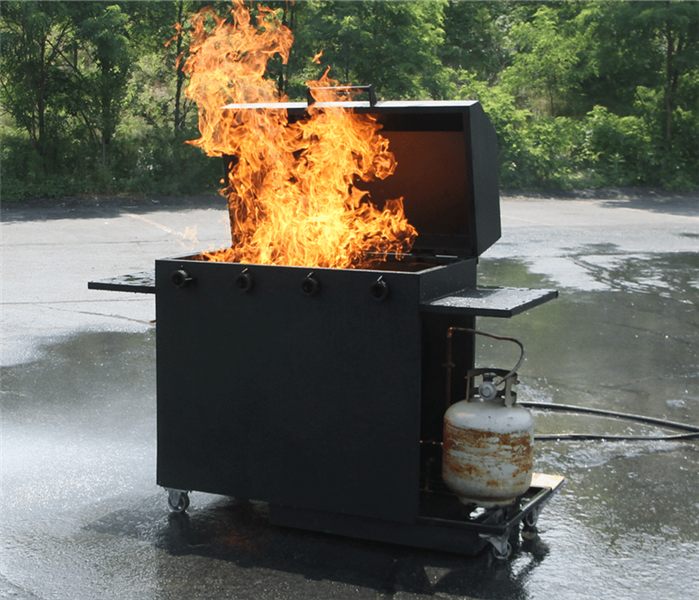 Fire safety for summer BBQ's!
Fire safety for summer BBQ's!
Grilling outside on a hot summer day is one of the most popular cooking methods in the summer. However, each year in the U.S. there are 10,200 home fires that are caused by outdoor grills. According to the National Fire Protection Association, July is the peak month for grill fires. Grill fires can start easily and spread quickly when the gas or charcoal is placed too close to any fire hazards. Here are 9 grilling safety tips for your summer BBQ's.
1. Only use grills outside
You might think it is okay to grill inside of your open garage or under a covered balcony, but propane and gas, charcoal grills are strictly designed for outdoor use where there is plenty of ventilation. If there is any combustible materials that surround or hang over the grill, it can catch fire easily and quickly. Make sure that the area over top and around the grill is clear.
2. Place your grill away from your home
BBQ grills are often placed just outside the back door or on the back deck. You should avoid placing your grill in these areas because it can pose a potential fire hazard. Grills that are placed too close to the house or wood structures can heat up adjacent materials and cause a fire to start. You want to make sure you keep at least 10 feet from your home or other structures.
3. Make sure your grill is located on a flat and level surface
If you place your grill on a slope or other uneven surfaces, it can tip over easily and cause a fire. Make sure that your grill is et up on a stable surface such as a concrete pad so it remains level while in use.
4. Check your grill for leaks
If you store your grill inside during the winter, make sure to check it over thoroughly when grilling season in the summer begins. A leak in the gas lines can cause propane or natural gas to build up inside when the lid is closed. Check the gas lines to make sure that they are free of leaks before using the grill. Make sure you also always open the lid of your grill before lighting.
5. Always clean your grill after use
When you BBQ regularly, it causes grease to build-up on the grill plates and collect inside the grease tray. If it is not cleaned, the build-up can then act as fuel and catch fire while the grill is in use. Clean your charcoal or gas grill after each use with a grill brush and empty the grease tray when it begins to fill up.
6. Never leave your brill unattended while in use
Never leave the grill unattended while you are cooking food. Grills use high heat and open flames to cook food, and when left unattended can become a safety and fire hazard. If you have to leave the grill, ask another adult to watch the grill for you.
7. Wear appropriate clothing
Clothing that has long sleeves or pieces that dangle can catch fire easily when too close to an open flame. When grilling food, wear clothing that won't interfere with the cooking process. Also, make sure that any apron strings are tied back away from the front. If a piece of clothing does catch fire, remember to stop, drop, and roll to extinguish the flames quickly.
8. Keep a spray bottle on hand
It is common for grills to flare up as fat drips from meat as it is cooking. This can cause a section of the grill to remain on fire as it burns away. If left alone, the flames will continue to burn and cause excess smoke to billow out from under the lid. Make sure you keep a spray bottle filled with water beside your grill so that you can quickly extinguish smaller flames before they begin to spread.
9. Always have a fire extinguisher close by
If a fire where to break out, follow these tips on how to put out a grill fire and ensure you have First Alert EZ Fire Spray within reach. It is simple to use, just point and spray to extinguish the fire. The spray is also quick and easy to clean up after use. It's small, compact size makes it the perfect addition to your grilling set to help keep your loved ones safe.
Following these safety tips and having the right protection will help you and your family enjoy a safe grilling season this summer!
Midwest Tornado & Flood
7/7/2021 (Permalink)
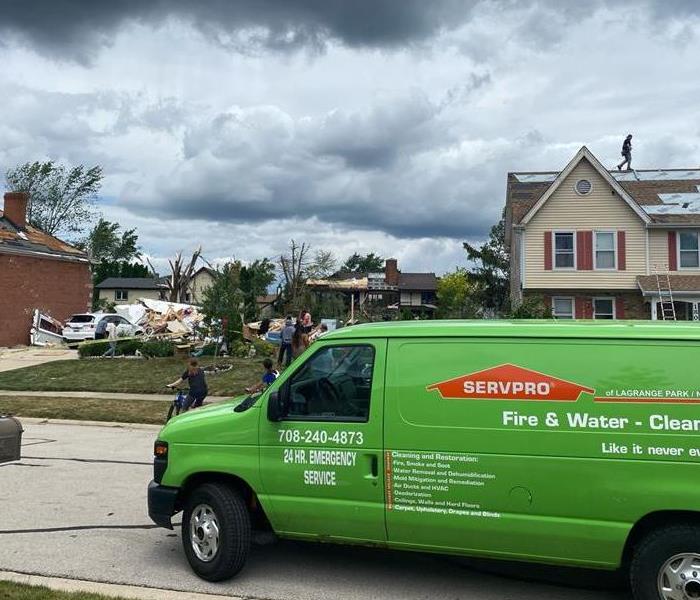 Serving the community!
Serving the community!
Living in the Midwest, you don't hear of many tornadoes coming through the area. If they do, they are mostly more south and don't cause much damage. However, disaster struck two of our suburbs in the middle of the night. The only time we usually hear the tornado sirens go off is when the first Tuesday of the month comes around. However, this was not the case this time. Once the morning hit, we where all able to see the disaster that the tornado has caused to residential homes. There where trees in homeowner's yards that where not there's, trampolines through the side of homes, cars completely smashed, and even an entire home was destroyed. We here at SERVPRO knew that the community needed our help. We immediately stationed our crew in two suburbs that where affected the most, and just handed out water and snacks to anyone that was in need of them. We could see the devastation on people's faces, and all we wanted to do was help as much as we could.
Following the tornado that hit, we then received major flood warnings for almost two weeks. On top of all the homes having property damage to them, they where now dealing with heavy rain fall coming into their homes. This is where our storm team kicked it into gear. Our crew is working around the clock to help restore people's homes, and to give them guidance on what the next step is to take because of these disasters. We can't be more proud to help support our communities during this time. This is why we stand by our saying of being "Faster to Any Size Disaster".
Lunch for the Fire Departments!
6/1/2021 (Permalink)
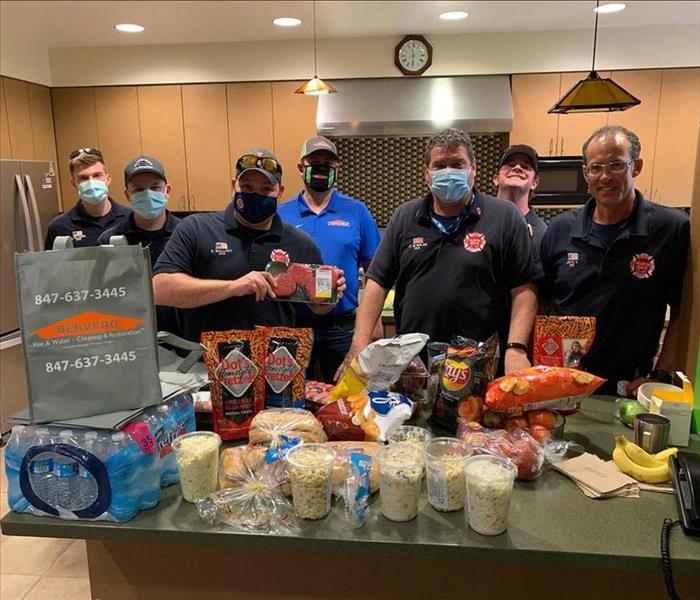 Thank you to our first responders!
Thank you to our first responders!
SERVPRO of Arlington Heights/N. Prospect Heights go above and beyond for the local first responders. We are so thankful for all that they do day in and day out, that we wanted to do something special to show our gratitude for them. Over the past four weeks, every Friday we go down to one of the stations and supply summer style food for the entire department. There are four different stations throughout the Arlington Heights area, so we had to plan on correctly so all the different crews were taken care of. Some of the food that was included were hotdogs, hamburgers, potato salad, chips, cookies, and SERVPRO water. After supplying them lunch, we were able to hangout with the crew to get to know them better and build a strong bond with them all. We even got to chat with Chief Larson! Our goal was to make sure that they all know how thankful we are for all their hard work, especially during the pandemic. Thank you again to all of our local first responders!
1 Year Anniversary!
5/3/2021 (Permalink)
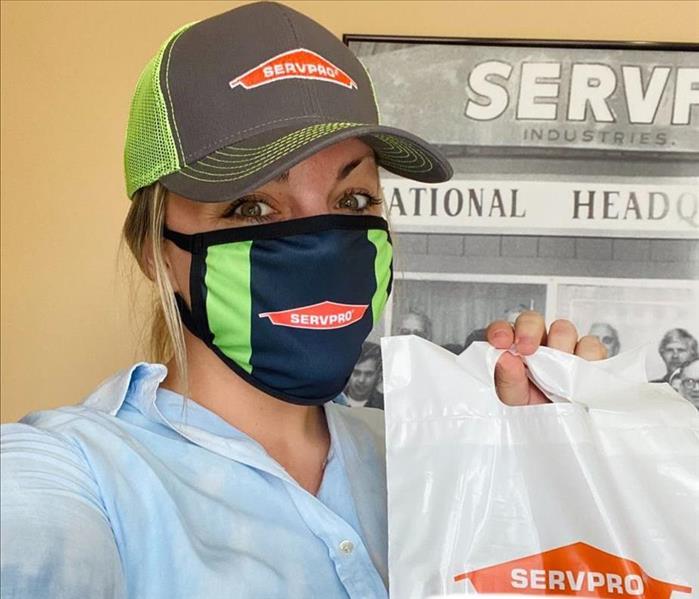 Thank you!
Thank you!
When thinking about what I wanted to do with my life as an undergraduate at DePaul University, I wasn't too sure. I had secured my Associate's Degree in Sociology and Psychology, and was entering my master's program at DePaul. This was when I decided to change my studies to marketing, and dive deeper into that field. After graduating with MS from DePaul, I was approached by a friend to look into working for the marketing team at SERVPRO. I had zero knowledge when it came to what SERVPRO did outside of the basic gist of the company. On top of that, I then was trying to work through a pandemic!! What a crazy time it was, but I recently hit my one year anniversary here at SERVPRO and I decided to reflect on the past year. During the pandemic, I was able to train more and get better knowledge of what SERVPRO does day in and day out. As things started to open back up, I was confident in my marketing and sales ability to tackle the daily routes. I now have a terrific relationship with all of our local first responders! We work alongside them when it comes to free COVID sanitations to their departments in order to keep them safe, and with community events by bringing fire safety tips and tricks. I have built so many wonderful and beautiful relationships during my one year anniversary, and some have even become friends that I hangout with on the weekends. I can't thank my marketing team and owner enough for giving me the opportunity to develop not only my work skills, but also as a person. THANK YOU SERVPRO!
Spring Cleaning!
4/2/2021 (Permalink)
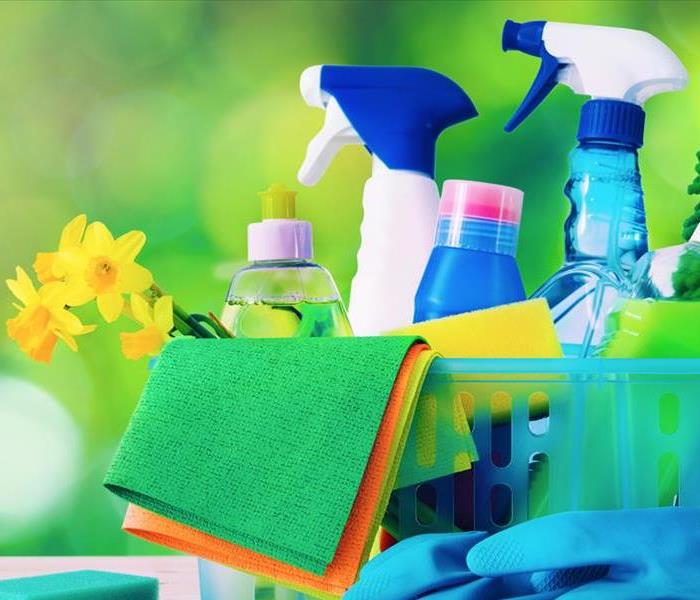 Call us today 847-637-3445
Call us today 847-637-3445
Spring cleaning time is here again, and a great opportunity to clean and organize your living spaces.
Here are some great tips to freshen up your home and make is sparkle:
Wipe off a dirty faucet.
To get rid of lime buildup, make a paste of 1 teaspoon vinegar and 2 tablespoons salt. Apply to sink fixtures and rub with a cloth.
Tidy up a toilet.
Pour a cup or more of diluted white distilled vinegar into the bowl. Let sit several hours or overnight. Scrub well with a toilet brush and flush.
Eliminate odors.
Swab plastic containers with a cloth dampened with vinegar.
Freshen up the fridge.
Clean the shelves and walls with a solution of half water and half vinegar.
Battle litter-box odor.
Cat litter can leave behind an unwelcome smell. Eliminate it by pouring a half-inch of white distilled vinegar into the empty litter box. Let stand for 20 minutes, then rinse with cold water.
Steam away a microwave mess.
Fill a small bowl with equal parts hot water and vinegar, and place it in the microwave on high for 5 minutes. As the steam fills the microwave, it loosens the mess, making clean up a breeze.
Remove wax.
If you get melted candle wax on your wood furniture or floors, gently wipe it away with a cloth soaked in a solution of equal parts white vinegar and water.
Erase crayon.
If your kids get crayon marks on the walls or floor, dip a toothbrush in white vinegar and gently scrub. The vinegar breaks down the wax, making for an inexpensive, nontoxic way to clean up after children.
Restore showerhead pressure.
If your shower-head gets clogged with mineral deposits, soak it for 15 minutes in a mixture of ½ cup vinegar and 1 quart water.
Another great do it at home cleaning solution is baking soda. Baking soda is great to freshen up stale and stinky smells in the home.
Here are some tips from Better Homes and Gardens for uses of baking soda around the house:
Stale-smelling sponges
Soak these kitchen staples in baking soda and water to freshen them up so you can use them a little longer.
Musty upholstery and carpets
Deodorize the soft, cushy places around your house by sprinkling surfaces with baking soda, letting it sit for 15 minutes, and then vacuuming it up.
Grimy toys
Naturally fight the effects of your little one's grubby hands by wiping them with a sponge dipped in a baking soda and water solution.
A mildew-y bathroom
Scrub your tub, tile, sink and shower curtain with a damp sponge and baking soda. Rinse to reveal gleaming surfaces.
A messy grill
Combat a summer's worth of cookout grime by sprinkling some baking soda on your grill-cleaning brush before you scrub away.
Finally, one of my favorite non chemical cleaning items is to use lemon. Lemons are a natural, mild disinfectant, and a quick trip to the store and you have a powerful cleaning weapon with no worries about chemicals.
According to thekitchn.com, lemons are "nature's little hand scrubbers". Here are some of their useful tips on how to use lemon in your spring cleaning:
Clean Wood Cutting Boards
Apply salt: Sprinkle the cutting board with coarse salt.
Scour the surface: Using a lemon half with the cut side down, scour the surface, squeezing slightly to release the lemon juice as you go.
Let sit, then scrape off: Let sit for 5 minutes, and then scrape the gray, dirty liquid into a small bowl using a bench scraper, and discard.
Rinse: Give the surface a final rinse with a clean wet sponge.
What to expect with the unexpected
4/2/2021 (Permalink)
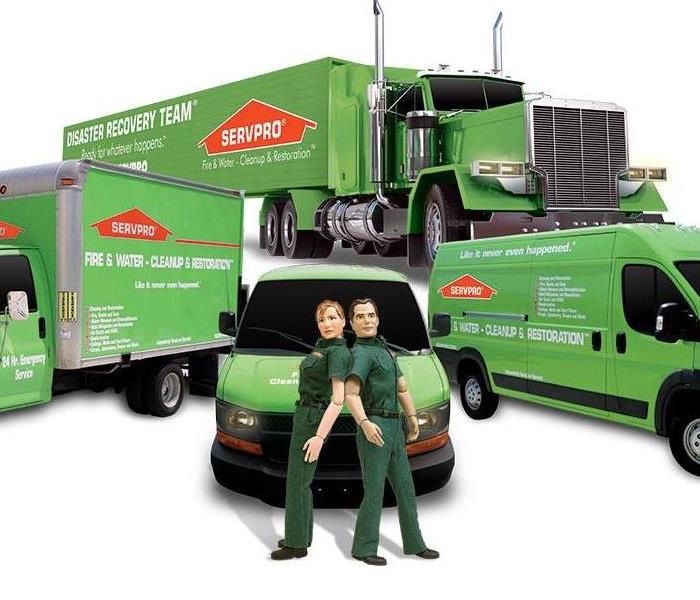 Call us today 847-637-3445
Call us today 847-637-3445
SERVPRO of LaGrange Park/North Riverside is available 24 hours a day for water emergencies, large or small. When you are dealing with water damage, immediate action is crucial. A delay of just a few hours can greatly increase the severity of the water damage.
We Answer the Phone Ready to Help
We understand that when you call us, you may be feeling confused, stressed, and vulnerable. You need an expert to guide you through this crisis. SERVPRO of LaGrange Park/North Riverside has the specific water damage training and experience to help you through this tough time. We specialize in water damage restoration—in fact, it's the cornerstone of our business.
What to Expect
When you call, we will ask several questions regarding your water damage emergency. These questions will help us determine what equipment and resources to bring, including how many trained SERVPRO Professionals may be needed.
Our SERVPRO Representative will ask several questions:
- Your name and contact information
- Your insurance information (if applicable)
- The street address of the water-damaged home or business
- When did the flooding or water damage occur?
- What caused the water damage (if known)?
- Is there electricity available (on-site)?
Smoking in the home
3/12/2021 (Permalink)
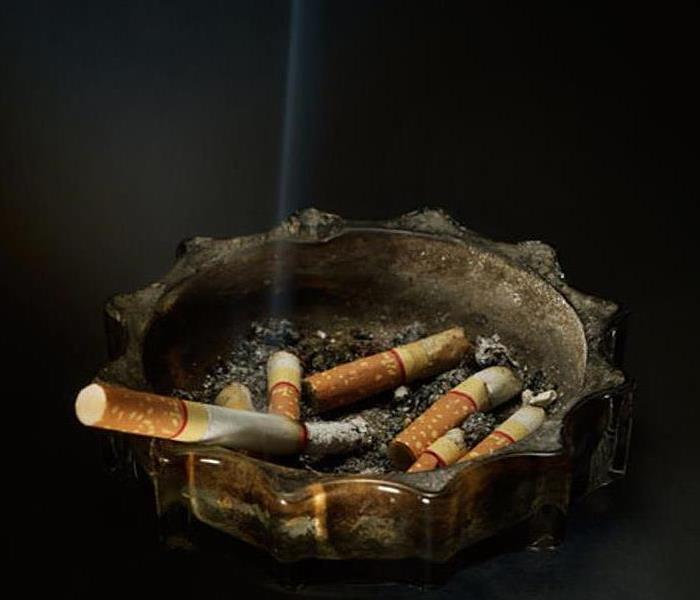 Emergency Response Service 24/7
Emergency Response Service 24/7
According to the National Fire Protection Association, smoking materials that include cigarettes, pipes, and cigars started an estimated 17,200 home structure fires. This was reported from U.S. fire departments. Amongst these 17,200 estimated fires, these fires cause 570 deaths, 1,140 injuries and $426 million in direct property damage. It was also reported that smoking materials caused 5% of reported home fires, 21% of home fire deaths, 10% of home fire injuries, and 6% of the direct property damage. According to the NFPA, most deaths in home smoking-material fires were caused by fires that started in bedrooms or in living rooms, family rooms or dens. It is also a face that the risk of dying in a home structure fire caused by smoking materials rises with age.
With that being said, it is encouraged to use smoking materials outside of the home. Designate a "smoking area" such as the garage or outside. This will help eliminate the risk of a fire starting in the actual home.
Spring Thaw
3/12/2021 (Permalink)
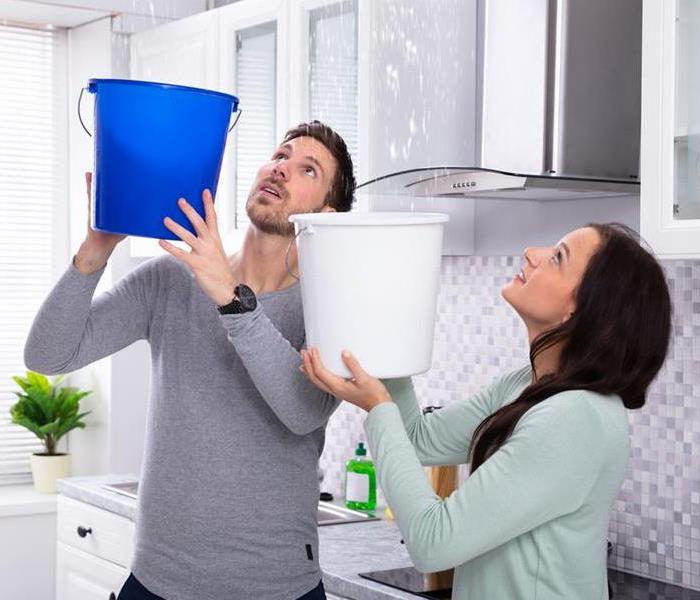 Here are some tips!
Here are some tips!
As we begin to enter Spring season, the process of snow melting can cause water damage to homes and businesses. This will then lead to flooding. It could be minor or major, but still cause water damage problems. Here are some ways to help prevent water damage as we enter this spring thaw out season. Now, you may not be able to prevent water damage under ever circumstance, but you can prepare your home ahead of spring-thaw months to prevent common causes of damage.
1. Basement pumps- install a sump pump or sewer backflow value and keep a battery-operated backup in case of power failure. Also, make sure to consider installing a water alarm that warns when water is accumulating in your basement.
2. Basement storage- Make sure to keep valuable items out of your basement. Removing any electronics or stored valuables from your basement prior to spring-thaw warnings could prove to be an important ounce of prevention.
3. Debris removal- Be sure to remove debris from window wells, gutters and downspouts.
4. Doors and windows- Check for any leaks around doors and windows.
5. Exterior walls- Keep all exterior walls of your home well painted and sealed.
6. Flood drains- If you have flood drains, make sure they work properly.
7. Foundation cracks- Make sure to inspect your foundation for cracks that will allow water seepage and initiate repairs.
8. Fuel tanks- Permanently anchor any fuel tanks.
9. Grading- inspect the grading around your home and make any changes. Design the grading to encourage the water to flow away from your home.
10. landscaping- Make sure to trim trees and bushes away from your home and do not store wood or compost piles nearby.
11. Roof- Keep your roof in good repair. Unless a tree falls on your roof during a storm, most insurers expect you to maintain your roof to prevent water leaks caused by snow melting or torrential downspouts.
Whether you are able to control the situation or not, we here at SERVPRO are always here to help you get your home or business back to like the disaster never even happen. That is way we are always here to help!
Frozen Pipes
1/28/2021 (Permalink)
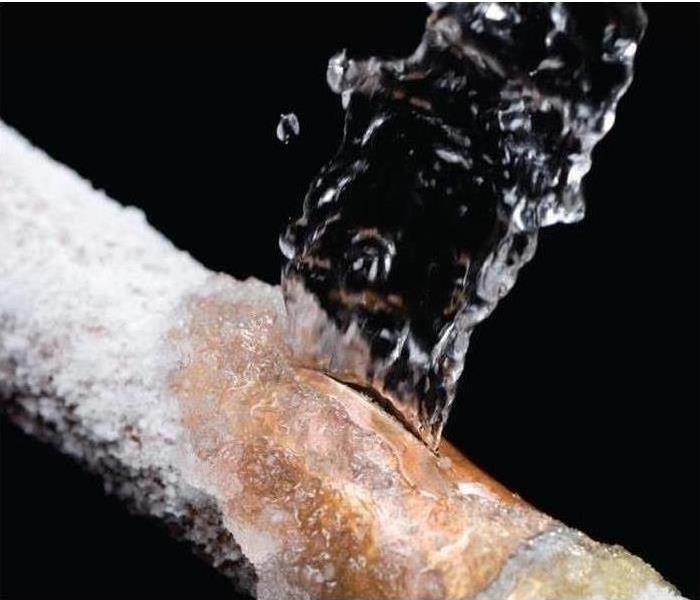 Frozen Pipe
Frozen Pipe
Thawing a frozen pipe the correct way is crucial to minimizing the damage. In order to thaw a frozen pipe, you need to first determine which pipe or pipes are frozen. You can do this by turning on the faucets, and if no water comes out or only a slight trickles out, then you have a frozen pipe. Before you begin attempting to thaw a frozen pipe, you need to open the faucet that the pipe feeds water into. You need to make sure to open both the hot and cold handles. This then will help relieve pressure in the system, and then will allow the water to escape once you begin to thaw the pipe. When beginning to thaw the pipe, you should always start near the faucet then work your way down to the blockage. This will help ensure that the melting ice and steam is able to escape through the open faucet. If you start the thawing process closer to the blockage, the melting ice could get stuck behind the blockage, creating more pressure in the pipe and increasing the chances the pipe will burst. When it comes to thawing the frozen pipe, you could use a hair dryer, heat lamp or portable space heater, hot towels, or electrical heating tape. If the frozen pipe is enclosed, you will need to either turn the heat up in the property, infrared lamp, or cut out a section of the wall to thaw out the frozen pipe/pipes. Remember NEVER attempt to thaw a pipe using an open flame. This can not only damage the pipe, but it can also start a fire in your property. If the frozen water pipe does burst, the first thing you should do is shut off the main water line into your property. This then will prevent additional water from flowing and damaging your property. Then you will need to call a professional, like SERVPRO, to help fix the problem. Therefore, in order to help prevent frozen pipes make sure to keep the heat on in the home, allow faucets to drip slightly, keep all interior doors open, seal up holes and cracks, add extra insulation, and remove exterior hoses and shut off interior valves feeding those hoses.
Continuing Education Classes
1/22/2021 (Permalink)
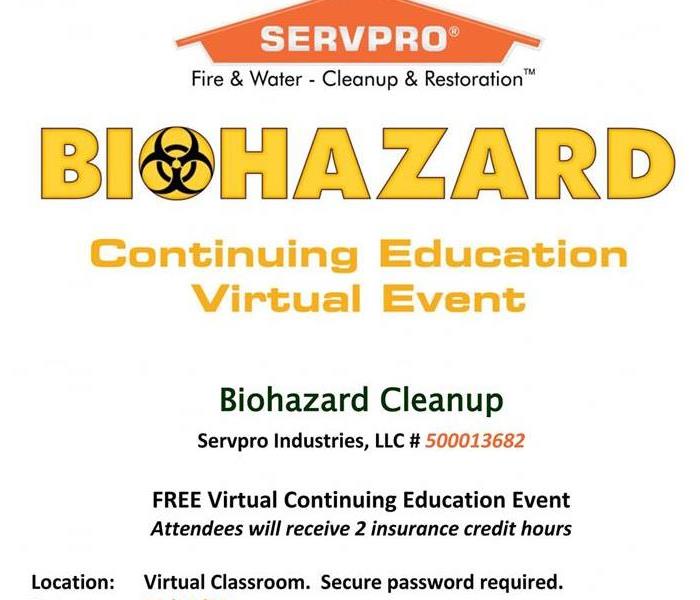 Upcoming Class!
Upcoming Class!
Every year, SERVPRO of Elmhurst provides continuing education in the areas of water, fire and mold mitigation. Education increases the opportunity for the community of professionals responsible for helping you when disaster strikes: The more you informed the community of first responders, the better able to help limit damage, save important personal belongings and control costs during a time of crisis.
At SERVPRO of Elmhurst, we work with adjusters, insurance agents, real estate agents, brokers, home inspectors, and office professionals by providing state-sanctioned Ethics Classes. Raising the bar when it comes to how people are treated especially in the time of need to protect their homes and personal belongings is essential to the insurance claim process.
Our goal is to make it like it never happened. As a recent client said, "the whole clean up and insurance process was as painless as it could have been."
Check in with us on our upcoming classes. We are now offering virtual CE classes!
Toys for Tots
1/14/2021 (Permalink)
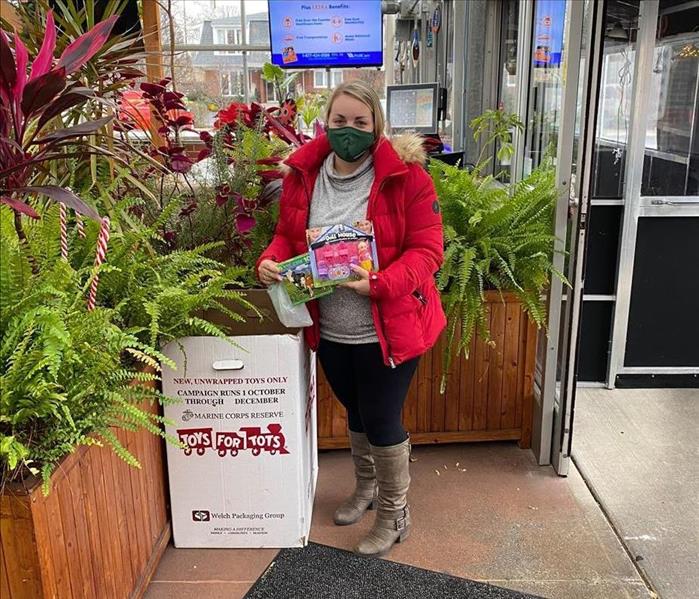 Worldwide Donation
Worldwide Donation
Toys for Tots is such a huge donation event that happens every year around Christmas time. The mission of the Marine Toys for Tots Program is to collect new unwrapped toys and distribute those toys to less fortunate children at Christmas. The primary goal is to help bring the joy of Christmas and send a message of hope to America's less fortunate children.
In order to better execute the program, in 1991 the Marine Toys for Tots Foundation was created at the behest of the Marine Corps. It is an IRS recognized 501(c)(3) not-for-profit public charity group. It is governed by a board of directors, all of whom are veteran Marines and successful business leaders from throughout the nation. The foundation's professional staff is headquartered in the Cooper Center, which is located just outside of the Main Gate of Marine Corps Bass about 35 miles south of Washington D.C..
The Marine Toys for Tots Program collected and distributed 19 million toys to 7.3 million less fortunate children in the past year allowing them to experience the joy of Christmas and receive a message of hope that otherwise would not have been there. This community action program took place in over 800 communities covering all 50 states, the District of Columbia, Puerto Rico, and the Virgin Islands.
We here at SERVPRO of Elmhurst, Arlington Heights/Prospect Heights, and Lagrange Park/N. Riverside, took part in helping donate over 30 toys to 15 different drop off locations this year. We want to help do our part in the community by giving children in need the feeling of joy on Christmas when it comes to unwrapping presents and seeing an awesome toy. This was such a humbling experience for our team, and cannot wait to take part again next year!
Lending a helping hand
1/5/2021 (Permalink)
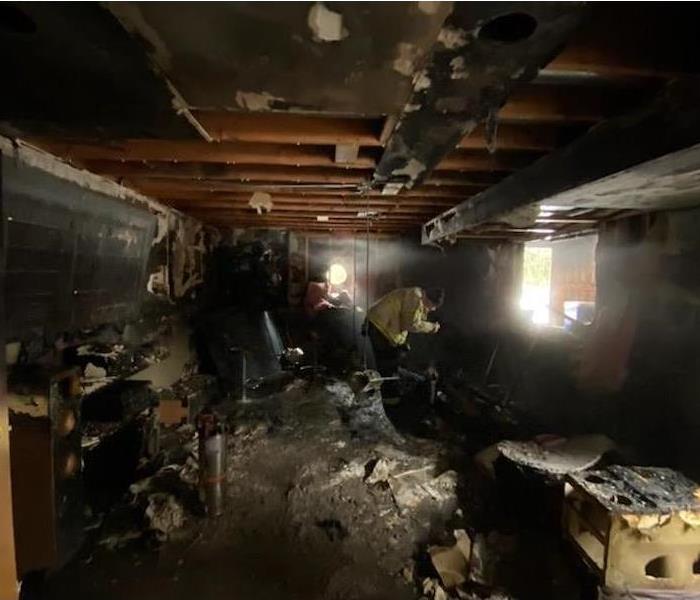 Residential Fire Damage
Residential Fire Damage
We have a really great relationship with our local fire departments, and follow their social media pages. After scrolling through our daily feed, we came across the Addison Fire Department's post about a local fire. What stood out about this post was that our local fire department and other FDs went to help with this major residential fire that took place. The AFPD responded to a house fire, and the smoke detectors did their job by alerting the family of the fire. They were all able to escape safely. They were very thankful for the help from the Wood Dale FPD, Elmhurst FD, and Itasca FPD for coming out to help. The family had told the firefighters that there were two guinea pigs in the home, and they were able to find and save them. The guinea pigs received O2 therapy and vigorous rubbing, and both were successfully resuscitated. The fire started in the basement, and the heat and smoke rose up throughout the house. They enforced to make sure your smoke detectors are working, and the batteries are changed! They also stated to make sure you keep your bedroom doors closed when sleeping, and try not to risk your life to save a pet. That is what the firefighters are for, and they will do their best to rescue them.
The main take away from this message was to always make sure to test your smoke detectors at least once a month, and the batteries should be replaced at least once or twice a year. Also, a huge shoutout to our local fire department for helping out a different fire department in order to get everyone out safely, along with the pets.
What can happen after an snow/ice storm
1/5/2021 (Permalink)
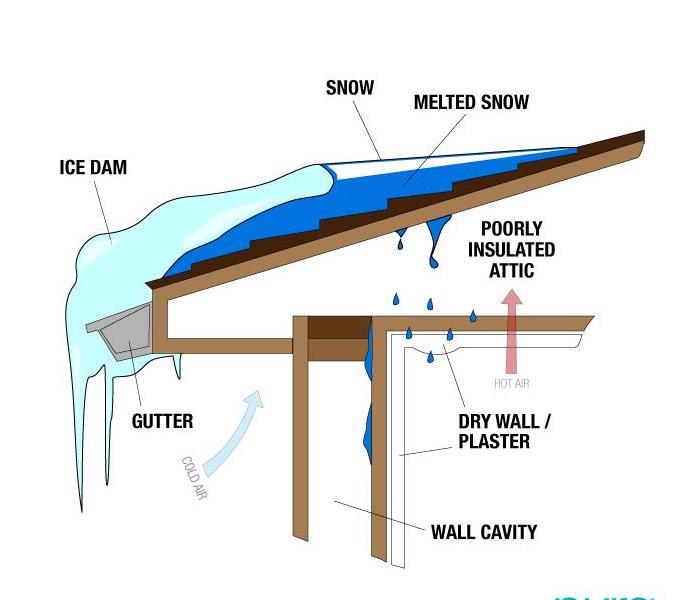 Be aware!
Be aware!
When looking at roofs this winter, icicles hanging along them may look beautiful but can be very dangerous. This is because the icicles forming and snow on the roof can lead to ice dams. This is thick ridges of solid ice that build up along the eaves. Dams can tear off gutters, loosen shingles, and cause water to back up and pour into the building or home. In result, this can lead to peeling paint, warped floors, stained and sagging ceilings. Also, soggy insulation in the attic, which loses R-value and becomes a magnet for mold and mildew.
Here are some ways in order to prevent ice dams. The first is to use heated cables. Attach these with clips along the roof's edge in a zigzag pattern, and the heated cables help prevent ice dams that lift shingles and cause leaks. This solution allows you to equalize your roof's temperature by heating it from the outside instead of blowing in cold air from the inside.
Next is to blow in cold air. Hacking away at ice dams with a hammer, chisel, or shovel is BAD for your roof. Also, throwing salt on them will do more harm to your plantings than the ice. Therefore, take a box fan into the attic and aim it at the underside of the roof where water is actively leaking in. This targeted dose of cold air will freeze the water in its tracks.
You can also rake it by pulling off snow with a long-handled aluminum roof rake while you stand safely on the ground. A rake with wheels will instantly change the exterior temperature of your roof without damaging shingles.
De-icing methods deal with diminishing the damage after the dam has formed. Fill the leg of a discarded pair of panty hose with a calcium chloride ice melter. Lay the hose onto the roof so it crosses the ice dam and overhangs the gutter. You can use a long-handled garden rake or hoe to push it into position. The calcium chloride will eventually melt through the snow and ice and create a channel for water to flow down into the gutters or off the roof.
Lastly is a permanent fix for ice dams. Getting ride of ice dams for good is simple. Just keep the entire roof the same temperature as the eaves. This is done by increasing the ventilation, adding insulation, and sealing off every possible air leak that might warm the underside of the roof.
1. Ventilate Eaves and Ridge
- A ridge vent paired with continuous soffit vents circulates cold air under the entire roof. Both ridge and soffit vents should have the same size openings and proved at least 1 square foot of opening for every 300 square feet of attic floor. Place baffles at the eaves to maintain a clear path for the airflow from the soffit vents.
2. Cap the Hatch
- An unsealed attic hatch or whole-house fan is a massive opening for heat to escape. Cover them with weather stripped caps made from foil-faced foam board held together aluminum tape.
3. Exhaust to the outside
- Make sure that the ducts connected to the kitchen, bathroom, and dryer vents all lead outdoors through either the roof or walls, but never the soffit.
4. Add insulation
- More insulation on the attic floor keeps the heat where it belongs. To find how much insulation your attic needs, check with your local building department.
5. Install sealed can lights
- Old-style recessed lights give off great plumes of heat and can't be insulated without creating a fire hazard. Replace them with sealed "IC" fixtures, which can be covered with insulation.
6. Flash around chimneys
- Bridge the gap between chimney and house framing with L-shaped steel flashing held in place with unbroken beads of a fire-stop sealant. Using canned spray foam or insulation isn't fire safe.
7. Seal and insulate ducts
- Spread fiber-reinforced mastic on the joints of HVAC ducts and exhaust ducts. Cover them entirely with R-5 and R-6 foil-faced fiberglass.
8. Caulk penetrations
- Seal around electrical cables and vent pipes with a fire-stop sealant. Also, look for any spots where light shines up from below or the insulation is stained black by the dirt from passing air.
Understanding the lifecycle of ice damming is key. It starts with the birth, and it is the breakdown of the conditions that lead to the formation of ice dams. First, heat collects in the attic and warms the roof, except at the eaves. Next you move into the growth, and snow begins to melt on the warm roof and then freezes on the cold eaves. Finally is maturity, and ice accumulates along the eaves, forming a dam. Meltwater from the warm roof backs up behind it, flows under the shingles, and into the house.
Commercial Property
12/1/2020 (Permalink)
You want your business to make as much profit as possible, but you may be losing money without even realizing it. Leaks from damaged pipes, as well as other areas, are a common source of trouble in many buildings. It is important to perform regular inspections to make sure everything is in top condition. Here are a few problems that might end up costing you money.
1. Damaged Roofing
Leaking pipes are not the only potential source of excess water. The roof is an important part of the structure of your business, as it protects you from severe weather and keeps the inside of the building dry. However, if you do not properly maintain your roof, you could end up with a lot of damage. In some cases, the structure of the building may weaken or a mold growth might develop. Make sure to regularly check the condition of your building and perform repairs as needed.
2. Broken Appliances
Another common source of water is from broken appliances. The damage here can range from a small leak to a lot of flooding. One way to prevent this is to test your equipment regularly to ensure it is in proper working condition. As items begin to age and break down, replace them to prevent any significant problems.
3. Pipes and Plumbing
Damaged pipes can sometimes be a hidden source of wasted water and money. If you are not performing regular maintenance, a persistent leak could end up costing hundreds or thousands of dollars in extra water bills. Leaks can also indicate aging pipes that could cause a lot of damage if not replaced.
Performing regular maintenance in your building is a great way to locate problems and prevent big issues from leaks or damaged pipes. If you do experience damage, however, a water restoration company can perform necessary repairs to your building and belongings.
Electrical issues are fire hazards
12/1/2020 (Permalink)
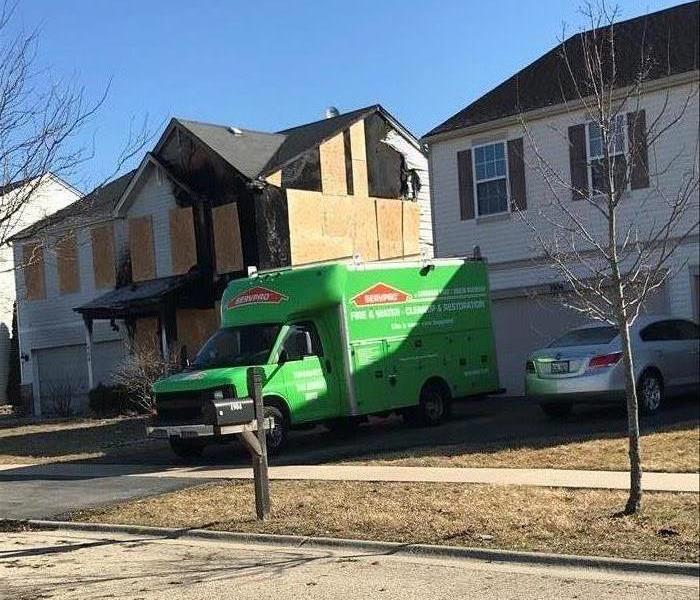 Boarded-up home after electrical fire.
Boarded-up home after electrical fire.
Approximately 2,400 children suffer severe shock and burns when they stick items into the slots of electrical receptacles each and every year - that is almost as many kids on a ball field to play a game (7), children a day. They estimate that 6 to 12 fatalities are recorded yearly due to this. Just by placing ordinary household objects, such as keys, pins, or paperclips into the outlets 1/3rd of the children parish. They are a real danger but we over look them each and every day. Even with new technologies a simple outlet cover can help if you don’t have the means for the TRR’s they produce today.
TRRs look just like ordinary outlets, but are designed with spring-loaded receptacle openings, or slots. When equal pressure is applied to both sides, the receptacle cover plates open to make contact with the receptacle contact points. Without this simultaneous pressure, the cover plates remain closed, preventing insertion of foreign objects and protecting your children from painful, traumatic electrical injuries. This runs about $2.00 more per outlet than a typical standard outlet. If it was new construction it would be a total of $50.00 added to the cost of the home.
STORMS IN THE AREA
12/1/2020 (Permalink)
 Get our APP!
Get our APP!
Prepare
Preparing now can minimize property damage and danger caused by flood. First, be sure you have an emergency plan in place that has been communicated to everyone on staff. Stock up on emergency supplies, like sandbags, shovels, sump pumps, and more. Have easy access to a water pump, emergency apparel, such as rain suits, and dehumidifiers.
Have an evacuation plan
Have an emergency kit with battery-operated radio, flashlight, food, and water
Raise up electrical components
Clear debris from gutters and downspouts
Check valves in sewer traps to prevent backup
Seal walls with waterproofing compounds
Respond - 847-637-3445
Recover
Once floodwaters have cleared, it's time to recover and rebuild. We Have the Resources to Handle Storms and Disasters.
In addition to our own resources, we can access equipment and personnel from over 1,700 Franchises across the state and country. We can even call upon strategically located Disaster Recovery Teams for catastrophic storms and major events
What WATER can Do – Time to get on it.
12/1/2020 (Permalink)
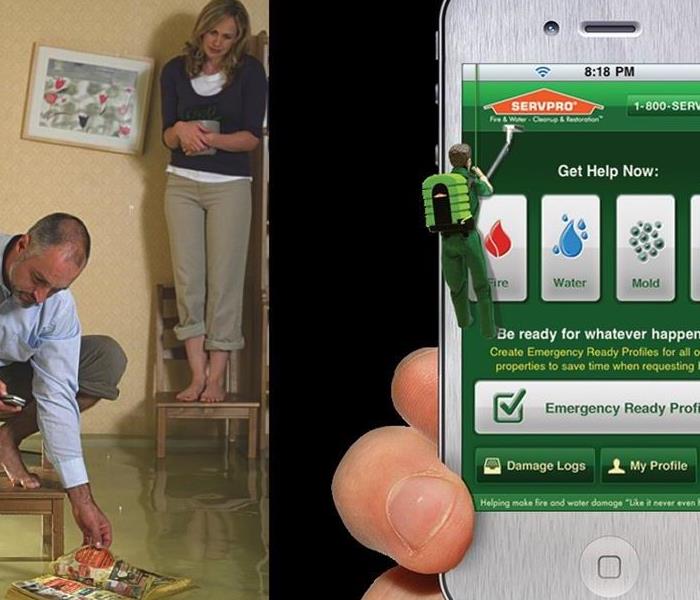 YOU know you want the APP!
YOU know you want the APP!
What WATER can Do – Time to get on it.
Within Minutes
- Water quickly spreads throughout your property, saturating everything in its path.
- Water is absorbed into walls, floors, upholstery, and belongings.
- Furniture finishes may bleed, causing permanent staining on carpets.
- Photographs, books, and other paper goods start to swell and warp.
Hours 1 - 24:
- Drywall begins to swell and break down.
- Metal surfaces begin to tarnish.
- Furniture begins to swell and crack.
- Dyes and inks from cloth and paper goods spread and stain.
- A musty odor appears.
48 Hours to 1 Week:
- Mold and mildew may grow and spread.
- Doors, windows, and studs swell and warp.
- Metal begins to rust and corrode.
- Furniture warps and shows signs of mold.
- Paint begins to blister.
- Wood flooring swells and warps.
- Serious biohazard contamination is possible.
More Than 1 Week:
- Restoration time and cost increase dramatically; replacing contaminated materials and structural rebuilding may be extensive.
Structural safety, mold growth, and biohazard contaminants pose serious risks to occupants.
What you did and didn't know about tornadoes
11/3/2020 (Permalink)
The Websters Dictionary defines a tornado : "A tornado is as a rotating, funnel-shaped cloud that extends from a thunderstorm to the ground with whirling winds that can reach 300 mph. Damage paths of tornadoes can be in excess of one mile wide and 50 miles long."
According to the study done by The Weather Channel. Each year in the U.S., 1,200 tornadoes on average kill 60 people, injure 1,500, and cause roughly $400 million in damages, putting long-term average tornado losses on par with hurricanes.
There are many misconceptions in regards to tornadoes. Here are some facts from tornadofacts.net
Tornado Safety Related Myths
- Southwest corner of your home/building/shelter is the safest location - In 1887 John P. Finley wrote a book on his observations of his tornado research. While he published some ground breaking information on tornadoes he also helped created this tornadoes myth. John believed that tornadoes only traveled in a northeast direction and that derby they created would be carried in the direction of its propagation. The 1997 F5 Jarrell tornado is a prime example of his misconceptions since that tornado moved in a south-southwesterly direction. It's recommended that you always seek shelter in the lowest floor of a building, preferably under an I-beam or staircase, regardless of the type of building you're in.
- Open all the windows in your home when a tornado warning is issued - This is an extremely dangerous myth because it takes away critical minutes that could be used to reach shelter. It used to be widely believed that you needed to open your windows during a tornado to equalize pressure and prevent your house from exploding. A violent tornado will only have a 10% drop in pressure which isn't anywhere near enough to cause your home to explode. Ignore your windows and seek shelter immediately when a tornado warning is issued.
- A highway overpass is an excellent tornado shelter - This myth gained huge traction in 1991 when a TV crew survived a tornado unharmed by sheltering under a overpass in El Dorado, KS. This event had nationwide coverage with video of the event and that helped perpetuate this myth to a dangerously high status. The conclusion for scientific evidence from the Oklahoma outbreak in 1999 actual proved that overpasses are actually one of the worst places to seek shelter during a violent tornado; mostly due to the wind tunnel effect that can accelerate flying derby speed even during weak tornadoes.
- You can outrun a tornado via a vehicle - The theory behind this myth is a vehicle can travel faster than the average tornado, but the key phrase is average. There is no way for someone to know the travel and wind speed of a tornado just by looking at it. Plus the flooding, hail, and flying derby from a tornado can put someone in a vehicle in danger. The official directive from the National Weather Service is if you spot a tornado nearby to abandon your vehicle and seek shelter in a nearby building, culvert or ditch.
- A brick or stone building can protect me from a tornado - While a brick or stone building can provide better protection during tornado a violent only can easily turn a brick or stone building into a pile of rubble. It's recommended that you always seek shelter in the lowest floor of a building, preferably under an I-beam or staircase, regardless of the type of building you're in.
- If a tornado isn't coming directly towards me I'm safe - In the past it was common belief that a tornado would only travel in a northeasterly direction. While it's true that most tornadoes will move northeast this is most due to the direction the storm is traveling. Tornadoes are erratic, unpredictable, and can come from any direction. A prime example is the 1997 F5 tornadoes that struck Jarrell, TX which traveled southwest.
When a major storm hits, it may overwhelm local restoration companies. SERVPRO of La Grange Park / North Riverside can scale our resources by accessing the equipment and personnel of 1,700 Franchises. We can also access Disaster Recovery Teams that specialize in major storms and catastrophic events.
Safety tips for the upcoming holidays
11/3/2020 (Permalink)
Per the National Fire Protection Association, nearly 47,000 fires occur during the winter holidays claiming more than 500 lives, causing more than 2,200 injuries, and costing $554 million in property damage. The National Fire Protection Association also states that on average, one of every 22 home fires started by Christmas trees result in death.
www.redcross.org/homefires, has several good home safety tips for the holidays to keep your home safe. We at SERVPRO LaGrange Park/North Riverside wanted to share some of those tips with you to ensure a safe holiday season.
- Place Christmas trees, candles, and other holiday decorations at least three feet away from heat sources like fireplaces, portable heaters, radiators, heat vents and candles.
- Purchase flame retardant metallic or artificial trees. If you purchase a real tree, make sure that it has fresh, green needles that aren’t easily broken. Keep live trees as moist as possible by giving them plenty of water.
- Make sure that light strings and other holiday decorations are in good condition. Do not use anything with frayed electrical cords and always follow the manufacturer’s instructions.
- Always unplug tree and holiday lights before leaving home or going to bed.
- Never use lit candles to decorate a tree. Always extinguish candles before leaving the room orgoing to bed.
- Use only sturdy tree stands designed not to tip over. Keep curious pets and children away from Christmas trees.
- Keep anything that can catch on fire—pot holders, oven mitts, wooden utensils, paper or plastic bags, food packaging, and towels or curtains—away from your stove top.
- Designate one person to walk around your home to make sure that all candles and smoking materials are properly extinguished after guests leave.
The following video also shares other great ideas to keep in mind this holiday season.
Holiday Fire Safety
Have a safe and wonderful holiday season from your friends at SERVPRO of Arlington Heights/N. Prospect
Thermal Imaging
11/2/2020 (Permalink)
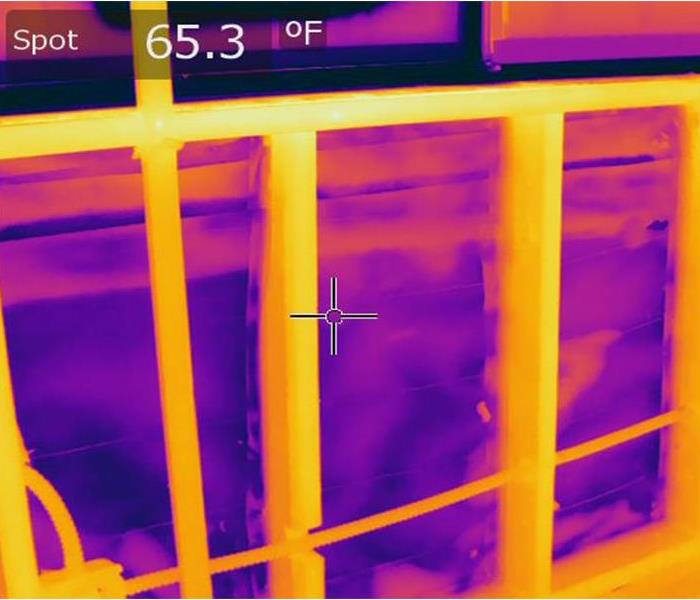 Finding the invisible
Finding the invisible
SERVPRO has many tools they offer for their customers. I recently came across a new tool that was used to detect water, and it was our thermal imaging camera our crew has. The thermal temperature screening provides a range of solutions.
Thermal cameras are important because they identify elevated body temperatures. In our case, it can show to us the level and amount of water that is in floors or walls that may not be noticeable because it is underneath. They are designed to detect and measure the invisible infrared radiation emanating from objects, frequently referred to as a "heat signature". The hotter an object is, the more radiation it releases. The thermal camera sensor array will detect infrared frequencies, converting the data to electronic signals, which can then be viewed as colored images that vary with the level of heat being emitted.
Unknown water in a home can cause major damage that can cost you a lot down the road. With that being said, having our team come in with our thermal imaging will allow our team to get to the problem faster because we are able to see something that you may not. This is why here at SERVPRO, we always go by our saying of being "faster to any size disaster" .
After fire cleanup
11/2/2020 (Permalink)
Smoke and soot is very invasive and can penetrate various cavities within your home, causing hidden damage and odor. Our smoke damage expertise and experience allows us to inspect and accurately assess the extent of the damage to develop a comprehensive plan of action.
Smoke and soot facts:
- Hot smoke migrates to cooler areas and upper levels of a structure.
- Smoke flows around plumbing systems, seeping through the holes used by pipes to go from floor to floor.
- The type of smoke may greatly affect the restoration process.
Different Types of Smoke
There are two different types of smoke–wet and dry. As a result, there are different types of soot residue after a fire. Before restoration begins, SERVPRO of LaGrange Park/North Riverside will test the soot to determine which type of smoke damage occurred. The cleaning procedures will then be based on the information identified during pretesting. Here is some additional information:
Wet Smoke – Plastic and Rubber
- Low heat, smoldering, pungent odor, sticky, smeary. Smoke webs are more difficult to clean.
Dry Smoke – Paper and Wood
- Fast burning, high temperatures, heat rises therefore smoke rises.
Protein Fire Residue – Produced by evaporation of material rather than from a fire
- Virtually invisible, discolors paints and varnishes, extreme pungent odor.
Our Fire Damage Restoration Services
Since each smoke and fire damage situation is a little different, each one requires a unique solution tailored for the specific conditions. We have the equipment, expertise, and experience to restore your fire and smoke damage. We will also treat your family with empathy and respect and your property with care.
Have Questions about Fire, Smoke, or Soot Damage?
Call Us Today – 847-637-3445
Commercial Cleanup!
9/29/2020 (Permalink)
If you can’t summon help quickly, a fire can quickly sweep through your Elmhurst, IL, office and leave a trail of devastation in its wake. Fire damage can be severe and make it impossible for you to resume work duties in your building. Ironically, the very water firefighters use to eliminate the fire can also cause major problems. Trained professionals have the equipment and skill to clean up both types of damage.
Thorough Inspection
When you call a professional disaster cleanup crew to your office, the team won’t jump right in and start working without a plan. The company will evaluate the effects of the fire damage in order to come up with an effective strategy. The technicians will do the following:
• Make note of which areas of your building were affected.
• Determine the extent of the damage.
• Decide what areas and items you can salvage and which ones you must replace.
• Establish a plan of attack that will yield the most complete, time-effective results.
Remove Standing Water
A fire hose can pump out hundreds of gallons of water while a firefighter is battling a blaze. It’s no wonder water can wreak havoc in your office after a fire. A technician will use wet vacuums and other specialized water removal equipment to make sure there is no leftover water on your floor or on furniture or other objects. Next, the team will dry the areas with dehumidifiers and high-powered blowers.
Clean and Sanitize
Sucking up water and drying the area isn’t enough to mitigate water damage. The professionals will also use chemicals to thoroughly sanitize any areas where there had been water. This will minimize the chances of mold growth.
Fire damage and water issues go hand in hand after a fire. By understanding the process the pros use, you can have peace of mind and confidence that your office will be in good hands.
FEMA!!
9/29/2020 (Permalink)
Some buildings are more at risk of flooding than others in Elmhurst, IL. The Federal Emergency Management Agency, or FEMA, aims to prepare every individual to handle any natural disaster that might affect him or her, and floods are no exception. There is a wealth of flood preparation knowledge you can find from this agency, including a flood risk map that shows you exactly how likely your home is to be affected by a flood. You should take the time to learn:
1. Which flood zone your home is located in
2. What flood insurance options you have
3. Where you fall on the flood insurance rate map or FIRM
4. The elevation of your property
5.What the evacuation plan is for your area
Flood Insurance
It is a good idea to have water damage covered by your insurance policy, but you may not realize that water damage and flooding damage is not the same thing. Water damage is caused by things like burst pipes or leaky roofs, but the damage caused by external factors like tidal waves or mudslides fall into a different category. Most people do not need flooding insurance, but if you are in a high-risk area, it might be beneficial. The National Flood Insurance Program, or FEMA NFIP, is a special program FEMA offers that provides affordable flooding damage insurance.
What To Do
FEMA also has recommendations for what to do during a flood. You should be intimately familiar with the evacuation plan in your area and have all the supplies you need before a flood happens. You should have plenty of canned food, bottled water, a first aid kit, and general tools. It might be good to have a flooding damage restoration company in Elmhurst, IL already in mind so you can start the process of repairing as soon as possible. Flood water contains contamination, so it is not safe to return to your home no matter how minor the damage is.
Storm Team- Iowa
9/1/2020 (Permalink)
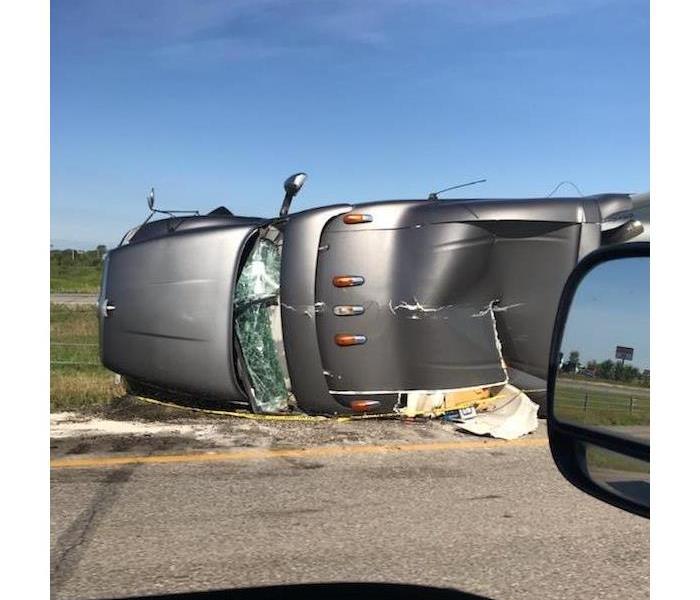 Our team out helping the damages in Iowa!
Our team out helping the damages in Iowa!
Over the past couple weeks, our storm team here at LaGrange Park/N. Riverside has been out assisting those who were hit with damage from the bad storm that went through Iowa. Our team has been working on a major project at one of the local hotels nearby. Our commercial large loss division is composed of the best of the best in restoration. Our commercial operations manager has been supervising the job every since we started down in Iowa. Our team was about to dispatch trained production professionals, and cut costs through the strategic placement and oversight of temporary labor. Once our team got word there was going to be a major storming rolling through there, we had a team ready to go the day before. After the storm hit, out team drove over 3 hours to get out to the location where the commercial property was. On the way, our team was able to see all the damage first hand driving through Iowa. Our team described it almost as a "scary scene in a movie". There was semi-trucks turned over on the highway, full grown trees pulled out of the ground, entire roofs taken off of homes, broken homes, and many more disasters that put tears to their eyes. Our team knew that they needed to help fix Iowa, and be able to make it strong again. To this very day, our team is still out in Iowa assisting the major commercial loss that has taken place, and they will continue to work in order to get the operation up and going again. We here at SERVPRO are always faster to any size disasters!
Costs from water damage
9/1/2020 (Permalink)
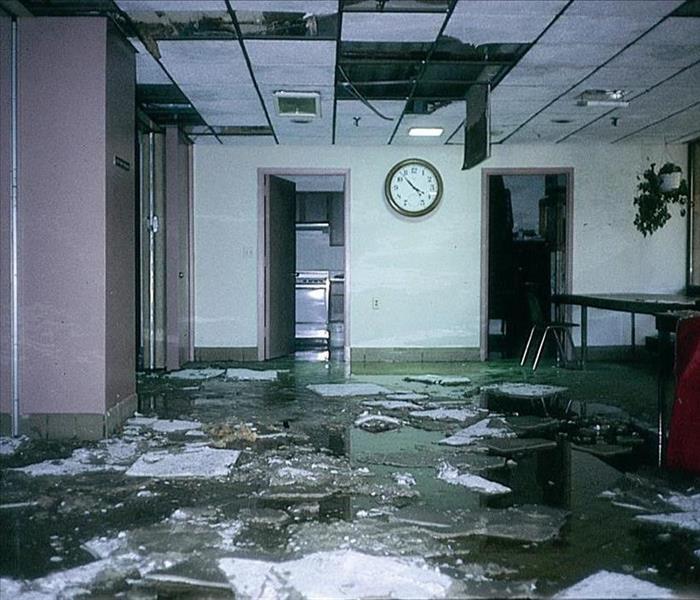 Our SERVPRO team is here to help!
Our SERVPRO team is here to help!
When it comes to owning a business or a home, water damage can be one of the most costly things there is. You can not only lose out on days or weeks of productivity, but you could also find yourself repairing or replacing valuable equipment like electronics, tools and inventory. This is where the costs come into play.
- On average, water damage from a sink will run $7,000.00 for each instance
- For toilets, that number ranges between $2,000.00 and $10,000.00
As we can see, this can add up very fast! Here are some causes of water damages, and what you can do to help prevent them.
1. Appliances and Equipment
- Air conditioners, water heaters or anything that uses tubes, pipes, gaskets or filters to operate has the potential to leak. The best thing to do is to regularly look over and maintain your equipment. If you notice anything that concerns you, such as rust, cracks, bulges or signs of moisture, call SERVPRO.
2. Roofing
- Make sure you're checking your roof regularly. If you've got a pond up there, your drainage isn't working effectively. Keep in mind that every inch of water weighs in at around 5 lbs. Be sure to look for any damage to your perimeter flashing, roof membrane or roof penetrations like drains, pipes and gas lines.
3. Pipes and Drains
- Your plumbing system is susceptible to stoppages, clogs and dmage. If a crack develops, it could dumb 250 gallons of water per day on your facility. Look for outward signs of moisture, blue stains, rusting, and cracking and bulging. If you're having plumbing work done or you have a cut pipe for any reason, check for scale buildup. You can also try a pipe camera to get a good look at what's going on inside your system.
4. Sprinkler Systems
- Many commercial buildings are outfitted with sprinkler systems, which are great for minimizing fire damage, but not so great for water damage when they malfunction. Always check your sprinkler system for signs of damage or rust, and replace them regularly to make sure they are functioning properly.
5. Mother Nature
- Natural disasters like hurricanes, severe thunderstorms ad flash flooding can do untold damage to your business. You can control how ready you are for it though. Keeping your gutters clear, installing barriers and storing sensitive files and electronics at a higher level are all things you can do to keep the damage minimal. Consult with a SERVPRO professional to get your ERP set up and ready in case something like this were to happen.
Common Causes of Commercial Building Fires
9/1/2020 (Permalink)
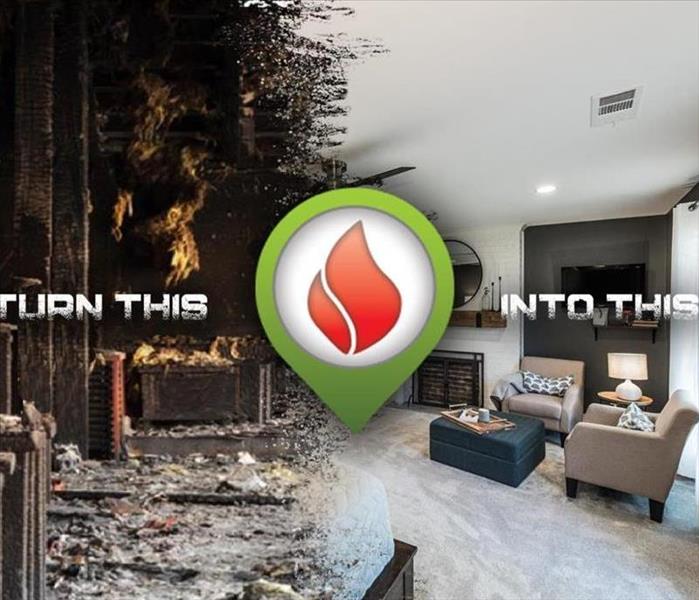 Make sure to check all heating sources!
Make sure to check all heating sources!
We usually don't think of a fire destroying our business or office building. We are more worried about less concrete threats. This includes a downward trending economy, high customer churn rate, the struggle to retain talented employees, legal issues, etc. However, nonresidential building fires killed 65 people, injured 1,425 and created $2,461,400,00 in damage between 2004 and 2013.
In order to prevent a dangerous and costly fire, the time of day fires are most likely to occur in your building depends on what type of business you're in. An office building is a bit different from a manufacturing plant. Ex: In an office building, fires are most common during regular work hours. Incidence of fires peaks in the early evening hours between 3-6pm.
Therefore, the most common causes of commercial building fires are as follows.
1. Cooking Fires
- 29.3% of nonresidential fires from 2013 were cooking related. In fact, 1 in 4 office building fires were related to cooking equipment. These types of fires do tend to account for less damage, but they are easily preventable with fire protection systems such as alarms and fire extinguishers.
2. Intentional
- This accounts for almost 10% of fires, and tends to cause the most damage. Intentional fires also result in more civilian injuries and deaths. Unlike cooking and heating fire, it's most common for intentional fires to be started between 3pm and midnight. A few common locations to be aware of in the building are bathrooms, trash bins, garages, and open areas like a lawn or field.
3. Careless Acts and Human Error
- 9.2% of commercial fires were unintentional results of careless acts. This is somewhat of an 'other' category. Some examples include accidentally leaving space heaters or other heat producing equipment on, carelessly discarded cigarette butts igniting fires, and plugging too many things into the same extension cord.
4. Heating Fires
- Heating fires account for 9% of all nonresidential building fires. Central heating units, fireplaces, water heaters, and other heating appliances and systems should be regularly inspected to prevent fires. It is important to move any flammable materials and furniture away from heat sources.
Hurricane Hazards
8/4/2020 (Permalink)
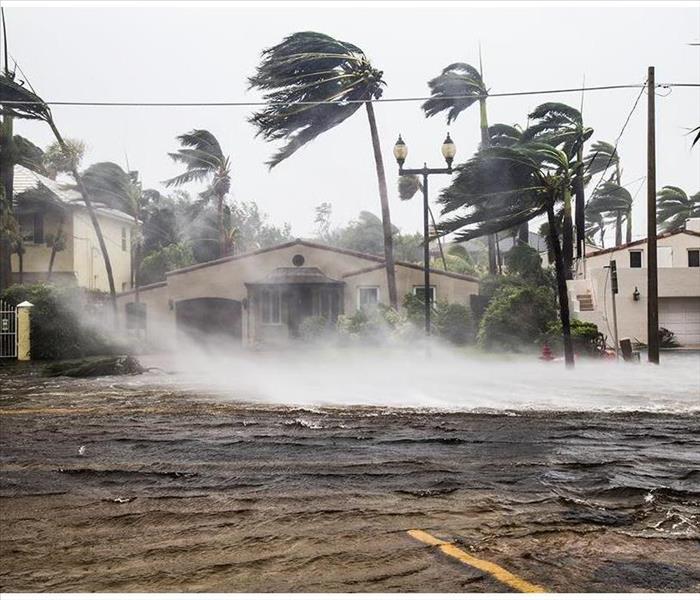 Make sure you are prepared.
Make sure you are prepared.
Hurricane season is upon us, and there are several named storms that have developed in the Atlantic, Caribbean and Gulf of Mexico. On average, there are about 12 tropical storms that will develop between June 1st and November 30th. Of those 12 storms, 6 of them will become hurricanes according to the National Weather Service. We know that hurricanes can be life-threatening, and they can cause a serious amount of property damage. The National Weather Service lists the following as potential "hurricane hazards".
Storm surge: is the abnormal rise of water generated by a storm's winds. This hazard is historically the leading cause of hurricane related deaths in the United States. Storm surge and large battering waves can result in large loss of life and cause massive destruction along the coast. It can also travel several miles inland, especially along bays, rivers and estuaries.
Flooding: from heavy rains is the second leading cause of fatalities from landfalling tropical cyclones. Widespread torrential rains associated with these storms often cause flooding hundreds of miles inland. This flooding can persist for several days after a storm has dissipated.
Winds: from a hurricane can destroy buildings and manufactured homes. We also see that signs, roofing material and other items left outside can become flying missiles during a hurricane.
Tornadoes: can accompany landfalling tropical cyclones. They typically occur in rain bands well away from the center of the storm.
Dangerous waves: produced by a tropical cyclone's strong winds can pose a significant hazard to coastal residents and mariners. These waves can cause deadly rip currents, significant beach erosion and damage to structures along the coastline. This is even when the storm is more than 1,000 miles offshore.
With this all being said, preparation is the best protection against the dangers of a hurricane. Make sure you plan an evacuation route and your emergency plan, take inventory of your property and take steps to protect your home or business.
ERP for your commercial property
8/4/2020 (Permalink)
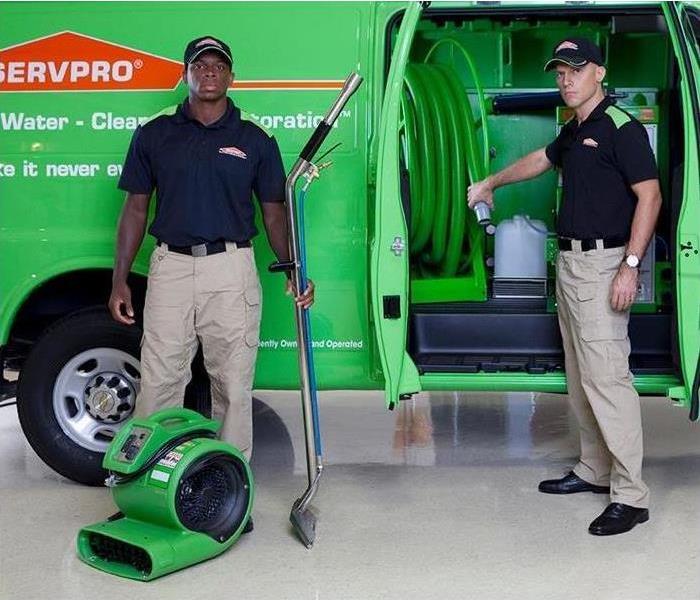 Make sure you not only have one set up for your facility, but also that it is up to date.
Make sure you not only have one set up for your facility, but also that it is up to date.
For a business owner, a worst-case disaster scenario involving fire or water damage can seem unthinkable until it suddenly becomes a reality. A quick response time by a disaster recovery company such as SERVPRO can help minimize property damage. Owners need to have a quick and convenient emergency disaster plan that connects them with vendors, necessary contacts, and pertinent information when disaster strikes. SERVPRO's Emergency Ready Plan (ERP) is a respected industry tool during a disaster event. It is so valuable that in the midst of the confusion and panic, an owner or manager can be provided a sense of calm and clarity in reaching out for expert help.
There are four key parts to building an ERP.
1. Identify your facility's greatest threats in order to assess the overall severity of the event.
- Look at your location that you are in. Be aware if you are in tornado alley, hurricane season, or subject to freezing temperatures.
2. Document all vital information and establish clear communication activities.
- An ERP needs to contain critical property information that can help speed up response time after a disaster strikes the property. Make sure to include any documentation that deals with prior loss history. Also, identify and label utility shut off locations, and prioritize your key contacts. Prior loss history can provide first responders and restoration vendors with historical information on your facility's condition. Also, proper utility identification will allow for quicker response times for emergency shut off, requests and key contact information is vital to starting the recovery process. This will allow you to quickly contact key personnel and answer priority questions.
3. Practice! Practice! Practice! There is no "textbook" event, so expect the unexpected.
- You should always conduct practice sessions to make sure everyone is clear on the process. There needs to be clear evacuation routes in your ERP, and set a distribution chain for your disaster recovery plan amongst key contacts and various locations.
4. Keep it updated, and have all necessary information communicated with your insurance company and emergency restoration vendors.
- Make sure your ERP is always up to date. This is the best way for the recovery to begin. People are going to come and go, updates will be made to the facility, and utilities can change. This should be a dynamic document that changes as your business does. You do not want to fall behind when disaster strikes!
Tornado Season
8/4/2020 (Permalink)
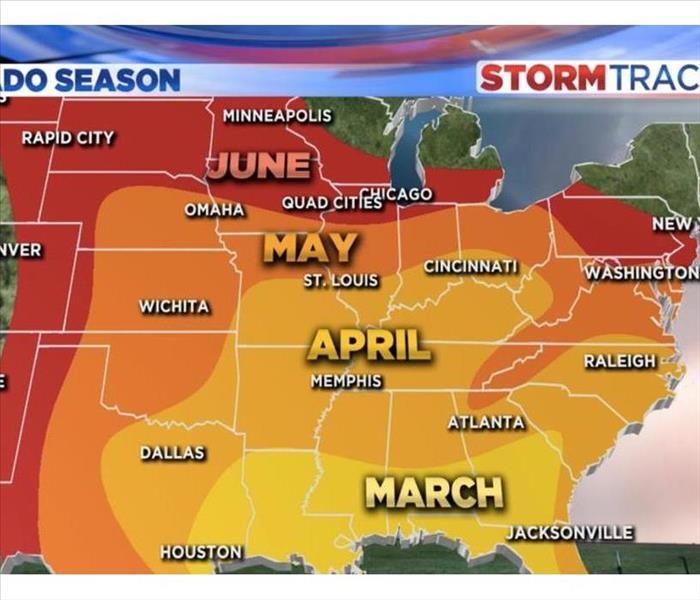 Check this out!
Check this out!
Tornadoes can occur year-round anywhere over the lower 48 of the United States, but the spring to summer period is prime time for severe thunderstorms that spawn the violent swirling columns of air. Building warmth and surging humidity are key ingredients for thunderstorms which, when severe, can evolve to produce tornadoes.
Severe thunderstorms will typically form when we get warm, moist air from the Gulf of Mexico clashing with cool air from Canada and sometimes dry air from the deserts. We often see the most tornadoes develop from central Texas, northward through the Nebraska and Iowa area, which is referred to as "Tornado Alley".
In order for severe thunderstorms to form, there must be a mechanism for air to rise in vigorous fashion. As a column of air rises through the atmosphere, it cools and causes moisture within to form the towering clouds we see as thunderstorms. The more moisture available and the cooler the air is aloft, the more efficient and potentially the more violent this process is. A push of dry air or cooler air from the outside can also intensify this process.
Any time there is a surge in temperature and humidity levels, combined with the approach of cooler and drier air thunderstorms can erupt. the most dramatic time of the year for this is in the spring to early summer. The peak for severe weather and tornado season is from April through June. Areas of the country that typically warm up the fastest with an ample supply of moisture are usually the most likely areas for early-season severe thunderstorms and tornadoes.
Certified: SERVPRO Cleaned Program
7/23/2020 (Permalink)
 Get set up today!
Get set up today!
We as a company have recently introduced our new program Certified: SERVPRO Cleaned, and it is designed to provide our communities with a way to know that a structure has been cleaned, sanitized, and disinfected. This is also a cleaning and disinfecting program that we here at SERVPRO have to offer for our commercial property owners in order to address the current COVID-19 pandemic. We ensure that when businesses choose SERVPRO, their customers, employees, and community are rest assured that they have selected a higher standard of cleaning.
This program is set up with 3 unique steps called the 3 C's. These 3 C's include Consult, Clean, and Certify.
Consult deals with the process of talking to each businesses personally because not all businesses are the same. A SERVPRO professional who understands the business will create a custom cleaning program to meet their specific needs. The specific program will be developed based on a range of factors including business type, size of space, amount of high frequency touch points, foot traffic, and congestion points. Therefore, they will know that the clean they receive is customized to their unique needs.
Clean is based on the specific needs of their business, and their location will undergo a thorough expert cleaning rooted in the pillars of People, Process, and Product.
-People: SERVPRO professionals are uniquely prepared during this unprecedented time to clean and disinfect homes or businesses according to the protocols set by the CDC. We have years of experience in dealing with biological contaminants, and we will go beyond the scope of work that needs to be done.
-Process: SERVPRO professionals are trained to perform proactive or emergency responsive cleanups that involves facility or structure cleaning and disinfection. This would include cleaning of porous and non-porous surfaces, disinfecting of non-porous surfaces, cleaning and disinfecting of equipment, tools and supplies used for cleanup, and disposal of hazardous materials. We also recommend a frequent cleaning depending on what CAT it is in. We want to make sure that people are getting back to business as soon as possible if there is a known COVID-19 case involved.
-Product: Our program has more than 100 exclusive professional cleaning products to meet any need. This includes our proprietary cleaning agent, SERVPROXIDE, which is a hospital-grade disinfectant that carries the Environmental Protection Agency's lowest toxicity category and is NSF certified for sanitizing surfaces in and around food processing surfaces.
Certify deals with the our credibility as the premier biohazard cleaning company in the country to their business. This then allows assurance to their employees and customers that only SERVPRO can deliver. Once the business has been cleaned, they will gain access to propriety signage, digital emblems, and other collateral that communicates that they've selected the highest standard of cleaning available to protect their employees and customers. We also have the option to add the date, so then their guests will know that their location is being cleaned regularly.
SERVPRO professionals have been on the front lines of proactive and reactive COVID related cleanups, and we are here to help as businesses begin to reopen and to also help them stay open!
Did you know?
7/23/2020 (Permalink)
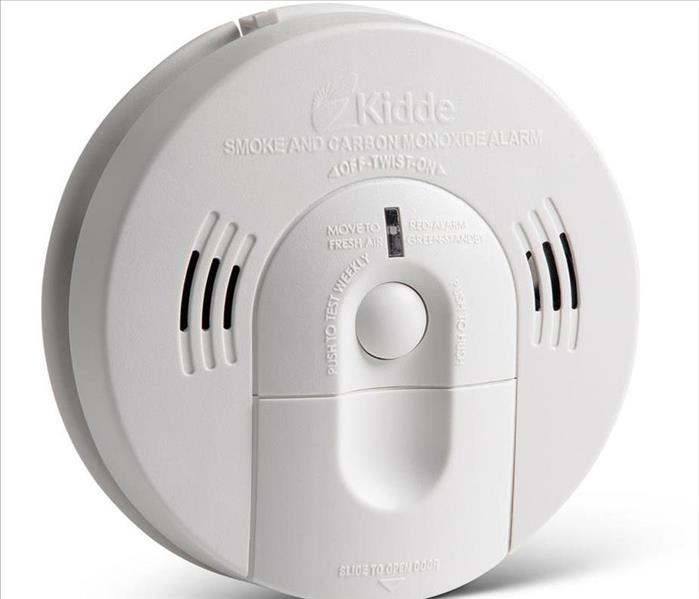 Make sure yours is set up today!
Make sure yours is set up today!
Did you know that local fire departments require carbon monoxide detectors?
The Elmhurst Fire Department requires that each home be outfitted with carbon monoxide detectors, in addition to smoke detectors.
For some people, they may not know this, so here are some helpful tips and steps about the carbon monoxide detector.
First off, Carbon monoxide is a colorless, odorless, and tasteless gas that is poisonous to humans. It is known as the "silent killer" because humans cannot tell when they are around it. The carbon monoxide detector is a safety device that can alert homeowners of a CO leak, and then help them escape a potentially life-threatening situation.
Carbon monoxide can be produced by any fuel-burning device. There are three main sources, and they are your home's furnace, dryer vent in a drying machine, and fireplace or chimney. It is VERY IMPORTANT to have those sources regularly services and cleaned by a professional to help prevent a CO leak.
When it comes to installation of the alarms, it is important to have them on every level of the home. That way all family members can hear the detectors go off. There should also be detectors in every bedroom, sleeping area, and common room for extra safety while asleep. They can be placed anywhere in the room, and can also be placed on the wall or the ceiling and will be just as effective.
Lastly, it is important to test your alarms regularly, so at least once a month. If it has replaceable batteries, they should be changed at least every 6 months. However, just because you replace the batteries doesn't mean they last forever. They have a lifetime of anywhere between 5-7 years.
The most common causes of house fires
7/23/2020 (Permalink)
There are many common causes when it comes to house fires, but there are measures that can be taken in order to avoid them.
Cook equipment that includes pots and pans can overheat very quickly, and they can cause a fire very easily if the person cooking gets distracted and then leaves the cooking unattended. ALWAYS stay in the area where cooking is taking place, or ask someone to water the food when cooking with hotplates.
Portable heaters are another common cause of house fire. Make sure to keep them at least one meter away from anything that could easily catch fire. This would include furniture, curtains, laundry, clothes and even yourself. If you have a furnace, get it inspected once a year to make sure it is working to safety standards.
Make sure to keep bedrooms off limits when it comes to smoking in the home. A cigarette tat is not put out properly can cause a flame, as the butt may stay alit for a few hours once one is done with it. It could burst into flames if it came into contact with flammable materials, such as furniture.
An electrical appliance, such as a toaster can start a fire if it is faulty or has a frayed cord. A power point that is overloaded with double adapter plugs can cause a fire from an overuse of electricity. Also, a power point extension cord can be a fire hazard if not used appropriately. Make sure to double check the appliances and power points in the home.
Candles may look and smell pretty, but if left unattended they can cause a room to easily burst into flames. Make sure to keep candles away from any obviously flammable items such as books and tissue boxes. Always blow out the candle(s) before leaving the room they are in.
Children can cause a fire out of curiosity, to see what would happen if they set fire to an object. Please make sure to keep any matchers or lighters out of reach in order to avoid this. Install a smoke alarm in your child's room and practice a home escape plan with your children and family in case there was a fire.
Homes with inadequate wiring can cause fires from electrical hazards. Some signs to see if you have bad wiring are
-lights dim if you use another appliance
-for an appliance to work, you have to disconnect another
-fuses blow or trip the circuit frequently
Make sure to have a licensed electrician come and inspect your home, or contact your landlord if you have any of the above occurrences.
Make sure when you barbeque to keep it away from the home, tablecloths or any plants and tree branches. Keep them regularly maintained and cleaned with soapy water and clean any removable parts. Check the gas bottle for any leaks before you use it each time.
If you have any flammable liquids in the home or garage such as petrol, kerosene or methylated spirits, keep them away from heat sources and check the label before story. Be careful when pouring these liquids.
Lastly, lamp shades and light fittings can build up heat if they are very close to light globes. Check around the house to make sure. Lamp bases can become a hazard if they are able to be knocked over easily, and so should be removed if they are. Check that down lights are insulated from wood paneling or ceiling timbers.
Key takeaways for preventing water damage
7/23/2020 (Permalink)
Water damage is the No. 1 culprit that weakens your home's foundation and the very core that holds your house together. I am sure you have heard about core strength for your body. Well, water damage hits at the core strength of your home, eventually causing serious structural damage. Damp wood invites termites and carpenter ants. It can also cause mold and mildew if not taken care of properly.
Here is how to prevent water damage using three easy strategies that will give you peace of mind the next time heavy storms hit.
1. Ensure good drainage
- clean your gutters
- direct downspouts 5-10' away from the house
- slope your yard away from the foundation
2. Test your sump pump
- check your sump pump once a year
- test more frequently during storm season
3. Fix water leaks
- repair any noticeable dripping pipes
- check for dark spots under pipes & on ceilings
- repair any cracked caulking
- inspect the roof for missing, loose of damaged shingles
By following these tips, you are going to have less of chance when it comes to the amount of water damage that the home may take on.
Here to help!
6/3/2020 (Permalink)
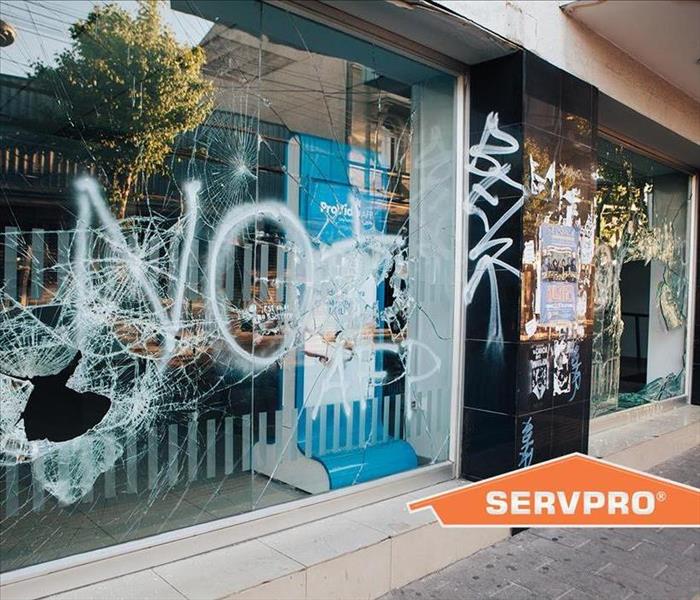 Damage to a building.
Damage to a building.
We here at SERVPRO want you to know that we are here to help during this time. Our immediate board up services will help your business by not taking anymore damage to it. Not only that, but it will also give you a peace of mind that your business is safe for the time being. This also leads into the next step of the reconstruction process to your business. We can help you get your business looking back to the way it should be. The final step that needs to be taken is our cleaning and sanitizing services to your business. We do not know who has been in and out of the building due to the looting, and COVID-19 is still present in our world today. We understand that your business is important to you, and you have been dealing with major obstacles recently. However, let SERVPRO give you that peace of mind, and help you get your business back up and running like it used to. We are all in this together!
Internship at SERVPRO
5/7/2020 (Permalink)
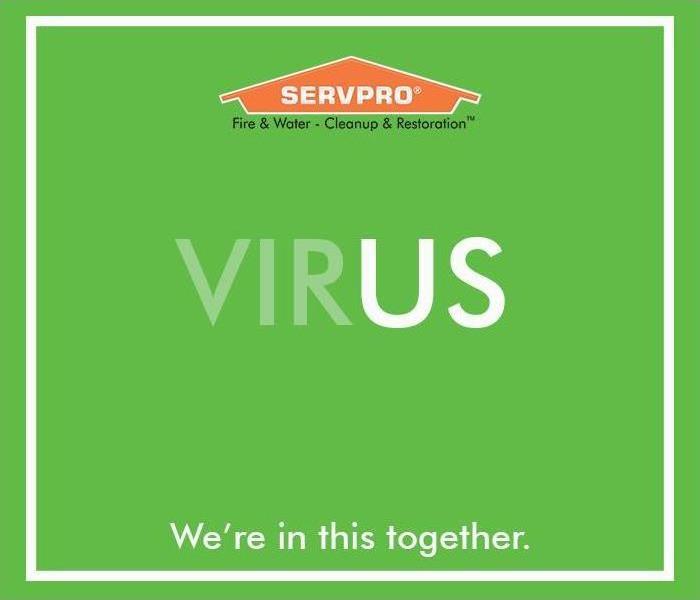 We are all in this together!
We are all in this together!
The company that I am interning for is SERVPRO of Elmhurst/Arlington Heights & N. Prospect/Lagrange Park & N. Riverside. The office location is located in Broadview IL, and the areas that are listed are the territories that our marketing team is allowed to market in. SERVPRO is a franchise that is owned and operated by personal owners. We have over 1,700 locations across the United States. Our company focuses on fire, water and mold restoration and mitigation for disasters that strike homes, buildings, businesses, etc. We are also currently doing cleaning and disinfecting for COVID-19 with our Vanquish product and fogging system. As far as what I do as an intern at SERVPRO, I work alongside the marketing and sales team. Our job is to go on daily routes around our territories and market SERVPRO to insurance agents, restaurants, hotels, churches, retail stores, etc. You name it, SERVPRO can help! However, one major struggle we are having during this time is not being able to go out on our daily routes to market and sell because of the current pandemic we are in. Therefore, all the team members are in the office and are brainstorming ideas on how to market SERVPRO from behind a computer screen. Some ideas we have come up with is marketing through social media. This is mainly my job because the other members don’t care for it, and I actually really like it. I have access to all the social media accounts like Instagram, Facebook, LinkedIn, Twitter, etc. Every day I come in and do daily posts on all the accounts in order to ensure we are getting the SERVPRO name out on the Internet more. Especially now since everyone is at home with the stay-at-home order in place, they are constantly on their smart devices. I also have been doing blog entries on the SERVPRONet website about my internship here at SERVPRO. SERVPRONet is a personal website for SERVPRO employees to access that has updated news for everyone, marketing tools, sales techniques, and so on. I also have been attending weekly WebEx meetings with the SERVPRO marketing headquarters with all different SERVPRO franchises across the country. They show us helpful tools to use while being stuck at home or in the office. Another major event that our company has been doing is free cleaning and disinfecting for our first responders. Our team members have been going out and doing cleaning and disinfecting to the vehicles and offices of police and fire departments in our territories. This has given our company major recognition on social media websites, and we are even building relationships that we didn’t have before. I love what I do here at SERVPRO and I have learned so many different techniques about marketing and sales that I never knew before. This has given me so much more confidence when approaching new people, and building up my relationship skills. I have developed a different side of professionalism that I didn’t know I had before, and it is truly amazing to see the growth I have gained because of SERVPRO. The employees I work with treat everyone like family, and it is very welcoming when you walk in the door every day. I always have a smile on my face when I enter in the morning, and then when I leave in the afternoon. I love coming to work every day, and that is exactly how it should be. Thank you SERVPRO for letting be on this internship journey with your company!
Cleaning & Disinfecting for COVID-19
4/1/2020 (Permalink)
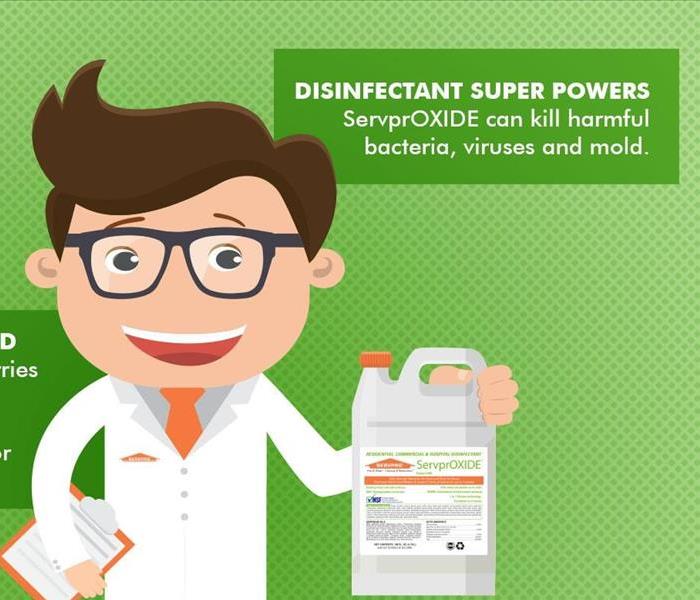 This is the product that we use for cleaning and disinfecting. We want to help do our part by stopping the spread of the virus!
This is the product that we use for cleaning and disinfecting. We want to help do our part by stopping the spread of the virus!
Hello,
We have been out servicing 911 call centers, trucks, distribution warehouses and distribution offices that are keeping our stores stocked with supplies and know that our Police and Fire Departments also need to be out to protect our communities but also need to stay free from a spread of the SARS-CoV-2” COVID-19 .
We here at SERVPRO wanted to let you all know that we are currently are open to help combat the spread of the virus. SERVPRO, with direction from the CDC have put together protocol to deal with “SARS-CoV-2” COVID-19 pro-actively (pre-positive test) and reactively (post-positive test).
These general guidelines are broad in scope and are not-specific protocols. Any protocols from federal, state, local agencies, or an industrial hygienist would supersede these guidelines. A CAT system has been designed for the different calls as it relates to “SARS-CoV-2” COVID-19.
CAT1: Proactive cleaning only CAT2: Person under investigation (PUI) or possible exposure CAT3: Confirmed, positive case
The protocol for CAT 1 is attached along with the SDS sheets, Chemical information, approval forms and rates for the services. We know that it is ever changing at a rapid rate and is very volatile. If you are in need of any services please reach out to us and we will do our best to help answer any questions or perform any work.
CAT 2 and CAT 3 – Protocol:
The Centers for Disease Control and Prevention (CDC) is closely monitoring an outbreak of respiratory illness caused by a novel (new) coronavirus (named “SARS-CoV-2”) that was first detected in Wuhan City, Hubei Province, China, and spread to dozens of countries throughout the world. This is an emerging, rapidly evolving situation and the CDC will provide updated information as it becomes available, in-addition to updated guidance.
https://www.cdc.gov/coronavirus/2019-ncov/community/organizations/cleaning-disinfection.html
Cleaning and Disinfection After Persons Suspected/Confirmed to Have COVID-19 Have Been in the Facility
Timing and location of cleaning and disinfection of surfaces
- At a school, daycare center, office, or other facility that does not house people overnight:
- It is recommended to close off areas used by the ill persons and wait as long as practical before beginning cleaning and disinfection to minimize potential for exposure to respiratory droplets. Open outside doors and windows to increase air circulation in the area. If possible, wait up to 24 hours before beginning cleaning and disinfection.
- Cleaning staff should clean and disinfect all areas (e.g., offices, bathrooms, and common areas) used by the ill persons, focusing especially on frequently touched surfaces.
- At a facility that does house people overnight:
- Follow Interim Guidance for US Institutions of Higher Education on working with state and local health officials to isolate ill persons and provide temporary housing as needed.
- It is recommended to close off areas used by the ill persons and wait as long as practical before beginning cleaning and disinfection to minimize potential for exposure to respiratory droplets. Open outside doors and windows to increase air circulation in the area. If possible, wait up to 24 hours before beginning cleaning and disinfection.
- In areas where ill persons are being housed in isolation, follow Interim Guidance for Environmental Cleaning and Disinfection for U.S. Households with Suspected or Confirmed Coronavirus Disease 2019. This includes focusing on cleaning and disinfecting common areas where staff/others providing services may come into contact with ill persons, but reducing cleaning and disinfection of bedrooms/bathrooms used by ill persons to as needed.
- In areas where ill persons have visited or used, continue routine cleaning and disinfection as in this guidance.
How to Clean and Disinfect
Surfaces
- If surfaces are dirty, they should be cleaned using a detergent or soap and water prior to disinfection.
- For disinfection, diluted household bleach solutions, alcohol solutions with at least 70% alcohol, and most common EPA-registered household disinfectants should be effective.
- Diluted household bleach solutions can be used if appropriate for the surface. Follow manufacturer’s instructions for application and proper ventilation. Check to ensure the product is not past its expiration date. Never mix household bleach with ammonia or any other cleanser. Unexpired household bleach will be effective against coronaviruses when properly diluted.
- Prepare a bleach solution by mixing:
- 5 tablespoons (1/3rd cup) bleach per gallon of water or
- 4 teaspoons bleach per quart of water
- Products with EPA-approved emerging viral pathogens claims are expected to be effective against COVID-19 based on data for harder to kill viruses. Follow the manufacturer’s instructions for all cleaning and disinfection products (e.g., concentration, application method and contact time, etc.).
- For soft (porous) surfaces such as carpeted floor, rugs, and drapes, remove visible contamination if present and clean with appropriate cleaners indicated for use on these surfaces. After cleaning:
- If the items can be laundered, launder items in accordance with the manufacturer’s instructions using the warmest appropriate water setting for the items and then dry items completely.
- Otherwise, use products with the EPA-approved emerging viral pathogens claims (examples at this link) that are suitable for porous surfaces
Thank you for your time and stay safe.
We are still open!
4/1/2020 (Permalink)
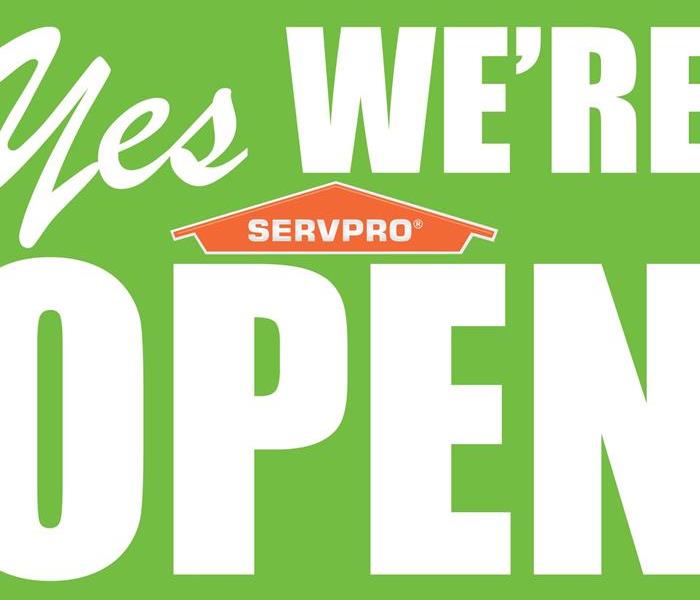 We are still open during this pandemic, and want to help our customers with whatever they may need.
We are still open during this pandemic, and want to help our customers with whatever they may need.
SERVPRO of Elmhurst provides 24-hour emergency service and is dedicated to being faster to any-sized disaster in Elmhurst. We can respond immediately to your emergency and have the expertise to handle your restoration or cleaning needs.
- 24-Hour Emergency Service
- Faster to Any-Sized Disaster
- Highly Trained Restoration Technicians
- A Trusted Leader in the Restoration Industry
- Locally Owned and Operated
- Advanced Restoration and Cleaning Equipment
Have Questions? Call SERVPRO of Elmhurst 630-758-1701
Residential Services
Whether your Elmhurst home needs emergency flood damage or your upholstery cleaned, you can depend on us. Our technicians have extensive cleaning and restoration training and can make your property look its best. Learn more about our residential services:
- Water Damage Restoration
- Fire Damage Restoration
- Mold Remediation
- Storm Damage Restoration
- Cleaning Services
- Building/Reconstruction Services
Commercial Services
There's never a convenient time for fire or Water damage to strike your Elmhurst commercial property. Every hour spent cleaning up is an hour of lost revenue and productivity. When the need arises for professional cleaning or emergency restoration services we have the training and expertise to respond promptly with highly trained technicians to get your property back to business.
How To Protect Your Home From Lightning
2/25/2020 (Permalink)
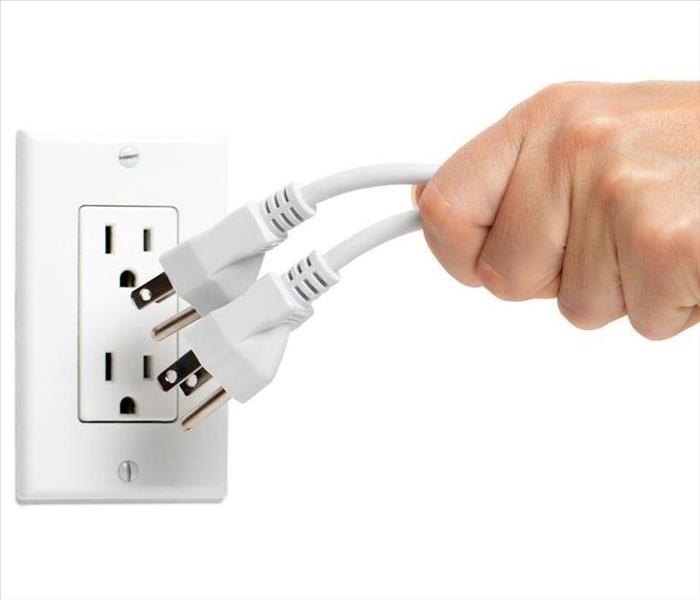 Be sure to unplug all electronics
Be sure to unplug all electronics
Ways Your Home Stays Protected From a Lightning Fire
A typical thunderstorm may not seem like a major cause for concern. However, lightning can have many detrimental effects on your house. The damage caused by a thunderstorm can range from a power surge to a house fire. By taking the proper precautions, you can keep your house safe from any kind of natural disaster. Here are some simple ways to ensure that your Prospect Heights, IL, home stays protected from a lightning fire.
Unplug All Electronics
Many electronic devices are a serious source of danger during a thunderstorm. Because these devices typically use multiple outlets, they run the risk of becoming severely damaged during a storm, which can pose a threat to your entire home. Be sure to unplug the following types of electronics before the storm begins:
- Computers
- Phones
- Flat screen TVs
- Stereo equipment
In addition to unplugging these devices, make sure that they’re not in use during the storm. If lightning hits a telephone pole while you’re talking on the phone, for example, it can send harmful voltage straight to your living space. As a rule of thumb, try to stick to cordless devices like cellphones and laptops to prevent a lightning fire from occurring.
Safeguard Your Home’s Exterior
Keeping the outside of your home protected is just as important as protecting the inside. Be sure to have rods installed on your home’s roof to keep your building safe from the effects of a thunderstorm. Additionally, make sure that there are no tall trees in the immediate vicinity of your home. This can significantly reduce the risk of a fire in your living space. Another effective option is to have a lightning protection system in place, which can ensure that your house stays fully protected during a storm.
In the event that a lightning fire impacts your living space, don’t wait to give your home the full recovery it needs. Experts can conduct a fire damage assessment and bring your space back to normal in no time.
First Steps After Home Water Damage
2/11/2020 (Permalink)
 Water extraction in a Prospect Heights, IL
Water extraction in a Prospect Heights, IL
Water-related property damage is among the top three causes of homeowner’s insurance filings. If you have experienced water damage in your Prospect Heights, IL, home, you may know it’s not easy to make logical decisions in a crisis. This simple outline may help you chart your course.
The Source
If the source of the offending water is inside your home, as is the case with broken pipes or leaky appliances, turning off your water main valve should stop the problem. If external water, such as rising floodwater, infiltrated your home, it’s best to prioritize safety and seek higher ground until the water subsides.
Safety Check
Consider taking the following important safety precautions before entering the flooded area:
- Keeping children and animals safely away from the water damage
- Disconnecting your electrical panel
- Ventilating with windows and fans
- Wearing waterproof waders and gloves
- Ventilating generator fumes properly
If you’ve checked off that safety list, you are ready to begin or arrange for someone to begin the cleanup. If you were not able to deactivate your electrical, or if your damage was caused by a flood, it is important you seek assistance from an emergency water remediation service. Floodwater can be highly contaminated with sewage, chemicals, and other hazards. It would not be wise to begin the cleanup without a specialist to supervise the process.
Do-it-Yourself Cleanup
If your water damage is fairly minor, less than one inch of standing water, you can begin removing the water with a wet vacuum once you’ve taken the safety precautions. Set up a drying area in the garage or on a patio so you can spread items out to dry. Strong ventilation will help prevent mold growth.
Insurance
Once safety has been addressed and cleanup has begun, it’s a good idea to notify your insurance provider. Your agent will be able to summarize your coverage and initiate a claim.
A water-damage event in your home can be unsettling. Before you begin the water cleanup, it’s important to stop the source, prioritize safety precautions and hire professional support. Start there, and you and your family will be back to normalcy before you know it.
4 Hidden Dangers of Water Leaks
1/28/2020 (Permalink)
 Ceiling damage in Arlington Heights, IL
Ceiling damage in Arlington Heights, IL
Here are Some of the Hidden Dangers of Water Leaks
At first glance, a water leak may not seem like a major cause for concern. However, even small leaks can pave the way for severe water damage and high utility bills. As a business owner in the Arlington Heights, IL, area, knowing what to do in the event of a leak is critical to your company’s success. Here are some of the hidden dangers of water leaks that you should look out for to keep your business protected.
1. Ceiling Damage
If you have a roof leak that resulted from a pipe break, you will likely begin to notice damage to your ceiling. Once your ceiling becomes harmed, the damage may start to spread to other areas of your building, such as the walls and ceiling lights. As soon as you notice that your roof is leaking, call a professional to have the leak repaired and to prevent further harm.
2. Mold Damage
Any area of your building that contains adequate moisture is vulnerable to mold growth. When there is a water leak in your building, you have a much higher chance of encountering mold damage. Even small, steady leaks may lead to visible mold growth that can spread rapidly.
3. High Utility Bills
A higher water bill is expected when you’re dealing with a leak in your business. However, ongoing water damage may also lead to increased energy consumption, which can cause your utility bills to skyrocket. This typically occurs as a result of damaged insulation and a greater loss of warm and cold air.
4. Structural Damage
If a leak persists for long enough, it can compromise the integrity of your commercial building. Structural damage from water leaks may include deteriorated walls, rafters, wood flooring or ceiling joists. Not only are these repairs expensive, but they can also slow down your business.
A water leak is a problem that should be taken seriously. If you notice any signs of damage in your business, don’t hesitate to take action and call for a water damage repair immediately.
What To Know About Pretesting and Your Insurance Claim
1/22/2020 (Permalink)
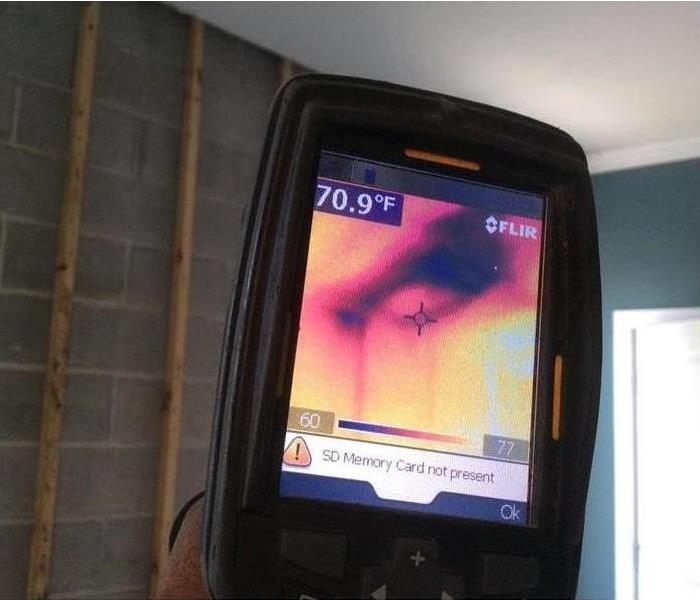 The process of pretesting is used to determine which items have suffered damage and how much
The process of pretesting is used to determine which items have suffered damage and how much
What To Know About Pretesting and Your Insurance Claim
After a fire at your Prospect Heights, IL, business, you may contact your local SERVPRO for restoration. These professionals have the tools necessary to not only perform cleanup and make repairs but can work with your insurance agent on the insurance claim as well. There are several steps to the process, but the most confusing might be pretesting. Here’s what you might want to know.
1. It can Save Cleaning Time
The testing process involves using a chemical sponger to gently swab each surface. The sponge then reacts showing if the items has suffered soot or smoke damage. This process allows the restoration crew to quickly assess the area, and helps ensure that they are cleaning or restoring the items that need it, without using up time working on objects that are undamaged.
2. It Determines if an Item Can Be Restored
Another of the benefits of pretesting is that this process can help determine restoration ability of the damaged items. Items may have suffered less damage than they first appeared to have, meaning that as the items are tested they can be set aside for restoration rather than replaced.
3. It Can Save You Money
Not only can this process save on cleaning time, but it can save you money as well. Because testing allows the restoration team to determine what items can be restored, you may find you have far fewer things to replace than first anticipated. The savings from this could make a difference to your business. The process can also cut down on the time it takes to go through everything. This may also save you money as it means the cleanup task can be completed that much sooner, allowing you to get back to business operations.
The process of pretesting is used to determine which items have suffered damage and how much. This allows the restoration team to quickly determine if an item needs cleaning, can be restored or should be replaced. Not only can this save time on cleaning, but the more items that can be restored the more money you save as well.
Continuing Education Classes
1/16/2020 (Permalink)
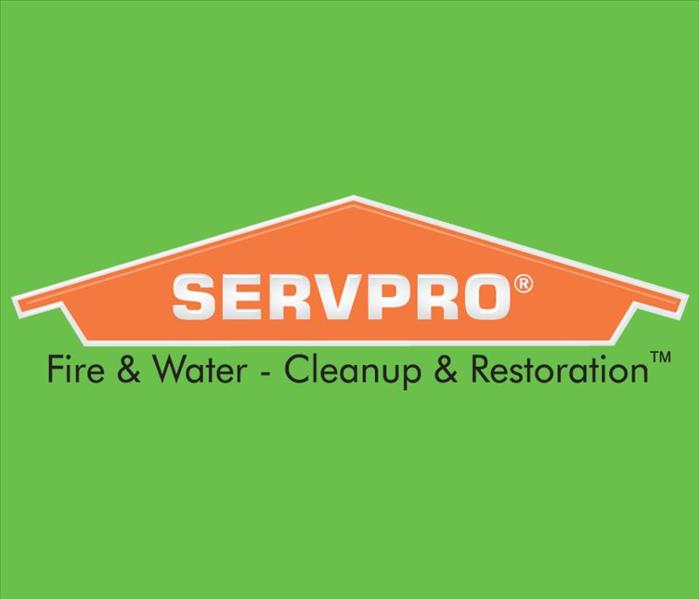 Let me be your stranger for Continuing Education Classes
Let me be your stranger for Continuing Education Classes
Every day that we are here on the earth we are learning something new and exciting, BUT………………..
Are we being taught the truth?
How do we know we are being taught the truth? How do we know that the person teaching us really understands and has grasped the information they are teaching? How do we know it is just not an opinion? Where did the information come from? When you really think about it, everything we learn comes from a stranger. I fully understand that we learn from our parents but they are strangers by definition.
stran·ger
/'stranj?r/
noun
- 1.a person whom one does not know or with whom one is not familiar: "don't talk to strangers"
We are taught as children don’t talk to strangers but...
Everyone we come in contact with is a stranger.
I know it is hard to grasp as a concept but it is the truth. When you are born you are put in front of people you have never met. People that you have to trust or you will not make it another day. People that you are taught to call mom or dad or mama or papa etc. People are to feel comfortable with or trust for one reason or another.
Let me be your stranger for Continuing Education Classes
If you need to take Continuing Education Classes and don’t want to just be a space bar pushing zombie. Sign-up for one of the classes I offer. I will tell you it is a lot better than a sharp stick in the eye. Hope to see you in class.
Do These Three Things To Prevent Additional Mold Damage
1/8/2020 (Permalink)
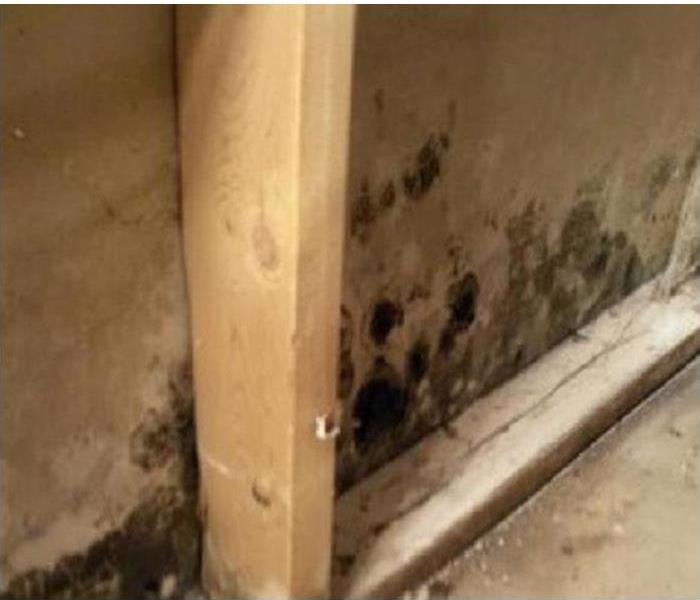 Mold damage on a wall in Arlington Heights, IL
Mold damage on a wall in Arlington Heights, IL
3 Things To Prevent Additional Mold Damage
If black mold has invaded your commercial space, act immediately to mitigate the damage. Spores spread quickly, and, if not stopped, can eat away at structural materials, creating major issues to your building. Contact a mold remediation company in Arlington Heights, IL, to investigate the situation and offer assistance in cleaning the area and repairing any damage. Here are three things you'll want done to stop the problem as soon as possible.
Cut Off Air Flow
Fungus spores move quickly, floating in the air or carried by people walking through the area. Once growth begins then, the infestation could develop fast, causing issues within one to two days. During mold cleanup, try to eliminate the microbes ability to move from room to room. That requires shutting off the air system within the impacted section. A professional group can use negative air flow equipment to contain it. In addition, establish barriers to keep others from going in and out.
Eliminate Water Exposure
The catalyst for black mold development is fluid, so turn off the water that is encouraging reproduction. Then, begin drying out the area as soon as possible. Have industrial dehumidifiers run around the clock until testing indicates that drywall and flooring are no longer wet. Continue to monitor the humidity levels, and, if needed, place absorbent products in closets and isolated locations.
Repair the Initial Trouble
What caused the moisture problem? You'll need to discover the origin of the trouble. Is it a leaky pipe? Do you have a hole in the roof? As long as it continues, your business could suffer. During the remediation team's early evaluation, ask them to seek out the source. In addition, have them patch if not fix the cause. Then, establish a routine schedule for maintenance.
Black mold could be devastating, forcing you to shut down work while the establishment is sanitized; therefore, at first signs of fungus, take measures to prevent it from growing rapidly. Limit air circulation, minimize water contact and resolve the primary complication.
Saving Electronics After a Fire
12/31/2019 (Permalink)
 Burned computer after fire damage in a Prospect Heights, IL business
Burned computer after fire damage in a Prospect Heights, IL business
Tips On Saving Your Electronics
When it comes to your business, an electrical fire can be devastating. The flames, heat and smoke can damage nearly everything. Smoke damage can affect the computers that hold sensitive data and the appliances that help your business run. Firefighting attempts may douse electronics with extinguishing agents. If you have experienced a fire at your Prospect Heights, IL, business, here are some tips for saving your electronics.
1. Disconnect
Due to the possibility of water exposure, ensure that all electronics are unplugged after an emergency. Several variables can come into play regarding the damage to electrical systems during a fire. The extent of the destruction can vary depending on where the device was located at the time as well as if any of its circuitry was exposed and how high the heat levels rose. Many devices use a small amount of power to maintain internal memory, even when they are switched off, so be sure to fully and safely disconnect them.
2. Inspect
If handled properly, many electronics have a high recovery rate after an electrical fire. You should contact professionals with specialized fire and water damage restoration training to complete this. Experts in emergency restoration services will be able to remove your electronic devices from your damaged property to a clean, safe environment. This will allow for an assessment of fire, water, and smoke damage. After the inspection, the team can develop a restoration project for your items, such as a specialized computer cleanup plan.
3. Restore or Replace
After inspection, the professionals will determine whether restoration is possible or if you need to replace your electronics. Items that can be salvaged require expert drying and cleaning to remove soot, magnetic charge and black film. Items that cannot be saved may be replaceable under your warranty, so be sure to check your records.
An electrical fire can happen suddenly and take you by surprise. Be sure to know how to handle this situation, and learn about saving electronics for your business.
How to Keep Your Company's Roof in Good Shape
12/23/2019 (Permalink)
 Roof inspection in Arlington Heights, IL
Roof inspection in Arlington Heights, IL
Just like at home, the roof of your building is critical to your safety, security and comfort. A well-built roof keeps out the elements and protects everyone inside from hazards. Roof damage can lead to flooding and other costly issues. This could even interrupt your business and leave without a place to work. You may think the roof will last forever, but without proper upkeep, it could falter and fail.
Inspect the Outside Regularly
Depending on the material used for your building roof, it should last anywhere between 20 and 50 years. This doesn't mean you should assume it's in prime condition, even if it's only a few years old. Conscientious business owners in Arlington Heights, IL, frequently examine the roof to make sure it is doing its job properly. Your or a professional you hire should get on the roof at least once a year and look for the following:
- Weak spots or structural damage
- Cracks that allow leaks to get inside the building
- Dirt or debris
- Broken chimneys, vents or skylights from wind damage or other issues
Go Inside
You should also look inside at the underside of the roof. Check the rafters and trusses for mildew, mold and rot. If these components break, they would compromise the roof's integrity and force you to do a roof rebuild. You should also keep an eye on expansion joints to whether they have moved at all.
Pay Attention To the Drainage
You shouldn't only be concerned about the roof itself. Rain gutters and downspouts also contribute to the roof's effectiveness. Make sure you clear debris such as leaves from the gutters. Improper draining systems could leave excessive water on the roof, leading to rotting and heavy damage.
Roof damage can be expensive to repair, but it can also lead to other issues. Before you call a professional flood cleanup team to repair the roof and its damage, follow these important do-it-yourself steps.
How To Clean Up Water Damage
12/6/2019 (Permalink)
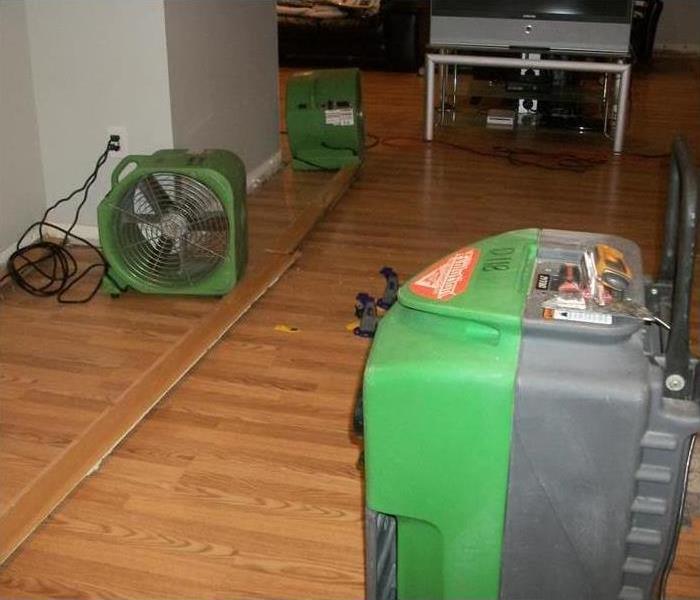 Drying remaining water in a Prospect Heights, IL home
Drying remaining water in a Prospect Heights, IL home
Water Restoration Process
Water damage to your Prospect Heights, IL, home can be a major hassle. The sooner you begin cleanup, the less likely you are to have secondary problems, such as mold growth. The following steps will guide you through the restoration process.
Address the Water Source
The flooding may be due to broken pipes, a leaky roof or any number of other causes. You have to stop the flow of water before beginning cleanup. Although a temporary solution may allow you to get started on the restoration process, it is important to fully repair the problem to prevent future flooding.
Assess the Water Damage
Consider the size of the affected area and the amount of water present. Check for signs of mold growth. Decide if you will be able to handle the restoration process yourself.
Remove Standing Water
The amount of water present determines the best way to remove standing water. You may be able to scoop the water out with buckets, or you may need to use special pumps or vacuums.
Dry Remaining Water
After the standing water has been removed, you will still have to contend with wet furnishings, carpet, etc. You can use fans and dehumidifiers to help with this step of the water cleanup process. If the outside humidity is low enough, you can open windows and doors.
Sanitize Affected Areas
Depending on the level of contamination in the water, it may be necessary to clean the surfaces that came into contact with the floodwater. In many cases, a store-bought antibacterial cleaner will be sufficient. More severe cases may call for harsher detergents.
Repair and Replace Damaged Items
Throw out any items that you are unable to fully dry and sanitize. Other items may be too damaged to repair, but some may only need a new coat of paint.
Don’t worry if the above steps seem overwhelming. A professional restoration service can repair water damage and get your home back to normal quickly and safely.
3 Ways To Rid Your Bathroom of Mold
11/27/2019 (Permalink)
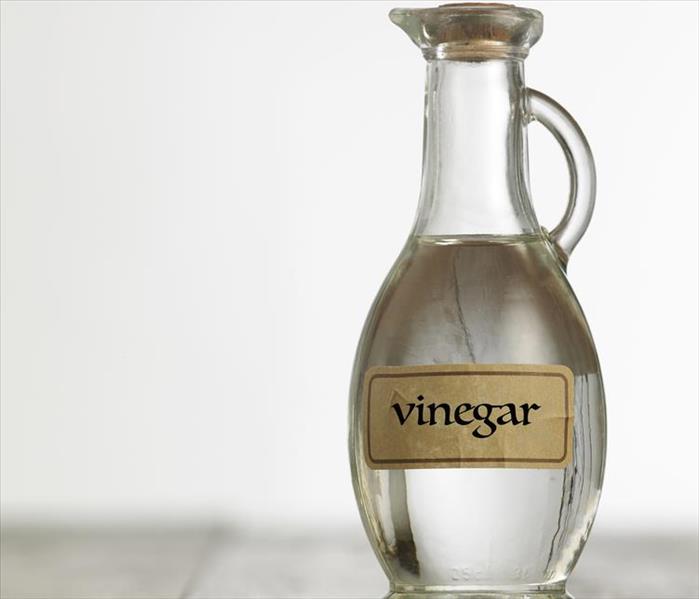 White vinegar is an anti-fungal powerhouse, as is the common cleaner Borax
White vinegar is an anti-fungal powerhouse, as is the common cleaner Borax
Tips For How To Handle Shower Mold In Your Bathroom
If you've ever had to deal with mold in your Arlington Heights, IL, home, you know it can be a lot of work to get rid of. Black mold thrives in places where moisture is trapped, and this often means your bathroom and shower are prime locations due to the high humidity levels. Mold can grow on shower walls and ceilings, in grout and drains, and even on your shower curtain. If you're facing shower mold in your bathroom, here are some tips for how to handle the situation.
Keep it clean. White vinegar is an anti-fungal powerhouse, as is the common cleaner Borax. You can use a solution of either of these to start killing mold, and they will help inhibit additional growth. Addressing any mold as soon as you spot it is an important first step.
Contact a professional service. Black mold growth that is harder to locate likely requires the expertise of trained mold remediation specialists. Since it can live behind shower tiles or under shower fittings and fixtures, contacting an expert can save you a lot of trouble. They have the equipment and expertise to correctly inspect and assess your shower mold issue and create a mold remediation plan that works effectively.
Keep moisture levels low. One of the best ways to prevent moldy spots from growing in your bathroom is to remove the source. Take steps to limit excess water and humidity in your bathroom, since mold loves them. Check that water has ways to drain properly and use ventilation so moisture can escape.
Remember, it's not a crisis if you find shower mold in your home - but you should take care of it as soon as possible to limit mold damage. Use these tips, and call a professional team when in doubt of the severity. You won't regret the decision to take mold cleanup for your home seriously.
Can Lightning Cause a House Fire?
11/22/2019 (Permalink)
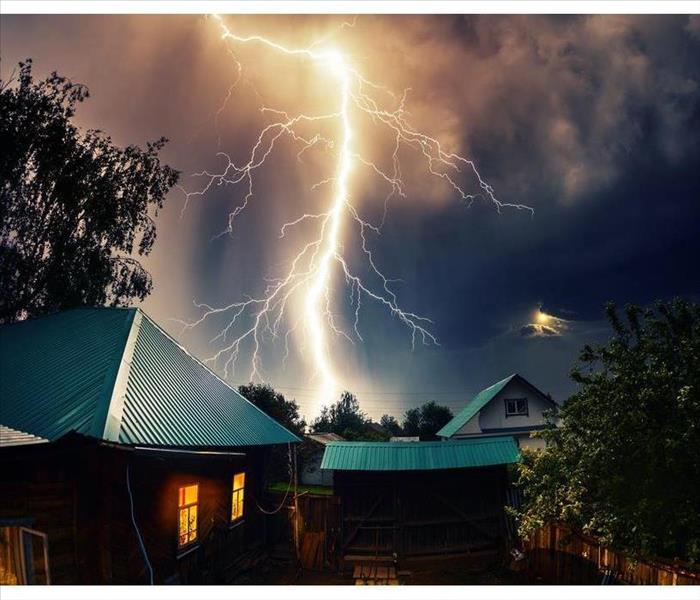 If a lightning fire does harm your home, your local emergency restoration specialists can help with any repairs
If a lightning fire does harm your home, your local emergency restoration specialists can help with any repairs
Can Lightning Cause a House Fire?
You probably know about the indoor dangers that can cause a house fire, such as an unattended pot or a knocked-over candle. Yet fires can also result from weather events that you can't control. A lightning fire, in particular, can be devastating to your Arlington Heights, IL, home.
In fact, thunderstorms, and the lightning they bring with them, can cause more fire damage than you think. Between 2007 and 2011, local fire departments in America responded to an average of 22,600 of these blazes each year. The fires caused an annual average of $451 million in property damage. Here are some more stats you may not have known about these fires.
From 2007 to 2011, they caused an average of 53 civilian injuries and nine civilian deaths each year
While only 18 percent of thunderstorm fires were inside houses, these accounted for 88 percent of the associated civilian deaths between 2004 and 2008
They also create a big need for fire cleanup, as 70 percent of the property damage caused by lightning fires occurred in homes
When Do They Strike?
You are most likely to see a lightning fire in the summer months. This type of blaze is particularly common during late afternoons and evenings.
How Do I Stay Safe?
You are still better off staying inside your house if you hear thunder. No outdoor area is safe during a thunderstorm. Avoid standing under trees or inside small sheds. Instead, get to a sturdy shelter.
Once inside, don’t use any electronics that require an outlet, such as computers and corded phones. You should also avoid bathing, showering, doing the dishes or washing your hands.
Just because the thunder ends doesn’t mean the storm is over, either. You should wait at least 30 minutes after the thunder stops before heading back outside.
No matter the cause of the blaze, fire damage cleanup can be an overwhelming process. If a lightning fire does harm your home, your local emergency restoration specialists can help with any repairs.
THANKSGIVING HOME FIRES
11/18/2019 (Permalink)
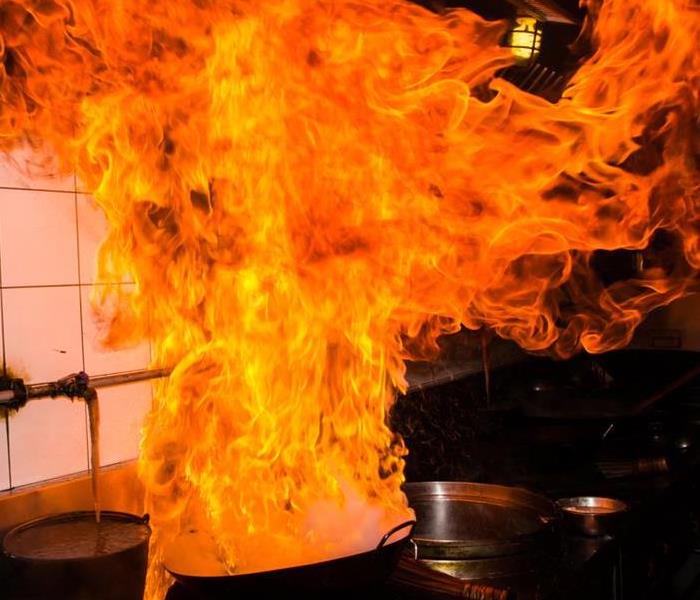 Our SERVPRO of Arlington Heights/Prospect Heights professionals wishes you a safe and happy Thanksgiving and holiday season.
Our SERVPRO of Arlington Heights/Prospect Heights professionals wishes you a safe and happy Thanksgiving and holiday season.
Each November, families gather to celebrate Thanksgiving by preparing a delicious feast,
but if you don’t practice safe cooking habits, your happy holiday could quickly become hazardous in a blink of an eye. According to the NFPA, cooking is the main cause of home fires and injuries, with the Thanksgiving holiday being the peak day for cooking-related fire emergencies. Review the following safety tips to help ensure you can enjoy a safe holiday.
*Never leave cooking food unattended—stay in the kitchen while frying, grilling, or broiling food. If someone must leave the kitchen for even a short period of time, they should turn off the stove.
*Check food regularly while cooking and remain in the home while kitchen equipment is in use. Use a timer as a reminder that the stove or oven is on.
*Keep small children away from the cooking area. Enforce a “kid-free zone” and make them stay at least three feet away from the stove and oven.
*Keep anything flammable like potholders, oven mitts, wooden utensils, paper or plastic bags, food packaging, and towels away from the stove, oven, or other appliances in the kitchen that generates heat.
*Do not wear loose clothing or dangling sleeves while cooking.
*Clean cooking surfaces on a regular basis to prevent grease build-up.
*Purchase a fire extinguisher
to keep in the kitchen year-round. Contact the local fire department for training on the proper use of fire extinguishers if you are unsure.
*Always check the kitchen before going to bed or leaving the home to make sure all kitchen appliances like stoves, ovens, and toasters are turned off.
*Install a smoke alarm near the kitchen, on each level of the home, near sleeping areas, and inside and outside of bedrooms. Use the test button to check it is working properly every month. Replace the batteries at least once a year.
Our SERVPRO of Arlington Heights/Prospect Heights professionals wishes you a safe and happy Thanksgiving and holiday season.
How a Blizzard Can Harm a Home
11/12/2019 (Permalink)
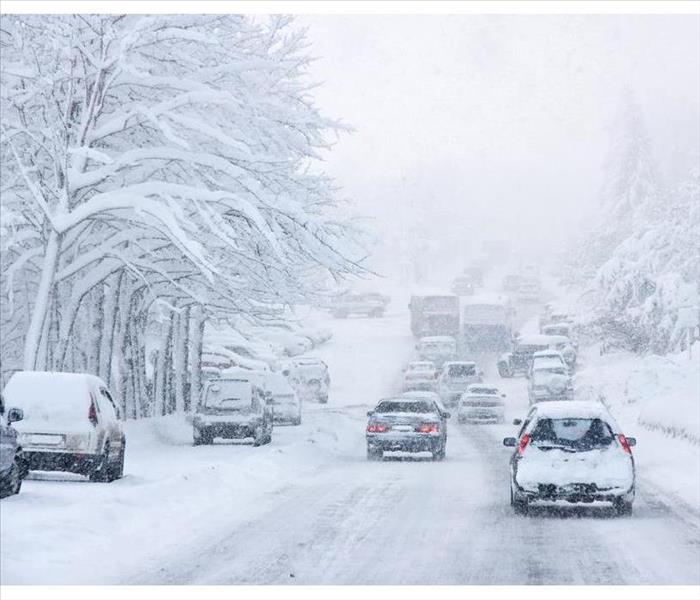 A winter storm can become dangerous, harming parts of your home.
A winter storm can become dangerous, harming parts of your home.
How a Blizzard Can Harm a Home
As the temperature drops, winter emerges, with the beauty and strength of snow and ice. While a breathtaking season, it is also one with power and the potential for destruction. Therefore, winter storm damage possesses a major concern for homeowners in Prospect Heights, IL. You may grow concerned about how to protect your property and keep the integrity of your roof intact. Consider these three things as you prepare for this cold juncture.
1. Are Ice and Snow Harmful?
A blizzard is an intense weather system, combining ice, snow and wind. These three powerful forces can wreak havoc, causing destruction and requiring repairs. With winds over 35 mph, they have the ability create the following issues:
- Form ice dams
- Ruin siding
- Shatter glass
- Collapse the roof
- Knock down trees
Try to trim branches, clean gutters and inspect the rooftop during autumn. That could help prevent some of these larger problems.
2. Who Do You Call?
Despite your best efforts, the winter storm may still harm something; thus, when the skies clear, immediately contact a water and storm restoration company. If the roof gave in, leave the premises. At that point, the place is unstable, and people should not be inside. When the experts arrive, they can evaluate the system's impact on your place. At this time, they can survey the damage, place tarps on the roof and begin to clean up your belongings.
3. What Can You Do?
Roof damage is a big process, so prepare yourself for a long wait. Meet with your construction manager to discuss a time frame, and visit the site frequently to see progress. In addition, during this time, allow the specialists to help with question as well as recovering your personal items. They can advise on best practices.
As the winds pick up and ice falls, a winter storm can become dangerous, harming parts of your home. Be patient, and call in professionals to restore the premises. Within time, the team can have your place looking "Like it never even happened."
Is Storm Damage Tax Deductible?
10/26/2019 (Permalink)
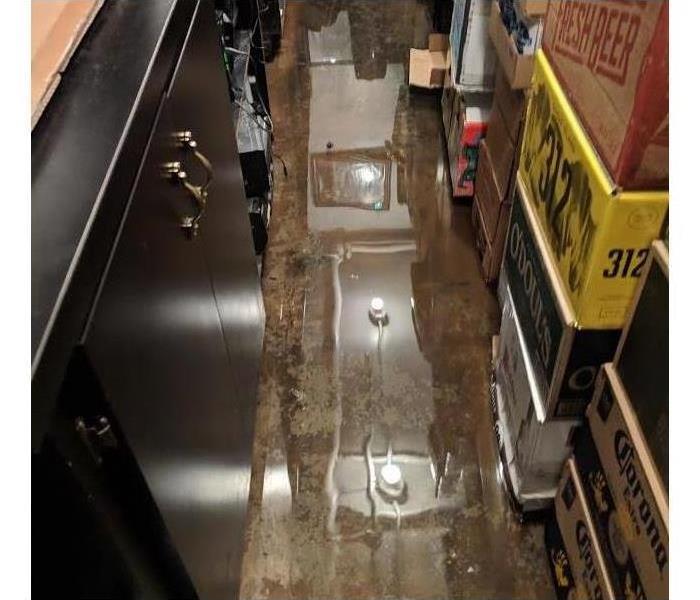 Flood damage in Arlington Heights, IL
Flood damage in Arlington Heights, IL
If your commercial property or business has suffered a loss from natural (and some man-made) disasters in Arlington Heights, IL, your actual financial loss may be tax deductible. The rules will vary based on the circumstances, but if you are armed with the right information, you can save your company a bunch of tax money at a time when it most needs it.
What Counts As Storm Damage?
If your loss was from a disaster, the IRS allows what’s called a casualty loss deduction. A casualty in federal tax law is a “sudden, unexpected, or unusual loss or damage to some property” that’s owned by your business. Additionally, the damage must be from a verifiable event, including
- Earthquakes
- Flood damage
- Hurricanes and severe storms
- Lightning
- Riots
- Tornadoes
- Volcanic eruptions
There are identifiable causes of casualty losses that won’t qualify, such as accidents, termite damage, deterioration and normal wear-and-tear. Typically, the rules covering storm damage loss are more liberal for businesses than for individuals. Also, the losses can usually be written off by businesses even if they don’t itemize.
What Are Federal Disaster Declarations?
When the federal government declares a disaster, both tax write-offs and financial assistance usually becomes much more generous. For instance, while most losses are recorded in the present tax year, a presidential disaster declaration means you can write it off retroactively, putting relief funds into your hands far more quickly. State governors can also declare disasters, although this won’t impact federal relief.
How Is the Write-Off Applied?
A few IRS publications might be used to address your storm damage losses. Publication 547 is usually key to understanding how you can write off the damage and discusses casualties, disasters and thefts, while Form 4684 is used to file for relief. However, if the losses could be covered by insurance, the IRS will disallow your write-off.
Once you’ve experienced a loss from a disaster in Arlington Heights, IL, call a professional storm cleanup company for immediate mitigation of further damage. When the situation has been stabilized, they’ll begin the process of cleanup and restoration so you can return to normal operations and put it all behind you.
Replacing Your Toilet Is As Easy As 1-2-3
10/18/2019 (Permalink)
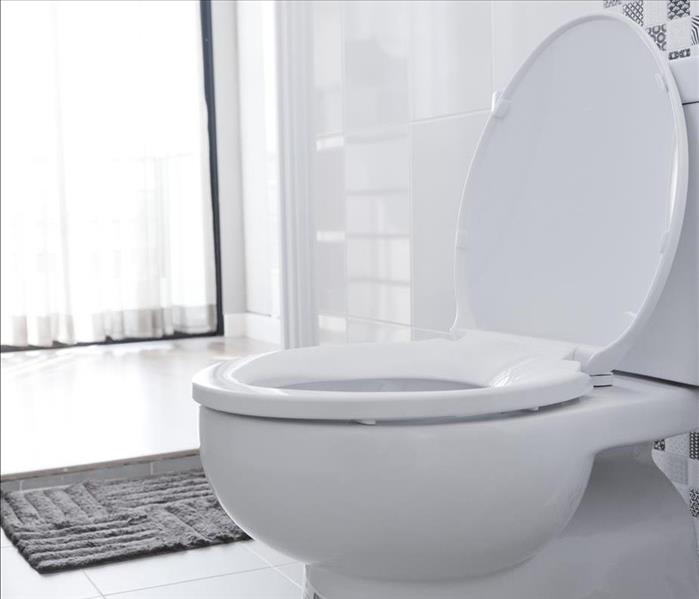 Replacing a leaking toilet in Prospect Heights, IL, isn't as big of a deal as you may think it is
Replacing a leaking toilet in Prospect Heights, IL, isn't as big of a deal as you may think it is
Replacing Your Toilet Is As Easy As 1-2-3
Replacing a leaking toilet in Prospect Heights, IL, isn't as big of a deal as you may think it is. Turns out, you probably don't even have to call a plumber. If you have a toilet picked out and waiting at your home, why not install it yourself?
Step 1- Removal
No matter what your reason for wanting a new toilet, it's never a bad idea to update your bathroom appliances. However, before you can install it, you have to get your old toilet out of there. Here's how to go about it:
- Shut off the water to the toilet.
- Flush the toilet until all the remaining water is gone.
- Disconnect the water supply line.
- Gently rock the toilet back and forth to break the wax seal.
- Lift the toilet out and take it away.
Step 2- Preparation
If your previous leaking toilet caused water damage, you'll want to hire a water damage remediation service to take care of any problems before you install the new one. Once that's taken care of, make sure you have all the proper supplies and tools you will need: a toilet, a new wax gasket, a wrench and a screwdriver. Prepare the area by setting the wax seal on the flange where the toilet will sit. If you're also replacing the supply tube, apply pipe-joint compound to either end.
Step 3- Replacement
The final step of your toilet repair is to gently place your new porcelain throne onto the wax seal and bolts. Use your weight to push down toilet onto the gasket. Replace the washers and nuts onto the bolts holding the toilet down and tighten with a wrench. Continue you press down the toilet and tighten alternatively, until it no longer feels loose after pressing it. Lastly, reconnect the loose end of the supply line to the shut-off valve. Re-open the valve and flush the toilet to refill it.
Sometimes, you can't fix a leaking toilet. That's when you need to step up and put a new one in. Even people without much plumbing experience can do this at home with the proper guidance.
How To Create an Emergency Plan for Your Pets
10/9/2019 (Permalink)
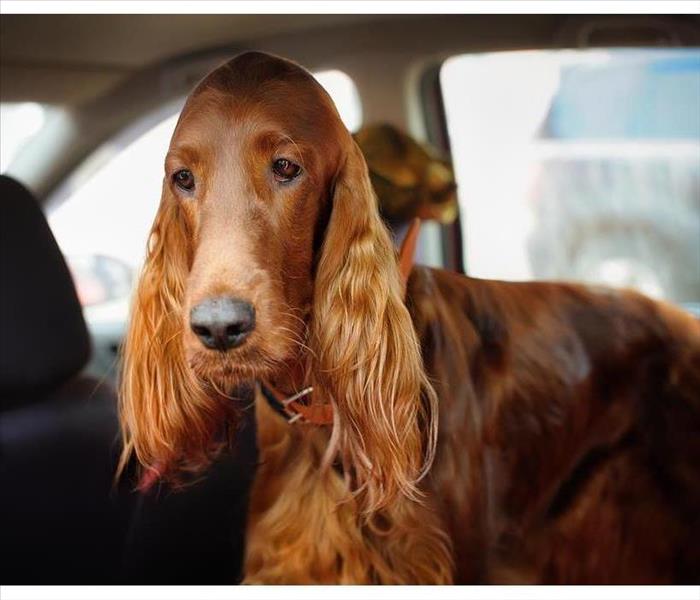 Practice evacuating in the car with your animals, so they’re more familiar if you need to evacuate in an emergency
Practice evacuating in the car with your animals, so they’re more familiar if you need to evacuate in an emergency
A fire emergency can occur at any time in Arlington Heights, IL. Thankfully, working with a fire restoration company can increase the likelihood that your home returns to normal. Of course, possessions are not the only important aspect of preparing for a fire. Pet safety should be part of your emergency plan, too. Here are a few ways to get started.
Have an Evacuation Plan
Draft an escape plan for your family and include your pets in it. Emergency pet preparation for some animals may involve teaching them to come when called. If you must leave the home in a hurry, your pets will be trained to know what to do and where to go. Practice taking your pets with you during your family fire drill and teach them to respond to commands. For pets that are skittish, have a carrier that you can easily put them in.
Keep Important Documents Together
Have proof of pet ownership with you. This can make it easier to find them in the event that they go missing while also proving that you own them. When putting together a pet safety kit, include the following as well:
- A picture of your pet
- License records
- Vaccination records
Keeping everything in one safe area can eliminate worry and help you feel prepared in a fire emergency.
Alert First Responders
One way to assist first responders is by putting a sticker on your door alerting them there are pets in the house. These stickers usually allow you to state how many dogs and how many cats you have. When firefighters and other first responders see it, they can try to rescue the animals if possible.
Protecting your pets in case of a fire emergency can ensure your family stays together. By developing a pet safety plan, you can feel confident that even if this type of situation arises, you’ll be prepared and know what to do.
Shower Mold Prevention and Removal Tips
9/26/2019 (Permalink)
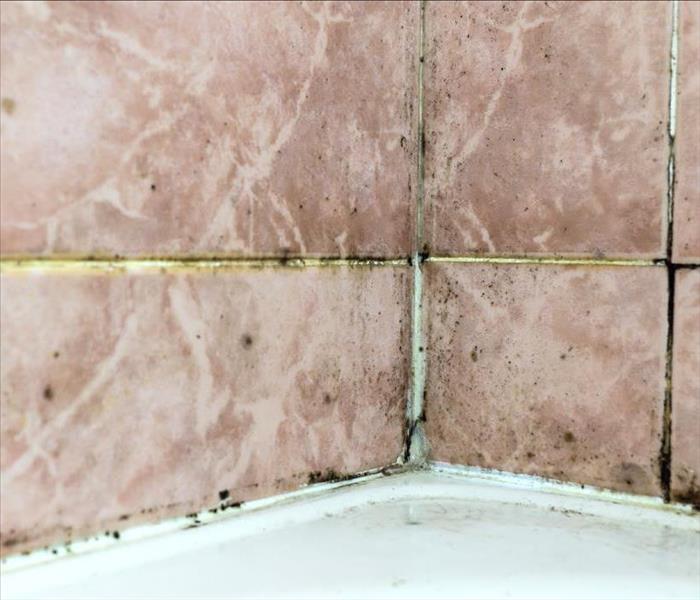 Mold found in shower
Mold found in shower
Shower mold is a common problem for homeowners. Mold spores can exist almost everywhere and can grow rapidly when exposed to the warm, humid, damp conditions of a bathroom. The good news is, there are effective ways to remove mold and prevent it from coming back.
Preventing Mold in Your Shower
A good mold prevention routine can help reduce your chances of a mold problem or prevent an existing issue from recurring.
Here are five tips you can try to reduce your chances of shower mold:
- Reduce the humidity level in your bathroom by running ventilation fans, leaving the door open or opening your bathroom window whenever you are running the shower.
- Repair anything that is leaking water in your bathroom, including leaky faucets, ceiling leaks or leaky windows.
- Avoid standing water in your tub or sink. If your drains are draining slowly, consider cleaning them or calling a plumber.
- Regularly clean your bathroom with anti-mold cleaning products. You should pay special attention to items that are particularly vulnerable to becoming moldy, such as non-slip tub mats and shower curtains.
- Wipe wet surfaces, such as your shower doors and tub, dry after use.
Removing Mold From Your Shower
Attempting to remove black mold yourself can be a dicey proposition. Disturbing mold can cause the spores to spread to the air and be distributed throughout your home, which can lead to a bigger mold problem than you started with.
Another issue with do-it-yourself mold solutions is that some cleaning products remove mold stains, but may not remove all the mold spores, which can lead to mold re-growth. Some cleaning products also don’t work well for non-porous surfaces or can even cause damage to your property. For these reasons, it may be wise to contact a mold remediation specialist in Prospect Heights, IL.
Implementing these tips can help you avoid shower mold or prevent mold from returning. If you’ve already got mold growth, contacting a remediation specialist may be the best way to help you solve the problem.
3 Steps To Dry a Flooded Furnace
9/26/2019 (Permalink)
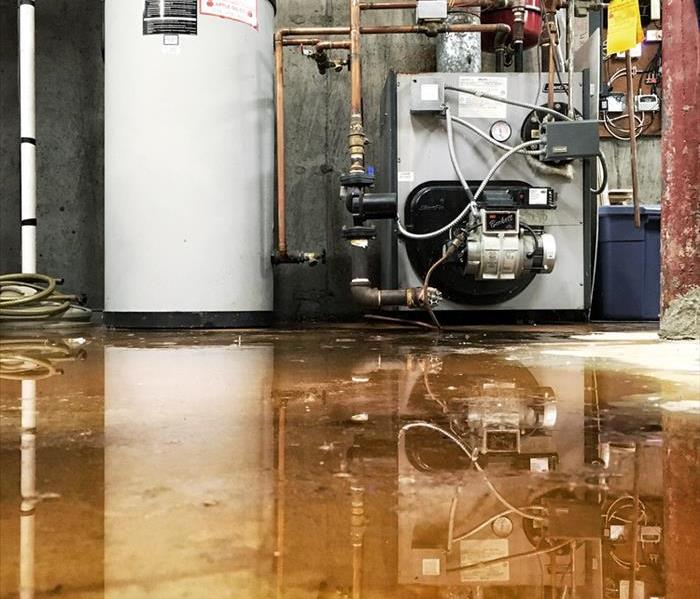 Flooded furnace in an Arlington Heights, IL home
Flooded furnace in an Arlington Heights, IL home
3 Steps To Dry a Flooded Furnace
Commercial property owners that have experienced a furnace flood know how disastrous this water damage can be. The risk of furnace flooding is higher during the winter, as pipes with are more prone to breakage due to pressure buildup around frozen blockages. If a flood or pipe break fills a furnace with water, these three steps can resolve the situation.
Stop the Water Source
If a broken pipe is leaking into a furnace, the top priorities include stopping the flow of electricity or gas to the appliance and resolving the plumbing problem as quickly as possible. Contact a plumber as soon as you see evidence that a pipe has broken. You may also want to go ahead and schedule consultations with an appliance repair specialist and a damage restoration service.
Extract Water
Even if there is no chance of restoring the function of a flooded furnace, it is necessary to extract water from the appliance and the surrounding area and promote drying. This helps to prevent primary water damage from causing structural problems and secondary damage, such as mold, from developing over the days and weeks after a furnace flood.
Replace the Furnace
Most furnaces cannot be safely operated after water damage. Natural gas furnaces contain sensitive parts critical for safety which tend to sustain irreparable damage. If replacement is necessary, consider relocating the new furnace away from areas prone to water damage. You may also want to schedule an air duct cleaning to stop any mold spores that are present from spreading throughout a structure.
A furnace flood usually necessitates furnace replacement. If the first commercial appliance service that you contact offers to repair parts following major damage, you may want to seek second or third opinions. Refurbished furnace components may be more likely to result in fires or other costly damage to a building located in Arlington Heights, IL.
4 Tips To Flood-Proof Your Home
9/10/2019 (Permalink)
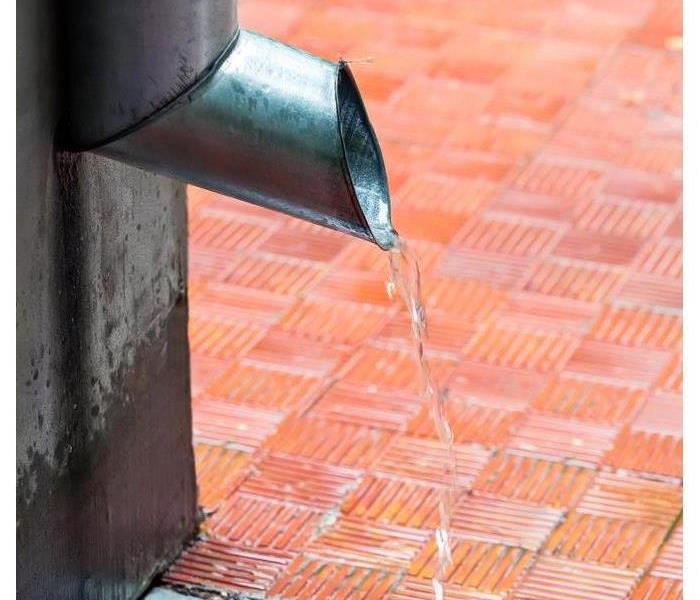 Making sure downspouts and drains are not clogged can help with water runoff in the event of a flood
Making sure downspouts and drains are not clogged can help with water runoff in the event of a flood
Safety Tips For Homeowners To Protect Their Homes
As a homeowner, safeguarding your home against natural disasters is paramount, and flood safety should be a priority. Flooding is not only the most common natural disaster in the U.S., it’s also one of the costliest weather-related disasters. Flooding is estimated to have caused over $260 billion in damage between 1980 and 2013. Homeowners in Arlington Heights, IL, will especially benefit from these safety tips to protect their homes.
1. Reconsider renovations. For example, if your driveway needs to be repaved, consider installing porous paving to help slow down water runoff. If you’re springing for a new lawn, make sure to grade it away from the house so as to direct water flow into the street gutter and not your home.
2. Maintain upkeep. You can flood proof your home by doing simple maintenance upkeep such as checking pipe valves and ensuring gutters are clear to prevent ice dams. Making sure downspouts and drains are not clogged can help with water runoff in the event of a flood, or even heavy rainfall.
3. Prioritize cleanup. Almost as important as protecting your home for flood safety is post-flood follow-up. To avoid water damage and mold, seek water-damage repair experts immediately. You won’t be the only one seeking help after such a natural disaster, so be sure to act early.
4. Reorganize clutter. Move any electronics, expensive rugs and furniture to upper levels if possible. If it’s not, simply raise them off the floor. Elevating major appliances onto sturdy materials such as concrete blocks can be helpful as well. Make sure things such as sockets and switches, as well as circuit breakers, are at least a foot above the estimated flood level for the area.
Make flood safety a key priority when you purchase or renovate a home. Being better prepared for such natural disasters ahead of time will often be more effective than trying to belatedly deal with the aftermath.
The Aftermath of Bursting Pipes
8/27/2019 (Permalink)
 Burst pipe in a Prospect Height, IL home
Burst pipe in a Prospect Height, IL home
Dealing with water damage in Prospect Heights, IL, can be a homeowner’s nightmare. When it’s cold outside, water can freeze and expand, leading to bursting pipes and a flooded home. Cleanup can be expensive. Thankfully, homeowner’s insurance can help with the financial burden, and there are a few things you can do to help make the process easier.
Emergency Repairs
In general, you want to wait for your homeowner’s insurance company to approve your claim before you start the main cleanup process or attempt to fix the broken pipe. However, there are a few simple things you can do to help prevent further damage:
- Remove excessive water.
- Turn off the water supply to your home.
- Take valuable items that have not been damaged and move them to a safer location.
Check Your Policy
Homeowner’s insurance policies can vary widely when it comes to what is covered. For example, your policy may include damage from bursting pipes but not from a washing machine that malfunctioned. Your best bet is to read your policy yourself so you are aware of what your coverage is.
Have Proper Documentation
Documentation is a crucial step when you are making a water claim. Consider taking photographs and video when necessary to show the extent of the damage. A photo of the room from before the damage occurred can also be helpful if you have one handy. Be sure to include any receipts you have for items that have been damaged or destroyed. If, during your emergency repairs, you had to rent equipment or buy any supplies, keep track of your receipts so you can be reimbursed for them. Any documentation you can provide will likely help with the claim process.
These things can help make the process of your water damage repair from bursting pipes go more smoothly. Emergency repairs can prevent further damage, knowledge of your policy prevents misunderstandings, and documentation should help with the claim process. Hopefully, you will be able to have the damage repaired quickly and have life return to normal.
Types of Tax Deductible Storm Losses
8/20/2019 (Permalink)
 Storm damage in Arlington Heights, IL
Storm damage in Arlington Heights, IL
Four Fundamental Areas of Storm Loss
Commercial properties are expensive to maintain and even more expensive to repair. When seasonal storms kick up and create significant losses for businesses, it can leave many owners looking for relief. Thankfully, when tax season rolls around, storm damage might actually be tax deductible. However, that depends on a couple of factors. First, do you have commercial insurance? Second, did you use your policy to make a claim? If you didn't, then you will not be able to make a deduction for losses accrued, but if you did, then you should have no problem come tax time. However, you will still need to understand the four fundamental areas of storm loss to record and claim everything properly.
1. Wind
Wind damage can account for a lot of property loss, especially when tied to significant storms, like hurricanes and tornadoes. This type of damage can account for many losses, such as broken windows, lost shingles and sheathing as well as damages to property landscaping.
2. Water
The most common form of storm damage tends to relate to water losses. Flooding and excessive rainfall can lead to significant issues, from foundational problems to roof leaks and more. While not every area requires flood insurance, it is a wise purchase for those businesses at risk to help offset potential recovery expenses.
3. Fire
While it may seem unlikely, storms can lead to building fires. For example, flooding can lead to electrical disturbances, which can spark a fire. Also, and more commonly, lightning strikes can cause sudden rooftop blazes.
4. Restoration
After storms have settled and the damages assessed, you will need to contact your insurer and a storm restoration specialist in the Arlington Heights, IL, area. While you may not want to make an insurance claim for the losses you incurred during the storm, the only way to file for deductions is to use your insurance policy first. Then, you can file deductions for the percentage of the recovery and restoration you actually paid for.
Storm damage can be expansive and costly to mitigate. However, if you file a claim and call for assistance, you can recover some losses through deductions.
What You Should Know About Burn First Aid
8/13/2019 (Permalink)
Though many business owners in Prospect Heights, IL, believe that is important to prepare for the effects of fire damage, learning about burn first aid can be intimidating. However, it's often wise to learn about basic aid when preparing for a fire.
What Are Common Causes of Burns?
People can acquire burns on any part of their bodies, though minor burns often occur on a person's hands, arms, legs or feet, especially if a person's skin is exposed. Common causes of burns in businesses include:
- Grease or oil splashing on the skin
- Fire touching the skin
- Steam or hot liquid making contact with the skin
- Touching hot pans, pots or other materials
What Are the Symptoms of a Minor Burn?
In addition to knowing the causes of a minor burn, it can also be useful to know what symptoms of burns to look out for after fire damage has affected your property. A minor burn is considered to be a burn that covers only a small area of the skin. Common symptoms of a minor burn can include:
- Small blisters
- Pain
- Redness on the skin that is similar to redness that appears after a sunburn
- Slight swelling
How Are Burns Treated?
After a fire, it can be helpful to know how to appropriately provide first aid to someone with a minor burn. Running cool water, not cold water, over a burn is often useful. Covering a minor burn with a clean bandage can also help to treat the burn. If you are in your building when there is an active fire, it's also helpful to remember that your business can be restored by emergency restoration services, and it's usually best to leave your building quickly and help to treat others once you are outside of the building in order to prevent further injuries.
In addition to taking steps to protect your business from fire damage, it can be useful to learn about burn first aid. Knowing common causes of burns, symptoms of minor burns and how to treat minor burns can help you feel more confident in your ability to help yourself and others if a fire occurs in your business.
Vulnerable Areas of Your Property in a Winter Storm
7/24/2019 (Permalink)
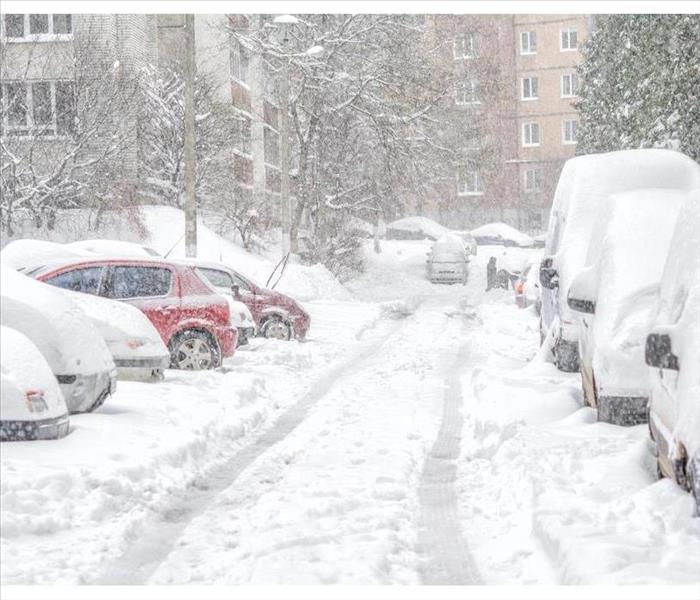 Winter storm in Prospect Heights, IL
Winter storm in Prospect Heights, IL
Vulnerable Areas of Your Property in a Winter Storm
The damage that can occur due to a winter storm can be obvious at times, but at other times, it can be subtle. You may not notice it at first unless you are specifically looking for it. If you do have storm damage, you have only a limited time to file an insurance claim, so it is best to inspect your residential property in Prospect Heights, IL, and file any necessary claims as soon as you can.
Specific areas of vulnerability around your property include the following:
- Trees
- Gutters and siding
- Roof
You should inspect these areas carefully as soon as possible after a storm.
Trees
Overgrown tree limbs can break due to the high winds, heavy snows, and ice buildup that often accompany a blizzard. A fallen tree limb can cause damage to your roof, your vehicle, and anyone who happens to be standing underneath at the time that it falls. Keep in mind, however, that a tree limb may break off during a storm but not fall for some months afterward. Therefore, it is best to be proactive in inspecting trees for damage and having broken limbs removed.
Gutters and Siding
The exterior of your home is built to stand up to a lot of punishment from the weather. Nevertheless, factors present during a winter storm, such as ice, moisture, and high winds, can strip the siding or gutters from your home. Be sure to inspect any possible damage, and be sure to have any missing structures replaced as soon as possible. Missing gutters or siding leave your home vulnerable to water damage.
Roof
Roof damage from a storm can be dramatic, such as a cave-in from a broken tree limb, or subtle, such as missing shingles or roof tiles. Either way, the damage needs to be assessed and repaired as soon as possible.
It can be tempting to put off dealing with damage from a winter storm until spring, but that may only make matters worse. If you feel overwhelmed, don't hesitate to enlist the help of a storm damage restoration company.
What You Need To Know About Mold in the HVAC Unit
7/24/2019 (Permalink)
 Clean ducts are mold-free ducts
Clean ducts are mold-free ducts
If you’ve been noticing the smell of mold in your building, but can’t seem to find evidence of black mold anywhere, your HVAC unit could be the culprit. Mold spores naturally exist indoors and out, but in closed office spaces, where the windows rarely open, the spores may collect in the HVAC unit and emit the smell throughout the space.
The Cause of Mold Infestation
Many people may not think of air ducts as the ideal place for mold to hang out, because it shoots out a lot of cold air during the warmer months. However, condensation may form in the unit as it pushes out cold air, which creates a haven for black mold. The mold then gets nutrients from particles in the air that cycle through the HVAC from the office. These include:
- Animal dander
- Indoor dust
- Pollen
Signs of Mold in the HVAC Unit
Because you may not be able to see the mold in the HVAC unit, it may be difficult to tell if mold is the problem without a professional mold inspection. Even so, you may be able to detect mold by the strong mildew smell. People who are sensitive to mold may also suddenly find that they feel most comfortable outside or when windows are open.
Cleaning the Ducts
Clean ducts are mold-free ducts, even though you may need to do this routinely to maintain it. When professionals clean air ducts, they use a biocide that is safe for people to breathe in. Even so, it may be best to schedule a cleaning during days when business is not in operation as the air may need to be turned off during cleaning.
Black mold is a stubborn problem faced by many buildings in Arlington Heights, IL. While there is no foolproof way to prevent in, many property managers and business owners remedy the problem through routine air duct cleanings and using HEPA filters.
Cleaning Your Commercial Air Ducts is Important
7/22/2019 (Permalink)
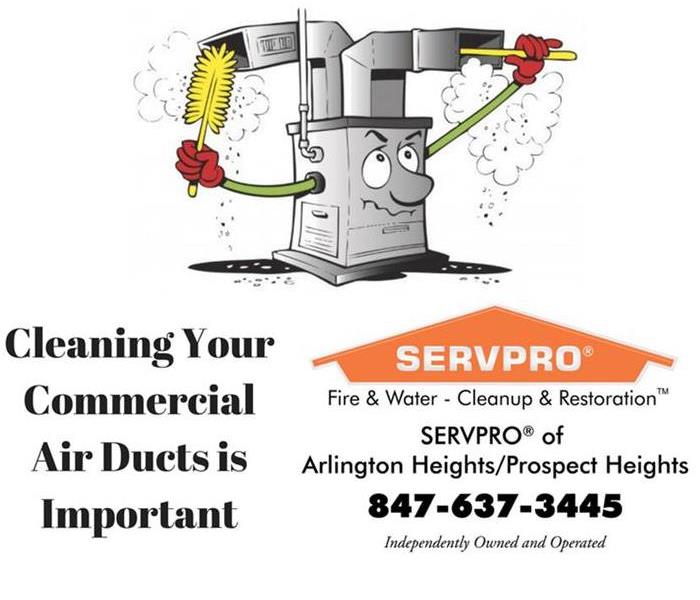 Call SERVPRO of Arlington Height/ Prospect Heights for Air Ducts and HVAC Cleaning.
Call SERVPRO of Arlington Height/ Prospect Heights for Air Ducts and HVAC Cleaning.
3 Reasons To Clean Your Commecial Air Ducts.
Air Duct Cleaning Improves the Quality of Indoor Air
By routinely having your air ducts cleaned you can significantly decrease the amount of airborne molecules in your office, all while avoiding weighty fees for other air purifying solutions. Air ducts, like everything else in our office, collect dirt and debris. While filters may catch a lot of streaming debris, there is still a considerable amount of dust that settles within the ducts.
Air Duct Cleaning Conserves Energy
Air duct cleaning provides a beginning in optimizing your duct function while providing the opportunity for other issues to be assessed. A properly and thoroughly cleaned HVAC system, not just the air ducts, can reduce the costs associated with running your HVAC system and increase the useful life of your air conditioner and furnace. EPA research suggests that cleaning dirty cooling coils, fans and heat exchangers can improve the efficiency of cooling and heating systems and lower the energy costs of running your heating and cooling system. In administering frequent commercial air duct cleanings, all parts of your HVAC system will be refreshed. This will allow your systems to work better, faster, and more efficiently, all while using less energy!
Air Duct Cleaning Will Save You Money
Having your air ducts regularly serviced lower your energy bill, but it will also prolong the life of your HVAC system. Energy Star estimates indicate that you can improve the efficiency of your HVAC system by 20 percent or more simply by cleaning your ducts.
If you are looking for commercial duct cleaning, please give SERVPRO of Arlington Heights/Prospect Heights a call at 847-637-3445, and let us help save your company money.
Storm Safety For Your Commercial Property
7/22/2019 (Permalink)
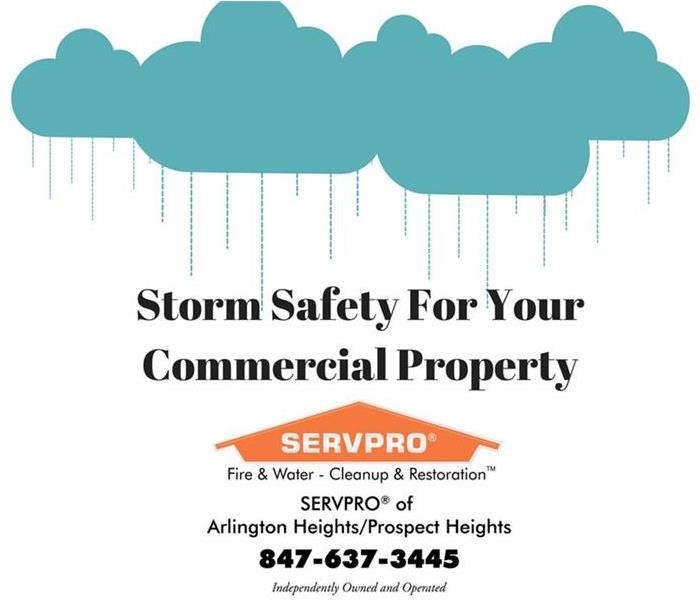 SERVPRO of Arlington Heights/ Prospect Heights can help you with commercial storm safety.
SERVPRO of Arlington Heights/ Prospect Heights can help you with commercial storm safety.
Severe weather is a serious threat and one that can often happen with little warning. It’s important to be thorough and proactive to ensure your business is protected.
Commercial Storm Safety
As we start to enter storm season, it is important to take some time and inspect your commercial property to assess and identify any maintenance that can be performed to further reduce the risk of damage in the case of a storm.
Some of these maintenance items may be:
- Cutting all tree branches away from the building
- Weather proofing windows
- Making sure that all your emergency signs are visible and in good working order.
Generators
Another way to ensure your property is storm ready is to check your generators for the building. This is exceptionally important for medical facilities, rehab facilities, and nursing homes who rely on the generator for life saving medication dispensing and to operate machines. Making sure you have enough power to maintain the facility for at least a minimum of three days is what FEMA recommends.
Communicate with tenants
It is also essential to communicate with your tenants of the property. Making sure that you and your tenants have an emergency readiness plan in the event of an emergency is vital not only to assist keeping your tenant up and running, but for the safety of the building.
Nearly 40% of small businesses close after a disaster, according to the Federal Emergency Management Agency. 52% of small businesses say it would take at least three months to recovery from a disaster, according to a 2015 survey of 500 small business owners conducted by Nationwide. Only 25% of businesses that close due to a major disaster ever reopen, according to the Institute for Business & Home Safety.
SERVPRO of Arlington Heights/Prospect Heights offers a free Emergency Ready Plan that we can assist all of the tenants of your commercial property where one call to our office and we have all the necessary information to begin a quick clean up and get your building back to full working order. To get more information on our Emergency Readiness Plan, give us a call at (847) 637-3445.
How To Properly Clean a Lint Trap
7/17/2019 (Permalink)
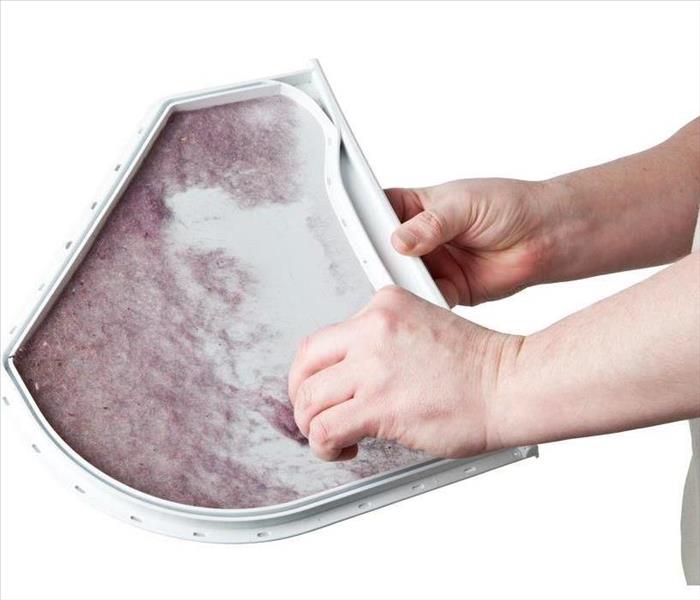 Cleaning a lint trap
Cleaning a lint trap
Tips on Cleaning Your Dryer Vent and Lint Trap
Many homeowners in Arlington Heights, IL, would be surprised to know easily a dryer lint trap can be clogged and turn into a lint fire. Almost three thousand homes a year experience fire damage caused by such a buildup. Here are some tips to properly clean your dryer vent and lint trap.
1. Clean It Every Time
You have probably been told to clean the lint trap before every load, but you may not know why. Lint is highly combustible. Therefore, if a dryer overheats from improper ventilation, a small spark can turn into a lint fire with major damage and a need to call a fire restoration company.
2. Remove All Debris
When cleaning the lint trap, make sure you get each small piece of debris left behind. Every few weeks, it’s a good idea to also run it under water and even use a bit of hand soap on the screen. Be gentle so that you don’t damage the screen or change its shape, and always dry it fully before putting it back.
3. Check the Dryer
It’s important to fully clean the dryer vent as well while the lint trap is out. Particularly if you notice any debris, it’s a good idea to periodically take a vacuum hose and suck out any loose material. This helps clear out clogs and can be done from the outside vent as well.
4. Determine Whether a Deeper Clean is Warranted
If you have signs of a clog, such as clothes no longer drying fully or a very hot dryer when running, you should do a deeper clean to prevent a dryer fire. You can buy a vent cleaning rod at a hardware store to feed it entirely through the vent and push out any excess lint.
Routine maintenance and cleaning will prevent a lint fire from occurring in your dryer. Make sure you clean the lint trap during each load and perform a deeper vent clean every few months. You will have peace of mind knowing that your dryer is running safely.
Smoke and Soot Facts
6/28/2019 (Permalink)
Smoke and soot is very invasive and can penetrate various cavities within your home, causing hidden damage and odor. Our smoke damage expertise and experience allows us to inspect and accurately assess the extent of the damage to develop a comprehensive plan of action.
Smoke and soot facts:
- Hot smoke migrates to cooler areas and upper levels of a structure.
- Smoke flows around plumbing systems, seeping through the holes used by pipes to go from floor to floor.
- The type of smoke may greatly affect the restoration process.
Different Types of Smoke
There are two different types of smoke–wet and dry. As a result, there are different types of soot residue after a fire. Before restoration begins, SERVPRO of Arlington Heights/Prospect Heights will test the soot to determine which type of smoke damage occurred. The cleaning procedures will then be based on the information identified during pretesting. Here is some additional information:
Wet Smoke – Plastic and Rubber
- Low heat, smoldering, pungent odor, sticky, smeary. Smoke webs are more difficult to clean.
Dry Smoke – Paper and Wood
- Fast burning, high temperatures, heat rises therefore smoke rises.
Protein Fire Residue – Produced by evaporation of material rather than from a fire
- Virtually invisible, discolors paints and varnishes, extreme pungent odor.
Our Fire Damage Restoration Services
Since each smoke and fire damage situation is a little different, each one requires a unique solution tailored for the specific conditions. SERVPRO of Arlington Heights/Prospect Heights has the equipment, expertise, and experience to restore your fire and smoke damage. We will also treat your family with empathy and respect and your property with care.
Have Questions about Fire, Smoke, or Soot Damage?
Call Us Today – (847) 637-3445
When Storms Hit, SERVPRO Is Ready.
6/28/2019 (Permalink)
When a major storm hits, it may overwhelm local restoration companies. SERVPRO of Arlington Heights/Prospect Heights can scale our resources by accessing the equipment and personnel of 1,700 Franchises. We can also access Disaster Recovery Teams that specialize in major storms and catastrophic events.
SERVPRO of Arlington Heights/Prospect Heights specializes in storm and flood damage restoration. Our crews are highly trained and we use specialized equipment to restore your property to its pre-storm condition.
Faster Response
Since we are locally owned and operated, we are able to respond quicker with the right resources, which is extremely important. A fast response lessens the damage, limits further damage, and reduces the restoration cost.
Resources to Handle Floods and Storms
When storms hit the Prospect Heights land area, we can scale our resources to handle a large storm or flooding disaster. We can access equipment and personnel from a network of 1,650 Franchises across the country and elite Disaster Recovery Teams that are strategically located throughout the United States.
Have Storm or Flood Damage? Call Us Today 847-637-3445
Basement Flood? We Can Help!
6/28/2019 (Permalink)
A basement can flood at any time, although flooding most often occurs during heavy rainfall. Basements are inherently prone to flooding because they are the lowest level of a building and are normally built partly or entirely below ground level. There are a number of reasons why your basement could flood, including:
- A blocked or failed sewer lateral pipe
- Heavy rain causes surface water to pool around your home
- Storm sewer backup
- Sanitary sewer backup
- Foundation drainage failure
- Water supply-line break or hot-water tank failure
- And many more
Have Questions about Basement Flooding?
Call Today - (847) 637-3445
If flood water is not handled quickly and properly, it can jeopardize your health and safety, and cause severe damage to your home’s structure. Remember, the longer you wait, the worse the problem will get.
The bottom line: a flooded basement can jeopardize your health, safety, and your home’s integrity. It’s worth making a call to SERVPRO of Arlington Heights/Prospect Heights and let our trained, professional crews handle the situation safely and correctly. We have earned the trust of hundreds of homeowners, business owners, and property professionals.
We are Flooded Basement Specialists:
- We are Available 24 hours/7 days per week
- We’re a Preferred Vendor to many National Insurance Companies
- We Bill The Insurance Directly – One Less Thing For You To Worry About
- Our Technicians are Highly-Trained in Water Restoration Techniques
- We use s500 IICRC Restoration Standards
- Advanced Inspection and Extraction Equipment
Basement Flooded? Call SERVPRO of Arlington Heights/Prospect Heights Today – We’re Ready To Help (847) 637-3445.
3 Things to Do About Roof Damage After a Fire
6/25/2019 (Permalink)
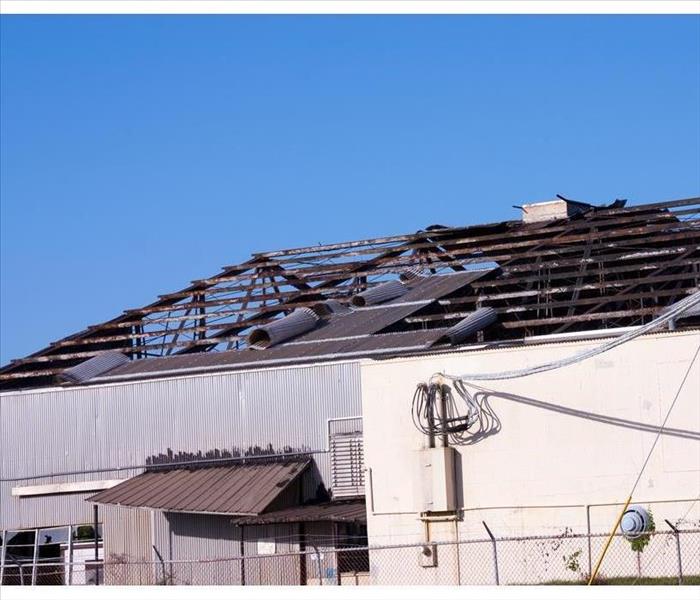 Roof damage in a commercial building in Prospect Heights, IL
Roof damage in a commercial building in Prospect Heights, IL
Tips to Take Care of Damage to Your Commercial Building´s Roof
Discovering that you have roof damage during the fire cleanup process can leave you wondering how to properly address it. In order to protect your business in Prospect Heights, IL, from further damage, there are some important steps you need to take. Here are a few tips to help you take care of damage to your commercial building’s roof.
1. Make an Insurance Claim
Filing an insurance claim is a good idea if your roof has been significantly harmed as a result of fire damage. Be sure to document all signs of damage on your commercial roof in order to provide concrete evidence of the damage. Providing sufficient proof of your loss can also be useful if you plan to show the evidence to a roofing company who can help cover up the damage.
2. Have Tarp Placed on Roof
Covering up the fire damage with tarp can help protect your roof from further harm and ease your fire cleanup efforts. When you utilize tarp services, you can prevent substances such as rain and debris from seeping through your roof and causing additional damage to your building. Rain and snow in particular can cause serious water damage if they accumulate on your roof, so keep these points in mind during the roof repair process.
3. Give Your Roof the Proper Treatment
The care that your roof needs depends on what caused the damage in the first place. If the problem is residual soot, then you may need to address discoloration on your roof caused by soot particles. Have your roof inspected as soon as possible in order to determine exactly how to navigate the fire cleanup process and repair your roof.
Taking care of roof damage in Prospect Heights, IL, can be a less stressful process when you have valuable help and support. Be sure to call cleanup and restoration services to facilitate the roof repair process and have your business return to normal in no time.
4 Questions and Answers About Business Insurance
6/18/2019 (Permalink)
 My business has water damage, what do I do?
My business has water damage, what do I do?
No matter how you prepare, the unexpected will happen. This is true in your professional life as well as in your personal. However, when it comes to your Arlington Heights, IL, business and commercial properties, you can protect against unexpected trouble, such as fire or water damage, with business insurance. If you're not sure why you need this coverage and what's available, take a look at the following questions and answers:
What Can I Expect From Business Insurance Coverage?
These policies vary from one provider to another, but they are all designed to protect owners from business losses. You may get coverage for property and automobiles or insure your business against legal claims. You could get health insurance for employees or protect your property from damages related to broken pipes.
When would I need business insurance?
Small business owners often mistakenly believe they don't have enough inventory or business equipment to insure, but when broken pipes lead to water damage or when related water cleanup services are required, those owners may face financial losses in addition to the loss of property. During the time water remediation professionals are working, the small business owner may lose out on valuable income. When this happens, business interruption coverage may be crucial to the company's continued success.
What type of coverage do I need?
Some of the most common insurance claims for commercial property owners include those related to damages from water, weather, and fire. Look into business interruption insurance, property and casualty insurance, and related policies. Of course, you can prepare for other eventualities by discussing your specific business needs with an insurance agent.
How do I file a claim?
Plan ahead for any eventuality by talking to your agent before trouble happens. If an issue has already come up, contact your business insurance representative right away. You may also get help from the water damage cleanup professionals.
What You Should Know About Water Damage and Your Insurance Policy
6/11/2019 (Permalink)
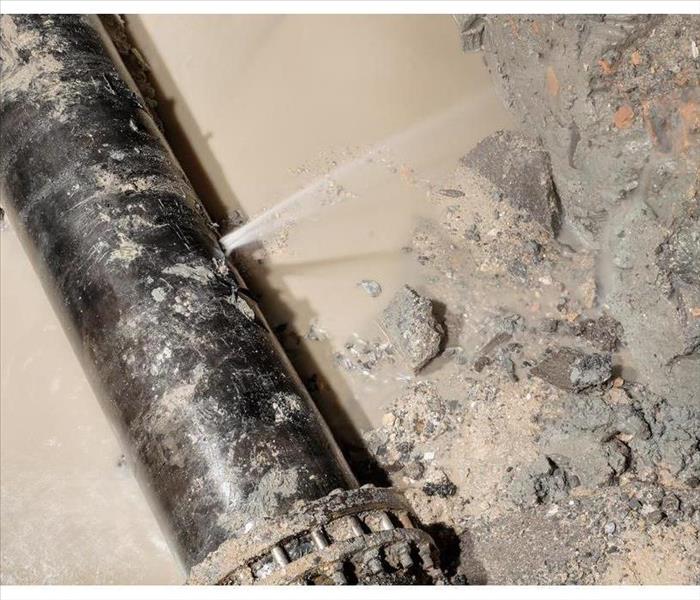 A leaky pipe will likely be covered
A leaky pipe will likely be covered
Questions You Might Have Regarding Your Policy
If a pipe breaks in your Prospect Heights, IL home and causes water to flood your home, the good news is that this will most likely be covered by your homeowners insurance. While this is usually a covered peril, however, there are some exceptions. The following are a few questions that you might have regarding your policy.
1. When is Damage Covered by Insurance?
When you experience water damage from a broken or leaky pipe, the cost of resulting damage will likely be covered. If the flood is the result of a broken pipe caused by freezing weather or a sudden accident, this will usually be included in your policy. However, you will often be required to pay for any costs related to repairing and replacing the pipe.
2. When is Damage Not Covered by Insurance?
If the insurance company believes that the pipe has broken as a result of your own negligence, then you will likely be denied insurance coverage. This can happen if you have not taken proper precautions to prevent freezing pipes during cold weather or if you have failed to maintain your home. You may also be required to pay for damages if you wait too long to contact your insurance company and the damage has worsened in the meantime.
3. What Should You Do When You Discover the Damage?
To prevent your insurance company from denying your claim, you should be sure to contact them as soon as possible. You should also hire a water damage remediation company to fix the broken pipe and do any necessary repairs in your home. While you wait for workers to arrive, you can begin documenting the damage and making temporary repairs to prevent water from spreading.
While a flood in your home can cause a lot of worry, the claims process can go more smoothly if you take the appropriate actions. Performing regular maintenance on your home can prevent problems and will make it easier to be approved for coverage if an accident does happen.
4 DIY Cleaning Hacks for a Small Mold Growth Problem in Your Home
5/29/2019 (Permalink)
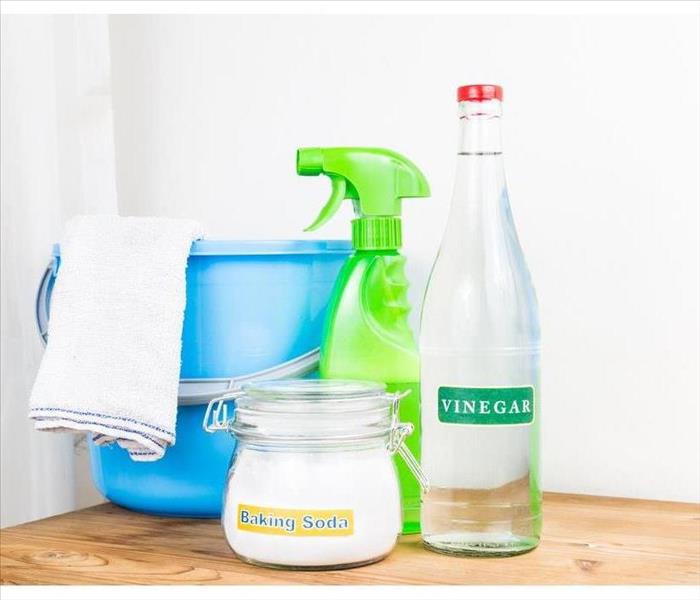 Soak fabrics in hot water and oxygen bleach
Soak fabrics in hot water and oxygen bleach
House Mold Can Be Addressed Using Four Cleaning Hacks
The sight of mold in your home in Prospect Heights, IL, might make you want to pack up your bags and leave for good, but a small amount of mold growth is no cause for alarm. A widespread, severe mold issue can cause extensive damage to your home and needs to be remediated with the help of a mold cleaning company. However, a minor house mold issue detected early can be addressed using the following four cleaning hacks.
1. Scrub Hard Surfaces With White Vinegar and Baking Soda
Vinegar is a very effective natural mold removal solution due to its acidic properties that break down and kill most species of mold. Baking soda, another non-toxic ingredient, absorbs moisture, removes odors, and kills mold. Spray vinegar and baking soda solution and scrub any surfaces that has mold.
2. Soak Fabrics in Hot Water and Oxygen Bleach
Fabrics such as clothes, linens or upholstered furniture that remain damp for an extended period time can house moisture-seeking mold. If you can visibly see mold on the fabric, first scrub it off when a brush. Next, soak the fabric in very hot water and oxygen bleach.
3. Lightly Wipe Paper with Hydrogen Peroxide
House mold on books and paper can be tricky to clean. First, ensure the paper is completely dry. Next, use a soft paintbrush to brush away any mold you see. Wet a cloth towel with a small amount of hydrogen peroxide, lightly wipe the paper, and allow the page to dry.
4. Clean Tile With Chlorine Bleach and Water
If mold has made its way into the grout of your tile floors, you’ll need some chlorine bleach and water. Mix one cup of bleach with a gallon of water and mop it onto your floors. Let it sit for 15 minutes and then scrub.
Rid your home of house mold with these four cleaning hacks! If the problem is bigger than you suspected, don’t hesitate to call in a professional mold remediation company.
Restoring Your Commercial Property After A Water Event
5/27/2019 (Permalink)
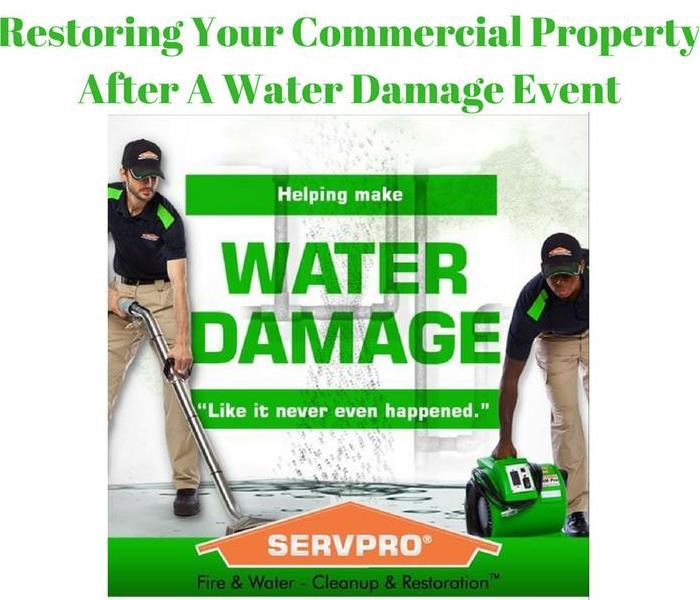 SERVPRO of Arlington Heights/ Prospect Heights has the training and equipment to restore your commercial property after a water event.
SERVPRO of Arlington Heights/ Prospect Heights has the training and equipment to restore your commercial property after a water event.
Flooding and water damage events at SERVPRO of Arlington Heights/Prospect Heights and the surrounding area commercial properties are often complex with numerous issues that require a knowledgeable and flexible response. Whether we’re dealing with a relatively small water cleanup scenario or a large scale event, we work quickly to assess each unique situation and isolate the damaged area. In many instances, normal operations can continue in a temporary space while we restore your facility.
Restoring Commercial Properties
Our professionals are trained to be mindful of legal and environmental concerns and strive to fully restore the damaged area while working within your budgetary constraints. We understand that every hour spent cleaning up is an hour of lost revenue and productivity. So when an emergency situation arises in your business, give us a call and we’ll be there fast with the help you need.
About SERVPRO of Arlington Heights/ Prospect Heights
SERVPRO of Arlington Heights/Prospect Heights specializes in the cleanup and restoration of commercial and residential property after a water damage event. Our staff is highly trained in property damage restoration. From initial and ongoing training at SERVPRO’s corporate training facility to regular IICRC-industry certification, rest assured our staff is equipped with the knowledge to restore your property.
Air Duct Cleaning For Your Commercial Property
5/27/2019 (Permalink)
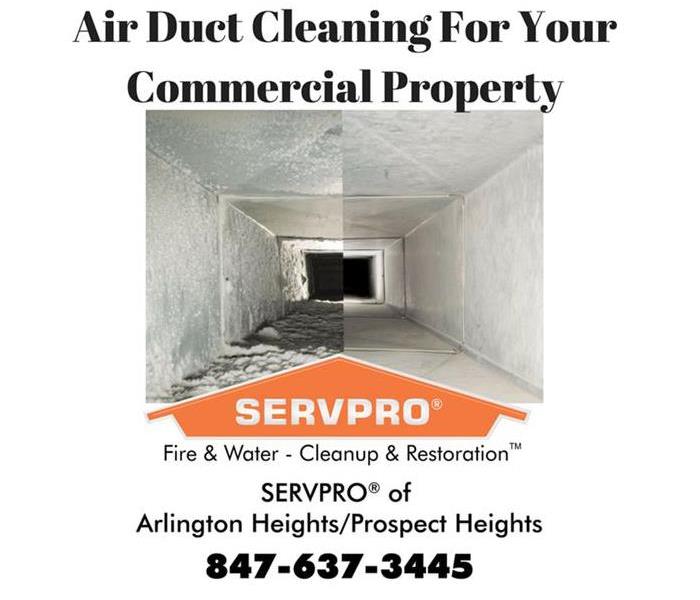 SERVPRO of Arlington Heights/ Prospect Heights has the training and equipment necessary to keep your commercial air ducts clean.
SERVPRO of Arlington Heights/ Prospect Heights has the training and equipment necessary to keep your commercial air ducts clean.
Benefits of Air Duct Cleaning
Air Duct Cleaning Improves the Quality of Indoor Air
By routinely having your air ducts cleaned you can significantly decrease the amount of airborne molecules in your office, all while avoiding weighty fees for other air purifying solutions. Air ducts, like everything else in our office, collect dirt and debris. While filters may catch a lot of streaming debris, there is still a considerable amount of dust that settles within the ducts.
Air Duct Cleaning Conserves Energy
Air duct cleaning provides a beginning in optimizing your duct function while providing the opportunity for other issues to be assessed. A properly and thoroughly cleaned HVAC system, not just the air ducts, can reduce the costs associated with running your HVAC system and increase the useful life of your air conditioner and furnace. EPA research suggests that cleaning dirty cooling coils, fans and heat exchangers can improve the efficiency of cooling and heating systems and lower the energy costs of running your heating and cooling system. In administering frequent commercial air duct cleanings, all parts of your HVAC system will be refreshed. This will allow your systems to work better, faster, and more efficiently, all while using less energy!
Air Duct Cleaning Will Save You Money
Having your air ducts regularly serviced lower your energy bill, but it will also prolong the life of your HVAC system. Energy Star estimates indicate that you can improve the efficiency of your HVAC system by 20 percent or more simply by cleaning your ducts.
According to the NACDA—The HVAC Inspection, Maintenance, and Restoration Association, “if your ducts look dirty, they probably are.” By conducting routine air duct cleanings, you will be able to fully inspect your air ducts for leaks, HVAC effectiveness, and overall indoor air quality.
If you are looking for commercial duct cleaning, please give us a call at (847) 637-3445 and let us help save your company money.
Water damaged home in Prospect Heights
5/27/2019 (Permalink)
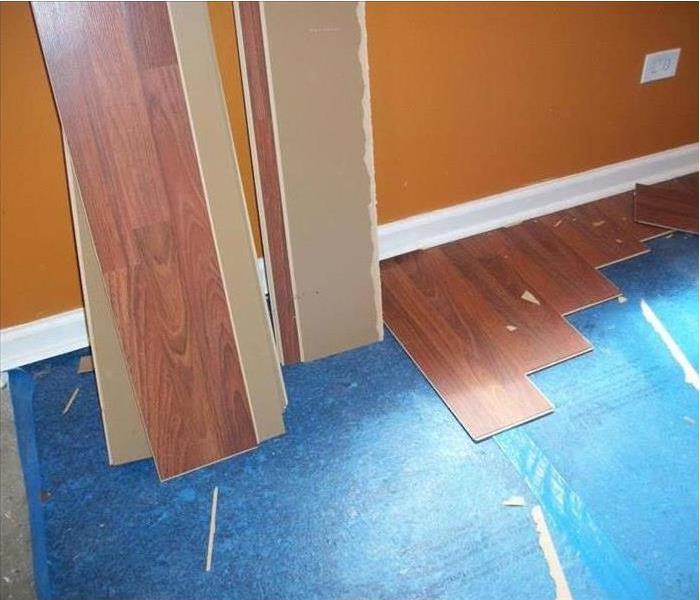 Water Damage in a basement in Prospect Heights, IL.
Water Damage in a basement in Prospect Heights, IL.
Water Damage
SERVPRO of Arlington Heights/ Prospect Heights specializes in the cleanup of flooded basements and any damage caused by water in your home.
We were recently called out to help with the cleanup of this flooded basement in Prospect Heights, IL. As a result of the flooding, our technicians needed to pull all of the flooring out as it was badly affected by the water.
If you are a home owner, a business owner or a property manager that experiences a water damage due to heavy rain, a burst pipe or any other reason, why not give our office a call at (847) 637-3445 to help with the clean up?
SERVPRO of Arlington Heights/Prospect Heights has the experience and the know how to perform the necessary clean up and to make your situation seem “Like it never even happened.” Browse our website for more details on our other types of services.
Spring showers are coming..!
5/27/2019 (Permalink)
 Spring showers are coming and SERVPRO of Arlington Heights/ Prospect Heights is here to help you.
Spring showers are coming and SERVPRO of Arlington Heights/ Prospect Heights is here to help you.
Will you be prepared if those Spring showers not only bring you lovely flowers but also bring you an unwanted flooded home or place of business??
Water Damage or Flooded Properties
SERVPRO of Arlington Heights/Prospect Heights is a trusted leader in the Water Restoration industry and has got you covered!
We specialize in the cleanup of flooded properties so why not give our office a call should this occur, we are available 24 hours a day and 7 days a week!
We'll clean it up and make it seem "Like it never even happened."
Selecting a Fire Extinguisher for Your Home
5/17/2019 (Permalink)
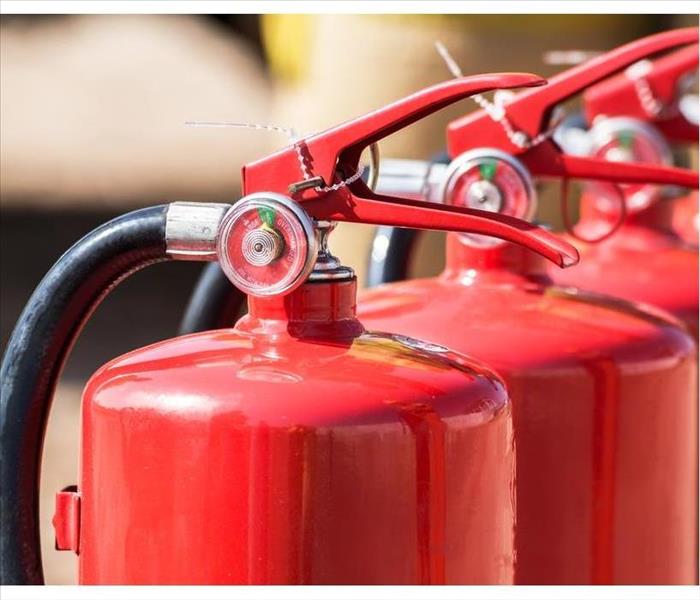 Place an extinguisher in the places most likely to have a fire
Place an extinguisher in the places most likely to have a fire
Selecting a Fire Extinguisher for Your Home
At least one portable fire extinguisher should be in any home. However, the amount will typically vary depending on the size and number of stories to your home. Regardless, the selection of an extinguisher is vital because some will help with certain fires and hurt with others. Therefore, it is crucial to understand the considerations that go into an extinguisher selection before purchase.
1. Location
A home fire is a terrifying thing, but the proper placement of an extinguisher may mitigate it. A two-story home should have a minimum of one extinguisher on each level. However, this number increases when you consider the common locations for fires to occur – the kitchen, laundry room, basement and garage. Therefore, you should place an extinguisher in the places most likely to have a fire.
2. Type
Next, you may want to consider the type of fire extinguisher that would best address the fires that may occur in the previously determined locations. For instance, a kitchen may be more likely to experience a grease and oil fire while a garage may experience a wood fire. Most common extinguisher models for a home come in three types.
- Type A: These extinguishers are used for fires started from ordinary combustibles, like paper, wood and fabric.
- Type B: Used to suppress most grease and oil fires, these extinguishers typically douse flames with dry ice and not chemical powders.
- Type C: If you are worried about an electrical fire, then you want a class C unit. It may be wise to place these extinguishers near computers and other often used outlets.
3. Size and Effectiveness
While having extinguishers proves fire preparedness, you want a unit that will be the most effective against common fires. Therefore, you can contact a fire restoration specialist or the fire department in the Prospect Heights, IL, area to discuss your extinguisher needs.
A single fire extinguisher may be suitable for a small house, but a variety of types may provide you with the best protection. Whatever you decide, make sure to have at least one extinguisher on hand in case the worst happens.
3 Things You Should Know About Storm Insurance
5/7/2019 (Permalink)
 In order to keep your business running smoothly after a disaster, it is important to have a storm insurance policy
In order to keep your business running smoothly after a disaster, it is important to have a storm insurance policy
A Few Things you Should Keep in Mind When You Buy Insurance for Your Business
If you operate a business in Arlington Heights, IL, then you likely already have insurance coverage. If you don’t, then it is a good idea to acquire it, as it can save you a lot of trouble, and money, if you experience an emergency or natural disaster. Here are a few things that you should keep in mind when you buy insurance for your business.
1. Not All Plans Are the Same
While you might think that one storm insurance policy is just as good as another, this is not necessarily the case. Various companies may have coverage that differs significantly. It is important to determine what is included in your policy as well as how much financial assistance you will be entitled to if your building is damaged. Many companies don’t include floods or hurricanes in their policies, so you may need to purchase a separate plan for these.
2. You Might Be Required to Pay a Portion of the Repair Cost
If hurricanes or floods are included in your storm insurance policy, you still might not be able to receive the full amount of the damage costs. Large scale disasters like these can cost insurance companies a lot of money, so they often require the policyholder to pay a certain percentage of the claim.
3. Your Claim Can Be Affected by the Condition of Your Building
Severe damage might need to be repaired by an emergency remediation service. If the cause of the damage is covered in your policy, then you may not be required to pay for these repairs. However, if you don’t keep up with regular maintenance of your building, then your insurance company might conclude that damages were caused by existing problems and refuse to pay for these costs.
In order to keep your business running smoothly after a disaster, it is important to have a storm insurance policy. It can save you money and help get your building back in working order if it has been damaged.
How To Deal With Black Water After a Flood
5/2/2019 (Permalink)
 Flood Damage at a downtown home in Arlington Heights, IL.
Flood Damage at a downtown home in Arlington Heights, IL.
Experiencing a flood in Arlington Heights, IL , can be a traumatic experience on its own, but the stress may continue as you deal with the aftermath of any water damage affecting your home. If standing water remains in the area, it is considered black water. This situation calls for immediate action in order to protect your home and family members that may be exposed to this water.
What Is Black Water?
Black water is any type of contaminated water that may contain the following harmful bacteria:
• E. Coli
• Hepatitis
• Leptospira
• Salmonella
• Giardia
It is considered a health risk for anyone who comes into contact with it and can result in serious illness or even death. Overflowing sewage water, leaking toilet water, and remaining flood water are all examples of this type of polluted water.
What Are the Health Risks?
To avoid further water damage or any threat to your or your family’s health, you need to address the issue of standing, infected water immediately. Make sure to contain the contaminated water and remove yourself and other people or animals from the area as quickly as possible. If people or animals come into contact with the contaminants in this water, they may experience any of the following conditions:
• Diarrhea and abdominal cramps
• Chills, lack of appetite, or fever
• Nausea and vomiting
• Hepatitis, Tetanus, Weil’s disease, or infection
• Death (in extreme cases)
What Should You Do?
If there is any standing water remaining after a flood, you should always assume that it is contaminated water. Do not try to remove the water from your home yourself. Quickly contact a restoration specialist to assess the situation and take the appropriate action.
These professionals will have the expertise and equipment to fully remove any harmful pollutants and bacteria from your home. You won’t need to worry about any lingering contamination since these specialists are trained in how to effectively sanitize your house and deal with any other water damage that may have occurred.
4 Facts You Should Know About Your Commercial Generator
5/2/2019 (Permalink)
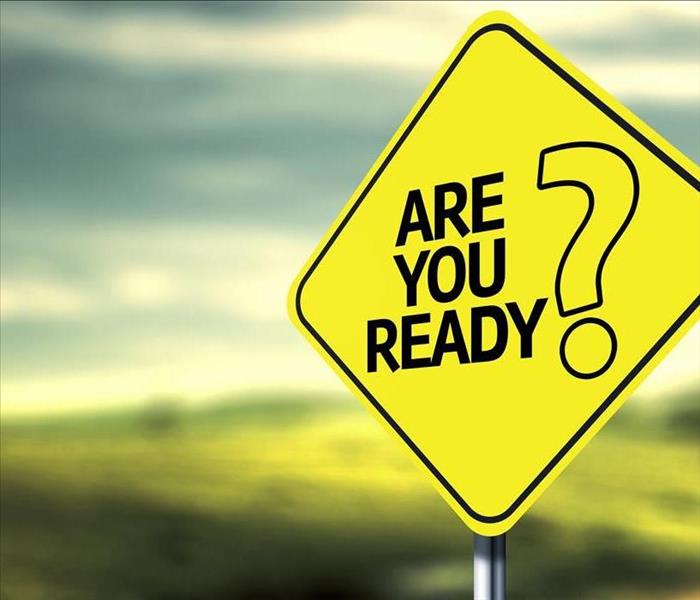 In case of a Power Outage caused by Storm Damage we need to understand how a generator works if we need to rely on one.
In case of a Power Outage caused by Storm Damage we need to understand how a generator works if we need to rely on one.
Commercial generators, like residential generators, are designed to provide power to your business in case your power ever goes out. Since your businesses in Arlington Heights, IL, likely has higher power requirements than your home, a commercial model will often have more efficient cooling components, a larger engine, and the ability to produce more power.
Understanding how a generator works is important in case a power outage or other emergency causes your business to rely on one.
1. There Are Two Main Fuel Types for Generators
If you’re looking at commercial generators for your business, you will need to choose between diesel and gas fuel types. Diesel models are often more expensive and noisy. However, they require less maintenance and emit less carbon dioxide. Gas generators have a shorter lifespan and are a potential fire hazard, but they are connected to a gas line which means they have a consistent fuel source.
2. The Running Time Will Depend on Your Generator’s Type
When choosing generators, you can go with a portable or permanent model. While portable models will work for many small businesses, their run time is typically only a few hours. Permanent generators can run for very long periods of time, so if outages are common in your area you’ll want to go with a permanent model.
3. Maintenance is Key
To prevent needing to call a restoration company due to damages caused by your generator, it is important that you look for common generator problems like battery failure and leaks before a power outage occurs.
4. Carbon Dioxide Is a Risk
Always keep your generator a safe distance away from the building and allow for plenty of ventilation in order to avoid carbon dioxide poisoning.
A commercial generator is essential for providing power to your building in the case of an outage or black out. Keep these four facts in mind so you can choose the right model for your needs and keep it running in good repair!
Winter Storm Tips
4/26/2019 (Permalink)
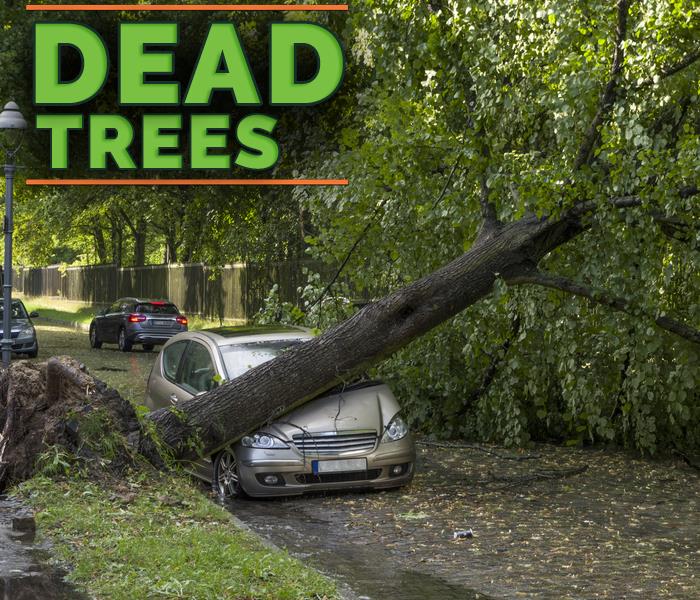 Keep your greenery trimmed for better safety in a storm.
Keep your greenery trimmed for better safety in a storm.
Facing an impending winter storm in Arlington Heights, IL? Whether it is a blizzard or some other kind of event, winter weather is no joke - keep your family and your home safer with these tips:
1. Keep supplies handy. Make a list of necessities and winter tools that you will need to brave the storm. If you have time, go shopping for the ones you are missing, and then find a place in your house to keep everything so you know where supplies are in case you need them when the storm hits.
2. Check your roof, gutters and siding. You may not think it would be the case, but all of these parts of your house can be damaged in a winter storm. Make sure they are all in good working shape before the weather gets dangerous.
3. Insulate your pipes. A burst pipe can cause a real disaster in a storm. Make sure that yours are insulated against cold temperatures.
4. Seal any air leaks. Air leaks are not a good sign, as they can lead to a home that is subject to extremely cold temperatures. You might just find that you save on energy costs when you fix these leaks, as well.
5. Trim trees. If an overgrown tree branch falls in a storm, your home, property and family are all at risk of being in a dangerous situation. Keep your greenery trimmed for better safety in a storm.
Now that you know how to prepare for a winter storm, it is time to learn what to do if roof damage or other issues should occur despite your best preparation efforts. A reliable residential storm damage company can help you with water destruction and many other effects of a storm. It is better to prepare for the worst than to be stuck with no knowledge of how to handle damage if it does occur.
3 Common Water Issues in Commercial Buildings
4/18/2019 (Permalink)
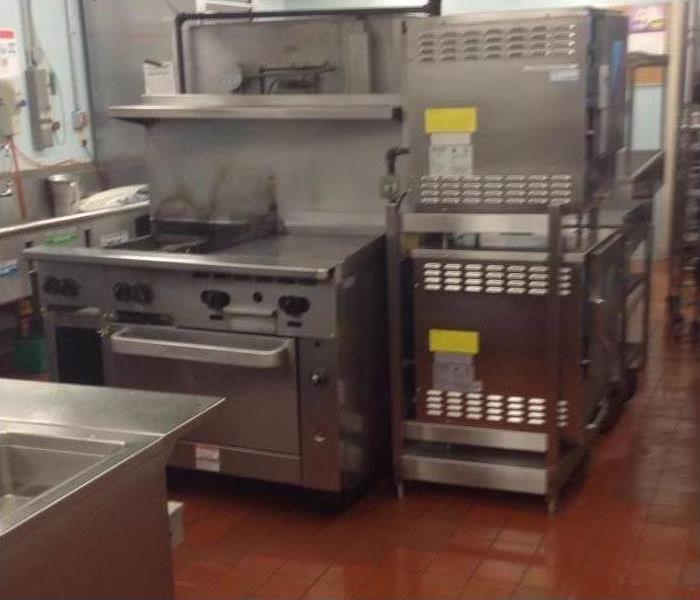 Blocked drains can shut down a sink, room or plumbing zone.
Blocked drains can shut down a sink, room or plumbing zone.
Commercial buildings are a maze of hot-water and cold-water supply pipes and drains. The water lines and sprinkler heads of the fire suppression system complicate the picture. Leaking pipes are everyday occurrences. You learn to expect the occasional flood or pipe break. The only surprise comes when the plumbers run out of problems to fix. Following are the three most common problems faced in commercial plumbing.
1. Small Nuisance Problems
These problems have quick and easy fixes. Dripping faucets and leaking pipes are commonplace in restroom and kitchen areas. Fixing these problems saves water and eliminates the hazards associated with wet floors. Small repairs like this provide plumbers the opportunity to inspect the surrounding plumbing and fixtures. Not every plumbing problem gets reported.
2. Toilet Problems
Toilet design is all about performing the flush using the least possible amount of water. It takes a delicate balance of water volume and pressure for a successful flush. When conditions aren’t correct, the result is a toilet backup. Some problem toilets frequently block. They may need a new flush valve or total replacement.
3. Blocked, Slow and Foul-Smelling Drain Problems
Blocked drains can shut down a sink, room or plumbing zone. A slow drain provides a warning that it will eventually stop completely. Plumbers know that drain-flow problems require prompt attention.
Drain odors from a sink may mean that the trap is dry. A dry trap allows smells and sewer gas to leak into the building. Traps attached to floor drains can dry out as well. Pouring water down the drain is a simple fix for dry traps. If the odor problem persists, it becomes a problem for the custodial staff to handle.
Leaking pipes can cause a flood. The subsequent water damage and the risk of mold are a threat to your business. There are water damage remediation specialists located in the Arlington Heights, IL area. They can help minimize the impact of water damage and keep your business up and running. It all starts with a phone call.
What Personal Protective Equipment Is Helpful When Removing Mold?
4/13/2019 (Permalink)
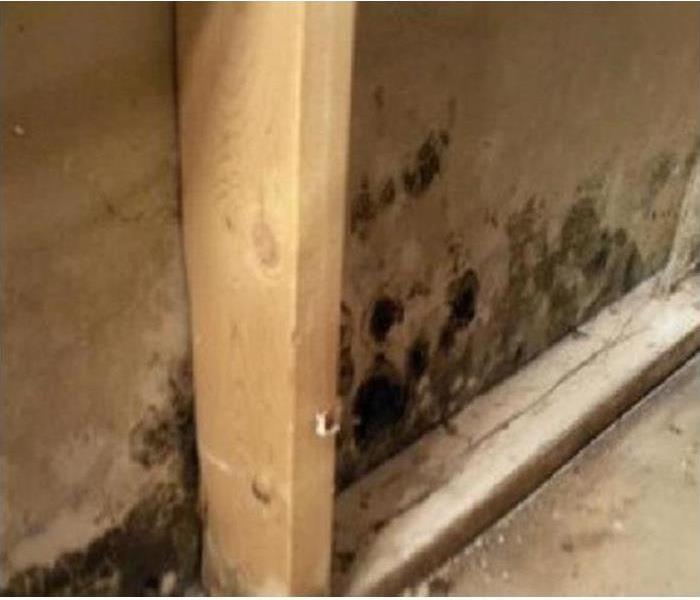 Commercial property owners and building managers should depend on the expertise of remediation professionals.
Commercial property owners and building managers should depend on the expertise of remediation professionals.
Personal protective equipment helps mold cleanup professionals limit exposure to microbial volatile organic compounds and spores while preventing cross-contamination. Workers should use respirators rated for mold, disposable gloves and booties and protect the rest of their bodies by wearing full-coverage clothing or coveralls.
Facial Protection
Respirators designed for working with mold may be half-face or full-face designs. Cleanup workers should select respirators with a rating of at least N95:
- N95 respirators block at least 95 percent of 0.3 micron particles
- N100 respirators filter 99.7 percent of particles 0.3 microns or greater
- Full facepiece respirators may be connected to a powered air purifying respirator system
Goggles are also necessary to protect workers' eyes. A major infestation may call for a full facepiece with vented goggles.
Hands
Cleanup workers should wear durable and disposable latex, nitrile or rubber gloves. These gloves should be thick enough to stand up to working conditions and should be disposed of after each session.
Full Body Protection
Workers cleaning up a major mold infestation should wear coveralls. This full body PPE is made of non-porous material and has a hood and booties for maximum protection. It may also be necessary to set up a containment chamber to avoid spreading mold.
For an infestation of less than 10 square feet, workers can wear shirts with long sleeves, pants and disposable shoe coverings. All of these items should be bagged and discarded at the end of each session.
All of these types of PPE can protect cleanup workers from exposure to spores and mVOCs released during mold growth. For a severe infestation, workers should combine N100 full-face respirators with vented goggles and coveralls. Minor mold problems call for respirators with a rating of at least N95, disposable gloves, booties and protective clothing. Commercial property owners and building managers should depend on the expertise of remediation professionals in Arlington Heights, IL.
SERVPRO of Arlington Heights/Prospect Heights can help you with Sewage Damage
3/26/2019 (Permalink)
 Sewage Damage clean up in a Propect Heights, IL basement.
Sewage Damage clean up in a Propect Heights, IL basement.
SERVPRO of Arlington Heights/Prospect Heights provides a variety of clean up services, one of them being sewage clean ups.
This picture is of a recent sewage damage clean up in a customer's basement in a Prospect Heights, IL home. It shows what the walls look like after our technicians cut 2 feet of drywall so as to remove the affected portion of the walls.
If you are a home owner or a property manager and have had this happen to your home or any of your properties, why not give our office a call at 847-637-3445 to help with the clean up?
We have the experience
SERVPRO of Arlington Heights/Prospect Heights has the experience and the know how to handle this and many other clean up situations. Browse our website for more details of our clean up services.
Water damaged home in Arlington Heights
3/26/2019 (Permalink)
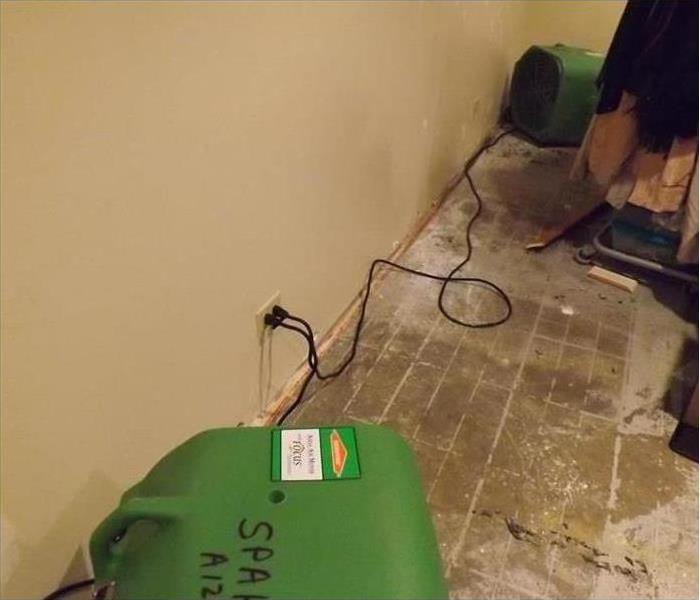 Our technicians hauled out all of the customer's belongings from the basement to the garage.
Our technicians hauled out all of the customer's belongings from the basement to the garage.
SERVPRO of Arlington Heights/Prospect Heights specializes in the cleanup of flooded basements.
With all the recent rain, we were called out to assist our customer in Arlington Heights, IL, when her basement flooded with a foot of water! As a result our technicians needed to haul out all of the items from the basement to the garage so that we could pump out the water and dry her basement out!
If you are a home owner, a business owner or a property manager that experiences a water damage due to the current rain, why not give our office a call at 847-637-3445 to help with the clean up?
We are a highly trained team that can quickly respond
SERVPRO of Arlington Heights/Prospect Heights has the experience and the know how to perform the necessary clean up and to make your situation seem “Like it never even happened.” Browse our website for more details on our other types of services.
Commercial Water Damage in Arlington Heights
3/26/2019 (Permalink)
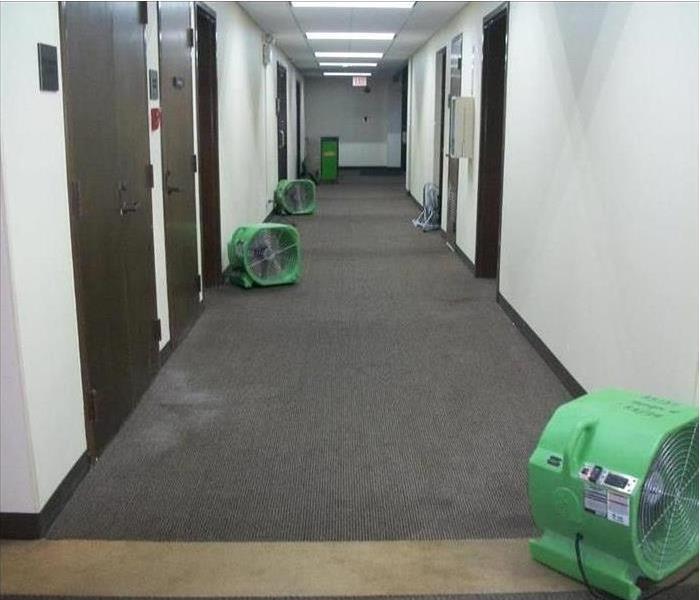 Water Damage clean up in a local office in Arlington Heights, IL.
Water Damage clean up in a local office in Arlington Heights, IL.
SERVPRO of Arlington Heights/Prospect Heights services are not only for residential properties but are also for commercial properties.
This picture is of a recent water damage clean up in Arlington Heights, IL, where some of the doctors’ offices became affected when water from the outside seeped in flooding their offices and their hallways. Several pieces of drying equipment were necessary to dry out the affected portions of the building.
If you are a business owner or a property manager and have had this happen to your place of business or any of your properties, why not give our office a call at 847-637-3445 to help with the clean up?
Commercial Building Cleaning Services
SERVPRO of Arlington Heights/Prospect Heights has the experience and the know how to handle this and many other cleaning situations. Browse our website for more details of our clean up services.
Four Ways To Prevent Mold Growth in Your Home
3/25/2019 (Permalink)
 If your home has high humidity, then you are more likely to find a mold growth.
If your home has high humidity, then you are more likely to find a mold growth.
Four Ways To Prevent Mold Growth In Your Home
If you have mold growing in your Arlington Heights, IL home, and you don’t know how to deal with it, you might feel stressed and frustrated. However, there are several things that you can do, such as preventing water damage, to keep a growth from forming. Keep these things in mind if you have a fungus problem in your house.
1. Fix Leaks Immediately
Because mold growth happens more quickly in moist environments, you should be sure to repair any leaks in your home as soon as possible. Whether the water is coming from a window, the plumbing or the roof, this is prime breeding space for mold. Even if the leak is small, it can cause enough water damage over time to become a large problem.
2. Keep Humidity Levels Low
If your home has high humidity, then you are more likely to find a mold growth. You can use a dehumidifier or an air conditioner to help keep humidity at an appropriate level.
3. Ventilate Areas That Are Prone to Mold
Active mold prevention is more often required in rooms where you use a lot of water, such as the bathroom, kitchen and laundry room. Keeping these areas ventilated can help. You should also make sure to dry any spaces where water tends to build up.
4. Clean Regularly
Regular maintenance and cleaning of your home is perhaps the best way to prevent mold. If you are cleaning on a regular basis, especially with products that kill mold spores, then the fungus will not have a chance to grow and spread.
While there are many ways that you can prevent mold, it can also be helpful to hire a professional mold remediation service if the problem is too large for you to handle on your own. Particularly if you have extensive water damage, it is a good idea to get outside help. A professional service can remove the mold, as well as repair the damage and prevent it from returning.
How Can Your Business Recover After a Major Emergency?
3/25/2019 (Permalink)
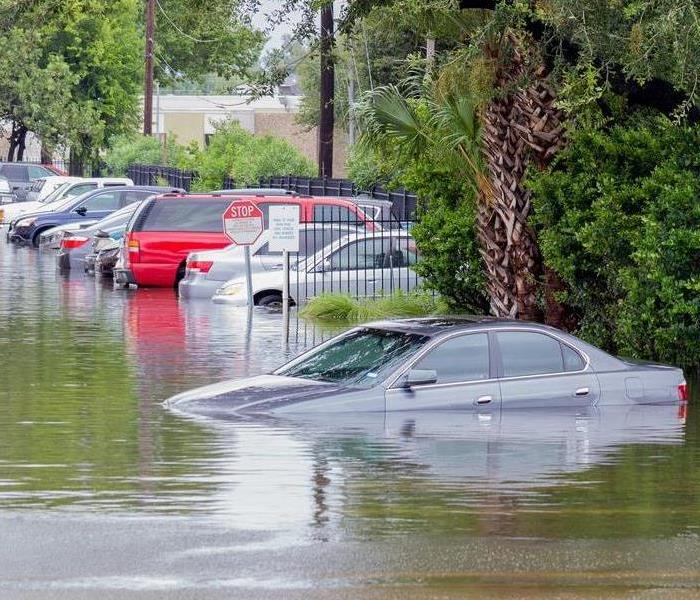 Flooding can invade your office building and cause serious damage.
Flooding can invade your office building and cause serious damage.
How Can Your Business Recover After A Major Emergency?
Most businesses in Arlington Heights, IL can go about their operation every day with little or no worry about emergencies or incidents with floods or other water damage. In some cases, you may experience minor issues that require little interruption to your work. However, if you’re on the unfortunate end of catastrophic loss following a serious emergency, you need help from a professional team of cleanup and restoration experts. The best crews can get you back to work even in the grimmest scenarios.
The Potential Problems
Flooding can invade your office building and cause serious damage. This can happen gradually over a long period, or it can come swiftly with a storm or other weather-related phenomenon. The results can be disastrous.
- Damage to electronic equipment
- Damage to or destruction of documents, books, photographs or other materials
- Structural damage
- Damage to furniture or workstations
The Pros to the Rescue
In the worst scenarios, you may lose hope that you can recover or restore your materials. But you can have peace of mind knowing that the best emergency cleanup and mitigation companies have the skills, experience, expertise, and equipment to get your business back on track, even if you’ve experienced catastrophic loss. Plus, in the most widespread emergency situations, the national office will deploy more resources to your location.
How Do They Do It?
Recovering after storm damage is no easy feat, but cleanup specialists are up to the challenge. To begin with, the team will respond promptly, usually within a few hours of your call. Before you know it, a trained technician will be on hand to assess the extent of the damage and to come up with a repair plan for you. The team employs the most skilled specialists in the industry. Every member uses commercial-grade equipment to thoroughly remove all water, dry affected areas, and restore and replace what was lost or damaged.
Now that you know a trustworthy emergency response and cleanup team is available, you should have more confidence following a disaster. Your business doesn’t have to be down long when you get the right team on the job.
For Immediate Service in Arlington Heights or Prospect Heights, Call SERVPRO
3/20/2019 (Permalink)
SERVPRO of Arlington Heights/Prospect Heights provides 24-hour emergency service and is dedicated to being faster to any-sized disaster in Arlington Heights or Prospect Heights. We can respond immediately to your emergency and have the expertise to handle your restoration or cleaning needs.
- 24-Hour Emergency Service
- Faster to Any-Sized Disaster
- Highly Trained Restoration Technicians
- A Trusted Leader in the Restoration Industry
- Locally Owned and Operated
- Advanced Restoration and Cleaning Equipment
Have Questions? Call Us 24/7 – 847-637-3445
Residential Services
Whether your Arlington Heights or Prospect Heights home needs emergency flood damage or your upholstery cleaned, you can depend on us. Our technicians have extensive cleaning and restoration training and can make your property look its best. Learn more about our residential services:
- Water Damage Restoration
- Fire Damage Restoration
- Mold Remediation
- Storm Damage Restoration
- Cleaning Services
- Building/Reconstruction Services
Commercial Services
There's never a convenient time for fire or Water damage to strike your Arlington Heights or Prospect Heights commercial property. Every hour spent cleaning up is an hour of lost revenue and productivity. So when the need arises for professional cleaning or emergency restoration services we have the training and expertise to respond promptly with highly trained technicians to get your property back to business. Learn more about our commercial services:
- Commercial Water Damage Restoration
- Commercial Fire Damage Restoration
Faster to your Arlington Heights Water Damage Event
3/20/2019 (Permalink)
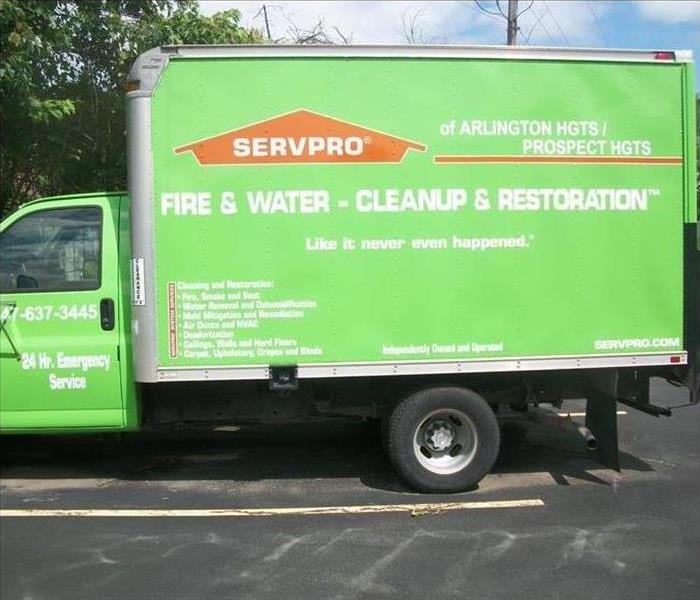 Flooding in an Arlington Heights School.
Flooding in an Arlington Heights School.
Flooding and water emergencies don’t wait for regular business hours and neither do we. SERVPRO of Arlington Heights/Prospect Heights. provides emergency cleaning and restoration services 24 hours a day, 7 days a week—including all holidays.
Faster To Any Size Disaster
Flooding and water damage is very invasive. Water quickly spreads throughout your home and gets absorbed into floors, walls, furniture, and more. SERVPRO of Arlington Heights/Prospect Heights. arrives quickly and starts the water extraction process almost immediately. This immediate response helps to minimize the damage and the cleaning and restoration costs.
Need Emergency Service? Call Us 24/7 at 847-637-3445
Water Damage Timeline
Within Minutes
- Water quickly spreads throughout your property, saturating everything in its path.
Water is absorbed into walls, floors, upholstery, and belongings.
Furniture finishes may bleed, causing permanent staining on carpets.
Photographs, books, and other paper goods start to swell and warp.
Hours 1 - 24:
- Drywall begins to swell and break down.
Metal surfaces begin to tarnish.
Furniture begins to swell and crack.
Dyes and inks from cloth and paper goods spread and stain.
48 Hours to 1 Week:
- Mold and mildew may grow and spread.
Doors, windows, and studs swell and warp.
Metal begins to rust and corrode.
Furniture warps and shows signs of mold.
Wood flooring swells and warps.
Serious biohazard contamination is possible.
More Than 1 Week:
- Restoration time and cost increase dramatically; replacing contaminated materials and structural rebuilding may be extensive.
- Structural safety, mold growth, and biohazard contaminants pose serious risks to occupants.
About SERVPRO of Arlington Heights/Prospect Heights
SERVPRO of Arlington Heights/Prospect Heights specializes in the cleanup and restoration of residential and commercial properties after a fire, smoke or water damage event. Our staff is highly trained in property damage restoration. From initial and ongoing training at SERVPRO’s corporate training facility to regular IICRC-industry certification, rest assured our staff is equipped with the knowledge to restore your property.
Carpet Cleaning in Prospect Heights
3/20/2019 (Permalink)
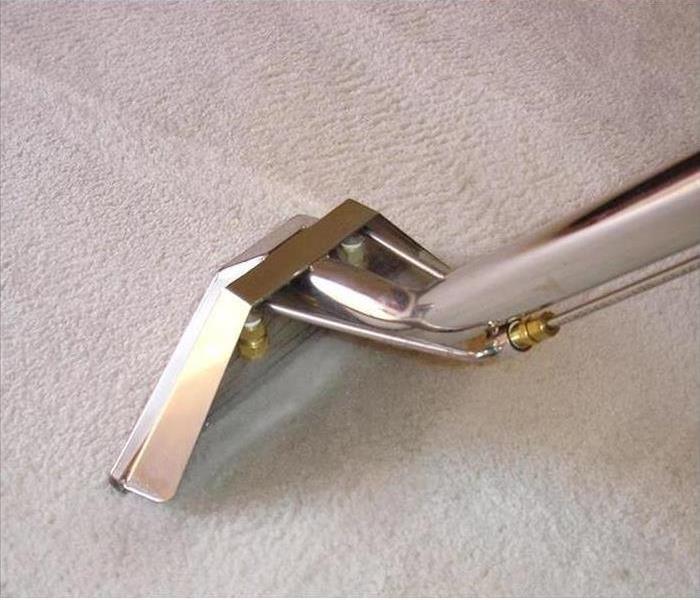 Our technicians use hot water extraction to remove the dirt in the carpet.
Our technicians use hot water extraction to remove the dirt in the carpet.
SERVPRO provides many services such as carpet cleaning.
Our carpet cleaning services are not only for residential properties but also for commercial properties. This picture shows the carpet cleaning method we use which is always hot water extraction. This type of cleaning method coupled with our proprietary cleaning products help remove the dirt and grime from the carpeting.
If you are a home owner, a business owner or a property manager that needs carpet cleaning, why not give our office a call at 847-637-3445 to help with the carpet cleaning?
SERVPRO of Arlington Heights/Prospect Heights has the experience and the know how to make your carpets look fresh and clean again as well as smell good!
Browse our website for more details on our other types of our cleaning services.
Four Ways To Prevent Mold Growth in Your Home
3/18/2019 (Permalink)
 Regular maintenance and cleaning of your home is perhaps the best way to prevent mold.
Regular maintenance and cleaning of your home is perhaps the best way to prevent mold.
Four Ways To Prevent Mold Growth In Your Home
If you have mold growing in your Arlington Heights, IL home, and you don’t know how to deal with it, you might feel stressed and frustrated. However, there are several things that you can do, such as preventing water damage, to keep a growth from forming. Keep these things in mind if you have a fungus problem in your house.
1. Fix Leaks Immediately
Because mold growth happens more quickly in moist environments, you should be sure to repair any leaks in your home as soon as possible. Whether the water is coming from a window, the plumbing or the roof, this is prime breeding space for mold. Even if the leak is small, it can cause enough water damage over time to become a large problem.
2. Keep Humidity Levels Low
If your home has high humidity, then you are more likely to find a mold growth. You can use a dehumidifier or an air conditioner to help keep humidity at an appropriate level.
3. Ventilate Areas That Are Prone to Mold
Active mold prevention is more often required in rooms where you use a lot of water, such as the bathroom, kitchen and laundry room. Keeping these areas ventilated can help. You should also make sure to dry any spaces where water tends to build up.
4. Clean Regularly
Regular maintenance and cleaning of your home is perhaps the best way to prevent mold. If you are cleaning on a regular basis, especially with products that kill mold spores, then the fungus will not have a chance to grow and spread.
While there are many ways that you can prevent mold, it can also be helpful to hire a professional mold remediation service if the problem is too large for you to handle on your own. Particularly if you have extensive water damage, it is a good idea to get outside help. A professional service can remove the mold, as well as repair the damage and prevent it from returning.
IICRC Categories and Classes
3/4/2019 (Permalink)
When you call to report a water loss in your business or home wouldn't it be nice to be able to give the person on the other end an idea of the type of loss you are experiencing. The IICRC has set guidelines for restoration companies to follow as a standard. These standards tell us what can stay and what has to go. We are not making up our own rules, like in monopoly. We follow the guidelines set be a 3rd party, the IICRC.
Categories of water – This refers to the amount of contamination in the water.
Category 1 – Water originates from a sanitary source and does not pose substantial risk from dermal, ingestion, or inhalation exposure.
Category 2 – Water contains significant contamination and has the potential to cause discomfort or sickness if contacted or consumed by humans.
Category 3 – Water is grossly contaminated and can contain pathogenic, toxigenic, or other harmful agents.
Classes of water – This refers to how wet an area, room, or structure has become.
Class 1 (least amount of water absorption and evaporation load) – Water intrusion where wet, porous materials (e.g., carpet, gypsum board, fiber-fill insulation, concrete masonry unit (CMU), textiles) represent less than ~5% of the combined floor, wall, and ceiling surface area in the space and where materials described as low evaporation materials
(e.g., plaster, wood, concrete, masonry) or low evaporation assemblies (e.g., multilayer wallboard, multilayer subfloors, gym floors, or other complex, built-up assemblies) have absorbed minimal moisture.
Class 2 (significant amount of water absorption and evaporation load) – Water intrusion where wet, porous materials (e.g., carpet, gypsum board, fiber-fill insulation, concrete masonry unit (CMU), textiles) represent ~5% to ~40% of the combined floor, wall, and ceiling surface area in the space and where materials described as low evaporation materials (e.g., plaster, wood, concrete, masonry) or low evaporation assemblies (e.g., multilayer wallboard, multilayer subfloors, gym floors, or other complex, built-up assemblies) have absorbed minimal moisture.
Class 3 (greatest amount of water absorption and evaporation load) – Water intrusion where wet, porous materials (e.g., carpet, gypsum board, fiber-fill insulation, concrete masonry unit (CMU), textiles) represent more than ~40% of the combined floor, wall, and ceiling surface area in the space and where materials described as low evaporation materials (e.g., plaster, wood, concrete, masonry) or low evaporation assemblies (e.g., multilayer wallboard, multilayer subfloors, gym floors, or other complex, built-up assemblies) have absorbed minimal moisture.
Class 4 (deeply held or bound water) – Water intrusion that involves a significant amount of water absorption into low evaporation materials (e.g., plaster, wood, concrete, masonry) or low evaporation assemblies (e.g., multilayer wallboard, multilayer subfloors, gym floors, or other complex, built-up assemblies). Drying may require special methods, longer drying times, or substantial water vapor pressure differentials.
SERVPRO of Arlington Heights / Prospect Heights
847-637-3445
EMERGENCY FIRE DAMAGE TIPS
2/24/2019 (Permalink)
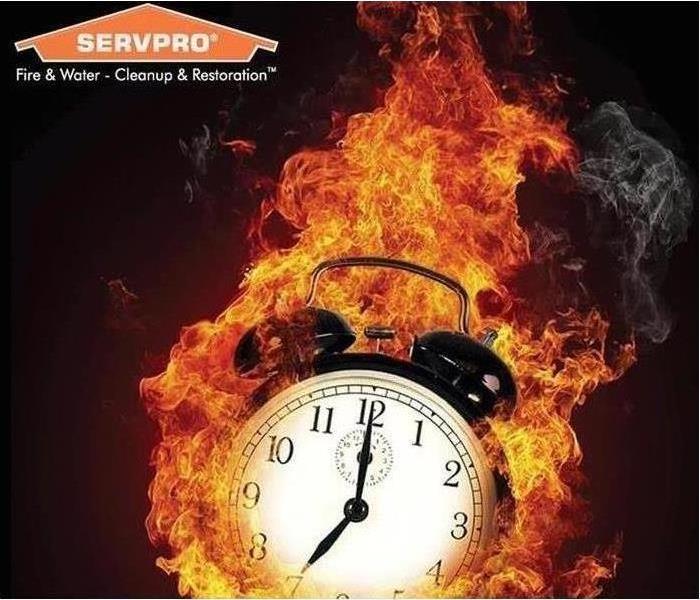 Choose to plan don't choose to react.
Choose to plan don't choose to react.
These emergency tips will assist you in taking proper action until your SERVPRO of Arlington Heights / Prospect Heights arrive. Follow these DOs and DON’Ts to help reduce damage and increase the chances of a successful restoration.
DO:
- Limit movement in the home to prevent soot particles from being embedded into carpet and avoid tracking.
- Keep hands clean. Soot on hands can further soil upholstery, walls and woodwork.
- If electricity is off, empty freezer and refrigerator completely and prop doors open to help prevent odor.
- Wipe soot from metal kitchen and bathroom faucets, trim and appliances.
- If heat is off during winter, pour RV antifreeze in sinks, toilet bowls, holding tanks and tubs to avoid freezing pipes and fixtures.
- Remove soot particles from plants with a damp cloth.
- Change HVAC filter, but leave system off until a trained professional can check the system.
- Tape double layers of cheesecloth over air registers to stop particles of soot from getting in or out of the HVAC system.
DON’T:
- Don’t attempt to wash any walls or painted surfaces without first contacting your SERVPRO® Franchise Professional.
- Don’t attempt to shampoo carpet, rugs or upholstered furniture without first consulting your SERVPRO® Franchise Professional.
- Don’t attempt to clean any electrical appliances (TV sets, radios, etc.) that may have been close to fire, heat or water without first consulting an authorized repair service.
- Don’t consume any food or beverages that may have
- been stored close to fire, heat or water. (They may be contaminated.)
- Don’t turn on ceiling fixtures if ceiling is wet. Wiring may be wet or damaged and cause electrical shock and air movement may create secondary damage.
- Don’t send garments to the dry cleaner. Improper cleaning may set in smoke odor.
Smoke Alarms: LIFE SAVERS
2/12/2019 (Permalink)
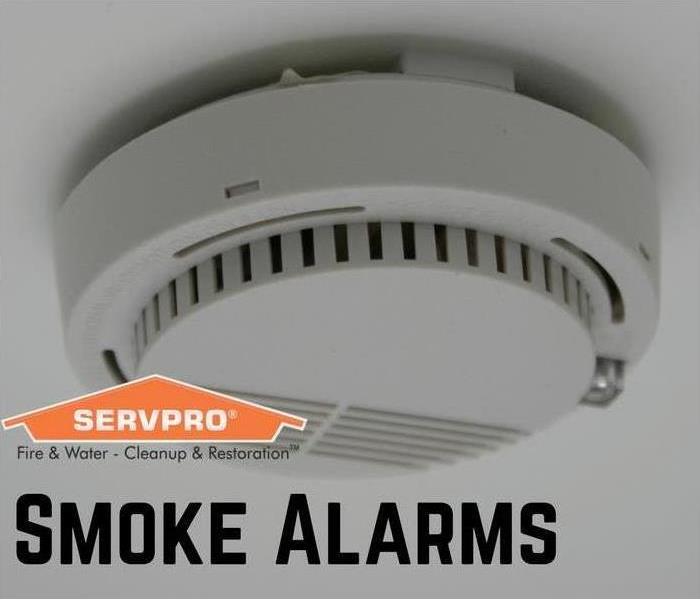 BATTERIES!
BATTERIES!
Smoke alarms save lives when properly installed and maintained, according to the National Fire Protection Association (NFPA).
In homes, smoke alarms should be in every bedroom and on every level, including the basement. In office and commercial environments, check your state requirements or contact your local Fire Marshall to help ensure all codes are met.
Test smoke alarms monthly using the test button. Smoke alarms with non-replaceable batteries need the entire smoke alarm unit replaced every ten years. Other alarms need batteries replaced every year and the unit replaced every ten years. If the alarm chirps signaling low battery, take the proper steps to replace the unit or the batteries immediately. Never disable or remove the battery from an alarm. Almost half of fires where smoke alarms were present but did not activate had missing or disconnected batteries (NFPA).
In larger commercial facilities, hard wired or wireless smoke alarms offer benefits such as not needing to be tested as often and activating throughout the entire building if smoke is detected in just one area (NFPA).
If you need help installing, testing or changing batteries in your smoke alarms, contact your local fire department, an electrician or the American Red Cross.
Be sure your home or workplace has a fire emergency plan in place and conduct regular fire drills. For more information on Emergency preparedness, contact your SERVPRO® Professional. 847-637-3445.
Portable fire extinguishers
2/12/2019 (Permalink)
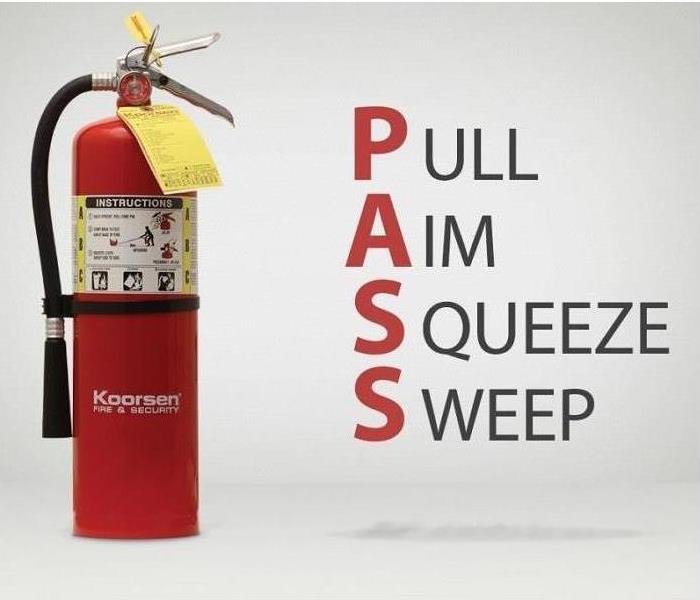 Don't PASS on getting them charged.
Don't PASS on getting them charged.
Portable fire extinguishers can be life and property saving tools when used correctly. In order to operate an extinguisher, the National Fire Protection Association (NFPA) suggests remembering the word PASS:
Pull the pin. Hold the nozzle pointing away from you and release the locking mechanism.
Aim low. Point the extinguisher at the base of the fire.
Squeeze the lever slowly and evenly.
Sweep the nozzle from side-to-side.
Read the instructions on the fire extinguisher and become familiar with them before a fire breaks out. Remember, extinguishers do have limitations. It is also important to ensure you have the correct type of extinguisher for your facility. To find more information on choosing the appropriate class of extinguisher, please visit the NFPA website at nfpa.org.
Polar Vortex 2019 SERVPRO
1/29/2019 (Permalink)
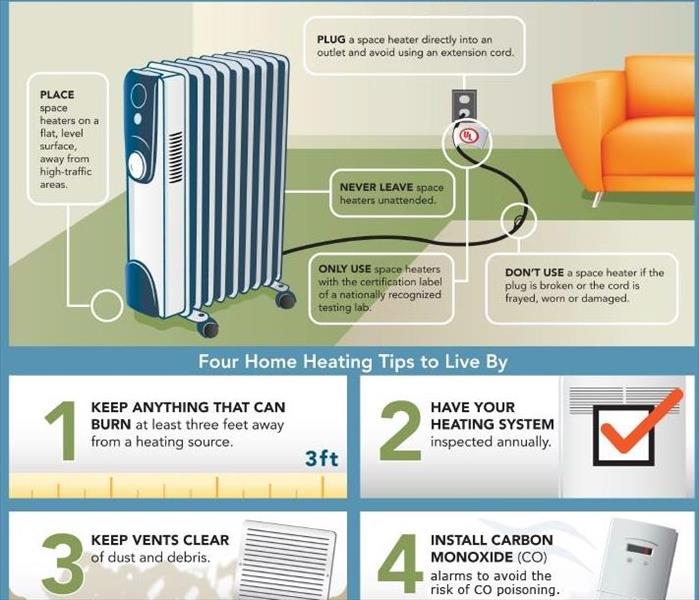 Plan to plan to have a plan!
Plan to plan to have a plan!
As a polar vortex rolls across the United States in this week, there is a point when we have a lower temperature than Antarctica. Take a second to think about that.
Although temperatures in Arlington Heights and Chicago-land drop quickly, we will fair better than other areas.
Unfortunately for homeowners and business owners in our area, the drop will still wreak havoc with their pipes. Being overwhelmed on what to do is going to be the first thought. That is why you need a plan and a company.
Many homes and businesses will call about burst pipes, flooded basement and closed office due to sprinkler breaks and will be put on wait lists.
Although it does seem like some of these burst pipes will be inevitable, there are a few precautions that you can take to avoid a major loss when the temperatures drop.
Insulate Pipes
Insulating your pipes is inexpensive compared to the cost of a water damage and is easy to do yourself. This is the first step when preparing your house for cold weather.
Insulate Everything Else
Make sure there is plenty of insulation in your attic and crawlspace. This will keep everything in your house warmer including your pipes.
Run Faucets
When you know that there is going to be a big temperature drop, like the recent polar vortex, don't give water a chance to freeze by running it. The smallest stream from a faucet will keep the water moving and prevent freezing. This is especially important to do with faucets that are served by exposed pipes.
Keep Garage Door Closed
If there are pipes in your garage, you need to keep it as warm as possible. Do not leave it open and try to open it only when absolutely needed.
Remove, Drain, and Store Hoses
Water in hoses can freeze and start a chain reaction that will lead back into your house. Prevent this by removing all hoses from the house and draining them.
Open Cabinets
Open cabinets in the kitchen and bathroom to get some warmer air moving beneath your sinks.
Keep House Temperature Consistent
Most people drop the temperature in their house down at night. When temperatures are especially cold, it is best to keep the house at a higher consistent temperature. The price of heat is nothing compared to the price of a burst pipe.
Set Temperature When Out of Town
If you will be out of town during the winter, make sure to keep the temperature of your house above 55 degrees at the very least.
Following these simple steps can go a long way in preventing a major water damage. For the losses that cannot be prevented, remember to call us at SERVPRO of Arlington Heights/Prospect Heights at 847-637-3445!
Preparing A Commercial Property For Fall
8/23/2018 (Permalink)
It’s official, fall is coming, and it’s coming quickly. School gear is being purchased in bulk, last minute vacations are being taken to squeeze out the final remnants of summer and hot weather, and fall apparel and gear have hit the stores in preparation for the cooler air and shorter days. Take the hint and start your own preparations to make sure your commercial property is ready for the changing seasons.
Check Your Gutters – The season is known as “Fall” for a reason, leaves are going to change color and fall from the trees in bulk, and that means a lot more than increased sweeping and vacuuming inside as they are tracked in on shoes. The biggest threat that comes from all of those falling leaves and debris is to your gutter system. Make sure it’s clear so that water will flow freely away from your building when it rains and pours. This simple step will go a long way towards preventing roof leaks and flooding.
Check Your Heaters – Avoid surprises by checking to make sure your heater works before the first cold snap. This means checking on the pilot light, oil levels (if applicable) and furnace filters, as well as having an HVAC expert come in for a seasonal checkup. Not only will your employees and customers thank you, but these steps can help ensure your heating unit will work better and last longer.
Check Your Water Pipes – Exposed water pipes should regularly be checked for leaks, but fall is also a good time to examine the insulation and make sure it’s prepared for colder weather. Prevent frozen and burst pipes in the winter by conducting a quick check in the fall and fixing any inadequacies.
Prevent Electrical and Fire Problems – Have an electrician come in and perform a maintenance check on your electrical system to ensure it’s prepared for the increased usage that fall demands. Shorter and colder days mean more lighting and the possible addition of space heaters, and you don’t want to blow a fuse when clients are around! While you’re at it check your smoke detectors and their batteries ideally once a month, but in the spring and fall at the least, and any emergency generators which should be started once a week so they don’t remain idle too long, transfer load tested every month and full load tested once a year.
SERVPRO of Arlington Heights/Prospect Heights is here to help. Give us a call at 847-637-3445 for all your emergency preparedness needs, as well as emergency water or fire needs.
Why does mold grow in my home?
8/11/2018 (Permalink)
Mold spores need three things to grow into mold: nutrients, cellulose (the cell wall of green plants) is a common food for indoor spores, and moisture. To begin the decaying process caused by mold; time -mold growth begins from 24 hours to 10 days after the provision of growing conditions.
Molds are found everywhere, and can grow on almost any substance when moisture is present. They reproduce by spores, which are carried by air currents. When spores land on a moist surface suitable for life, they begin to grow.
Common building materials are capable of sustaining mold growth. Mold growth in an indoor environment is typically related to water or moisture and may be caused by incomplete drying of flooring materials. Flooding, leaky roofs, building-maintenance or indoor-plumbing problems can lead to interior mold growth. Water vapor commonly condenses on surfaces cooler than the moisture-laden air, enabling mold to flourish. This moisture vapor passes through walls and ceilings, typically condensing during the winter in climates with a long heating season. Floors over crawl spaces and basements, without vapor barriers or with dirt floors, are mold-prone.
Significant mold growth requires moisture and food sources and a substrate capable of sustaining growth. Common building materials, such as plywood, drywall, furring strips, carpets, and carpet padding provide food for mold. In carpet, invisible dust and cellulose are food sources. After water damage to a building, mold grows in walls and then becomes dormant until subsequent high humidity; suitable conditions reactivate mold. Mycotoxin levels are higher in buildings which have had a water incident.
If you suspect, that you have mold growing in your home or business, Call SERVPRO of Arlington Heights/Prospect Heights today at 847-637-3445. We will help you make it “Like it never even happened.”
What is your smoke detector life expectancy?
8/6/2018 (Permalink)
You have a smoke detector in your home, but have you ever wondered what the life expectancy of that alarm is? Smoke alarms save lives. Smoke alarms that are properly installed and maintained play a vital role in reducing fire deaths and injuries, but how long before it should be replaced?
The U.S. Fire Administration for Homeland Security, the National Fire Protection Association (NFPA), the National Electrical Manufacturers Association (NEMA) and the Red Cross agree after working for 87,000 hours, or about 10 years in normal environmental conditions in the home can have an impact on the performance of your smoke alarm.
The NFPA conducted a study, and the results reinforced how important it is for integrators to address the fire safety needs of their clients: 1 in 5 Smoke Alarms Is 10+ Years Old
- Half of Americans (50 percent) have three or more smoke alarms in their current home.
- Almost one in five Americans who have smoke alarms (19 percent) say the oldest smoke alarm they currently have in their home is 10+ years old.
- Nearly one in five Americans who have smoke alarms (18 percent) are not at all sure how old the oldest smoke alarm they currently have in their home is.
- When asked how often they should replace smoke alarms, nine in 10 Americans (90 percent) did not select the correct answer, which is at least every 10 years.
SERVPRO of Arlington Heights/Prospect Heights wants you and your family safe. Keep these tips in mind when checking your smoke alarms.
Commercial fire in Prospect Heights
8/1/2018 (Permalink)
It just takes a second for your little one to start a fire. Whether it helps intentionally or unintentionally, it's always a concern. July 18, a child was playing with a lighter when flames quickly covered a corner of a balcony. Fire quickly spread to two-24 unit buildings. Two out of three of the buildings will be total lost as the fourth building just suffered some fire and smoke damage. This building was untouched thanks to the 150 plus firefighters from 50 different departments, acted rather quickly to stop the fire from spreading more. Commercial fires usually have working smoke detectors, but due to the buildings age sprinklers was not in any of the buildings. This property did not have sprinklers to building because to add sprinkles to an old building is remodeling at least 50 percent of the structure. When having commercial fires, windy conditions and lightweight wood truss construction roof made it very difficult to put the fire out.
Best way to prevent commercial fires is using smoke detectors, fire extinguishers, and having automatic sprinklers system installed! if your commercial property has had fire damage, SERVPRO Arlington Heights/Prospect Heights is here to help, give us a call @ 847-637-3445!
Summer Storm Tips
7/31/2018 (Permalink)
During the summer months, our minds are preoccupied with vacationing, grilling burgers with the family, and focusing on getting that bronze tan at the poolside. Yet, most of us leave our most valued possessions unprepared for the alarming and unpredictable summer storms: our homes.
Each year, thunderstorms alone cause an astonishing $15 billion in property damage. Summer and spring seasons are the most vulnerable to these destructive and frightening storms. Hailstorms result in approximately $1 billion of property damage a year. Thunderstorm winds can reach over 100 mph with an outcome of severe roof and house siding damage. Flooding causes billions of dollars a year in damage to homes and sadly some result in total loss of residences.
Here are some summer time safety tips to keep in mind during summer storms:
- Know the safest structure of your home to go to during a severe storm such as a basement, underground cellar, or even the most inner part of your home away from windows.
- Take summer storm warnings and alerts seriously, especially tornado and hurricane warnings! Tornadoes and hurricanes can lead to total property loss and even death.
- Invest in storm windows.
- Contact your insurance company to be more familiar with your policy. Most home insurers do not cover flooding damage.
- Cut down any unwanted trees or limbs and get your trees trimmed before summer storm season. Trees and branches can fall on your property and damage the siding or windows due to those powerful 100 mph thunderstorm winds.
- Get routine maintenance on your roof and the foundation! Cracks in the roof are the number one leading cause to flooding damage.
Summer storms can happen at any time. Make sure you home is ready, and your family is safe. Unfortunately, we all know things happen, even to the most prepared home. SERVPRO of Arlington Heights/Prospect Heights is here to help! Give us a call at 847-637-3445 for all your water damage needs.
Commercial Property Tips For The Summer
7/23/2018 (Permalink)
Summertime is the perfect chance for you to freshen up the outside of your commercial property, temperatures are finally starting to heat up and signs of summer are rolling in. It also marks that time of year when commercial real estate property owners and managers need ensure that their buildings are ready the seasonal changes in order to avoid unexpected issues or costs.
Inspect your roof – Summer weather leads to strong storms. Keep a close eye on your roof to make sure leaks haven’t developed.
- Clean out gutters– Clean out any debris that’s trapped in your gutters. This is not only good for your gutters, but it also gives your business a well-maintained appearance. Summer often means severe storms, hail and even tornado activity that can put a severe strain on roofing materials. Start the summer out right by getting a professional roof inspection to determine any problems that might have occurred over the winter months. Ice and snow damage may have occurred that isn’t immediately evident. Loose tiles, damage to underlay materials and problems with gutters can lead to more serious problems as the season continues
- Revitalize the exterior– Clean up any trash or yard debris that’s lying around your property. Plant summertime flowers to offer a fresh pop of color. Apply a new coat of paint – or even better, use commercial pressure washing to remove dirt, pollen, and grime. Don’t forget about commercial concrete stains on your drive-thrus and sidewalks.
- Thoroughly inspect surfaces– Walk around your property and make note of any stains or damage on your exterior walls. Call us to come by and see how we can clean up your exterior with commercial pressure cleaning.
- Window maintenance, Winter weather may have damaged the windows on your commercial property, which could lead to higher air-conditioning costs during the summer months. Thorough caulking can prevent leakage of cooled air and save more on energy bills.
SERVPRO of Arlington Heights/Prospect Heights is here to help with all your commercial property needs. Give us a call at 847-637-3445, and ask about our Emergency Readiness Planning.
Bonfire Safety Tips
7/16/2018 (Permalink)
Now that it is summer, it is bonfire time! According to a report from the United States Fire Administration, summer is one of the most dangerous seasons for fire-related injuries and deaths. Fortunately, there are plenty of ways to protect yourself and your loved ones while still having a great time. Here are some great tips from the American Fire Safety Administration.
Choose a location for your bonfire where it will not spread. Never build a fire near any dry leaves or grassy areas or under overhanging tree branches. Before building a bonfire, clear away all shrubbery and vegetation from the area, dig a pit for the fire, and surround it with rocks.
Be smart about lighter fluid. Do not store gasoline, liquid fire starter, or any other type of flammable liquid near the campfire. It's too easy for stray flames to ignite these materials.
Never light a bonfire if you do not have the means of extinguishing it. Always keep plenty of water and a shovel near the campfire to use in an emergency and to put the campfire out when you are finished using it.
If you experience a fire at your home while enjoying a beautiful summer night, SERVPRO of Arlington Heights/Prospect Heights at 847-637-3445.
Summer Mold Growth
7/10/2018 (Permalink)
In general, mold grows well within the same temperature range that makes us feel comfortable – about 60 to 80 degrees. When warm, moist air comes into contact with cold surfaces, it can create condensation, since the cooler air can't hold as much moisture. Sometimes, humidity or dampness, or water vapor in the air can supply enough moisture for mold growth. Indoor relative humidity should be kept below 60 percent. Ideally humidity should be kept between 30 percent and 50 percent, if possible.
In the summer, air conditioning can de-humidify indoor space. However, if the system is too large or too small for the space it serves, the cooling system can create high humidity by cooling without removing water vapor. A properly sized and maintained system will dehumidify and cool a building. Learn more about the role of heating, ventilation and air conditioning HVAC systems in indoor environmental quality.
When there are cold surfaces in a building, water vapor can condense on those surfaces, just as water condenses on the outside of a glass of ice water. Insulation of exterior walls can prevent condensation and mold growth during the winter.
You should always be mindful of indoor sources of water vapor that can be problematic. Clothes dryers must be vented to the outdoors. Unvented gas or kerosene space heaters can generate enormous amounts of water vapor (as well as other air contaminants), and should be used sparingly and never as a primary heat source. Always run the bathroom exhaust fan when showering or bathing, and make sure the vent is exhausted to outdoors. A properly vented kitchen exhaust fan can remove steam created during cooking.
If you find you have mold growth in your home give SERVPRO of Arlington Heights/Prospect Heights a call at 847-637-3445. We will make it “Like it never even happened.”
Water Damage From Garden Hose
7/5/2018 (Permalink)
A 25-foot, 1/2-inch diameter hose attached to a faucet that supplies water at 40 psi has a flow rate of 24 gallons per minute, while a 100-foot hose only has a flow rate of 6 gallons per minute. That is a lot of water coming from a garden hose. That is why it is so important to make sure that when you are out watering your garden or flowers that you keep an eye on the hose. Walking away from your hose while it is on can cause water to flow into your home and cause water damage.
A leaking garden hose can also cause water damage to your home as well as mold damage due to the long period of time that the water might be entering your home. Here are some things you should look for when you come across a leaking water hose, and how you can stop the water from entering your home.
The most important thing to determine is where the leak on your hose is actually coming from. This shouldn’t be too difficult to do, but depending on the location will determine the severity of the problem and how much effort it will take to fix it. If your hose always leaks from around the connection to the water tap, you may have either a problem with the spigot itself, or the hose fitting. If water wells up around the handle, your packing washer may be worn out, or the packing nut may need to be tightened, but if water only leaks when your hose is secured to the faucet, then you need to see if the water is welling up around the actual connection, or from below the fitting.
If you find that you have water damage to your home due to water entering your home from the garden hose, SERVPRO of Arlington Heights/Prospect Heights is here to help. Give us a call at 847-637-3445.
Mold: What You Need To Know
6/28/2018 (Permalink)
According to the EPA the ten things you should know about mold:
1. Mold can cause health effects to people.
2. There is no practical way to eliminate all mold and mold spores in the indoor environment; the way to control indoor mold growth is to control moisture.
3. If mold is a problem in your home or school, you must clean up the mold and eliminate sources of moisture.
4. Fix the source of the water problem or leak to prevent mold growth.
5. Reduce indoor humidity (to 30-60%) to decrease mold growth by:
• Venting bathrooms, dryers and other moisture-generating sources to the outside
• Using air conditioners and de-humidifiers
• Increasing ventilation
• Using exhaust fans whenever cooking, dish washing and cleaning
6. Clean and dry any damp or wet building materials and furnishings within 24-48 hours to prevent mold growth.
7. Prevent condensation: Reduce the potential for condensation on cold surfaces (i.e., windows, piping, exterior walls, roof, or floors) by adding insulation.
8. Molds can be found almost anywhere; they can grow on virtually any substance, providing moisture is present. There are molds that can grow on wood, paper, carpet, and foods.
It is the water that you do not see that causes the most damage to your home and business. Water contains bacteria that can cause mold, rot, and other unseen damage.
In order to control mold, you have to control the moisture in a building. Once you detect water, acting promptly is the key to controlling mold. You need to get the water infiltration stopped and cleaned within 24-48 hours.
The IICRC (Institute of Inspection, Cleaning and Restoration Certification) gives several good tips on how to prevent mold.
• Repairing plumbing leaks and leaks in the building structure as soon as possible.
• Looking for condensation and wet spots. Fix source(s) of moisture incursion problem(s) as soon as possible.
• Preventing moisture from condensing by increasing surface temperature or reducing the moisture level in the air (humidity). To increase surface temperature, insulate or increase air circulation. To reduce the moisture level in the air, repair leaks, increase ventilation (if outside air is cold and dry), or dehumidify (if outdoor air is warm and humid).
• Keeping HVAC drip pans clean, flowing properly, and unobstructed.
• Performing regularly scheduled building/ HVAC inspections and maintenance, including filter changes.
• Maintaining indoor relative humidity below 70% (25 - 60%, if possible).
• Venting moisture-generating appliances, such as dryers, to the outside where possible.
• Venting kitchens (cooking areas) and bathrooms according to local code requirements.
• Cleaning and drying wet or damp spots as soon as possible, but no more than 48 hours after discovery.
• Providing adequate drainage around buildings and sloping the ground away from building foundations. Follow all local building codes.
• Pinpointing areas where leaks have occurred, identifying the causes, and taking preventive action to ensure that they do not reoccur.
It is impossible to rid your home or business of mold spores. Some mold spores can travel through the air and in dust, however if there is no moisture present, there can be no mold growth. Remember, if you clean up the mold, but do not fix the water problem, then the mold problem will continue to come back. That is where SERVPRO is here to help. Should you suspect mold in your home or business, contact our office at 847-637-3445.
What Happens After Your Fire?
6/28/2018 (Permalink)
We all know that for an emergency you call 911, but what happens after the fire department leaves and you have a damaged home or business? You call SERVPRO of Arlington Heights/Prospect Heights, that's what you do! We are here to help you 24/7/365. Give us a call at 847-637-3445 for all your fire and water emergency needs.
Fires can leave behind soot and smoke that needs to be cleaned. SERVPRO of Arlington Heights/Prospect Heights is here to help! Cleaning up after soot and smoke is no small task, but our trained staff will be able to clean your home or commercial property and return it to you just "Like it never even happened." We are here to help 24/7/365 for all your restoration needs.
Commercial Water Damage
6/28/2018 (Permalink)
SERVPRO’s services are not only for residential properties but are also for commercial properties. This picture is of a recent water damage clean up in Arlington Heights, where some of the doctors’ offices became affected when water from the outside seeped in flooding their offices and their hallways. Several pieces of drying equipment were necessary to dry out the affected portions of the building. If you are a business owner or a property manager and have had this happen to your place of business or any of your properties, why not give our office a call at 847-637-3445 to help with the clean up? SERVPRO of Arlington Heights/Prospect Heights has the experience and the know how to handle this and many other cleaning situations. Browse our website for more details of our clean up services.
No Commercial Job Too Big or Too Small
6/20/2018 (Permalink)
SERVPRO’s services are not only for residential properties but are also for commercial properties. This picture is of a recent water damage clean up in Arlington Heights, where some of the doctors’ offices became affected when water from the outside seeped in flooding their offices and their hallways. Several pieces of drying equipment were necessary to dry out the affected portions of the building. If you are a business owner or a property manager and have had this happen to your place of business or any of your properties, why not give our office a call at 847-637-3445 to help with the clean up? SERVPRO of Arlington Heights/Prospect Heights has the experience and the know how to handle this and many other cleaning situations. Browse our website for more details of our clean up services.
Sewage Backup Causes
6/20/2018 (Permalink)
Sewage backups are very unfortunate events that can happen in any home or commercial property. What causes this type of water damage anyway? Well, typically there are three main categories that a sewer back up happens: damaged sewer pipes, clogs, and tree roots in the sewer system. Let's look at these three areas a bit closer.
- Clogging: Typically if you only have one area of your home that experiences a backup, like a tub or a sink, then there is typically a clog and can be fixed with cleaning the drain. However, if you have the backup in several areas of your home, then there is a blockage at the main or the private that is causing the issue. Unless the blockage is removed, the overflow will continue and will damage your entire home or business area.
- Tree Roots: The roots of large trees in the proximity of a sewer line can often cause severe problems. They can literally grow into the pipes and cause holes and blockages or they may wrap around the sewer line and crush it.
- Damaged Sewer Lines: Older properties with older sewer lines that have not been upgraded can have broken or collapsed lines. All the pipes and sewers in older homes were built using cast iron and clay which can wear off with time, get rusty, and easily break down. Present day plastic sewer lines cannot cause such problems simply because they don’t rust.
Sewage backups are not only hazardous to your health, but they can cause a great amount of structural damage to your home. If you experience a sewage back up do not attempt to flush the toilet. Do not use harsh chemicals to attempt to clean out the drain. This can actually cause more damage and make things worse. Open your windows to let fresh air in. It is also very important to keep pets and children away from the affected area. However, the most important thing to do, is to call for professional help.
SERVPRO of Arlington Heights/Prospect Heights is here to help with all your water damage needs. We are open 24/7/365 to help. Call us at 847-637-3445.
Reasons Sump Pumps Fail
6/15/2018 (Permalink)
It is spring time in Arlington Heights, and the one thing we know is that rain is never far behind. With the spring rains comes the sump pump failure calls from homeowners. Often we are asked, how does this happen and why does my sump pump fail? The following is some of the top reason we have seen sump pumps fail.
Power failures: When the electricity goes out, and the sump pump does not have a battery backup or the battery backup is not fully charged there is no way for the pump to do their job. Making sure that your battery backup system is fully charged before a storm the best way to ensure you don’t have water backing up into your home.
Wrong size sump pump: When you have an undersized pump it causes the pump to have to work extra hard to remove the water from your home. If the pump is too big, it has to work harder, and in return the life span is lessened.
Defective sump pump: Yes, it does happen that at the time of install the sump pump is defective. It is wise to test the pump when it is initially installed to make sure the pump operates properly.
Frozen of Clogged Lines: If the water cannot exit, the pump does not work. Protecting the water’s exit point of the discharge pipe will keep debris and animals out of the system, making it optimal for your sump pump.
Switch Problems: The switch is the main mechanical reason for sump pump failures. This occurs when the pump shifts from its position inside the basin, rendering the float ineffective. Float is responsible for the smooth operation of the on/off switch. Your sump pump relies on both the switch and the float arm mechanisms to operate effectively.
Last, but not least is Lack of Maintenance: Most sump pumps should be ran every 2-3 months per most manufactures instructions. Testing to make sure your sump pump works before rainy season hits is also recommended.
If you have a sump pump failure this spring, SERVPRO Arlington Heights/Prospect Heights is here to help. Give us a call at (847) 637-3445.
Tornado Safety Myths
6/13/2018 (Permalink)
According to the study done by The Weather Channel. Each year in the U.S., 1,200 tornadoes on average kill 60 people, injure 1,500, and cause roughly $400 million in damages, putting long-term average tornado losses on par with hurricanes. With that being said, you need to know the difference between tornado fact and fiction.
- Southwest corner of your home/building/shelter is the safest location - In 1887 John P. Finley wrote a book on his observations of his tornado research. While he published some ground breaking information on tornadoes he also helped created this tornadoes myth. John believed that tornadoes only traveled in a northeast direction and that derby they created would be carried in the direction of its propagation. The 1997 F5 Jarrell tornado is a prime example of his misconceptions since that tornado moved in a south-southwesterly direction. It's recommended that you always seek shelter in the lowest floor of a building, preferably under an I-beam or staircase, regardless of the type of building you're in.
- Open all the windows in your home when a tornado warning is issued - This is an extremely dangerous myth because it takes away critical minutes that could be used to reach shelter. It used to be widely believed that you needed to open your windows during a tornado to equalize pressure and prevent your house from exploding. A violent tornado will only have a 10% drop in pressure which isn't anywhere near enough to cause your home to explode. Ignore your windows and seek shelter immediately when a tornado warning is issued.
- A highway overpass is an excellent tornado shelter - This myth gained huge traction in 1991 when a TV crew survived a tornado unharmed by sheltering under a overpass in El Dorado, KS. This event had nationwide coverage with video of the event and that helped perpetuate this myth to a dangerously high status. The conclusion for scientific evidence from the Oklahoma outbreak in 1999 actual proved that overpasses are actually one of the worst places to seek shelter during a violent tornado; mostly due to the wind tunnel effect that can accelerate flying derby speed even during weak tornadoes.
- You can outrun a tornado via a vehicle - The theory behind this myth is a vehicle can travel faster than the average tornado, but the key phrase is average. There is no way for someone to know the travel and wind speed of a tornado just by looking at it. Plus the flooding, hail, and flying derby from a tornado can put someone in a vehicle in danger. The official directive from the National Weather Service is if you spot a tornado nearby to abandon your vehicle and seek shelter in a nearby building, culvert or ditch.
- A brick or stone building can protect me from a tornado - While a brick or stone building can provide better protection during tornado a violent only can easily turn a brick or stone building into a pile of rubble. It's recommended that you always seek shelter in the lowest floor of a building, preferably under an I-beam or staircase, regardless of the type of building you're in.
- If a tornado isn't coming directly towards me I'm safe - In the past it was common belief that a tornado would only travel in a northeasterly direction. While it's true that most tornadoes will move northeast this is most due to the direction the storm is traveling. Tornadoes are erratic, unpredictable, and can come from any direction.
In the even a tornado strikes, SERVPRO is always here to help!
How To Prevent Mold Growth
6/13/2018 (Permalink)
Where ever there is moisture, there will be mold growth. Thanks to these tips from the CDC, we can keep mold from growing out of control in our homes.
1) Keep humidity levels as low as you can—no higher than 50%–all day long. An air conditioner or dehumidifier will help you keep the level low. Bear in mind that humidity levels change over the course of a day with changes in the moisture in the air and the air temperature, so you will need to check the humidity levels more than once a day
2) Be sure that your home has enough ventilation. Use exhaust fans that vent outside your home in the kitchen and bathroom. Make sure that your clothes dryer vents outside your home.
3) Fix any leaks in your home’s roof, walls, or plumbing so mold does not have moisture to grow.
4) Clean up and dry out your home thoroughly and quickly (within 24–48 hours) after flooding.
5) Add mold inhibitors to paints before painting
6) Clean bathrooms with mold-killing products
7) Remove or replace carpets and upholstery that have been soaked and cannot be dried promptly. Consider not using carpet in rooms or areas like bathrooms or basements that may have a lot of moisture.
If you suspect you have mold growing on your home, SERVPRO of Arlington Heights/Prospect Heights is here to help. Give us a call at 847-637-3445 and set an appointment for us to come and look at your home or business to assess the suspected mold damage.
Grilling Tips
6/13/2018 (Permalink)
According to the National Fire Protection Association (NFPA),” In 2014, 16,600 patients went to emergency rooms because of injuries involving grills”. The NFPA has listed several great tips for grill safety, we would like to share with you.
- Grill outside and away from any structures
Charcoal and gas grills are designed for outdoor use only. However, NFPA reports that more than one-quarter (27 percent) of home fires started by outdoor grills began in a courtyard, terrace or patio, and 29 percent started on an exterior balcony or open porch. Pay attention to overhanging tree branches when you set up your grill.
- Make sure your grill is stable
Only set up your grill on a flat surface and make sure the grill can’t be tipped over. Consider using a grill pad or splatter mat underneath your grill to protect your deck or patio.
- Keep your grill clean
Remove grease or fat buildup from both the grill and the tray below the grill. If you are using a charcoal grill, allow the coals to completely cool off before disposing of them in a metal container.
- Check for propane leaks on your gas grill
Before the season’s first barbecue, check the gas tank hose for leaks by applying a light soap and water solution to the hose and then turning on the gas. If there is a propane leak, the solution will bubble. Other signs of a propane leak include the smell of gas near the barbecue or a flame that won’t light.
- If the flame goes out, wait to re-light
If you are using a gas grill and the flame goes out, turn the grill and the gas off, then wait at least five minutes to re-light it.
- Take care around the grill
Never leave a lit grill unattended. Don’t allow kids or pets to play near the grill. Never try to move a lit or hot grill, and remember the grill will stay hot for at least an hour after use.
- Be careful with charcoal starter fluid
If you use a charcoal grill, only use charcoal starter fluid. If the fire starts to go out, don’t add any starter fluid or any other flammable liquids to the fire. Consider using a charcoal chimney starter, which uses newspaper to start the fire instead of starter fluid.
- Wear the right clothing
Clothing can easily catch fire, so be sure your shirt tails, sleeves or apron strings don’t dangle over the grill.
- Be ready to put out the fire
Have baking soda on hand to control a grease fire and a fire extinguisher nearby for other fires. If you don’t have a fire extinguisher, keep a bucket of sand next to the grill. Never use water to put out grease fire.
Enjoy, relax, and most of all use these tips to stay fire safe. However, we all know accidents happen. If you should find you have a need for cleaning up after a fire event, SERVPRO of Arlington Heights/Prospect Heights is here to help make it “Like it never even happened.” Give us a call at 847-637-3445.
Does Your Home Have A Mold Problem?
6/12/2018 (Permalink)
Microscopic mold spores naturally occur almost everywhere, both outdoors and indoors. This makes it impossible to remove all mold from a home or business. Therefore, mold remediation reduces the mold spore count back to its natural or baseline level. Some restoration businesses advertise “mold removal” and even guarantee to remove all mold, which is a fallacy. Consider the following mold facts:
- Mold is present almost everywhere, indoors and outdoors.
- Mold spores are microscopic and float along in the air and may enter your home through windows, doors, or AC/heating systems or even hitch a ride indoors on your clothing or a pet.
- Mold spores thrive on moisture. Mold spores can quickly grow into colonies when exposed to water. These colonies may produce allergens and irritants.
- Before mold remediation can begin, any sources of water or moisture must be addressed. Otherwise, the mold may return.
- Mold often produces a strong, musty odor and can lead you to possible mold problem areas.
- Even higher-than-normal indoor humidity can support mold growth. Keep indoor humidity below 45 percent.
If your home or business has a mold problem, we can inspect and assess your property and use our specialized training, equipment, and expertise to remediate your mold infestation.
If You See Signs of Mold, Call Us Today – (847) 637-3445
Is Your Business Ready For What Ever Happens?
6/11/2018 (Permalink)
According to the Federal Emergency Management Agency nearly 50% of businesses never reopen after a water or fire emergency. The Federal Emergency Management Agency also did a survey in 2015 of businesses across the US, and found that near 75% of businesses do not have a disaster recovery plan in place.
SERVPRO of Arlington Heights/Prospect Heights can help you with that. We offer a no cost assessment of your facility. We come into your company and give a very detailed guide on how to get your back into your business after a disaster occurs.
The other great thing about SERVPRO of Arlington Heights/Prospect Heights assessing your commercial property is that our assessment will take very little time away from you and your current project, but in the event of a fire or water damage it will get your back to production much faster and efficiently.
The best part about our emergency readiness planning is that we establish a working relationship. We know your building, and you as a customer. You also get to know us, and build a working relationship that you can be certain we have your company’s best interest at heart.
Don't wait, call SERVPRO of Arlington Heights/Prospect Heights today at (847) 637-3445, and let us come assess your property and create an emergency readiness plan for you.
We Are Faster To Your Water Disaster
6/11/2018 (Permalink)
Flooding and water emergencies don’t wait for regular business hours and neither do we. SERVPRO of Arlington Heights/Prospect Heights provides emergency cleaning and restoration services 24 hours a day, 7 days a week—including all holidays.
Faster To Any Size Disaster
Flooding and water damage is very invasive. Water quickly spreads throughout your home and gets absorbed into floors, walls, furniture, and more. SERVPRO of Arlington Heights/Prospect Heights arrives quickly and starts the water extraction process almost immediately. This immediate response helps to minimize the damage and the cleaning and restoration costs.
Need Emergency Service? Call Us 24/7 – 847-637-3445.
Water Damage Timeline
Within Minutes
- Water quickly spreads throughout your property, saturating everything in its path.
- Water is absorbed into walls, floors, upholstery, and belongings.
- Furniture finishes may bleed, causing permanent staining on carpets.
- Photographs, books, and other paper goods start to swell and warp.
Hours 1 - 24:
- Drywall begins to swell and break down.
- Metal surfaces begin to tarnish.
- Furniture begins to swell and crack.
- Dyes and inks from cloth and paper goods spread and stain.
- A musty odor appears.
48 Hours to 1 Week:
- Mold and mildew may grow and spread.
- Doors, windows, and studs swell and warp.
- Metal begins to rust and corrode.
- Furniture warps and shows signs of mold.
- Paint begins to blister.
- Wood flooring swells and warps.
- Serious biohazard contamination is possible.
More Than 1 Week:
- Restoration time and cost increase dramatically; replacing contaminated materials and structural rebuilding may be extensive.
- Structural safety, mold growth, and biohazard contaminants pose serious risks to occupants.
About SERVPRO of Arlington Heights/Prospect Heights
SERVPRO of Arlington Heights/Prospect Heights specializes in the cleanup and restoration of residential and commercial property after a fire, smoke or water damage event. Our staff is highly trained in property damage restoration. From initial and ongoing training at SERVPRO’s corporate training facility to regular IICRC-industry certification, rest assured our staff is equipped with the knowledge to restore your property.
Tornado Season Tips
6/8/2018 (Permalink)
Tornado season is just ahead of us, and the Red Cross has listed some great tips to keep in mind during a tornado.
- Identify a safe place in your home where household members and pets will gather during a tornado: a basement, storm cellar or an interior room on the lowest floor with no windows.
- In a high-rise building, pick a hallway in the center of the building. You may not have enough time to go to the lowest floor.
- In a mobile home, choose a safe place in a nearby sturdy building. If your mobile home park has a designated shelter, make it your safe place. No mobile home, however it is configured, is safe in a tornado.
If you find yourself outside during a tornado, seek shelter in sturdy building or basement. If you cannot quickly walk to a shelter, immediately get into a vehicle and try to drive to the closest sturdy shelter. Stay away from bridge/highway overpasses. strong winds and flying debris occurs while driving, pull over and park, keeping your seat belt on and engine running. Put your head down below the windows, covering your head with your hands and a blanket.
Another way to keep your family safe is to know the difference between and tornado warning and a tornado watch. According to the National Weather Service, a tornado watch means that a tornado is possible in the area. A tornado warning means that a tornado is already occurring or will occur soon. You need to immediately find a safe place.
Your safety is your most important thing during a tornado. SERVPRO of Arlington Heights/Prospect Heights is here to help for all your cleanup needs in the event of a tornado. Give us a call at 847-637-3445.
24 Hour Emergency Water Damage Service
6/7/2018 (Permalink)
SERVPRO of Arlington Heights/Prospect Heights is available 24 hours a day for water emergencies, large or small. When you are dealing with water damage, immediate action is crucial. A delay of just a few hours can greatly increase the severity of the water damage.
We Answer the Phone Ready to Help
Call Today - (847) 637-3445
We understand that when you call us, you may be feeling confused, stressed, and vulnerable. You need an expert to guide you through this crisis. SERVPRO of LaGrange Park/North Riverside has the specific water damage training and experience to help you through this tough time. We specialize in water damage restoration—in fact, it's the cornerstone of our business.
What to Expect
When you call, we will ask several questions regarding your water damage emergency. These questions will help us determine what equipment and resources to bring, including how many trained SERVPRO Professionals may be needed.
Our SERVPRO Representative will ask several questions:
- Your name and contact information
- Your insurance information (if applicable)
- The street address of the water-damaged home or business
- When did the flooding or water damage occur?
- What caused the water damage (if known)?
- Is there electricity available (on-site)?
SERVPRO of Arlington Heights/Prospect Heights specializes in the cleanup and restoration of residential and commercial property after a fire, smoke or water damage event. Our staff is highly trained in property damage restoration. From initial and ongoing training at SERVPRO’s corporate training facility to regular IICRC-industry certification, rest assured our staff is equipped with the knowledge to restore your property.
Sewage Backup Causes
6/7/2018 (Permalink)
Sewage backups are very unfortunate events that can happen in any home or commercial property. What causes this type of water damage anyway? Well, typically there are three main categories that a sewer back up happens: damaged sewer pipes, clogs, and tree roots in the sewer system. Let's look at these three areas a bit closer.
- Clogging: Typically if you only have one area of your home that experiences a backup, like a tub or a sink, then there is typically a clog and can be fixed with cleaning the drain. However, if you have the backup in several areas of your home, then there is a blockage at the main or the private that is causing the issue. Unless the blockage is removed, the overflow will continue and will damage your entire home or business area.
- Tree Roots: The roots of large trees in the proximity of a sewer line can often cause severe problems. They can literally grow into the pipes and cause holes and blockages or they may wrap around the sewer line and crush it.
- Damaged Sewer Lines: Older properties with older sewer lines that have not been upgraded can have broken or collapsed lines. All the pipes and sewers in older homes were built using cast iron and clay which can wear off with time, get rusty, and easily break down. Present day plastic sewer lines cannot cause such problems simply because they don’t rust.
Sewage backups are not only hazardous to your health, but they can cause a great amount of structural damage to your home. If you experience a sewage back up do not attempt to flush the toilet. Do not use harsh chemicals to attempt to clean out the drain. This can actually cause more damage and make things worse. Open your windows to let fresh air in. It is also very important to keep pets and children away from the affected area. However, the most important thing to do, is to call for professional help.
SERVPRO of Arlington Heights/Prospect Heights is here to help with all your water damage needs. We are open 24/7/365 to help. Call us at 847-637-3445.
Dust that accumulates in your air ducts can lead to microbial growth
6/7/2018 (Permalink)
Many sections of your heating and cooling system may not be accessible for a visible inspection, and mold can easily exist in your ducts. You should be aware that although a substance may look like mold, a positive determination of whether it is mold or not can be made only by an expert and may require laboratory analysis for final confirmation. If you have insulated air ducts and the insulation gets wet or moldy it cannot be effectively cleaned and should be removed and replaced.
You should consider having the air ducts in your home cleaned if:
- There is substantial visible mold growth inside hard surface (e.g., sheet metal) ducts or on other components of your heating and cooling system.
- Ducts are infested with vermin, e.g. (rodents or insects).
- Ducts are clogged with excessive amounts of dust and debris and/or particles are actually released into the home from your supply registers.
If you do decide to have your air ducts cleaned, give SERVPRO of Arlington Heights/Prospect Heights a call at 847-637-3445, and we will be happy to come to your home or business to clean out the ducts for you.
Who Do You Trust With Your Commercial Property Damage?
6/5/2018 (Permalink)
There are over seven million small businesses in the U.S., ranging from construction firms to grocery stores to home-based businesses. According to the U.S. Small Business Administration, as many as one in four businesses that suffer some kind of major disaster do not reopen afterward.
According to the National Fire Prevention Association, U.S. fire departments responded to about 3,300 office property fires per year between 2007 and 2011. Those fires resulted in about $112 million in property damage each year, and most were in business offices, and happened during business hours. 90% of fires were large enough to activate sprinklers, which were effective 88% of the time.
The NFPA also has statistics specific to manufacturing facilities. According to their research, there are about 37,000 fires at industrial or manufacturing facilities each year, resulting in 18 deaths, 279 injuries, and $1 billion in property damage. Heating equipment and stop tools were the leading cause, sparking 28 percent of the fires. Mechanical failure or malfunction caused 24 percent of the fires.
If your commercial property has experience a fire, and or water damage, ever minute you are offline is money down the drain. Call SERVPRO Arlington Heights/Prospect Heights at (847) 637-3445 to get your business back up and running.
Avoid Water Damage by Routine Gutter Maintenance
6/5/2018 (Permalink)
According to our friends at Farmers Insurance, "Cleaning out your gutters is very important. If you’re seeing lots of leaves, birds’ nests, sticks, and whatnot up there, your gutters may not be doing the job you hired them for. And on a rainy day, a clogged gutter can send water spilling into your home’s foundation, through the roof, or down to your basement. That could cause some serious water damage! So next time you’re doing some seasonal cleaning, make sure those gutters are clean. And if your gutters are too high, be safe and get a professional to check them."
Fortunately, gutter cleaning usually is a job you can do yourself, and most homes require only twice-yearly cleanings. Clogged, overflowing gutters can be worse than no gutters at all. They can lead to wet basements, rot and leaks at your roof's edge, and damaged siding. If climbing ladders isn't a safe or comfortable choice for you, call a professional.
If you have water damage in your home or commercial property, give us a call at 847-637-3445. We are always here to help!
What Happens After Your Arlington Heights Area Fire?
6/4/2018 (Permalink)
We all know that for an emergency you call 911, but what happens after the fire department leaves and you have a damaged home or business? You call SERVPRO of Arlington Heights/Prospect Heights, that's what you do! We are here to help you 24/7/365. Give us a call at 847-637-3445 for all your fire and water emergency needs.
Fires can leave behind soot and smoke that needs to be cleaned. SERVPRO of Arlington Heights/Prospect Heights is here to help! Cleaning up after soot and smoke is no small task, but our trained staff will be able to clean your home or commercial property and return it to you just "Like it never even happened." We are here to help 24/7/365 for all your restoration needs.
How Does Mold Grow
6/1/2018 (Permalink)
According to the Healthy Indoor Air Research Center at the University of Illinois, "Mold spores are everywhere, and they grow on any organic surface, given the right conditions. For growth, they require organic matter for food, moisture, warmth, and oxygen. To prevent mold growth, keep all surfaces clean and dry, and provide plenty of ventilation."
Mold spores need moist or damp areas to grow and reproduce. Watch for flooding, leaky pipes or windows, etc. Also excess moisture in the bathrooms, kitchens, and laundry rooms are prime areas for mold growth.
Mold spores need food – in the literal sense as well as other materials
Mold spores thrive in temperatures 32 and 120 degrees Fahrenheit. Temperatures from about 70 – 90 degrees are the most conducive for mold growth. Chances of mold growth are heightened greatly between those temperatures.
Favorable Conditions for Mold
Michael Pugliese, author of The Homeowner’s Guide to Mold, also offers 3 tips describing favorable conditions for mold growth:
- A relative Humidity of roughly 50% or higher
A good preventative measure would be to purchase a hygrometer to measure humidity levels in your home.
Avoid developing piles of rags, clothing or other mold food sources.
This explains why overly “tight” homes designed for energy efficiency can have mold problems.
If you have mold in your home, please give SERVPRO of Arlington Heights/Prospect Heights a call at (847) 637-3445
Spring Cleaning Fire Safety Tips
5/31/2018 (Permalink)
Spring has finally sprung in Arlington Heights! Time to start thinking about cleaning out all the built up clutter and stagnant air from the winter. That also means time to take stock of some things that may be a fire hazard around your home during your cleaning.
According to NFPA, the leading cause of home clothes dryer fires is failure to clean them. Lint catchers need to be cleaned before you throw in the next load of laundry. Another safety tip for around your dryer area is to keep all boxes, and other items that can catch on fire away from the dryer while it is in use.
Testing your smoke alarms saves lives. Gently vacuum or sweep the cob webs away from your smoke alarm. Remove anything that might be blocking the sensors. While you are up there, change your batteries as well.
The NFPA reports that an annual average of nearly 48,000 electrical fires occurred in U.S. homes between 2007 and 2011. Make sure to replace any electrical cords that are damaged or loose, and try to avoid running any cords under carpets or across doorways where they’re more likely to get damaged. Any cords with damaged plugins or unprotected wires should be discarded immediately.
Lastly, when working with, or disposing of, and potentially hazardous chemicals, never use the same container to mix them, which could cause a deadly reaction and check with your local municipality for disposal programs, or instructions on proper disposal methods.
SERVPRO of Arlington Heights/Prospect Heights wants you to have a safe and fun spring season. However, things happen, and if you experience a fire in your home, give us a call at (847) 637-3445. We are always “Faster to any sized disaster”.
What Mold Does To Your Property
5/30/2018 (Permalink)
Moisture is always the cause of indoor mold growth. Mold doesn't just grow on construction materials all by itself, it requires moisture. Control moisture and you control mold growth. The source of moisture is typically one of three origins. Either:
- Direct water intrusion event such as a roof leak, plumbing leak, poorly sealed leaking windows, drain back-ups, water run-off from showers and bath tubs, etc.
- Indirect water intrusion from rising damp, such as moisture wicking up from the ground or damp concrete slabs into walls, carpet, cabinets, furniture, etc.
- Intermittent water intrusion from condensation caused by humidifiers, vaporizers, high steam, inadequate ventilation, faulty windows, and high humidity.
Mold can grow on any wet building materials, including stucco. Once it is discovered, it must be addressed quickly and properly. Delayed or improper treatment of mold issues can multiply repair costs exponentially.
When building materials such as wood siding, brick, concrete block and stucco are exposed to moisture, over time that moisture can penetrate exterior walls and enter the wall cavity, creating perfect conditions for mold growth in between exterior and interior walls.
Being pro-active is the key to limiting mold damage is being pro-active. If you suspect you have a mold problem, don't ignore it, address it immediately. A common mistake people make is to assume that only visible mold is a problem. In vain, they attempt to wash moldy areas with bleach or cover mold up with new paint, wallpaper, carpet or tile. None of which solves the problem. Unless all mold contaminated materials are removed or properly remediated, mold will keep coming back. The only way to correct indoor mold problems is to eliminate the cause, remove all mold growth and control moisture.
SERVPRO of Arlington Heights/Prospect Heights is here to help with all your mold damage needs. Please give us a call at (847) 637-3445. We are always here to help!
How Hail Damage Can Affect Your Roof
5/24/2018 (Permalink)
What is hail? "Hail is large, layered ice particles, often spherical in shape, which are produced by thunderstorms having strong, tilted updrafts. Hailstorms form within a unusually unstable air mass, that is, an air mass in which the temperature falloff with height is much greater than normal." (The Weather Channel)
How can hail damage your roof? "Basically, hailstones one inch in diameter begin causing damage to some of the older, thinner roof products. Therefore, from a roof damage perspective, we believe the hail size threshold for issuing a severe thunderstorm warning can be increased from ¾ of an inch to one inch in diameter." (Travelers Insurance) Hail larger than 0.75 inches is considered large enough to cause serious damage in the United States. Per NOAA, hailstones can fall at speeds up to 120 mph. The largest hailstone ever recorded in the United States was 8 inches in diameter, weighing nearly 2 pounds.
How do you know if you have roof damage from hail? Set up a ladder to your roof to examine the top of the roof. Check the ridge cap of the roof for dents. This area of the roof will receive the most damage from hail since it is flat and will take a direct hit in a storm. Look at the shingles. Check the whole shingle, as well as the edges, for signs of damage.
If climbing up a ladder is not your thing, call SERVPRO of Arlington Heights/Prospect Heights at 847-637-3445, and we will take a look at your roof for hail and other roof damage for you.
Tornado Safety Myths
5/24/2018 (Permalink)
According to the study done by The Weather Channel. Each year in the U.S., 1,200 tornadoes on average kill 60 people, injure 1,500, and cause roughly $400 million in damages, putting long-term average tornado losses on par with hurricanes. With that being said, you need to know the difference between tornado fact and fiction.
- Southwest corner of your home/building/shelter is the safest location - In 1887 John P. Finley wrote a book on his observations of his tornado research. While he published some ground breaking information on tornadoes he also helped created this tornadoes myth. John believed that tornadoes only traveled in a northeast direction and that derby they created would be carried in the direction of its propagation. The 1997 F5 Jarrell tornado is a prime example of his misconceptions since that tornado moved in a south-southwesterly direction. It's recommended that you always seek shelter in the lowest floor of a building, preferably under an I-beam or staircase, regardless of the type of building you're in.
- Open all the windows in your home when a tornado warning is issued - This is an extremely dangerous myth because it takes away critical minutes that could be used to reach shelter. It used to be widely believed that you needed to open your windows during a tornado to equalize pressure and prevent your house from exploding. A violent tornado will only have a 10% drop in pressure which isn't anywhere near enough to cause your home to explode. Ignore your windows and seek shelter immediately when a tornado warning is issued.
- A highway overpass is an excellent tornado shelter - This myth gained huge traction in 1991 when a TV crew survived a tornado unharmed by sheltering under a overpass in El Dorado, KS. This event had nationwide coverage with video of the event and that helped perpetuate this myth to a dangerously high status. The conclusion for scientific evidence from the Oklahoma outbreak in 1999 actual proved that overpasses are actually one of the worst places to seek shelter during a violent tornado; mostly due to the wind tunnel effect that can accelerate flying derby speed even during weak tornadoes.
- You can outrun a tornado via a vehicle - The theory behind this myth is a vehicle can travel faster than the average tornado, but the key phrase is average. There is no way for someone to know the travel and wind speed of a tornado just by looking at it. Plus the flooding, hail, and flying derby from a tornado can put someone in a vehicle in danger. The official directive from the National Weather Service is if you spot a tornado nearby to abandon your vehicle and seek shelter in a nearby building, culvert or ditch.
- A brick or stone building can protect me from a tornado - While a brick or stone building can provide better protection during tornado a violent only can easily turn a brick or stone building into a pile of rubble. It's recommended that you always seek shelter in the lowest floor of a building, preferably under an I-beam or staircase, regardless of the type of building you're in.
- If a tornado isn't coming directly towards me I'm safe - In the past it was common belief that a tornado would only travel in a northeasterly direction. While it's true that most tornadoes will move northeast this is most due to the direction the storm is traveling. Tornadoes are erratic, unpredictable, and can come from any direction.
In the even a tornado strikes, SERVPRO is always here to help!
Tips If You Expect Mold
5/24/2018 (Permalink)
If you see visible mold, do not disturb it. You can inadvertently spread the mold infestation throughout your home. When mold is disturbed, the mold can release microscopic mold spores which become airborne and can circulate inside your home.
What to Do:
- Stay out of affected areas.
- Turn off the HVAC system and fans.
- Contact SERVPRO of Arlington Heights/Prospect Heights for mold remediation services.
What Not to Do:
- Don’t touch or disturb the mold.
- Don’t blow air across any surfaces with visible or suspected mold growth.
- Don’t attempt to dry the area yourself.
- Don’t spray bleach or other disinfectants on the mold.
About Our Mold Remediation Services
SERVPRO of Arlington Heights/Prospect specializes in mold cleanup and restoration, in fact, it’s a cornerstone of our business. Our crews are highly trained restoration professionals that use specialized equipment and techniques to properly remediate your mold problem quickly and safely.
If You See Signs of Mold, Call Us Today – (847) 637-3445
Flood Safety Tips
5/23/2018 (Permalink)
Flood can happen anywhere, and without much of a notice. According to ready.gov “Just 6 inches of moving water can knock you down, and 1 foot of water can sweep your vehicle away.” Flood Watches and Flood Warnings are available to let you know what the weather is doing in your area. On average, more deaths occur due to flooding each year than from any other severe weather related hazard.
First of all flood watches and flood warnings are two separate alerts to warn about the weather in your area. A flood watch is to make you aware that conditions are possible for flooding. A flood warning means you need to take action to keep yourself and your family safe.
Ready.gov has some safety tips in case you are in an area where there is a flood warning.
- Move immediately to higher ground or stay on high ground.
- Avoid walking or driving through flood waters. Turn Around, Don’t Drown! Just 6 inches of moving water can knock you down and 1 foot of water can sweep your vehicle away.
The water from a flood is only one of the risks. Water and electricity do not mix. In the event of a flood, downed power lines are also possible. Stay away from all power lines. Calling your local utility company is the only thing you should do in the event you see downed lines. Your appliances, if they get wet, should also not be used until they have been inspected by a licenses electrician. The fuse box in the house should be avoided as well as long as there is water in the home.
We may not be able to control weather conditions, but we can take all possible precautions to ensure our personal safety and protect our homes from severe damage. According to ready.gov the following tips can help prepare you for a flood:
- Find out how vulnerable your home is to flooding by determining the elevation of your property.
- Evaluate your insurance coverage once a year to make sure your home is fully covered. As new construction grows in certain areas, more flood-plains are sometimes created.
- If your home is in a flood-prone area, contact the National Flood Insurance program to learn what mitigation measures you can take in advance.
- Contact your local emergency management agency to learn how to construct proper protective measures around your home.
- If you live in a flood-prone area, keep these materials on hand: sandbags, plywood, lumber, plastic sheeting, trash bags, shovels, work boots and gloves.
- Purchase a weather radio. These special, battery-operated radios cost as little as $20 and are available at many hardware and appliance stores and other retail outlets.
- Put together a disaster survival kit. Keep the following supplies near at hand and put them in a water-tight container: flashlight with extra batteries, battery-powered radio and weather radio, first aid kit, medicines, eyeglasses, drinking water, non-perishable foods, change of clothes, cash and credit cards, and copies of all important papers.
- Plan two evacuation routes in advance. Don’t wait until threatening weather conditions occur before trying to determine your route to safety. Be aware of streams, drainage channels and low areas in your region that are prone to flooding, so that your evacuation routes are not cut off.
- Do not park your vehicle near streams or rivers, especially during threatening weather conditions.
SERVPRO of Arlington Heights/Prospect Heights wants you to stay safe first and foremost. However, flooding happens, and we are here to help. If you have flood damage in your home, call us at 847-637-3445 for all your water damage needs.
Family Fire Safety
5/22/2018 (Permalink)
Would you know what to do if a fire started in your home? Would your kids? According to NFPA, in 2013, 334 children died in home fires. Eighty-seven percent of all fire-related deaths are due to home fires, which spread rapidly and can leave families as little as two minutes to escape once an alarm sounds. Fires are not just a problem in the United States. In 2008, nearly 61,000 children around the world died due to a fire or burn.
Kids Health has some great tips for parents to review with their families about fire safety.
- Working smoke alarms reduce the chances of dying in a fire by nearly 50 percent. They are a critical first step for staying safe, but in order to be effective, they have to be working properly. For the best protection, install smoke alarms on every level of your home and in every sleeping area.
- Teach kids never to play with matches and lighters. Make a habit of placing these items up and away from young children.
- Create and practice a home fire escape plan with two ways out of every room in case of a fire. Get a stopwatch and time how fast your family can escape. The kids will love it.
- Children should know how to respond to the sound of a smoke alarm. Teach them to get low and get out when they hear it. A child who is coached properly ahead of time will have a better chance to be safe.
- Use common sense in the kitchen. Limit distractions when cooking and don’t leave a hot oven or stove top unattended.
- Blow out candles before you leave the room or before you go to sleep.
In the event of a fire in your home, follow these safety tips to keep your family safe. Then after all family members are taken care of, and the fire department has cleared your home, call SERVPRO of Arlington Heights/Prospect Heights at 847-637-3445. We are always here to help!
Hurricane Preparedness
5/17/2018 (Permalink)
Did you know that 88% of deaths from hurricanes and tropical storms are due to the water, not wind according to The Weather Channel? According to the National Hurricane Center, storm surge, rainfall flooding, high surf, and deaths just offshore (within 50 nautical miles of the coast) combined for 88 percent of all deaths in the U.S. from hurricanes, tropical storms or tropical depressions from 1963 to 2012. The storm surge, the rise in water levels from the tropical winds piling water toward the coast just before and during landfall.is considered the most deadly part of a hurricane.
Knowing that the water is the most dangerous part of the hurricane, we encourage you to create a plan and share the plan with your family. Here are some tips from ready.gov:
Prepare
- Talk About Hurricanes —Spend time with your family discussing why hurricanes occur. Explain that a hurricane is a natural event and not anyone’s fault. Use simple words that even young children can understand.
- Know Your Risk —Find out if you live in a hurricane evacuation area. Assess your risks from a storm surge, flooding or wind damage that may accompany a hurricane.
- Practice Evacuation Drills — Practice your family evacuation plan so that, during an emergency, you can evacuate quickly and safely.
- Learn Your Caregivers' Disaster Plan — If your child’s school or child care center is in an area at risk from hurricanes, find out how its emergency plans address hurricanes. Ask about evacuation plans and if you would be required to pick up your children from the site or from another location.
- Stay Informed — Use a NOAA Weather Radio or listen to a local station on a portable, battery-powered radio or television. Be ready to act if a Hurricane Warning is issued.
During a Hurricane
- Evacuate If Instructed To Do So —Evacuate if told to do so by local authorities or if you feel unsafe. If advised to evacuate, avoid flooded roads and watch for washed-out bridges. Local officials may close certain roads, especially near the coast, when effects of the hurricane reach the coast.
- Stay Indoors, If Not Evacuated — If you are not advised to evacuate, or are unable to do so safely, stay indoors, away from windows, skylights and doors. Continue to monitor weather reports and do not go outside until the storm has passed.
After a Hurricane
- Return Home Only When Authorities indicate It’s Safe — Listen for updates and instructions from local officials.
- Avoid Flood Waters — Water may be electrically charged from downed or underground lines. Avoid walking and driving through flood waters as well due to the fact just 6 inches of moving water is enough to knock you down. Fast moving water can also sweep your car away in the flow of the stream.
- Photograph The Damage To Your Property — By photographing your property, you can help assist with your insurance claim. This also helps assist the adjustor assigned to your claim to determine the coverage to your loss.
Hurricanes are a very serious, and can be deadly. SERVPRO of Arlington Heights/Prospect Heights would like to encourage you to make a family plan to keep your loved ones safe.
Facts About Mold
5/9/2018 (Permalink)
It is the water that you do not see that causes the most damage to your home and business. Water contains bacteria that can cause mold, rot, and other unseen damage. According to the EPA the ten things you should know about mold:
1. Potential health effects and symptoms associated with mold exposures include allergic reactions, asthma and other respiratory complaints.
2. There is no practical way to eliminate all mold and mold spores in the indoor environment; the way to control indoor mold growth is to control moisture.
3. If mold is a problem in your home or school, you must clean up the mold and eliminate sources of moisture.
4. Fix the source of the water problem or leak to prevent mold growth.
5. Reduce indoor humidity (to 30-60%) to decrease mold growth by:
• Venting bathrooms, dryers and other moisture-generating sources to the outside
• Using air conditioners and de-humidifiers
• Increasing ventilation
• Using exhaust fans whenever cooking, dish washing and cleaning
6. Clean and dry any damp or wet building materials and furnishings within 24-48 hours to prevent mold growth.
7. Clean mold off hard surfaces with water and detergent, and dry completely. Absorbent materials such as ceiling tiles, that are moldy, may need to be replaced.
8. Prevent condensation: Reduce the potential for condensation on cold surfaces (i.e., windows, piping, exterior walls, roof, or floors) by adding insulation.
9. In areas where there is a perpetual moisture problem, do not install carpeting (i.e., by drinking fountains, by classroom sinks, or on concrete floors with leaks or frequent condensation).
10. Molds can be found almost anywhere; they can grow on virtually any substance, providing moisture is present. There are molds that can grow on wood, paper, carpet, and foods.
Allergic reaction to mold are common, however, asthma attacks, skin and eye irritation, and coughing attacks are also common. Those with special health concerns should consult their doctor if they are concerned about mold exposure. Symptoms that may seem to occur from mold exposure may be due to other causes, such as bacterial or viral infections or other allergies.
In order to control mold, you have to control the moisture in a building. Once you detect water, acting promptly is the key to controlling mold. You need to get the water infiltration stopped and cleaned within 24-48 hours.
The IICRC (Institute of Inspection, Cleaning and Restoration Certification) gives several good tips on how to prevent mold.
• Repairing plumbing leaks and leaks in the building structure as soon as possible.
• Looking for condensation and wet spots. Fix source(s) of moisture incursion problem(s) as soon as possible.
• Preventing moisture from condensing by increasing surface temperature or reducing the moisture level in the air (humidity). To increase surface temperature, insulate or increase air circulation. To reduce the moisture level in the air, repair leaks, increase ventilation (if outside air is cold and dry), or dehumidify (if outdoor air is warm and humid).
• Keeping HVAC drip pans clean, flowing properly, and unobstructed.
• Performing regularly scheduled building/ HVAC inspections and maintenance, including filter changes.
• Maintaining indoor relative humidity below 70% (25 - 60%, if possible).
• Venting moisture-generating appliances, such as dryers, to the outside where possible.
• Venting kitchens (cooking areas) and bathrooms according to local code requirements.
• Cleaning and drying wet or damp spots as soon as possible, but no more than 48 hours after discovery.
• Providing adequate drainage around buildings and sloping the ground away from building foundations. Follow all local building codes.
• Pinpointing areas where leaks have occurred, identifying the causes, and taking preventive action to ensure that they do not reoccur.
It is impossible to rid your home or business of mold spores. Some mold spores can travel through the air and in dust, however if there is no moisture present, there can be no mold growth. Remember, if you clean up the mold, but do not fix the water problem, then the mold problem will continue to come back. That is where SERVPRO of Arlington Heights/Prospect Heights is here to help. Should you suspect mold in your home or business, contact our office at (847) 637-3445.
Some Tips on How to Make 2018 a More Productive One
1/12/2018 (Permalink)
Happy New Year! I came across this article today and thought I should share it as it had some good and "to the point" tips on how to make this a more productive year. It was written by Kirstin O'Donovan and the title of the article is "5 Productivity Shifts You Need to Make to Make 2018 Your Best Year Yet"
Everyone wants more time, that is something almost all of us share. Time is the most valuable resource and when you learn how to make your time work for you and how to get the most out of it – you experience life differently.
Improving how you manage your time is one of the biggest gifts you can give yourself – it’s a real game changer in your business and personal life. There are many ways that you can get more productive and get the right things done sooner; but not all of them are obvious or bring the same results.
Here are 5 productivity shifts you want to make if you are trying to make the most out of 2018:
- 1. Ditch your to do list
Productive people don’t keep to-do lists, they schedule everything they need to do in their calendar and work directly from their calendar! To-Do lists are just ineffective and they are impeding your productivity. A never ending list of items only leaves you overwhelmed and with a false sense of ‘productivity’.
If you schedule your To Do’s directly into your calendar at a time to get them done, you commit to it and you are more likely to get it done. Less is more – you don’t need a separate list to remind you what you need to do.
“If you spend too much time thinking about a thing, you’ll never get it done.” – Bruce Lee
- 2. Give up on motivation
Productive people don’t always have to be motivated before starting something. They balance discipline with motivation and do what they need to do, regardless of motivation. When we come up with resistance to take action on what we have planned, we might tell ourselves that we are not motivated and we believe that we need to be motivated to complete any task.
If you want to increase your productivity, you need to challenge yourself more in the moment to take action and give up on motivation sometimes. Do what you need to in order to get the results you want in the future. Don’t make decisions based on how you feel now, make them based on what result you are really after.
- 3. Master your mornings
Wake up early and get yourself into the productive mindset with your routine and diet! Productive people start the day with some sort of routine, whether it’s meditation, exercise or visualization, etc. AND they have a healthy breakfast to fuel them for the day. Your health is everything when it comes to productivity, what you eat directly affects your productivity.
We can just no longer ignore the direct connection any more. Get in the right mindset to start your day and fuel your mind and body to get the most out of it. Starting your day off in any other way undermines your success – there is no doubt.
“Focus on being productive instead of busy.” – Tim Ferris
- 4. Schedule according to energy
Productive people know their energy cycles and they plan tasks around their energy levels. Why plan something at a time when you know it will be hard to rise to the challenge? Schedule tasks that require focus and concentration for those times of day that you feel the best and you will find it’s easier to follow through and you will be at your best to perform. Identify your filler tasks and complete those when your energy drops. Be more realistic when scheduling your tasks and set yourself up for wins.
- 5. Working backwards
Productive people always focus on those activities that will take them to the next level. They plan backwards, they look at their goals, then identify the tasks they need to do to support those goals. Those tasks get broken down into weekly actions. That’s how they plan.
Don’t only plan on tasks that come in or those which you ‘feel’ or ‘think’ you should be doing. Your day needs to consist of at least one activity that directly supports your longer term objectives, your big project. What sounds like common sense is definitely not common practice.
5 Reasons to Keep Your Ductwork Clean
9/28/2017 (Permalink)
(By Hewn and Hammered)
The air quality in your home is important. Keeping dust, pollen, pet dander, and other irritants out of the air you breathe involves more than changing the air filter. What about the air ducts? Contaminants collect in the duct system too, and regular cleaning of the air channel is important.
Improving Health
As you know, many irritants hang in the air we breathe. Not only that, these minute particles of dirt and bacteria settle into your HVAC system and when you turn the system on, these contaminants blow into your home. These particles enter your lungs, worsening allergies and asthma. If your family suffers from frequent bouts of congestion, sinus infections, colds, or the flu, your air ducts probably need cleaning.
Many allergies sufferers trace their health issues back to the many types of fungi and bacteria in air duct systems. And indoor air pollution causes up to 50 percent of illnesses we catch. According to the Environmental Protection Agency, poor indoor air quality ranks among the top five environmental risks to your health.
Energy Consumption
Dirty HVAC systems consume more energy than clean ones. Older ductwork starts leaking and not only do irritants enter through cracks, but air escapes too. Dirty ductwork also impedes airflow that drives up energy bills as much as 20 percent. Plus, dirt stresses your system causing frequent breakdowns. Clean ductwork helps lower your utility bill and helps your HVAC unit last longer.
Smelly Air
If someone in your home smokes that cigarette or cigar order hangs not only in the air but in the ductwork. Likewise, if you burned something on the stove, the smoke must go somewhere. These smells and other household odors collect in the ductwork and get circulated five to seven times per day, on average. Odors continue to plague your home long after you remove the offensive item.
More Reasons
Mold and mildew grow in your duct system especially if your home suffered recent water damage from flooding or foundation cracks. Home renovations and repair often lead to contaminants settling in your air system, and newly built homes need the air ducts cleaned before occupancy.
Call the Professional
Air duct cleaning is not an easy job. It needs special vacuum hoses and tools to reach throughout the system. This is not a do-it-yourself task. Contact SERVPRO of Arlington Heights/Prospect Heights and schedule a professional cleaning. Have your system cleaned every three to five years and more often if your family suffers from severe allergies or asthma, includes a smoker, or you have pets that shed a lot.
You need to know the air you breathe at home is free from contaminants. What you don't know will hurt you. Make sure you contact a certified HVAC technician for ductwork cleaning. Another helpful idea is to buy a high-quality air filter like the ones sold at home improvement stores. Look for pleated filters costing around $15. Not only do these last a little longer, these filters also catch more debris, including bacteria and viruses, before you breathe it in.
Upcoming Food Drive
9/26/2017 (Permalink)
SERVPRO of Arlington Heights/Prospect Heights is getting ready to host our annual food drive for the Arlington Heights food pantry. Each year we partner with various District 25 schools as well as a few businesses to collect much needed non perishable food items. It gives us great pleasure to do this for the community and a nice satisfaction knowing that we can help others in need even if in a small way. Below is an excerpt from a thank letter we received last year from the food pantry, this pretty much sums up why we feel a need to do this each year!
“Thank you so much for facilitating the food donation to our food pantry from SERVPRO, be assured that the donation will be put to good use. People in need come to our door on a daily basis requesting food from our food pantry when in dire situations. We are only able to help them because of generous organizations like yours…”
Back to School Lunch Tips
8/15/2017 (Permalink)
4 simple rules for healthy, budget-friendly lunches your kids will love
By Mike Timmermann
Most parents want to provide their kids with the healthiest meals possible, but the challenge can be finding nutritious foods that taste good to them.
4 tips and tricks for healthier lunches
Coming up with new kid-friendly recipes is overwhelming, so we reached out to Ashley Koff RD, a well-respected registered dietitian and creator of “The Better Nutrition, Simplified Plan.”
She says these four tips can lead to better health for the entire family!
1. Better nutrient balance
When’s the last time you actually saw what’s served in the school cafeteria? Sure, it’s not as bad as it used to be. But it’s still not ideal.
By preparing your child’s lunch regularly, you can focus on better nutrition.
“We need nutrient balance just like our car needs gas, oil (engine), air (tires), wiper fluid and so on,” Koff said.
Mistake #1: Not enough protein or healthy fats
Kids love carbs, but too many of them will result in an overwhelming rush of energy that will wear off before their next class period ends.
The challenge can be finding the right proteins and fats to store in a lunch box.
Ashley suggests trying hemp hearts, which provide complete plant protein, essential omega fatty acids, iron for growth and fiber to help you feel full.
Mistake #2: Skipping carbs
If your little one isn’t getting enough carbohydrates at lunch, Ashley says they won’t get the quick energy needed to make it until afternoon snack time.
Often times, carb-deprived adults and children will just end up reaching for the cookie jar later on.
Simply adding chickpeas, beans, a piece of fruit or some sweet potato can give your child’s lunch the nutrient balance to fuel their body for hours.
Mistake #3: No non-starchy veggies
We know that getting your kids to eat vegetables is a tough one, but non-starchy vegetables are so important.
“They are the body’s clean up team and we need to aim to get in a rainbow of colors most days to give our bodies what they need to clean up and stay healthy,” Koff said.
Here are some examples of non-starchy vegetables:
- Asparagus
- Baby corn
- Brussels sprouts
- Broccoli
- Carrots
- Cauliflower
- Celery
- Cucumber
- Greens
- Mushrooms
- Onions
- Salad greens
- Tomato
2. Better quality
Ashley says there is no perfect food, but she recommends buying organic whenever you can.
“Our bodies run best when we give them fuel that they recognize, and have the least likelihood to irritate or disrupt optimal functions,” Koff said.
Costco and Aldi both have a great selection of organics!
And if you prefer the farmer’s market, Ashley says you may be able to get a discount if you go right before they close.
3. Better quantity
If you’re trying to introduce your children to different types of foods, sometimes the problem is they eat too little.
“While trying a bite is an awesome way to encourage new tastes, it’s key to back that up with ensuring their bites add up to enough nutrients per nutrition pit stop,” Koff said.
Ashley recommends skipping hyper-processed snacks, including those that say things like “fat-free” and “sugar-free” on the label. Instead, opt for whole or minimally-processed foods.
For example, a small serving of chocolate and peanut butter is an OK afternoon snack, but make sure it doesn’t contain loads of added sugar or hydrogenated oils.
And use your fist and palm as a guide to keep your portions according to your size.
4. Better frequency
Every parent can relate to the nights when they make dinner and their kids say they’re not hungry! So frustrating, right?
The problem is that going too long without nutrition makes our bodies cranky. For a child who tends to skip lunch, Ashley says you can pack a few “pit stops” instead — which are basically nutritious snacks.
And forget about the clock! Don’t be afraid to switch things up in non-traditional ways.
“Why not have dessert smoothies at 5 p.m.? Or can’t overnight oats happen at 4 p.m. as easily as 7 a.m.? Then, at 6 p.m., mini burgers in a bowl of some veggies may go down at lot more successfully,” Koff said.
Stay Healthy this School Year!
8/15/2017 (Permalink)
Did you know that SERVPRO provides specialty cleaning such as cleaning done for a school facility? Yep, we do as well as other types of specialty cleaning. With all the germs that are present in the school environment and with school starting this week , I thought some tips on how to stay healthy this school year might be helpful.
Back to School: 5 Tips for Staying Healthy
Written by Leigh Matthews
Most parents know that ‘back to school’ often equates to sneezes and sniffles as kids share more than just their summer adventures. For many parents, the on-set of the new school year means hoping they can keep their kids (and themselves!) from getting sick.
Here are 5 tips for helping to keep your kids healthy this school year:
1. Pack Water Bottles
Smaller children don’t always know to keep their mouth off the water fountain when they drink, so be sure to pack them a reusable, BPA-free water bottle every day, and get them into the habit of putting it in the dishwasher or washing it thoroughly every night.
2. Teach Kids Not to Share
That’s right, sharing isn’t always caring – at least when it comes to germs. Teach your kids to avoid sharing personal items, such as water bottles, earbuds, snacks, and other items that could spread germs.
3. Eat Well
A healthy immune system relies on a good intake of vitamins, minerals and phytonutrients. This means getting your kids to eat their helping of fruits and veggies, as well as other foods linked to healthy eating.
4. Sleep Well
If the return to school means your kids are getting up earlier than they’d like, help them realize that it makes sense for them to go to bed a little earlier. Set a good example by having a cut-off point for TV, computers and smartphones at least an hour before bedtime, so natural melatonin synthesis isn’t disrupted by the light emitted from these devices. Without adequate sleep, not only do kids have a hard time concentrating, but they’re also more susceptible to feeling unwell.
Children aged 10-17 need between 8.5 and 9.5 hours of sleep a night; children aged 5-10 need 10-11 hours of sleep; and children aged 3-5 need 11-13 hours of sleep.
5. Wash Your Hands!
It seems obvious, but the fact is that most people simply forget or do not wash their hands effectively, meaning that every time they touch something or someone, they risk spreading germs. With smaller kids, use this as a teaching exercise by getting them to repeat the alphabet while they scrub their hands. Older kids should get into the habit of counting to at least 20 before rinsing. Be sure to encourage hand washing after petting an animal, handling or eating food, coughing or sneezing, and for older kids who babysit, changing a diaper.
Some parents have started packing hand sanitizer for their kids and while this is better than nothing, it’s still important to teach kids to wash their hands with warm water and soap after touching things that may carry germs, such as classroom objects.
And, of course, if children do fall ill, keep them away from school. This helps protect other children (and teachers!) from germs, and helps protect the sick child from picking up anything else while they are vulnerable. If a child has a fever it is especially important to keep them away from school as this is when they are most contagious.
Why You Should Clean Your Dryer Vent
8/15/2017 (Permalink)
5 Reasons You Should Get Your Dryer Vent Cleaned
Cleaning out the lint trap of your dryer is second nature to most. We often do it after each load.
Why?
Because it helps our dryer work more efficiently and we know it’s a safety hazard if we don’t.
The same holds true for your dryer vent. This is the tube that runs from your dryer to the outside of your house. It helps remove hot air and moisture. If this vent gets clogged it can lead to many complications.
Here are the top 5 reasons why it’s important to keep your dryer vent clean and free from clogs and lint.
1. Safety
The number 1 reason on our list is safety! Dryers run hot and lint is highly flammable, which makes for a dangerous combination.
According to the U.S. Fire Administration, clothes dryers are responsible for more than 15,000 structure fires each year and 80% of those are due to clogged dryer vents. This is a preventable problem.
There is also the possibility of fumes backing up into your home through clogged vents. The gasses and carbon monoxide that should be released outside could potentially back up into your home causing an air quality issue for you and your family.
2. Low-Efficiency
We all want our appliances to work as efficiently as possible. A clogged dryer vent could mean your clothes will need multiple cycles before drying correctly or will need to run longer. This is because the proper amount of hot air is not reaching your dryer.
Multiple cycles and extended drying times mean additional energy spent and could lead to an increase in your electrical bill.
3. A Clean Dryer Vent Means a Longer Life for Your Dryer
We already pointed out that a clogged vent means a less efficient drying cycle. If your dryer is running longer than normal or more than one cycle per load, your slowly decreasing the life of your dryer. It’s essentially working double-time!
A dryer that is overworked will add considerable wear and tear to your machine. This could lead to malfunctions and needed repairs. Allowing your dryer to run this way can also cause a complete breakdown of your machine over time.
4. Mold
The purpose of the dryer vent is to release moisture and hot air outside. The moisture can sometimes create wet spots inside the tube. Built-up lint can get caught in these wet spots and create mold.
This wet lint can also stick to the inside of the vent’s tube making cleaning more difficult.
5. Less Maintenance
Like any other appliance or machine, your dryer will last longer and work better if it’s properly cared for. Cleaning the vent regularly will help ensure that your clothes are being dried in a timely manner and you aren’t wasting unnecessary energy. Extended drying times can even cause strain on your fabrics.
A dryer that continues to run with a clogged vent can cause internal problems that require repairs. This means more money for you.
Your dryer vent should be cleaned once a year. If you’re unsure of how to clean your vent or want professional assistance, contact a cleaning specialist like SERVPRO today!
15 Year Anniversary for SERVPRO of Arlington Heights/Prospect Heights
8/1/2017 (Permalink)

This month, August, our office will be celebrating 15 years of being open for business! It’s hard to believe that it has been that long. During these years we have had the pleasure of helping so many of our Arlington Heights and Prospect Heights residents, business owners, School District and Village (municipality) customers with either water damages, fire clean ups, mold remediation or any other of our services. We have been members of the Arlington Heights and Prospect Heights Chambers of Commerce and also members of the Better Business Bureau (with an A+ rating) for 9 of the 15 years. Also, our office has tried to give back to the community and one of the ways we have been able to make a small difference is in our annual food drive. Each year we work together with some of the local businesses and schools to collect non perishable food items for the food pantry. This has been very rewarding for us and hopefully helpful to the needy within the community. We look forward to many more years of providing emergency disaster cleanup services to our local residents.
Better Business Bureau Accreditation
8/1/2017 (Permalink)
SERVPRO of Arlington Heights/Prospect Heights is proud to announce that we are once again a Better Business Bureau accredited business! Our office has been in business for 15 years and has been a part of the Better Business Bureau for 9 of those 15 years. While being an accredited business, we had consistently received an A+ rating with the Better Business Bureau and we had also received a “Complaint Free” certificate for each of the 9 years that we were accredited. We look forward to working once again as an accredited business, helping customers with their disaster cleanups and by providing the A+ service that we have been known to provide. We hope this accreditation will give you the confidence in our office to call us if the unexpected happens such as water damage and the peace of mind of knowing that you will be helped by a company that cares about its customers and that cares about the service our customers receive.
Rainy Times
6/20/2017 (Permalink)
Although our kids may enjoy the rain, it may not be as fun for us adults! Rain can cause unnecessary water accumulation around the foundation of your house, it can cause outside sewers to quickly fill where they can't keep up with the rain, and it can cause streets to flood causing water to enter your home or business; when these instances occur, it can cause flooding at your property. When this happens, you need a professional such as SERVPRO to help with the clean up! SERVPRO of Arlington Heights./Prospect Heights has 15 years of experience cleaning up flooded basements, from residential to commercial we are here to assist, why not call our office today at 847-637-3445, and feel free to browse our website for additional services we provide.
Happy New Year!
1/3/2017 (Permalink)
SERVPRO of Arlington Heights/Prospect Heights wishes you a happy healthy new year!
SERVPRO of Arlington Hts./Prospect Hts. Annual Food Drive
11/1/2016 (Permalink)
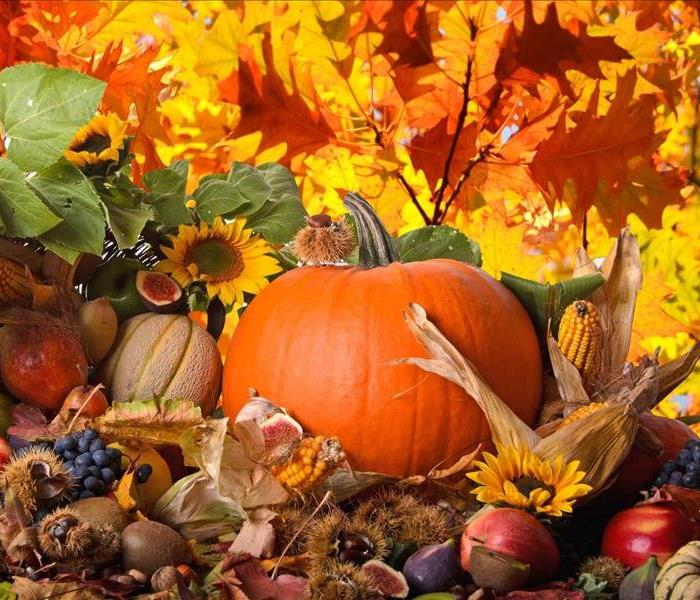 Happy Thanksgiving!
Happy Thanksgiving!
SERVPRO OF ARLINGTON HTS
Please help our Annual Thanksgiving Food Drive be a
HUGE SUCCESS!!
FOOD ITEMS TO BENEFIT NEEDY FAMILIES IN OUR AREA
Bring your non-perishable food items during the following dates:
Monday, October 31, 2016 - Friday, November 11, 2016
ITEMS NEEDED
Canned Fruit
Canned Vegetables
Dried Milk
Cereal
Toilet Paper and Paper Towels
Any other non-perishable food items
SERVPRO OF ARLINGTON HEIGHTS THANKS YOU FOR YOUR GENEROSITY THIS HOLIDAY SEASON!
Food will be distributed to needy families in Arlington Heights through the local Arlington Heights food pantry
handled by St. Edna’s Catholic Church
Water damaged home in Arlington Heights
8/17/2016 (Permalink)
 Removing 3 layers of water damaged floors in the master bath.
Removing 3 layers of water damaged floors in the master bath.
Unfortunately for these homeowners, the sink in their master bedroom burst while they were away on vacation. The damage was substantial to their home in that it affected not only the master bedroom and hall bath on the second level but also several rooms on the lower level including ceiling damage in their garage.
Arlington Heights School District 25 school floods
7/14/2016 (Permalink)
 Our Technician shown extracting water from the carpet.
Our Technician shown extracting water from the carpet.
SERVPRO of Arlington Heights/Prospect Heights was called out recently to assist in the flood cleanup of one of the District's grammar schools. The flood occurred over a weekend and SERVPRO responded immediately to the call made by the Facilities Manager at the School District to assist with the mitigation of the water damage that had occurred due to a burst pipe. SERVPRO of Arlington Heights/Prospect Heights has assisted the School District in the past with flood cleanups at its various schools.
What's lurking in your Air Ducts?
6/28/2016 (Permalink)
Air duct cleaning refers to the cleaning of various components of heating, cooling and ventilation systems like air ducts, grills, registers, diffusers, heat exchangers, drip pans, heating and cooling coils, and air handling unit housing and fan motors.
There were times when people used to think of it as an unnecessary task as long as the systems are working well but now people are much more aware of its importance. Air duct cleaning has become a necessary evil these days as more and more pollution enters our homes and work places. Almost everybody knows the benefits of cleaning air ducts; that it increases efficiency of the systems, reduces workload on the system, lowers electricity bills, increases life of the system and is compulsory for the health of the family. The most common question that comes up is how often should you clean your air ducts.
A plethora of companies in the business of air duct cleaning recommend different intervals extending from yearly to even a span of 3 to 5 years. Obviously the later one makes little sense. Usually an air duct cleaning on an annual basis or at least every other year should keep your system in good working order and you and your family healthy. However, there are exceptions to this as there are situations that would require more frequent cleaning of the air ducts.
Weather Conditions: If you live in an area subjected to severe climatic conditions then you need to clean your air ducts more frequently especially when the climate is hot and humid.
Pets: If there are shedding pets in your home, their dander may contaminate air ducts through the air that is circulated and therefore require more frequent cleaning of your air ducts.
Construction & Renovation: A recent construction and renovation of the home you live in makes an important consideration for an air duct cleaning. Similarly if you are moving into a new house, you may want to consider air duct cleaning because you never know what's in your ducts.
Smoking: If you smoke then a more frequent cleaning session is suggested.
Illness: If someone in the family is suffering from some respiratory disease or is an allergy sufferer, then air duct cleaning should be on the top of your to do list at the start of every season.
Your systems give clear indications about the right time to go for air cleaning duct session. Here are few of these:
Less air flow: Air flow from the vents is greatly reduced if ducts are dirty. You can feel it by putting your hands by the vents.
Smelly Odor: If you smell an odor within your house, perhaps it is time to get your air ducts cleaned.
Moist ducts: This is the ideal condition for mold growth and a clear indication that it is time to get your air ducts cleaned.
Debris Accumulation: Air registers show the sign of the need to clean your air ducts when they get dirty with debris.
Allergic Reactions: Another important reason for considering an air duct cleaning is allergic reactions with no apparent reason. This may indicate poor indoor air quality and an immediate need to clean the air ducts.
Did you know SERVPRO provides air duct cleaning? View our website for more information on this service!
http://www.SERVPROarlingtonheightsprospectheights.com/airduct-cleaning
SERVPRO of Arlington Hts./Prospect Hts. called out to assist in flood cleanup at The Metropolis
6/27/2016 (Permalink)
Due to the heavy rains last week, the Metropolis Theatre located in downtown Arlington Heights, IL experienced flooding in their lobby. The rain water poured in from outside through the lobby doors saturating the carpet and tile. SERVPRO of Arlington Heights/Prospect Heights was called to assist with the flood cleanup. This is the second time SERVPRO has assisted The Metropolis with a flood cleanup.
http://www.chicagotribune.com/suburbs/arlington-heights/news/ct-ah-arlington-storm-damage-tl-0630-20160623-story.html
Phone Number Checklist for Property Managers
6/14/2016 (Permalink)
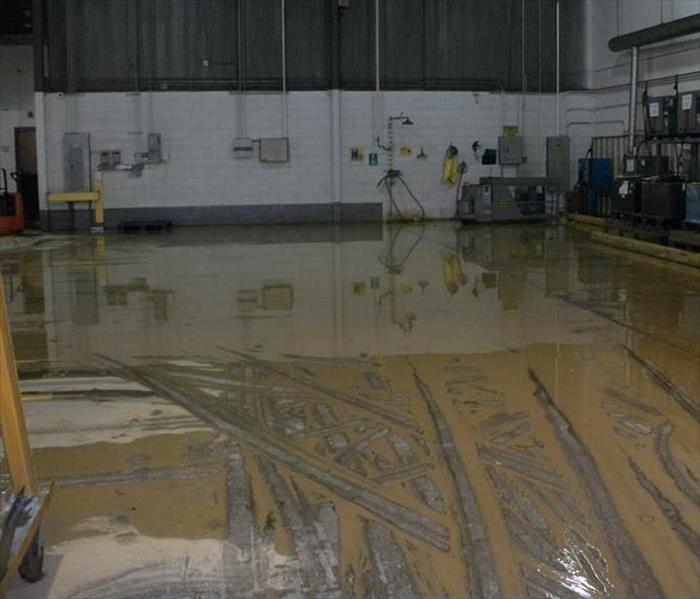 Commercial water damage clean up
Commercial water damage clean up
EMERGENCY RESPONSE PROFILE NUMBERS
Ensure Your Vendors Provide 24-Hour Response and that you have a phone number for the following people:
Property Manager/Landlord:
Property/Complex Main Office:
Property/Complex Emerg. # (if different):
Property/Complex Security #:
Insurance Agent/Office:
Police/Law Enforcement:
Fire Department:
Water Department:
Gas Company:
Electric Department:
Phone Company:
SERVPRO's Ph #
http://www.SERVPROarlingtonheightsprospectheights.com/commercial-restoration-cleaning
What you can do until help arrives
6/14/2016 (Permalink)
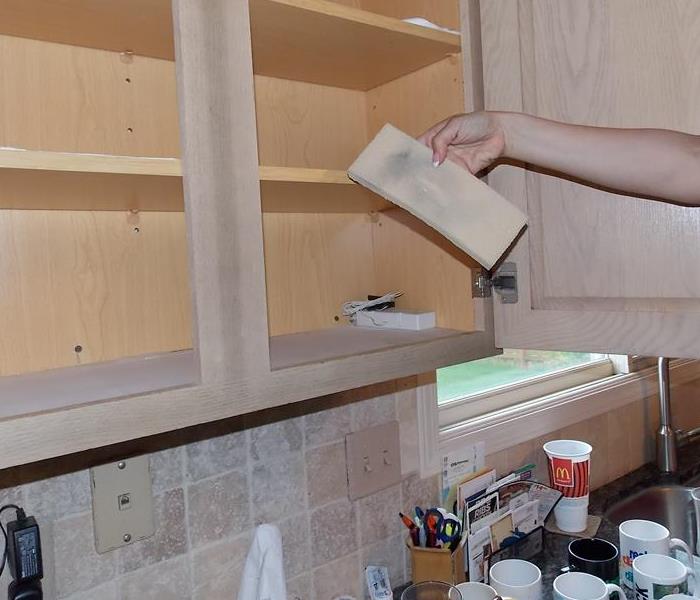 Soot affects everything including the inside of your cabinets! The fire occurred in the basement yet the soot made it into the kitchen cabinets.
Soot affects everything including the inside of your cabinets! The fire occurred in the basement yet the soot made it into the kitchen cabinets.
The first 48 hours after a fire damage can make the difference between restoring versus replacing your
property and personal belongings. SERVPRO’s 1-4-8 Service Response Guidelines can help prevent fire
damage from creating long-term problems. SERVPRO Franchise Professionals provide timely response
with mitigation services ranging from fire, smoke, and soot removal to contents claims inventory and
document restoration. These services help ensure your property, belongings and memories are restored
to pre-loss condition when possible. SERVPRO Franchise Professionals are available 24-hours a day, 365
days a year to help you regain control quickly. Below are steps you can take until a vendor such as
SERVPRO arrives.
Limit movement in the home to prevent soot particles from spreading and additional damage from occurring.
Place clean towels or old linens on rugs and high traffic areas and upholstery.
Coat chrome faucets, trim and appliances with petroleum jelly or oil.
Place aluminum foil or wood blocks between furniture legs and wet carpet.
Do not wash any walls or painted surfaces.
Do not shampoo carpet or upholstery.
Do not clean any electrical equipment.
Do not sent clothing to a dry cleaner since improper cleaning may set smoke odor.






 24/7 Emergency Service
24/7 Emergency Service

